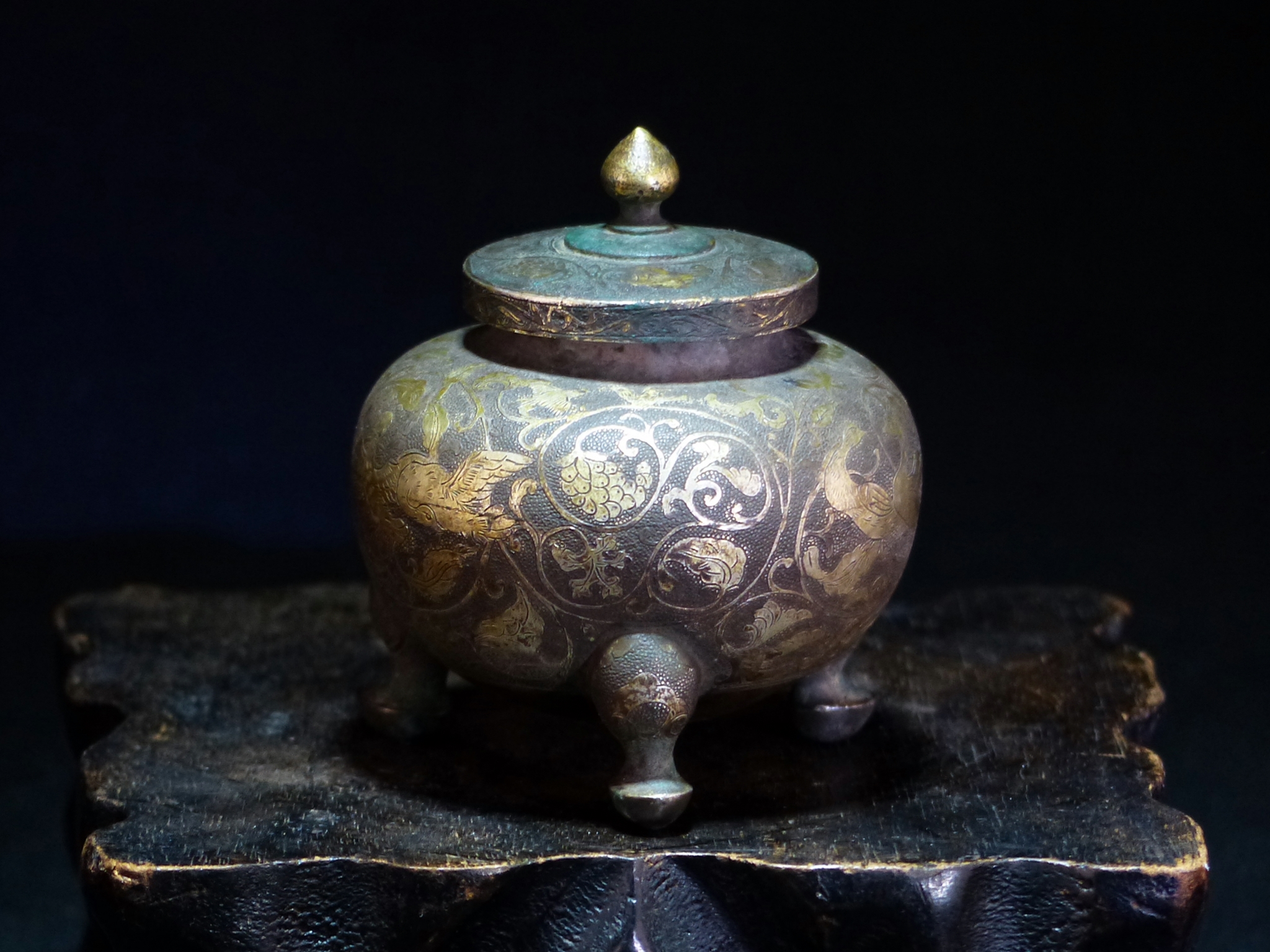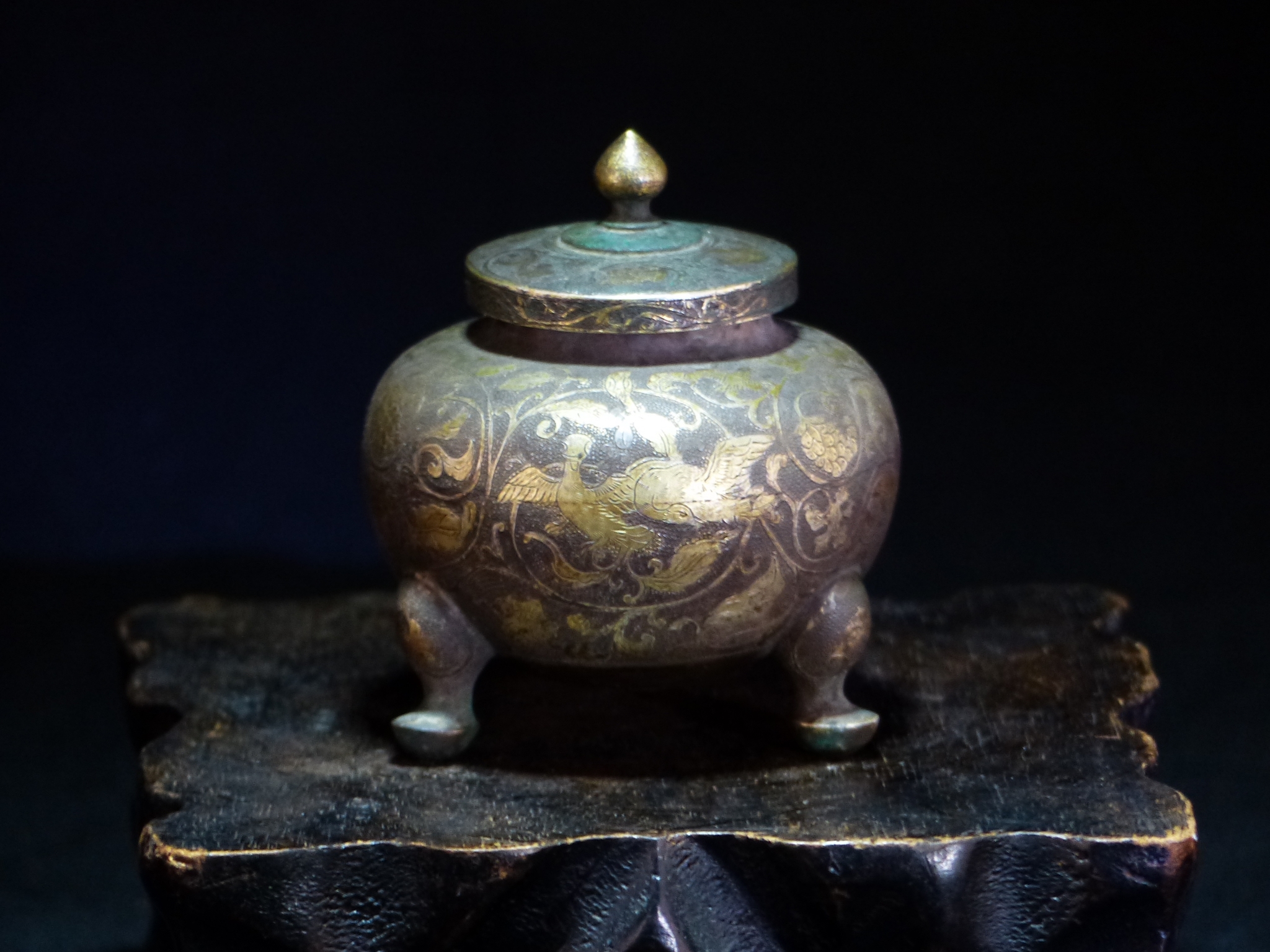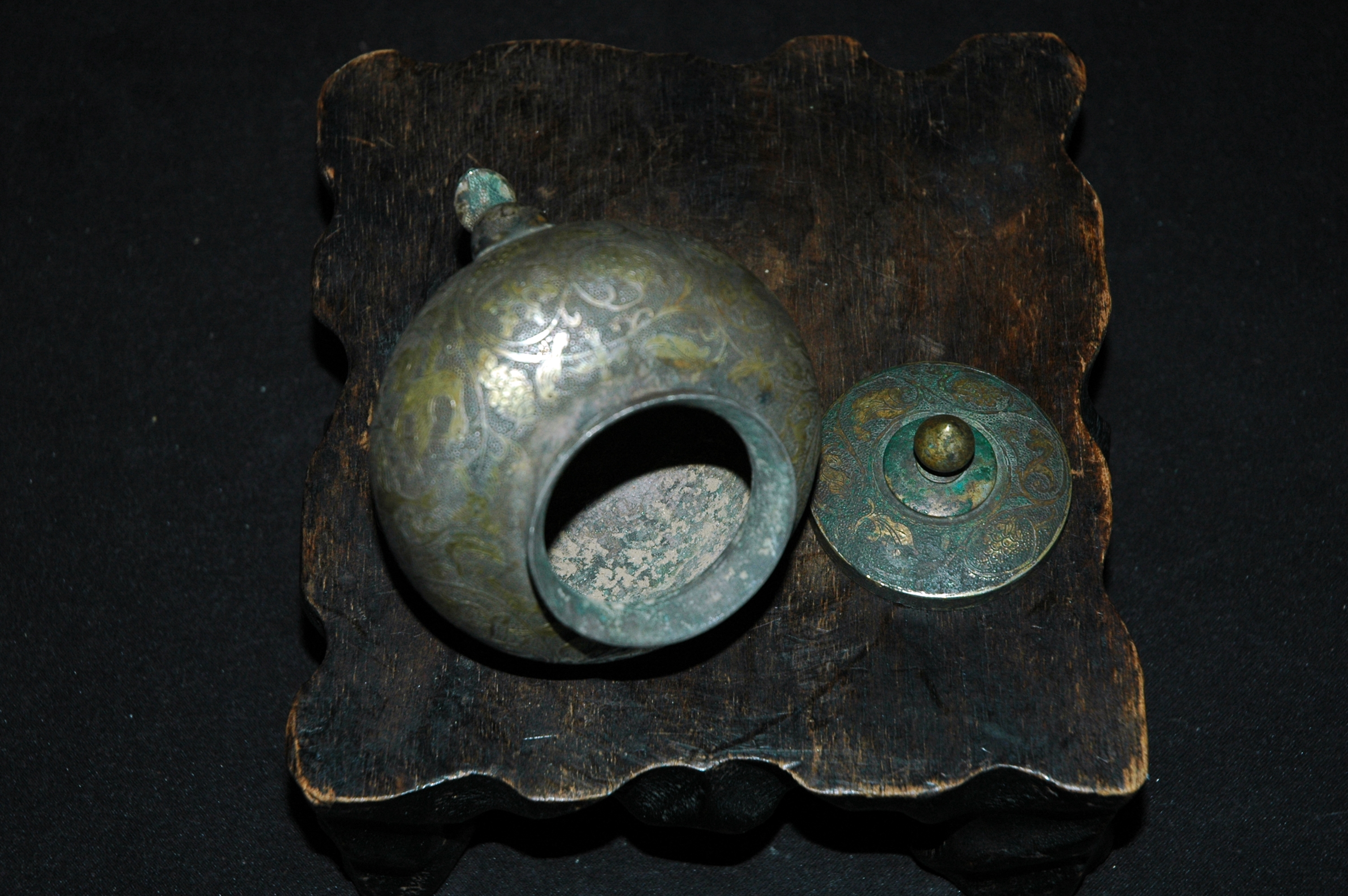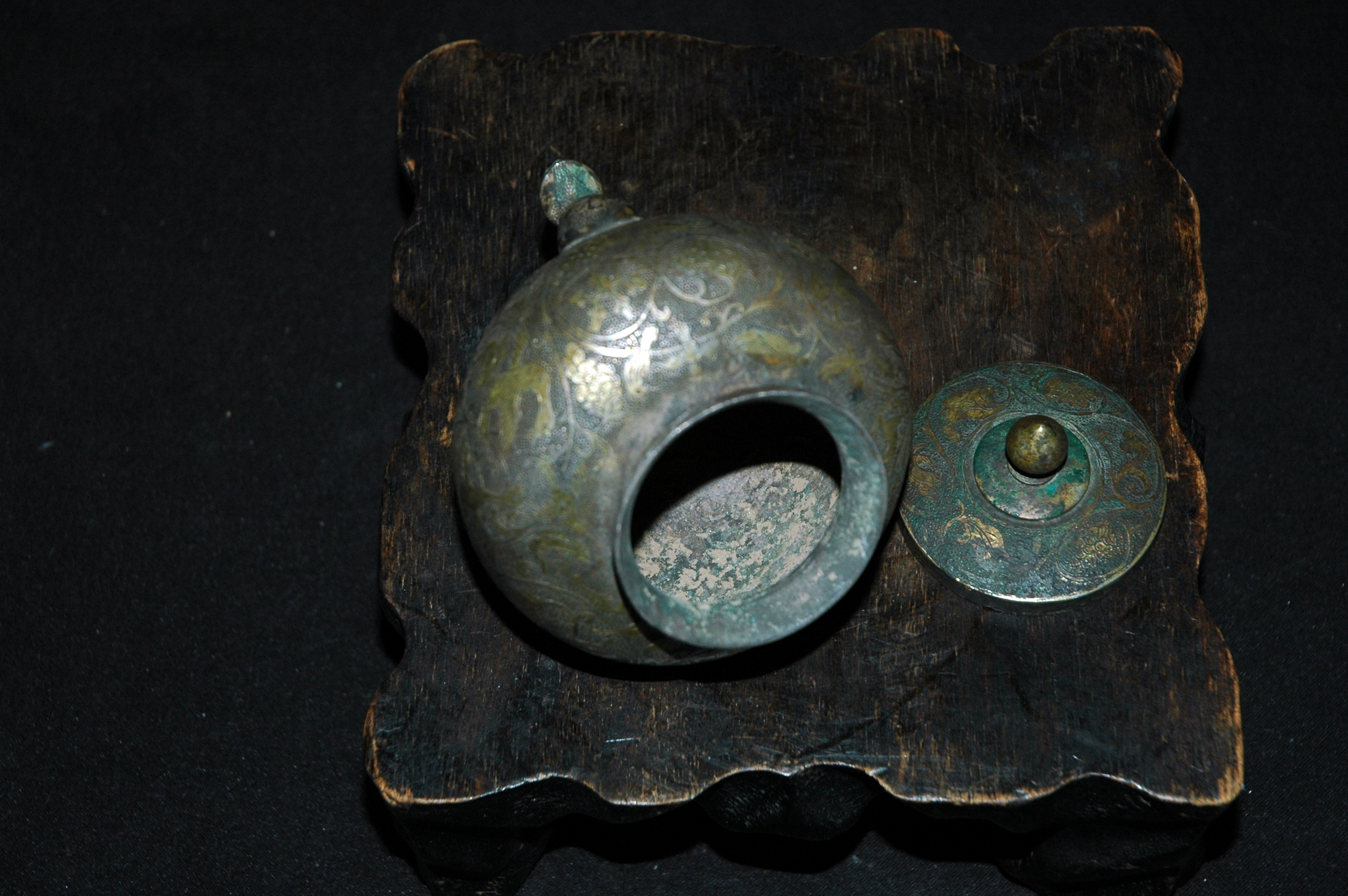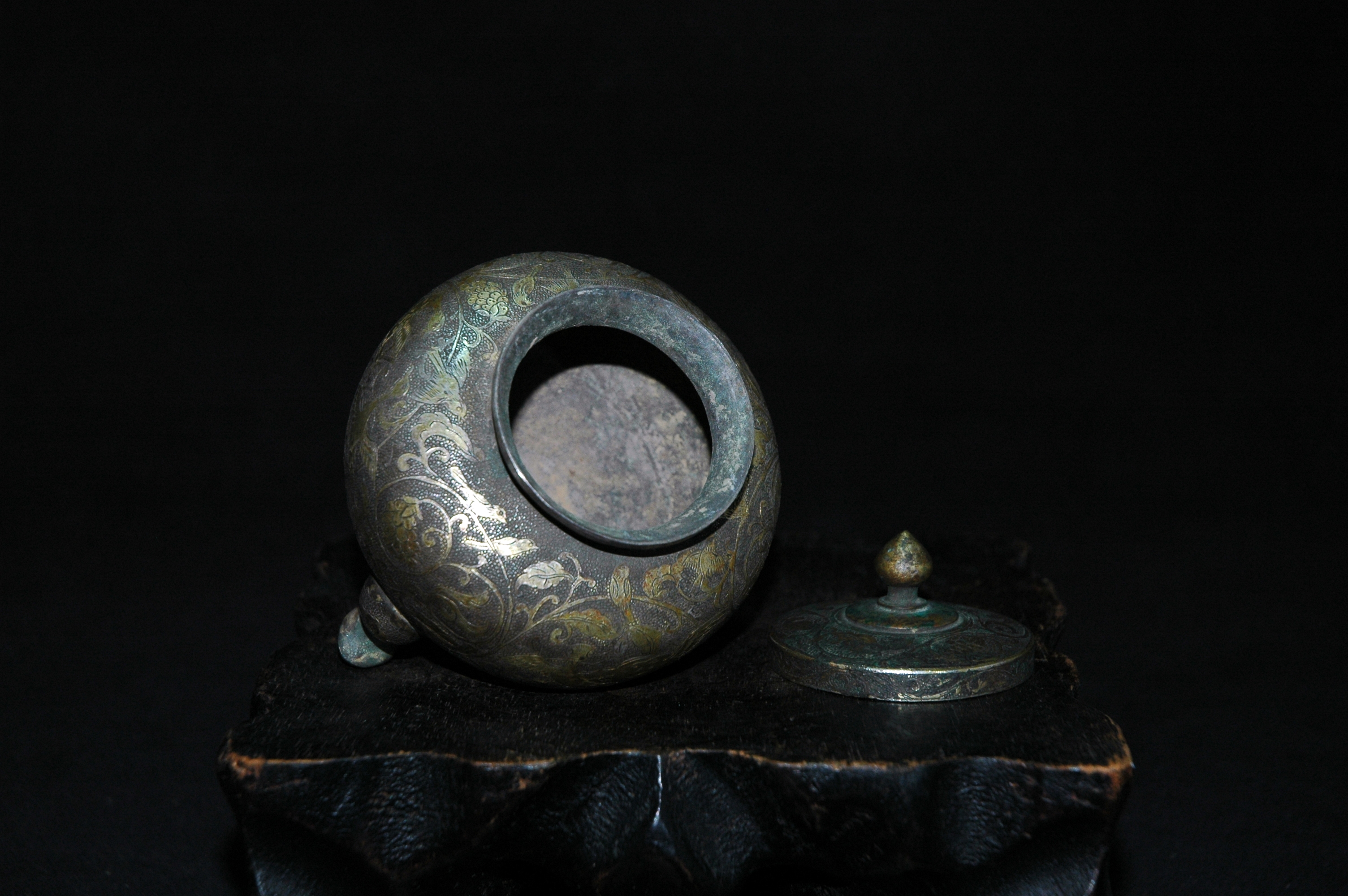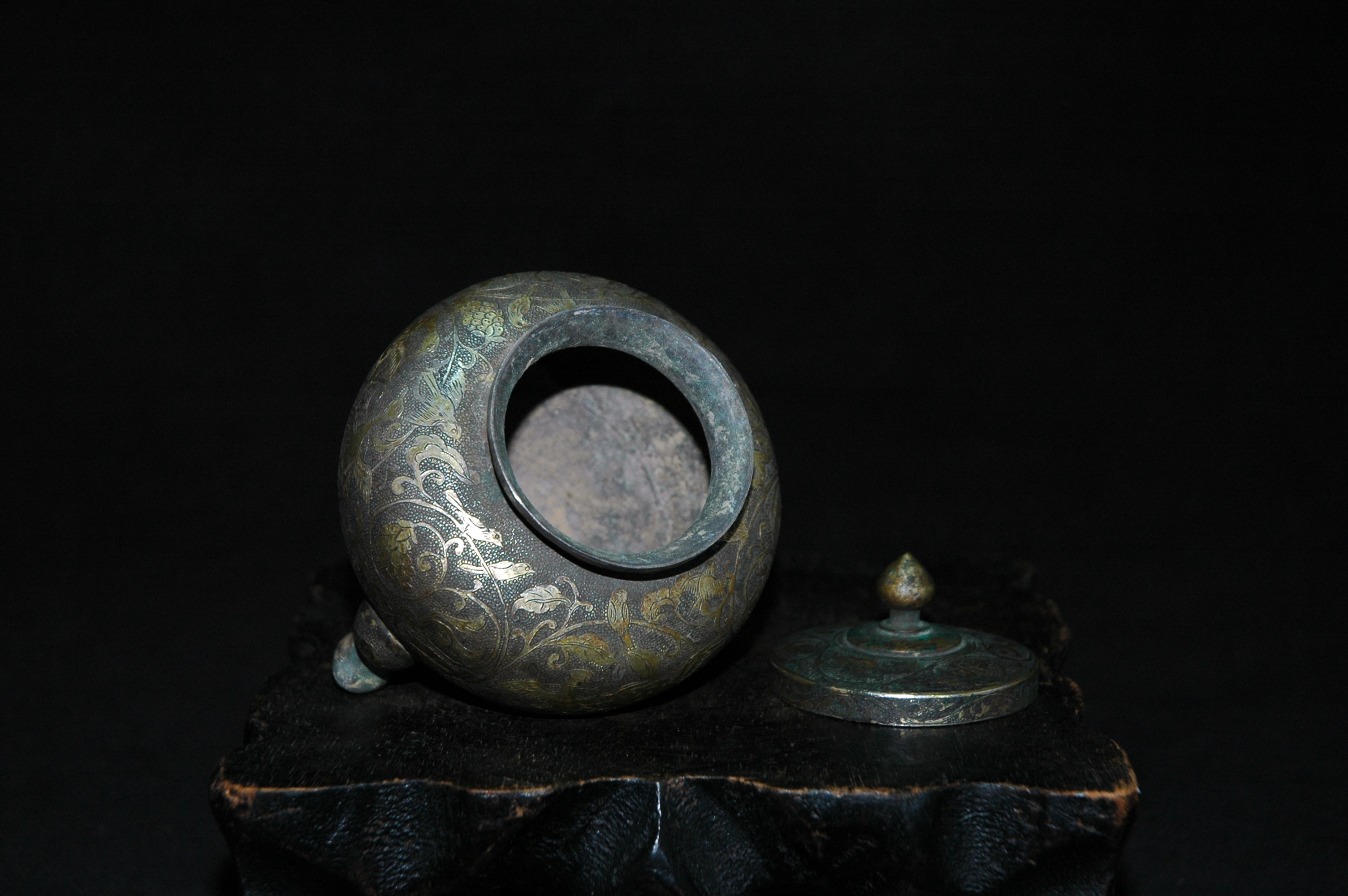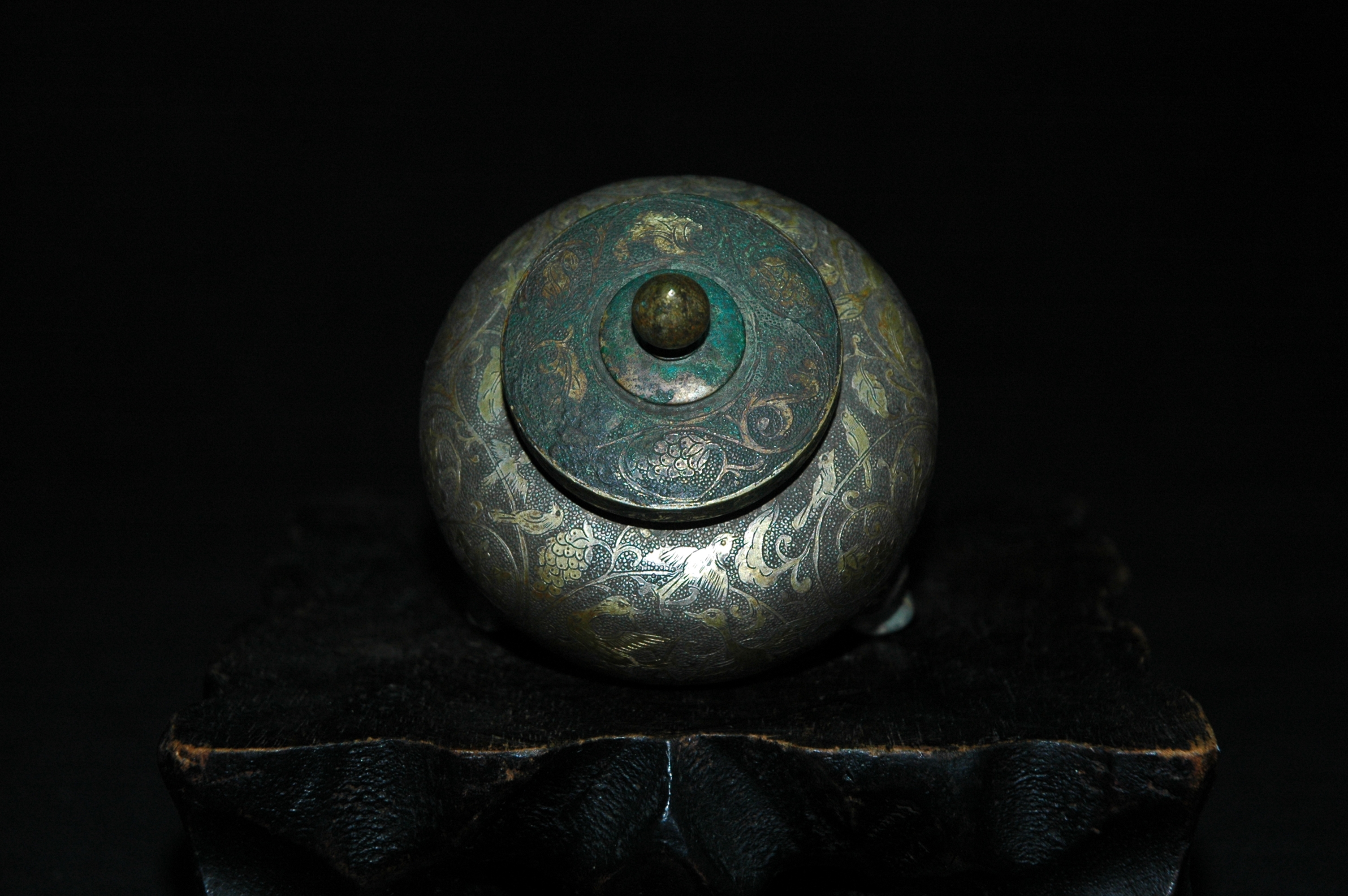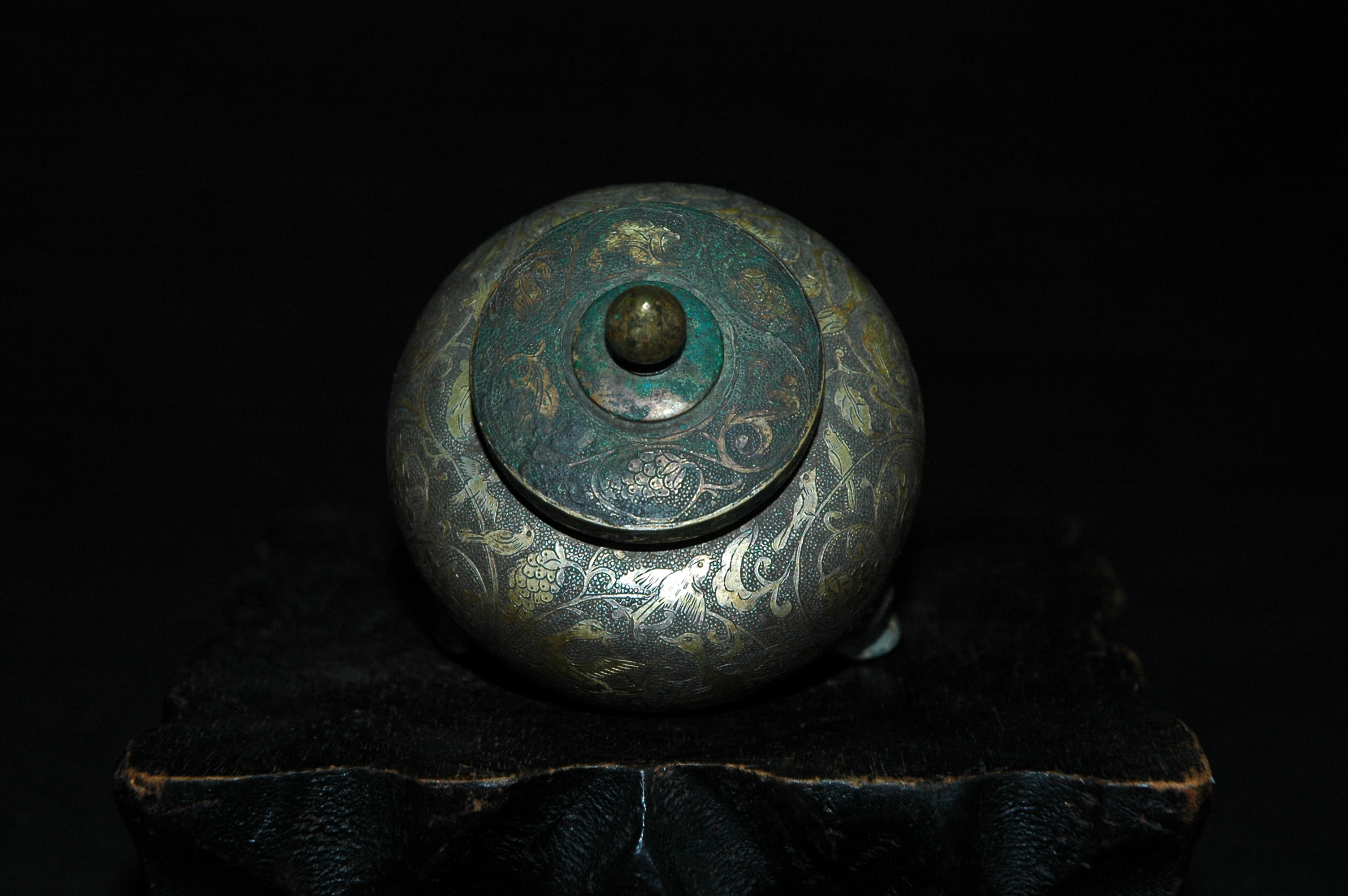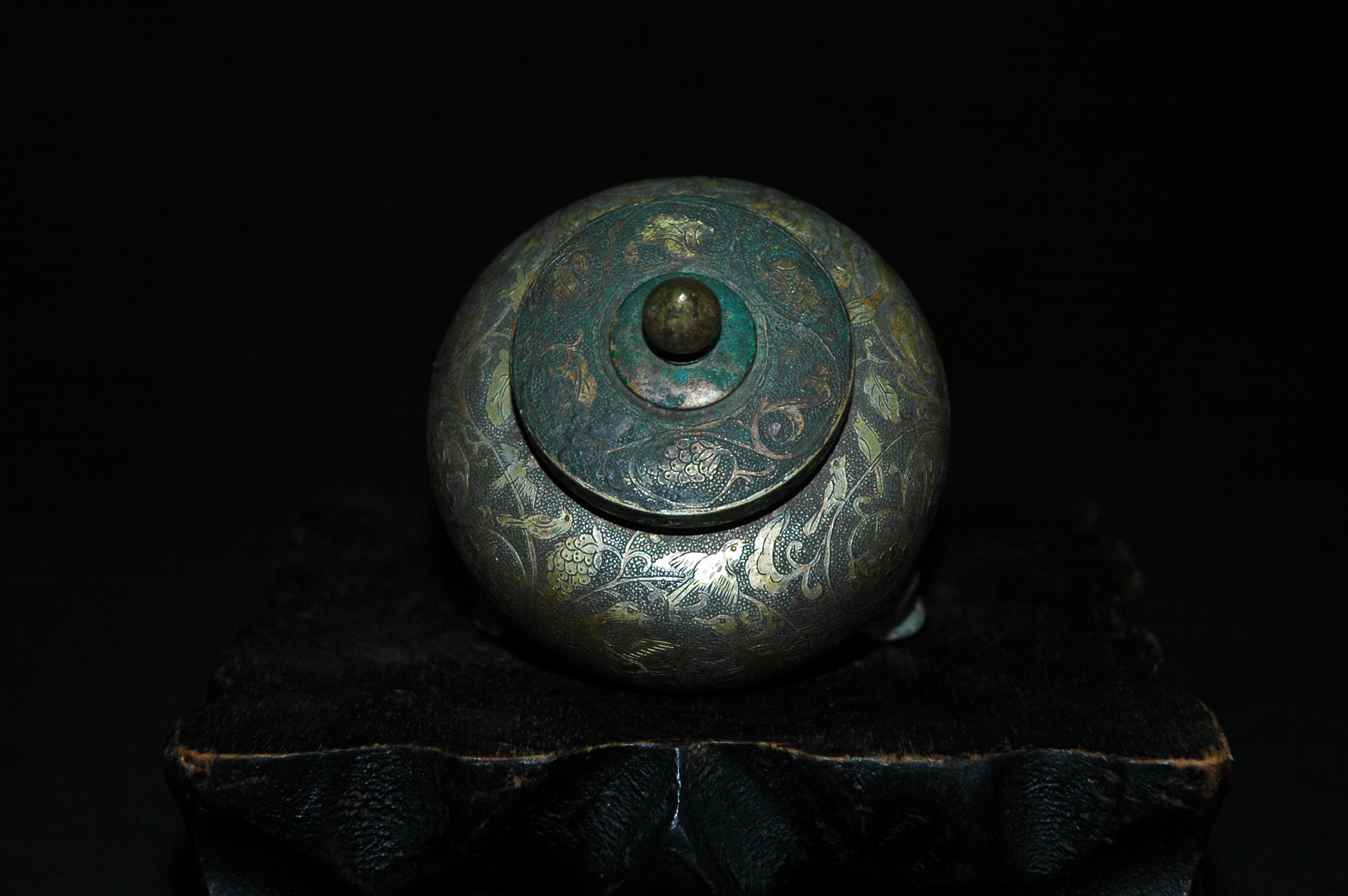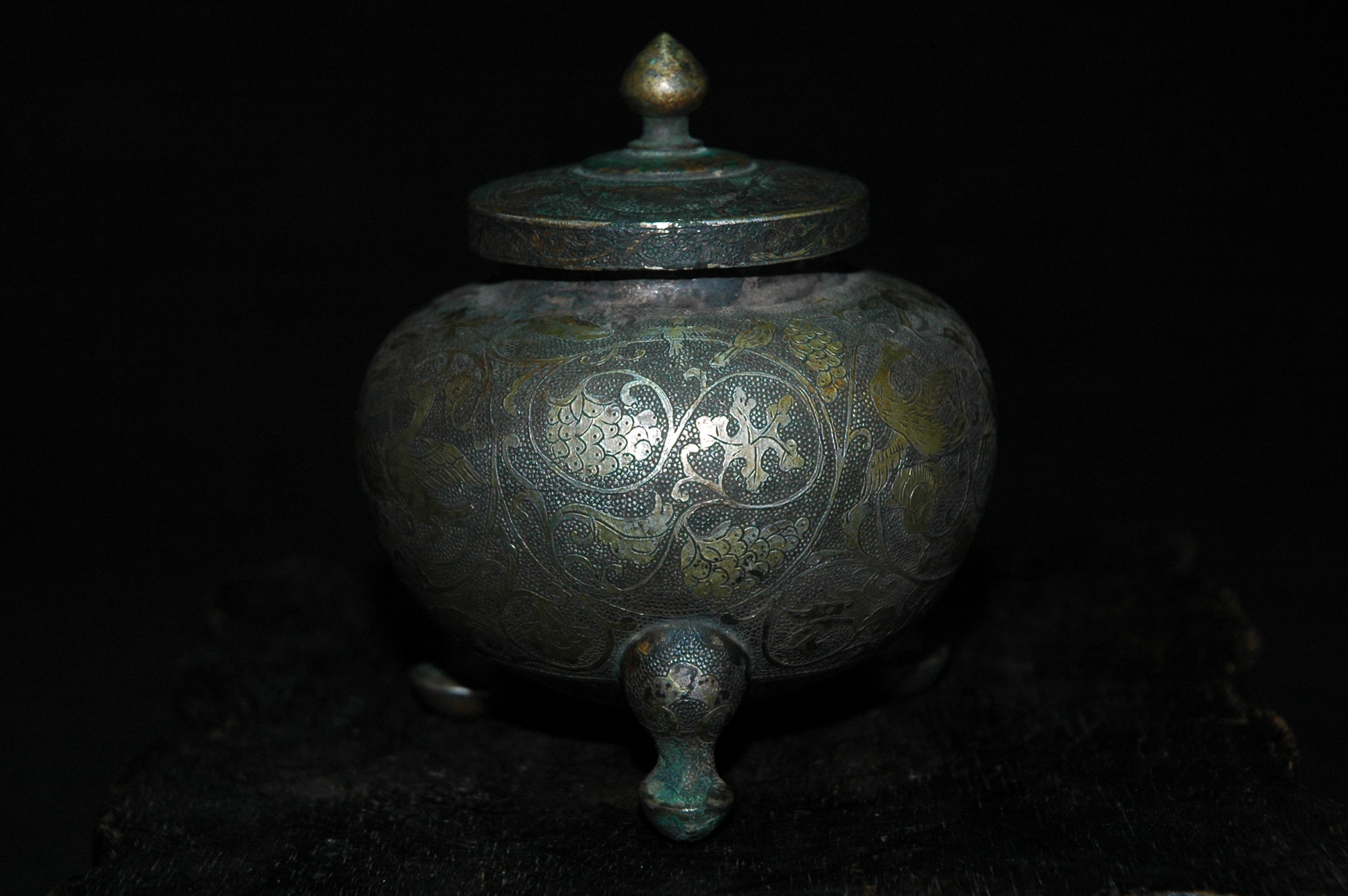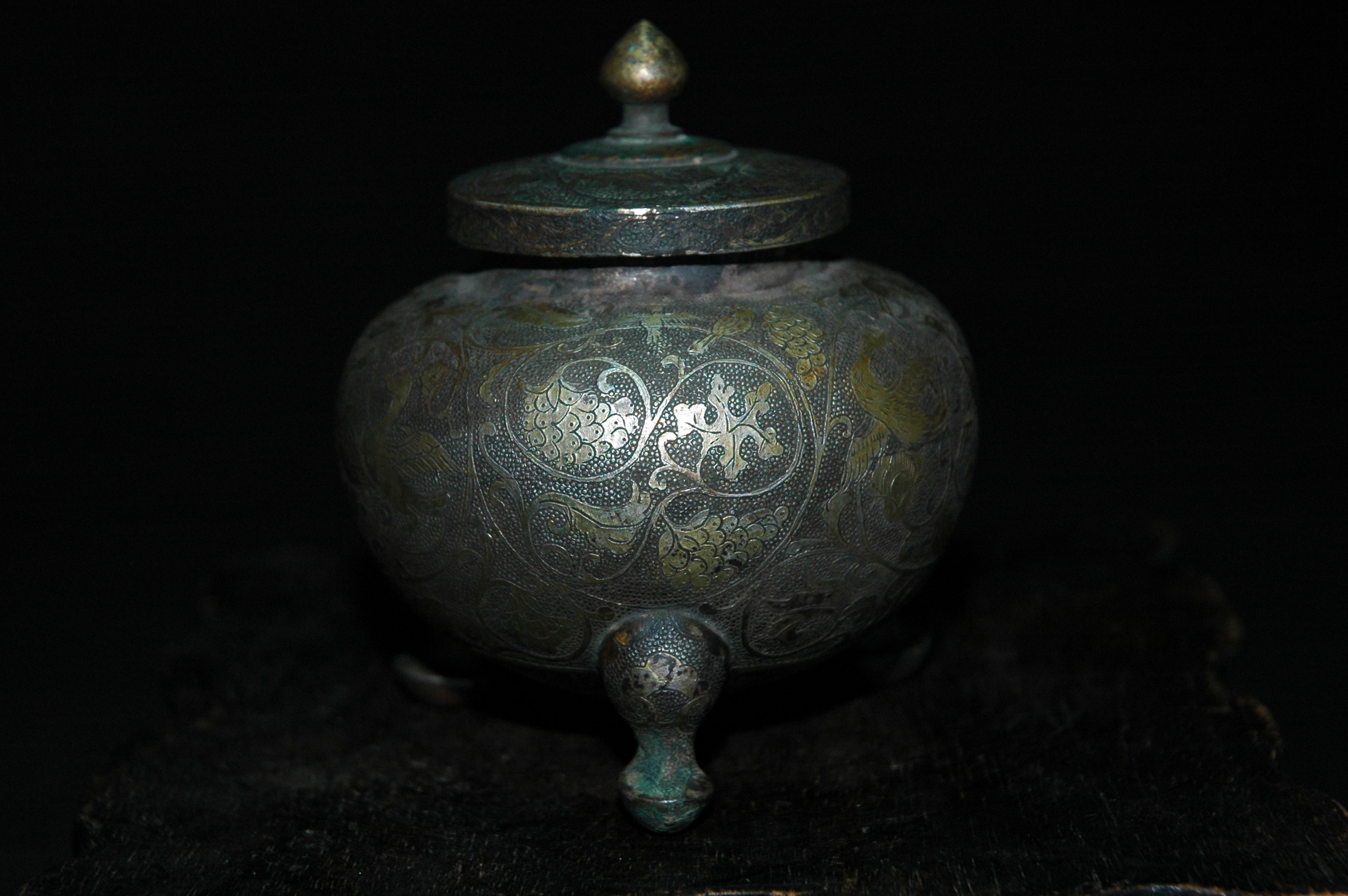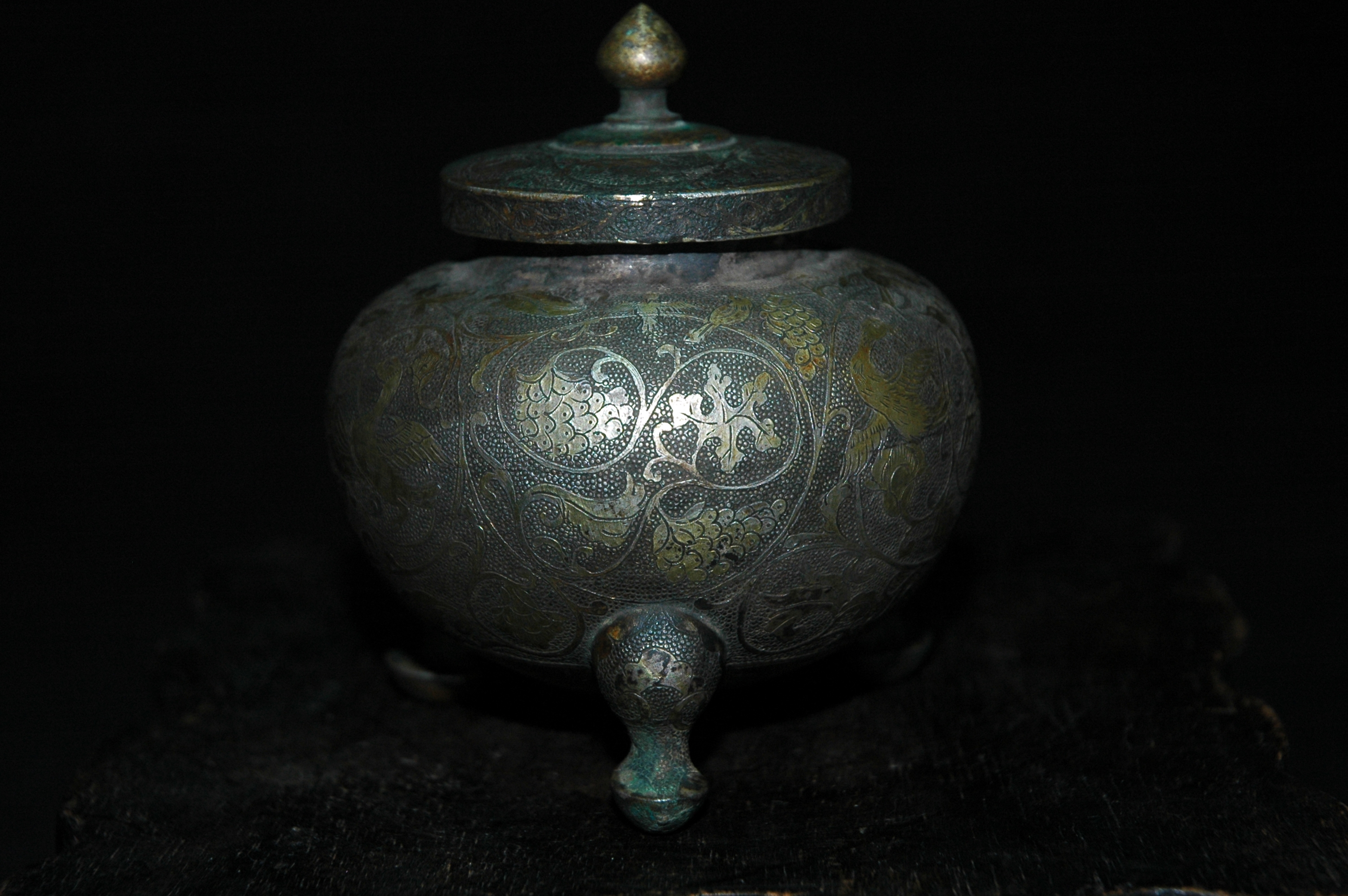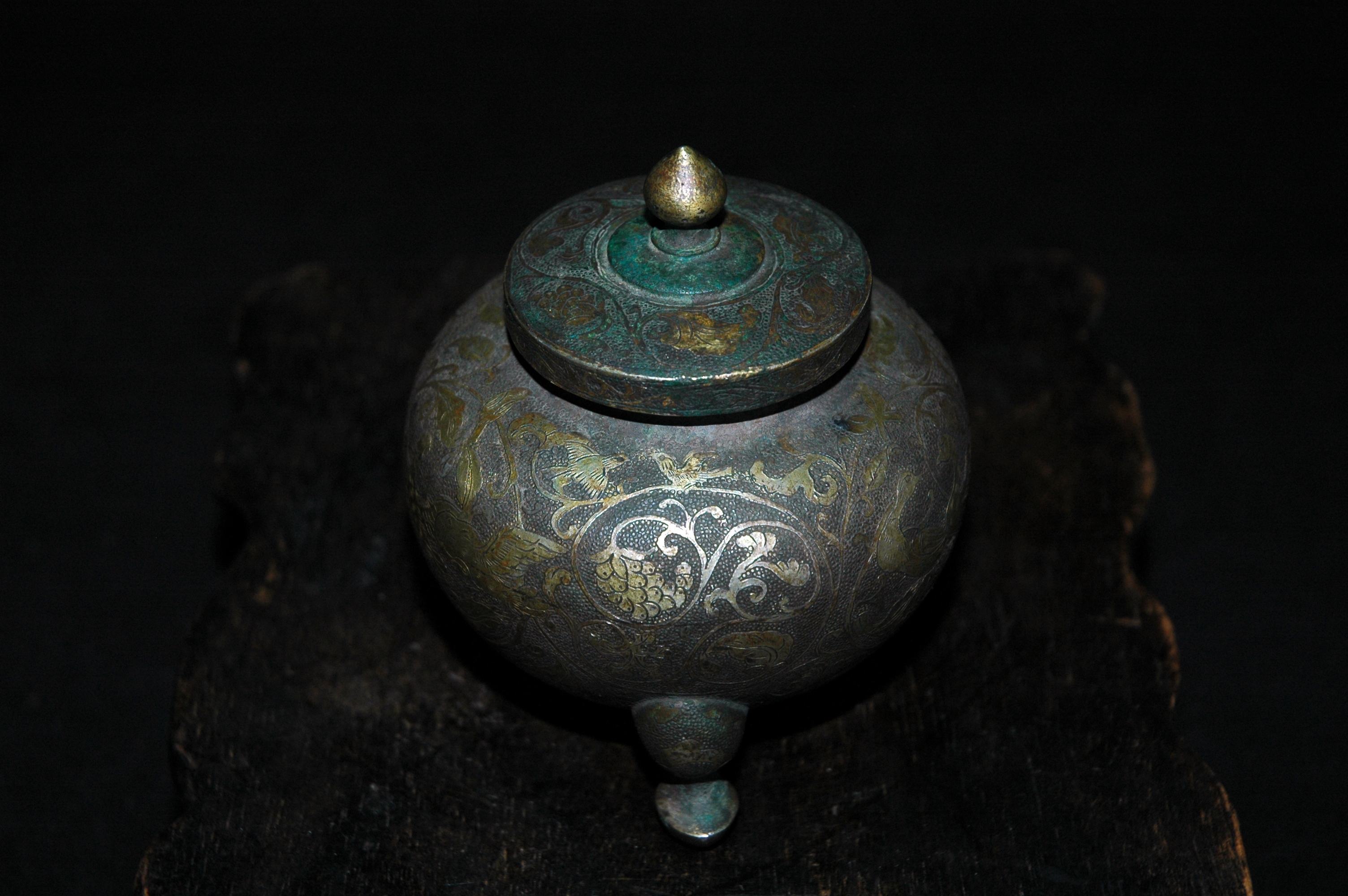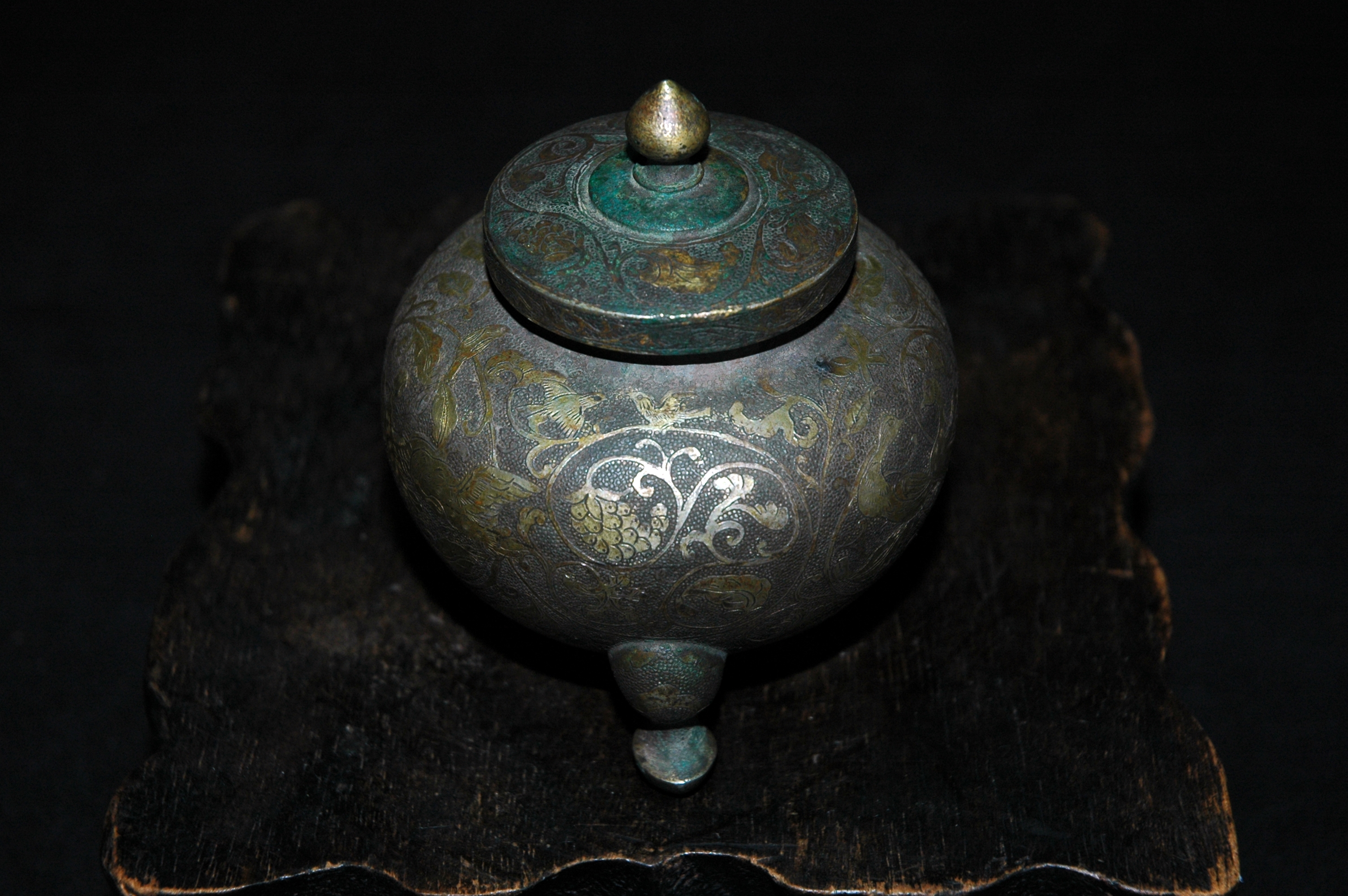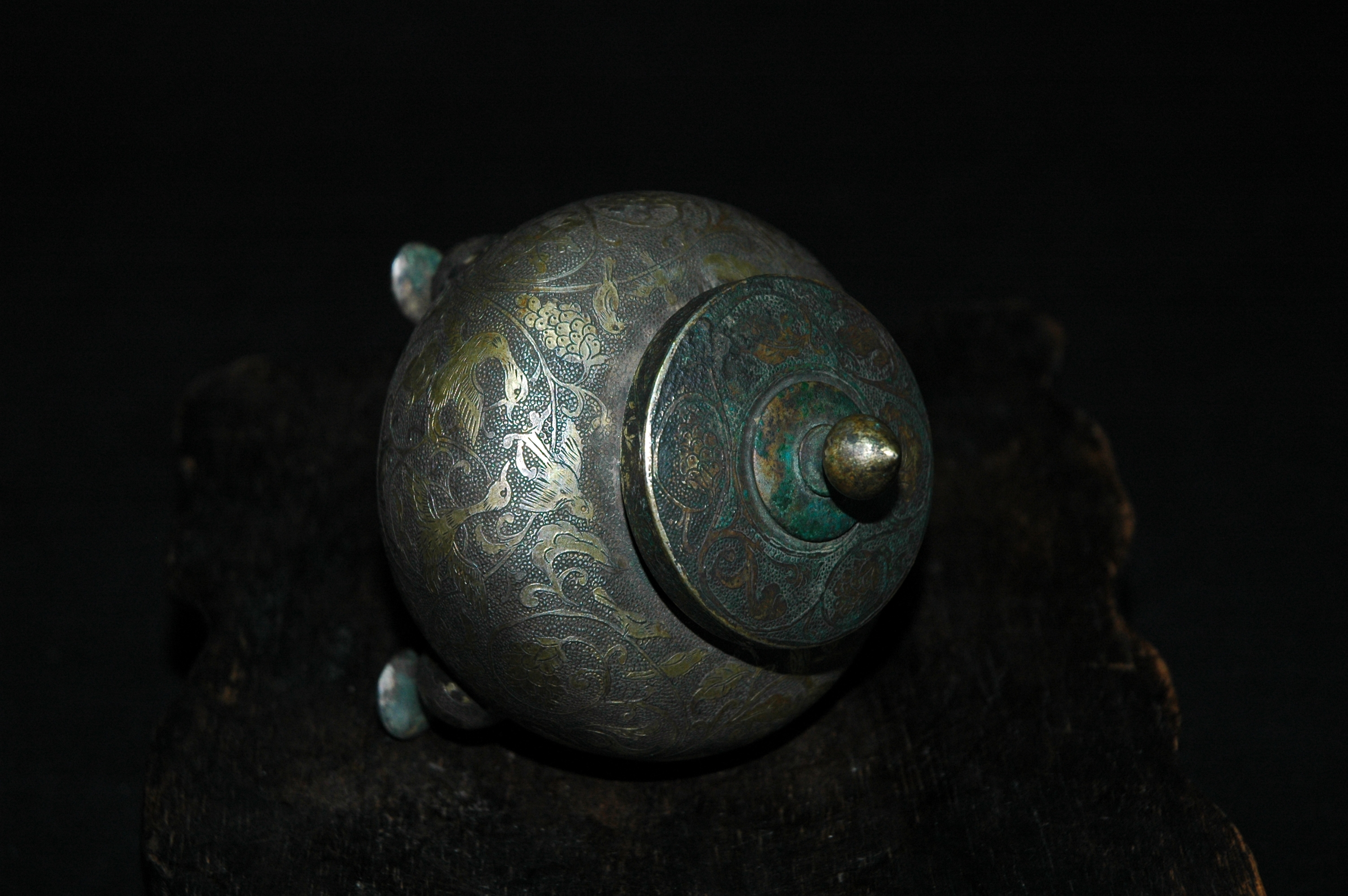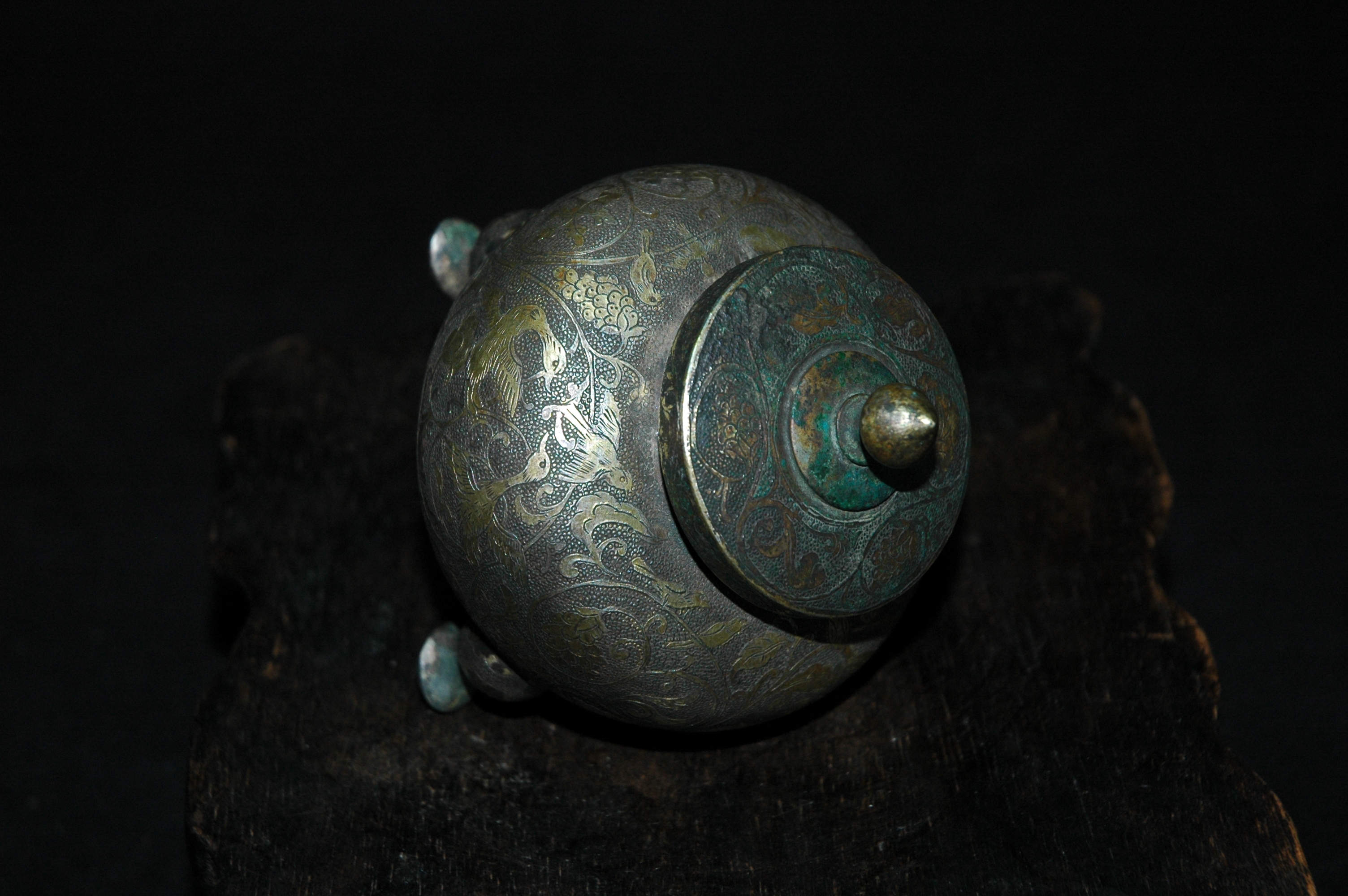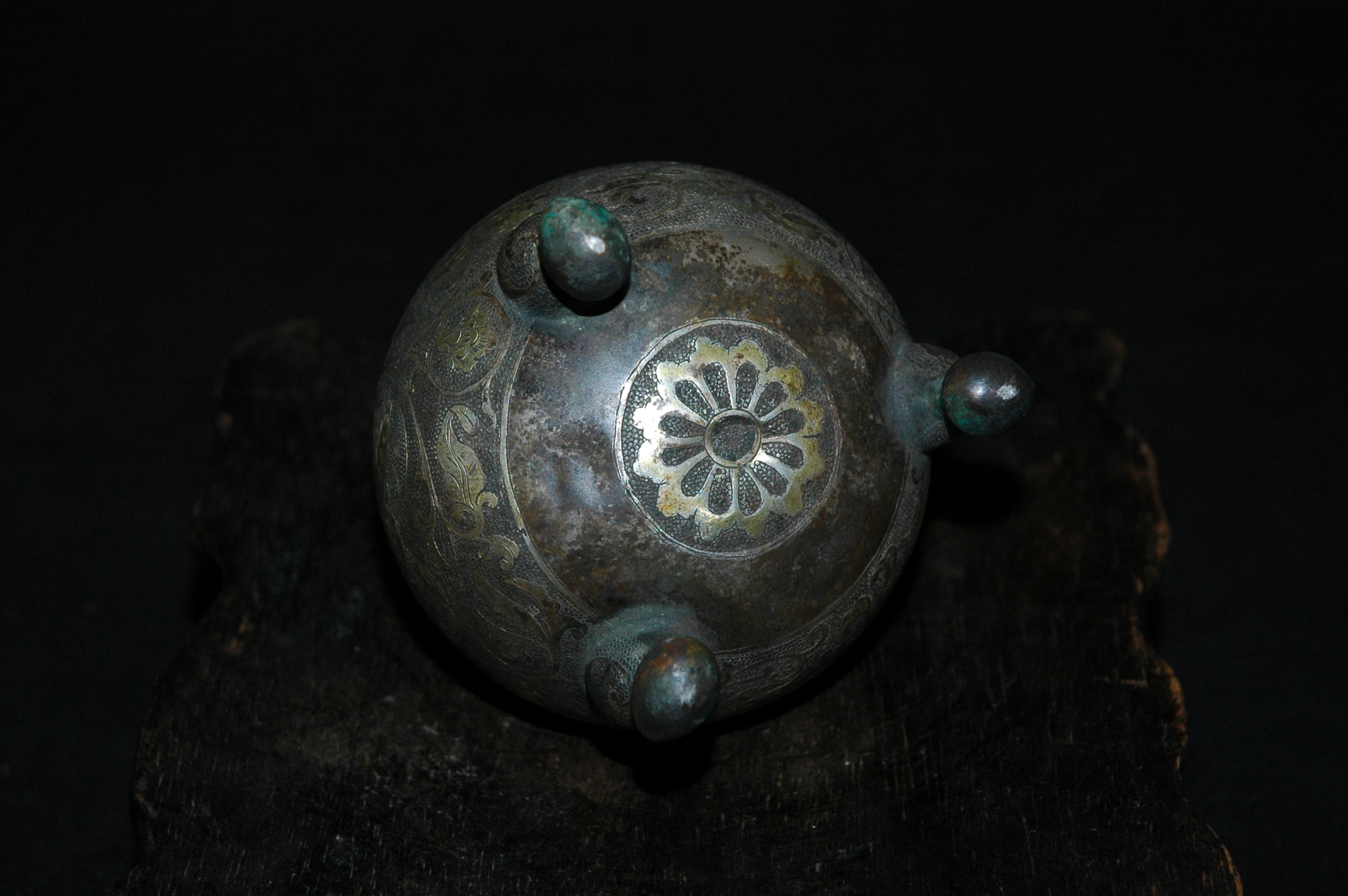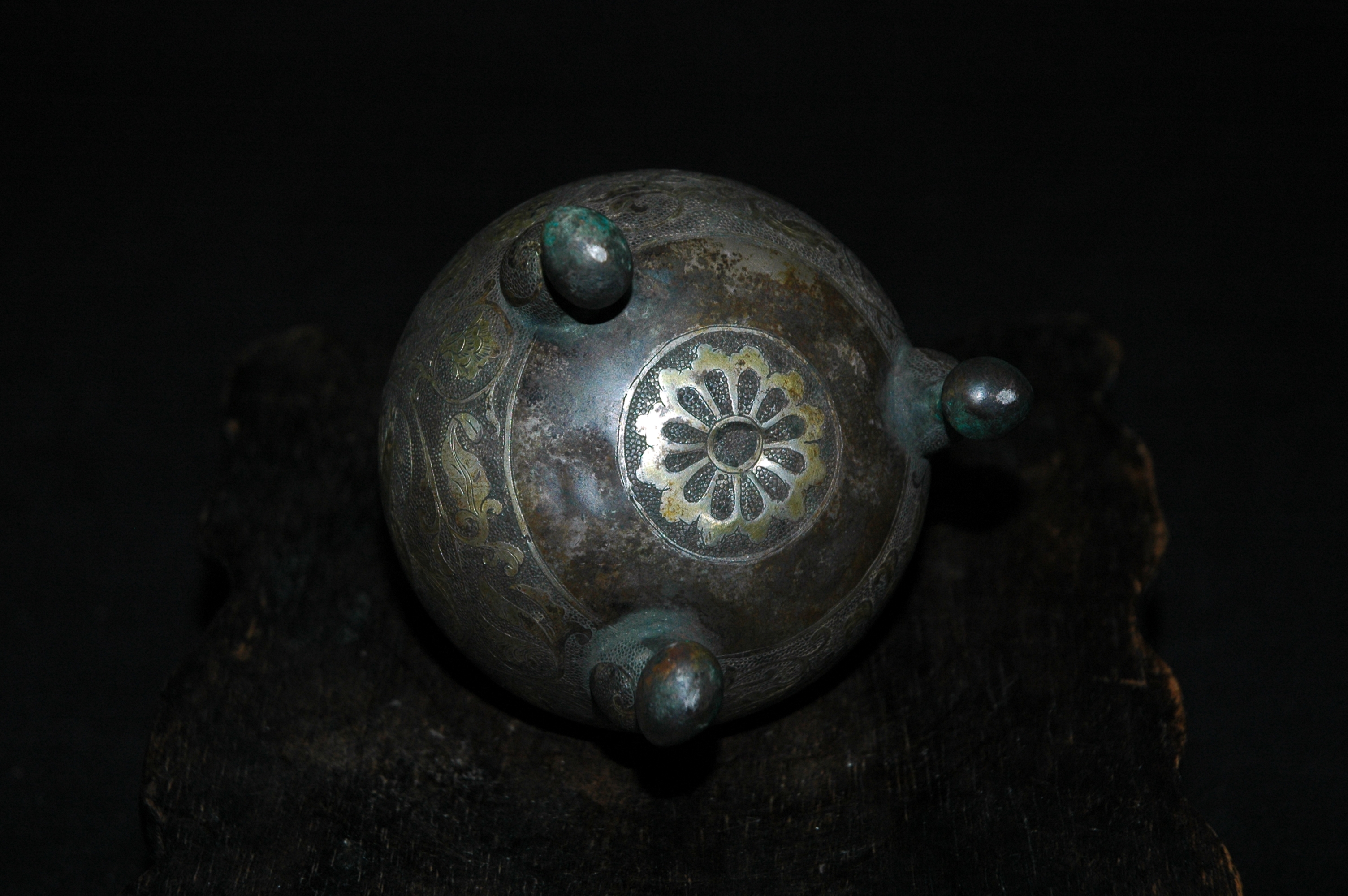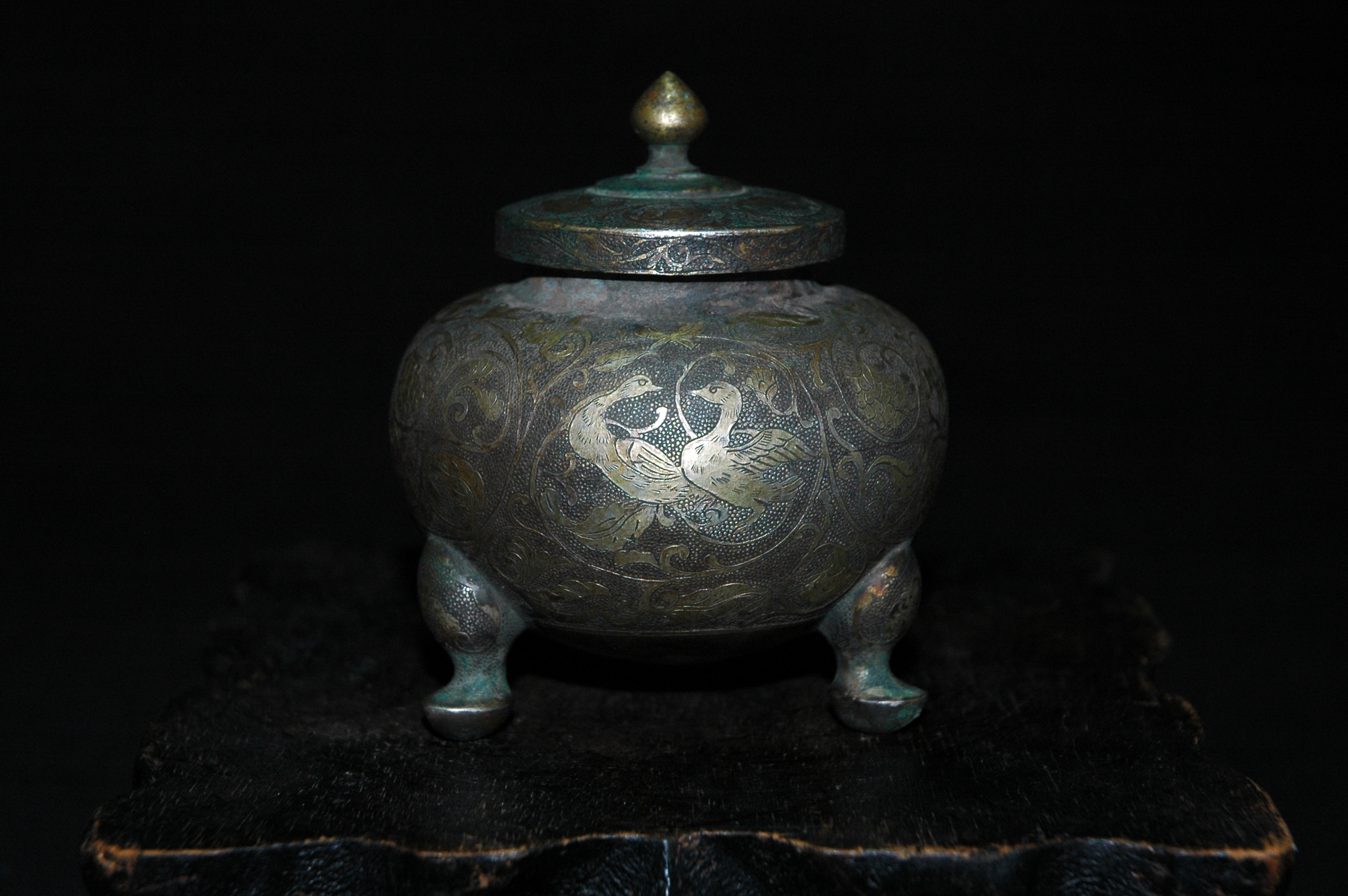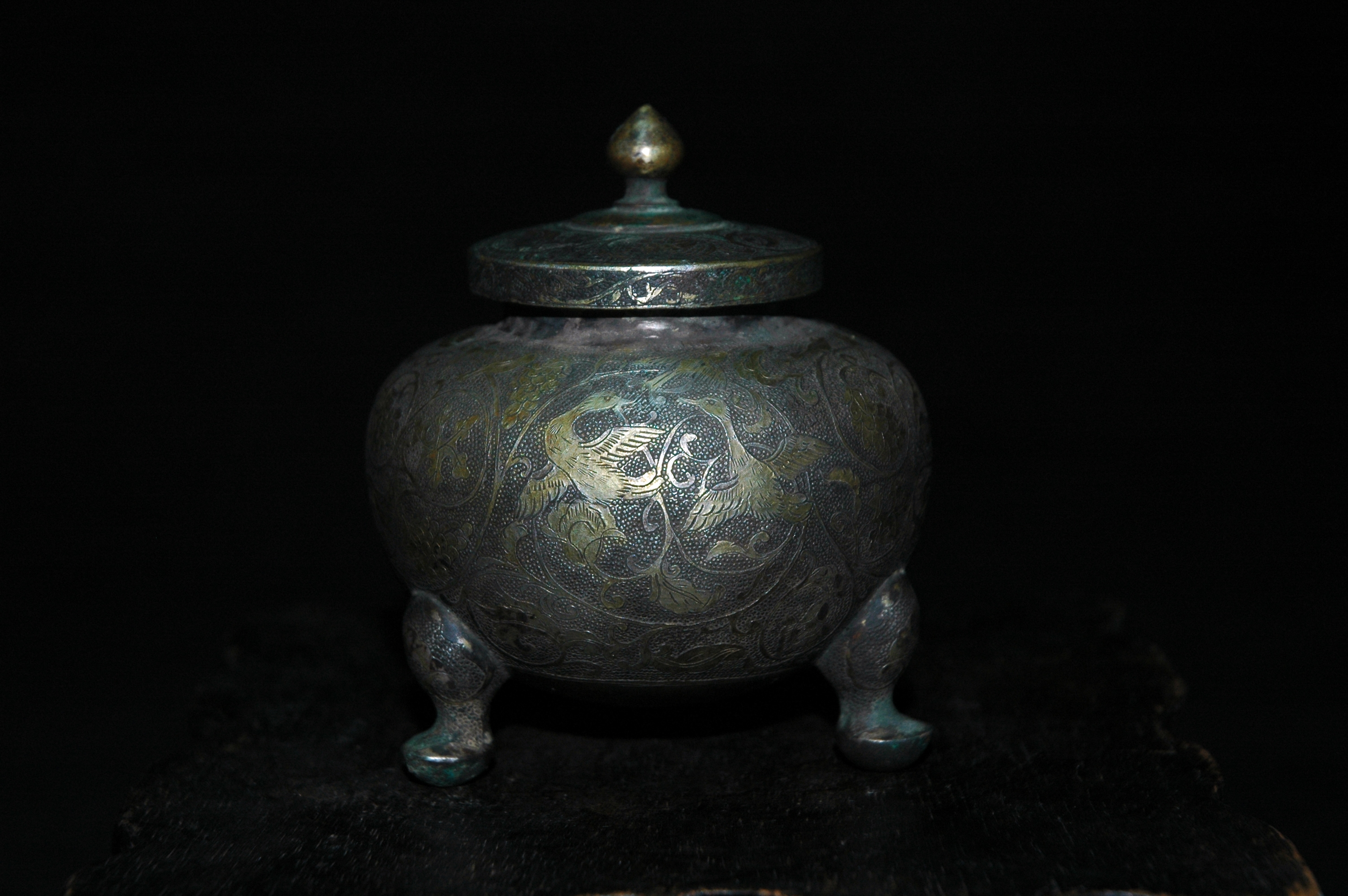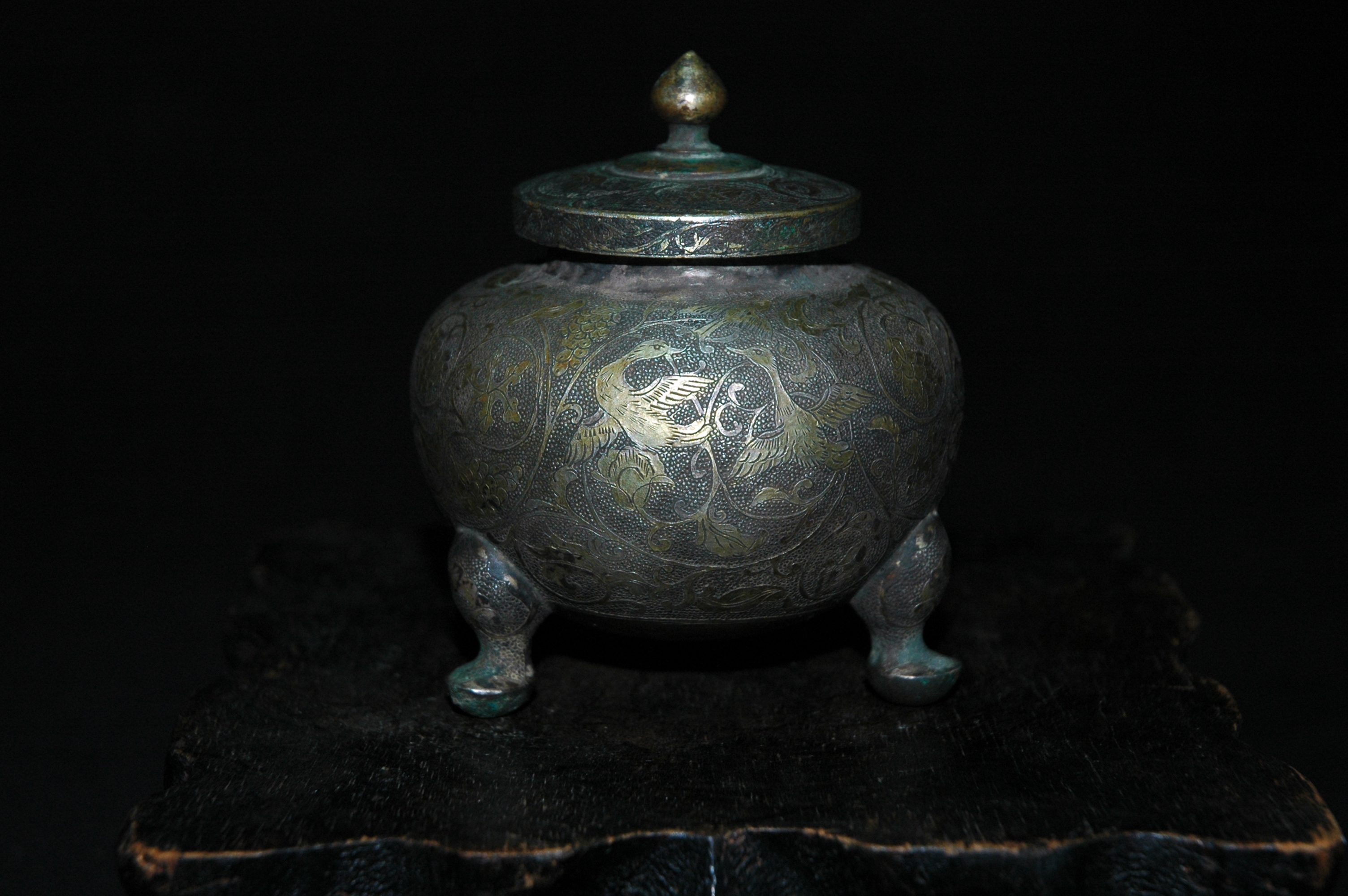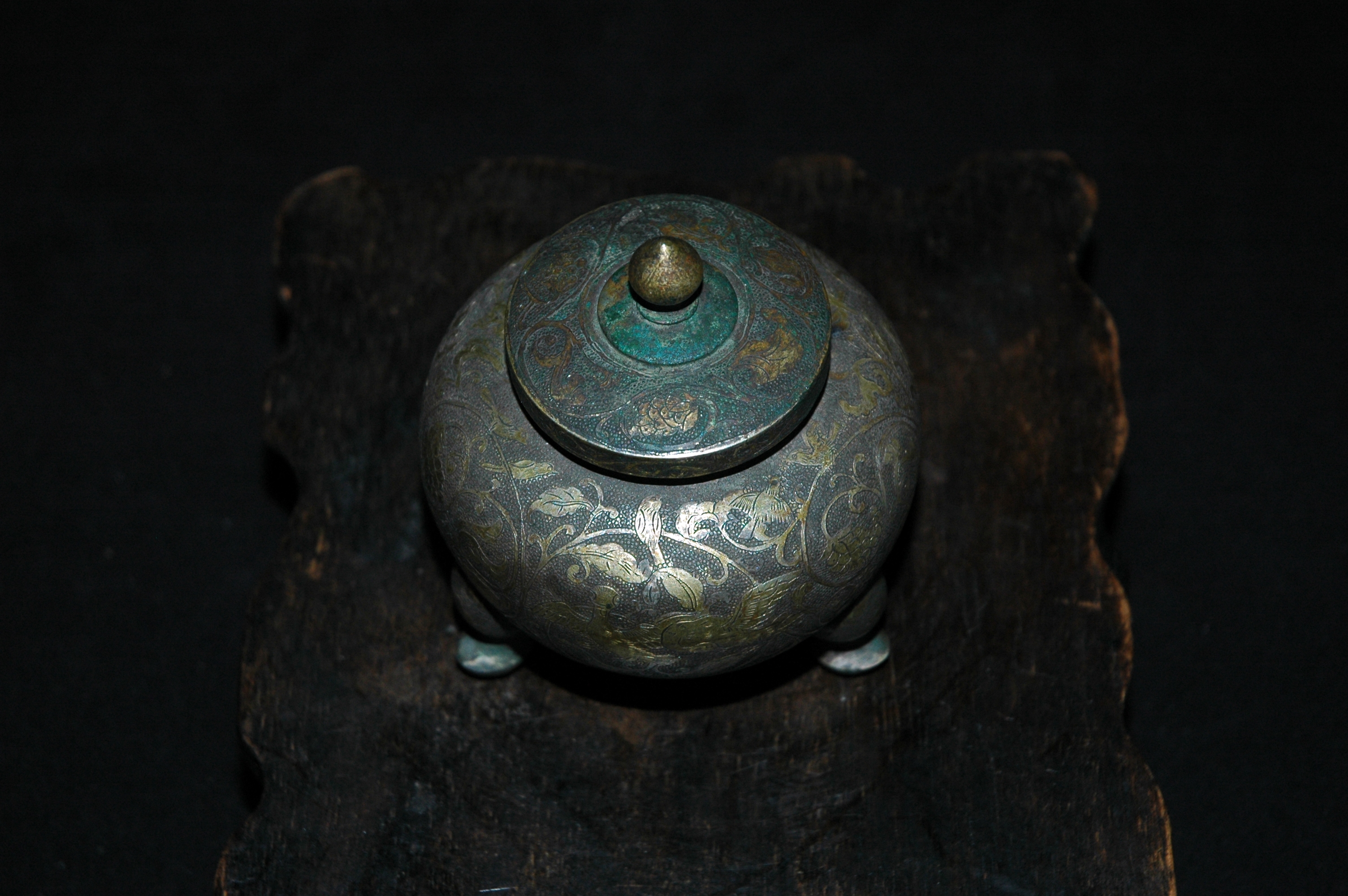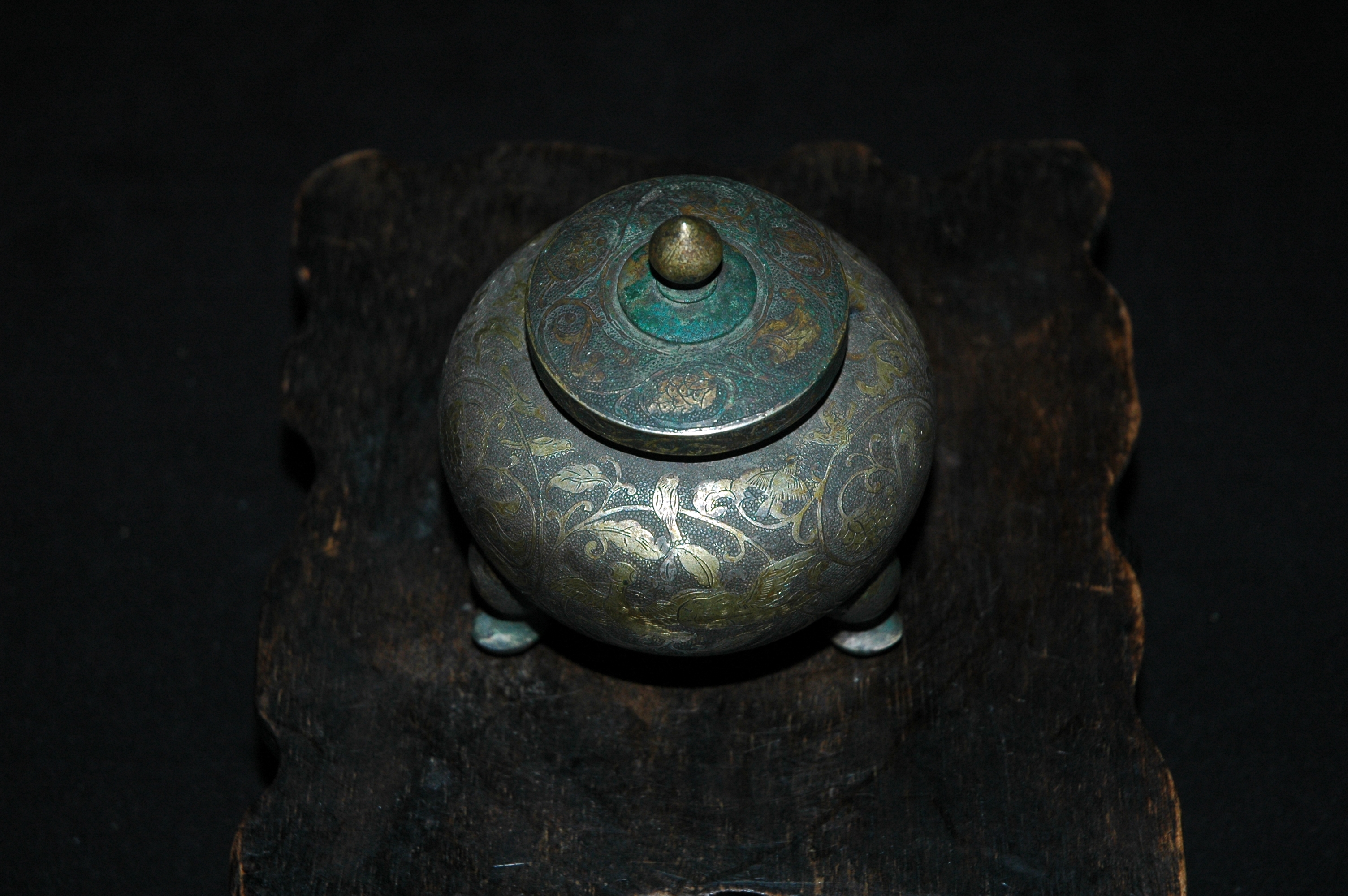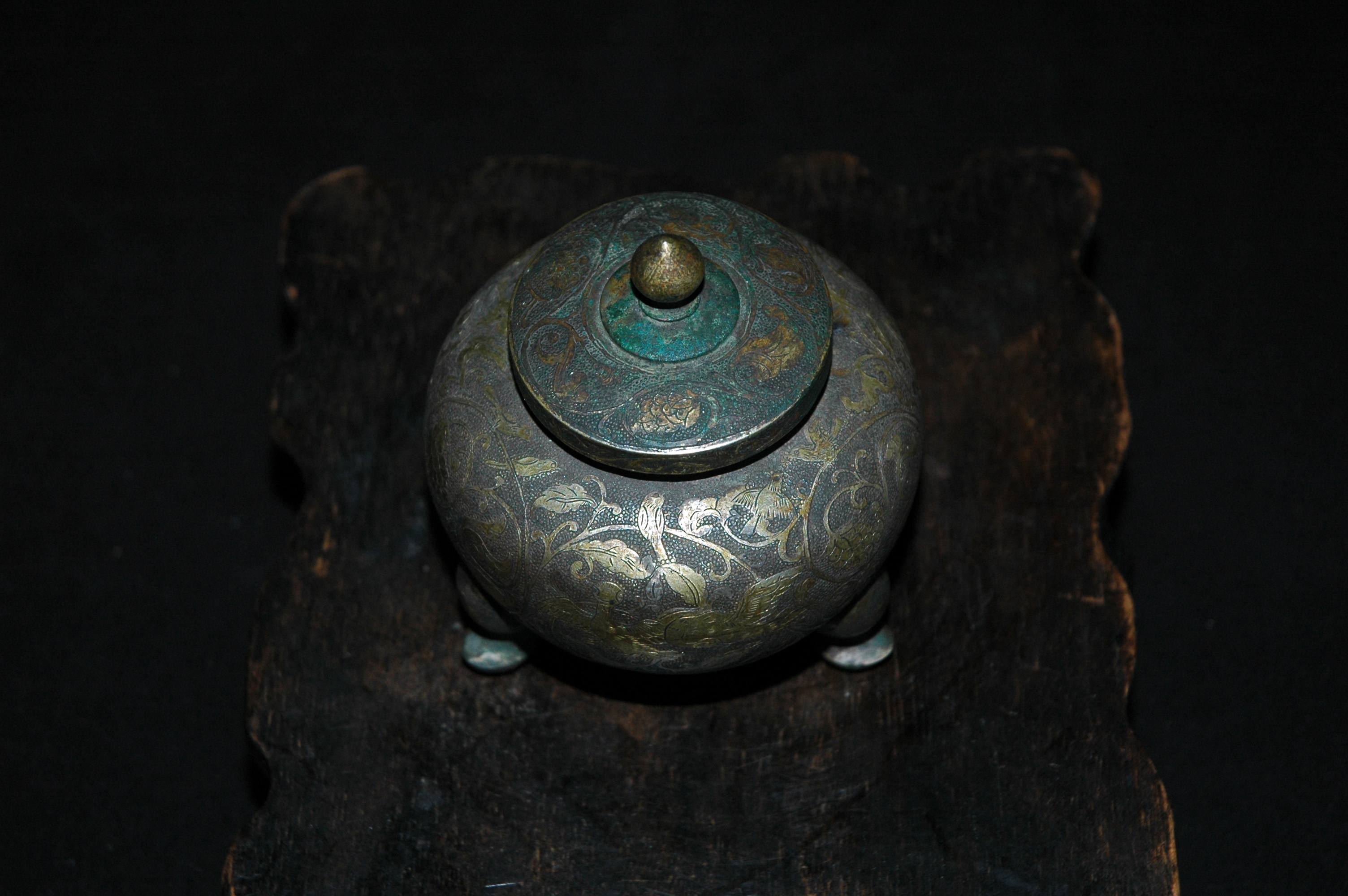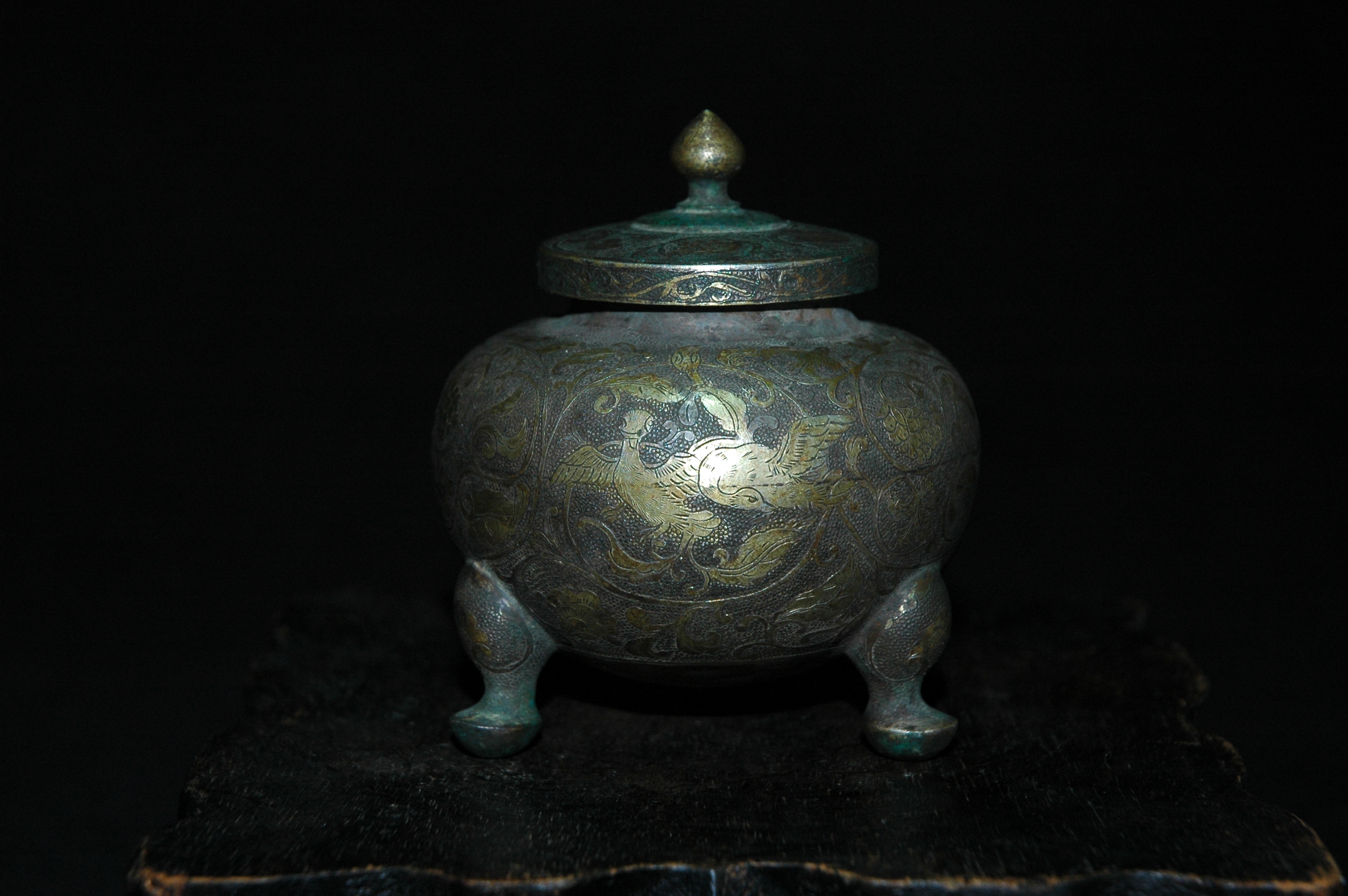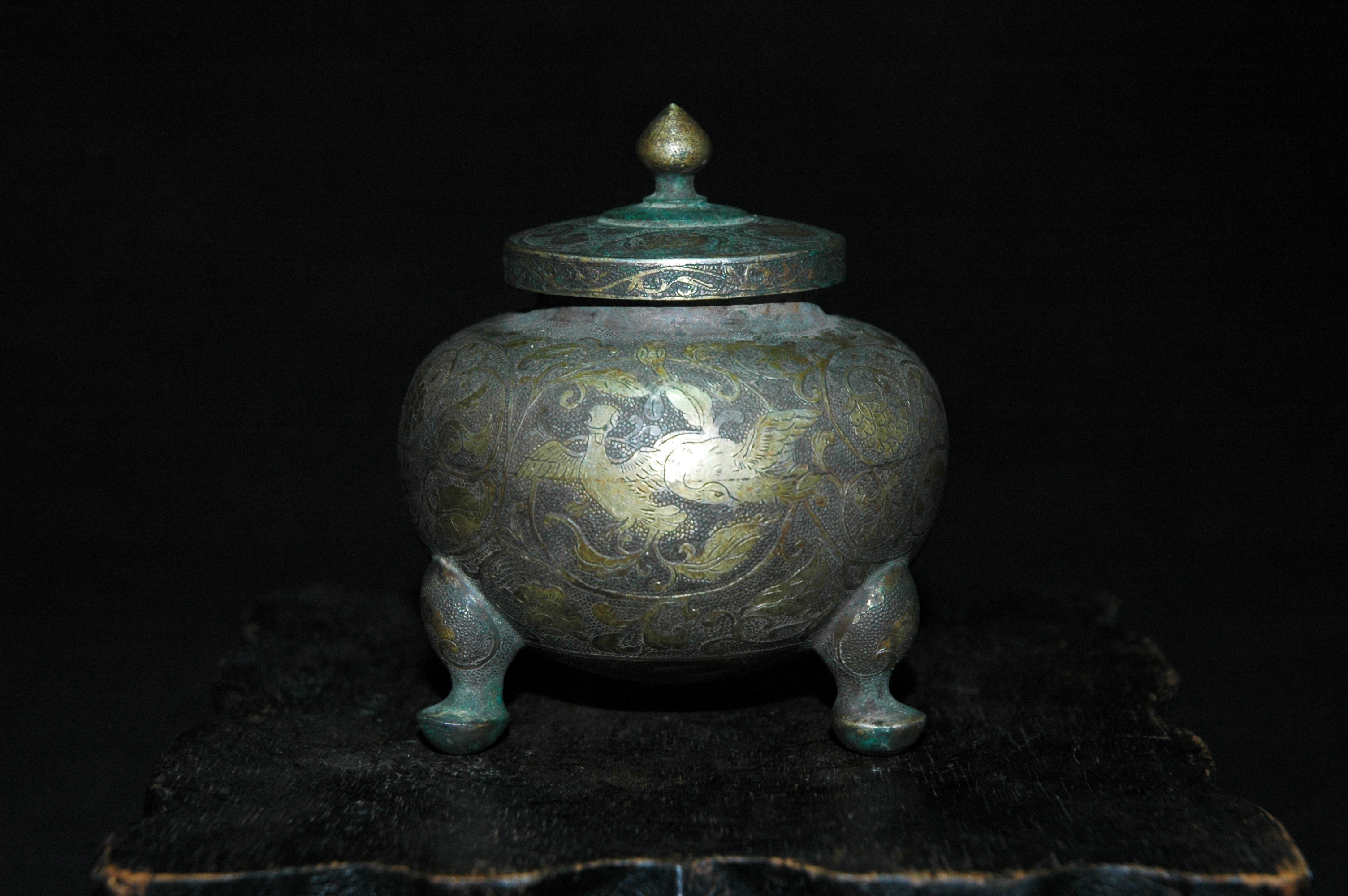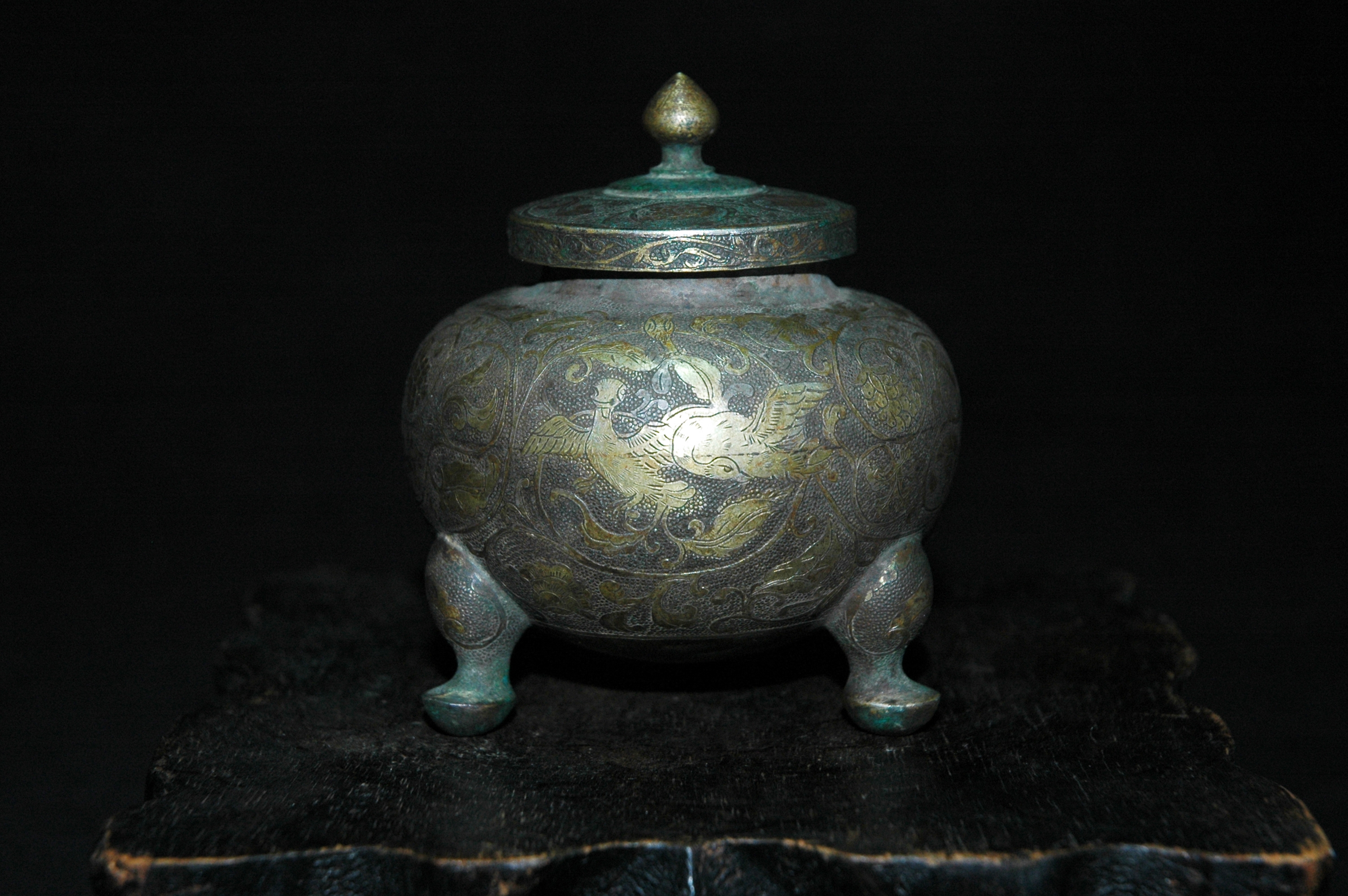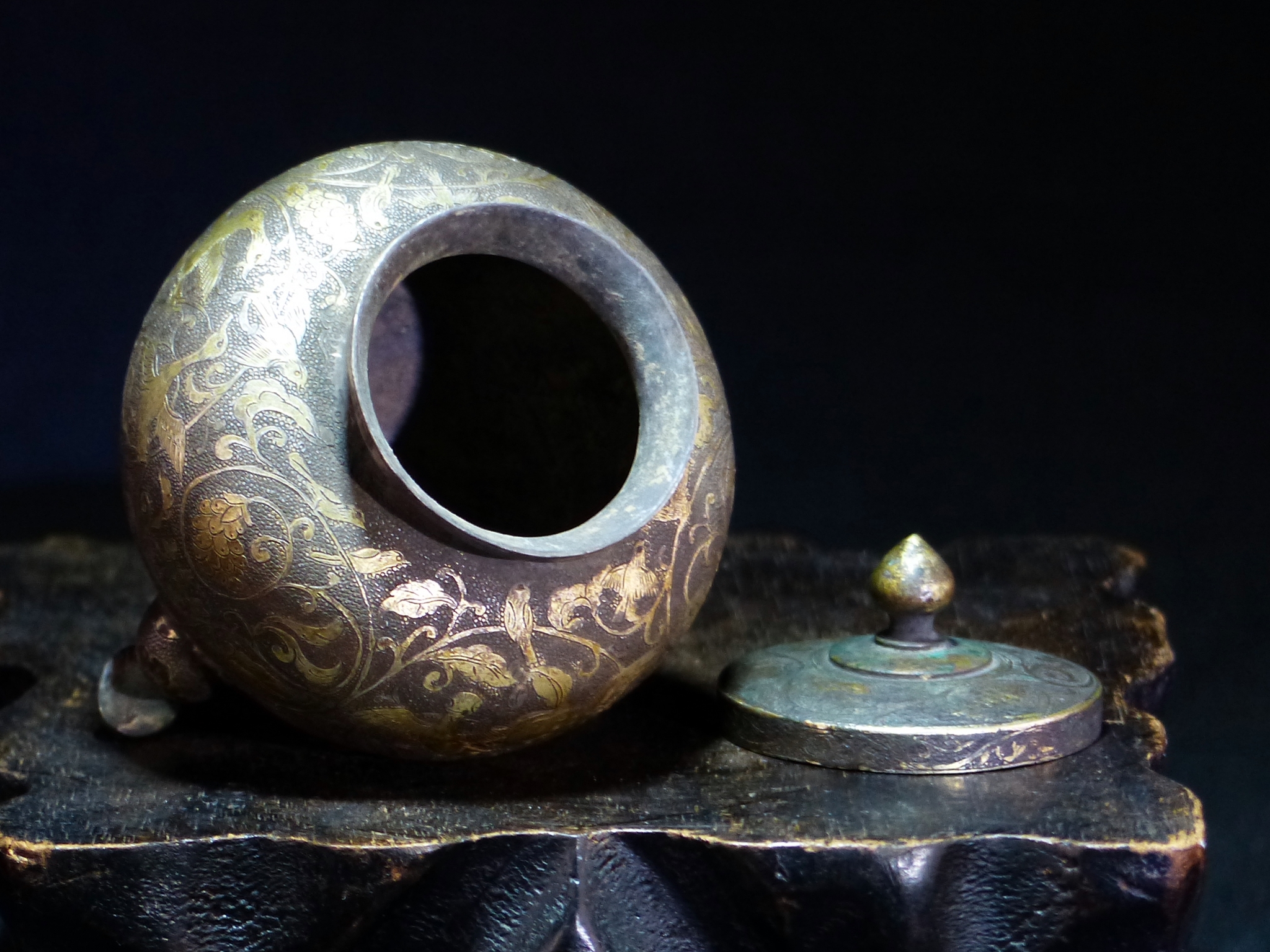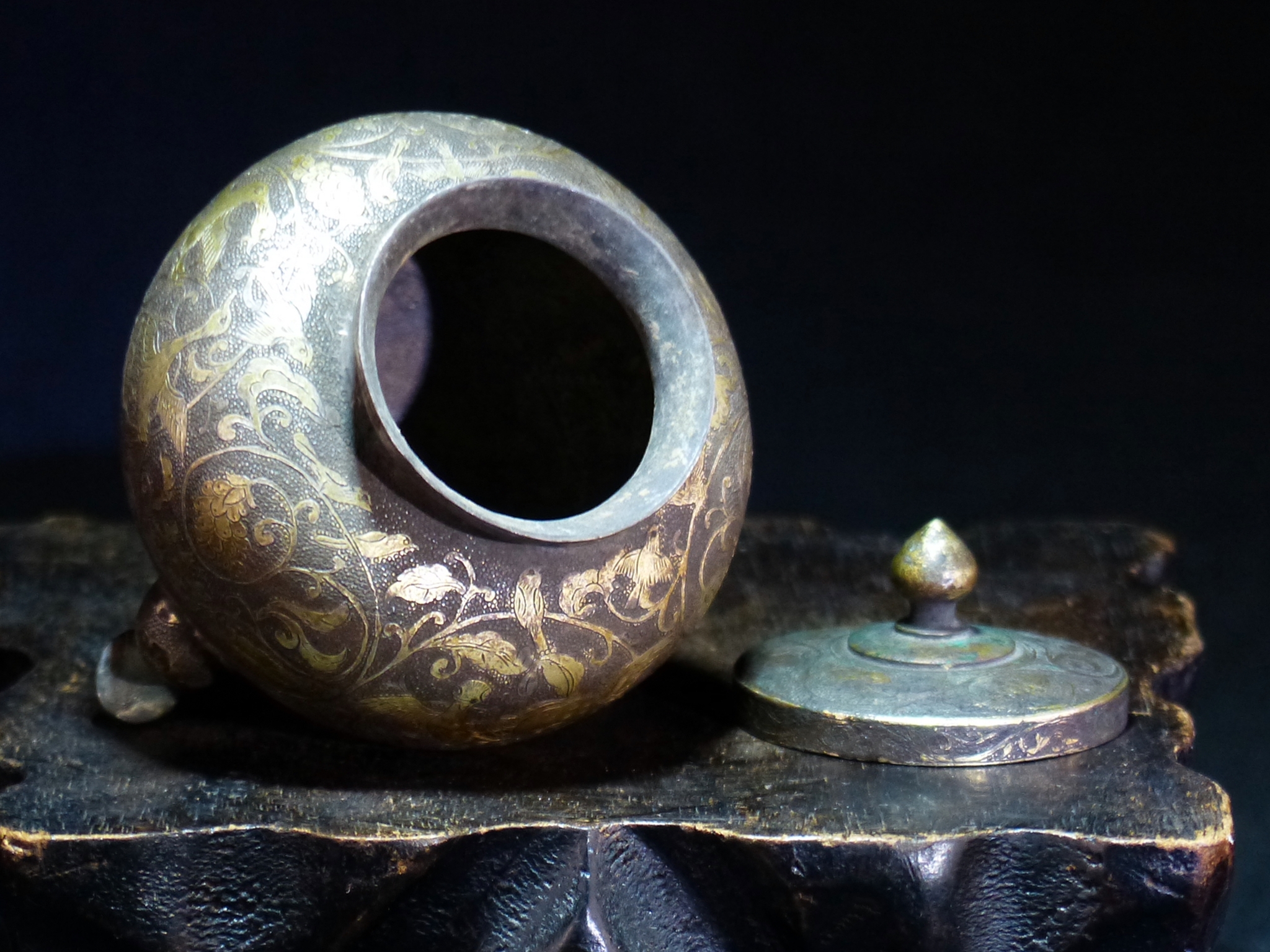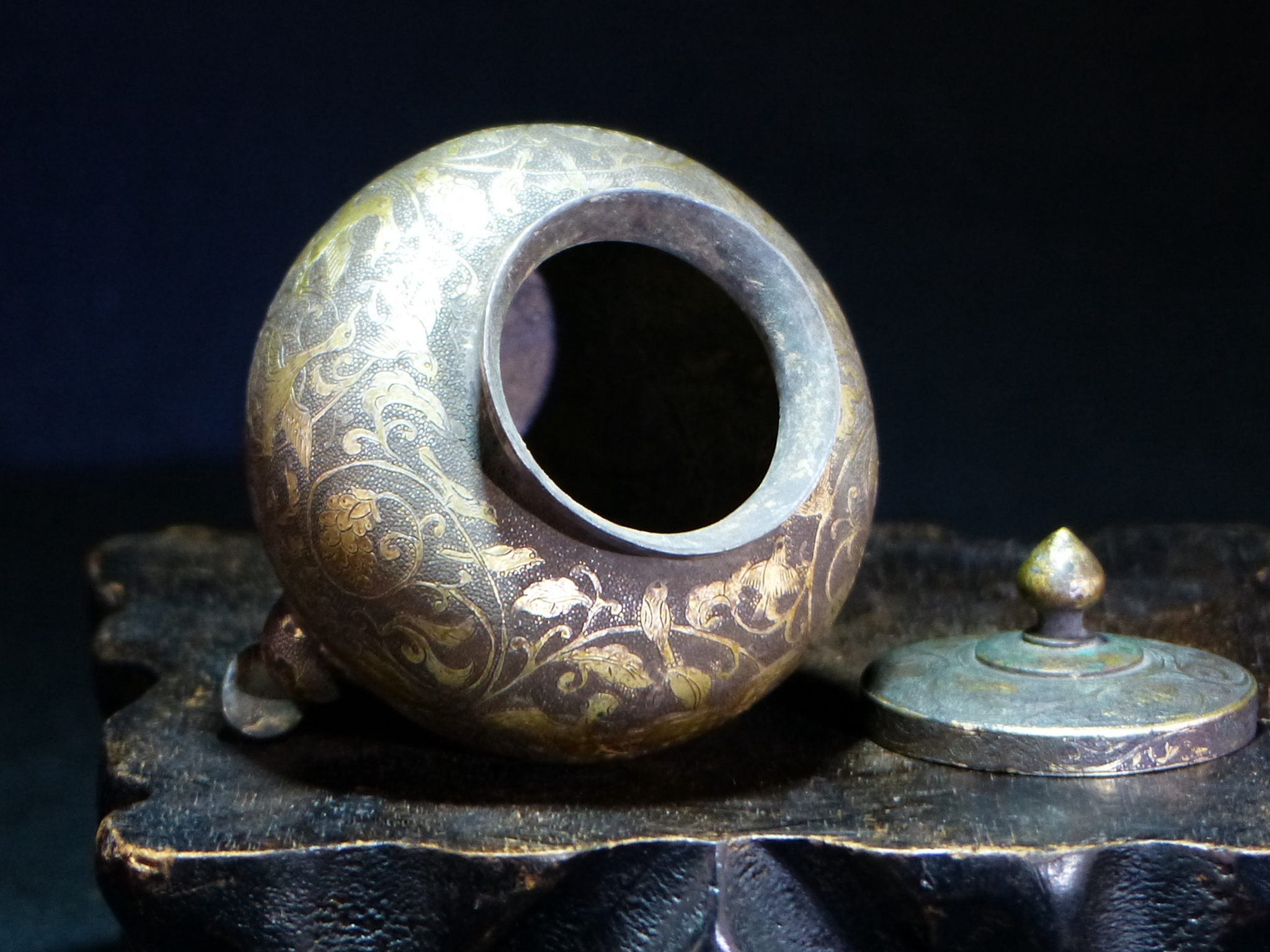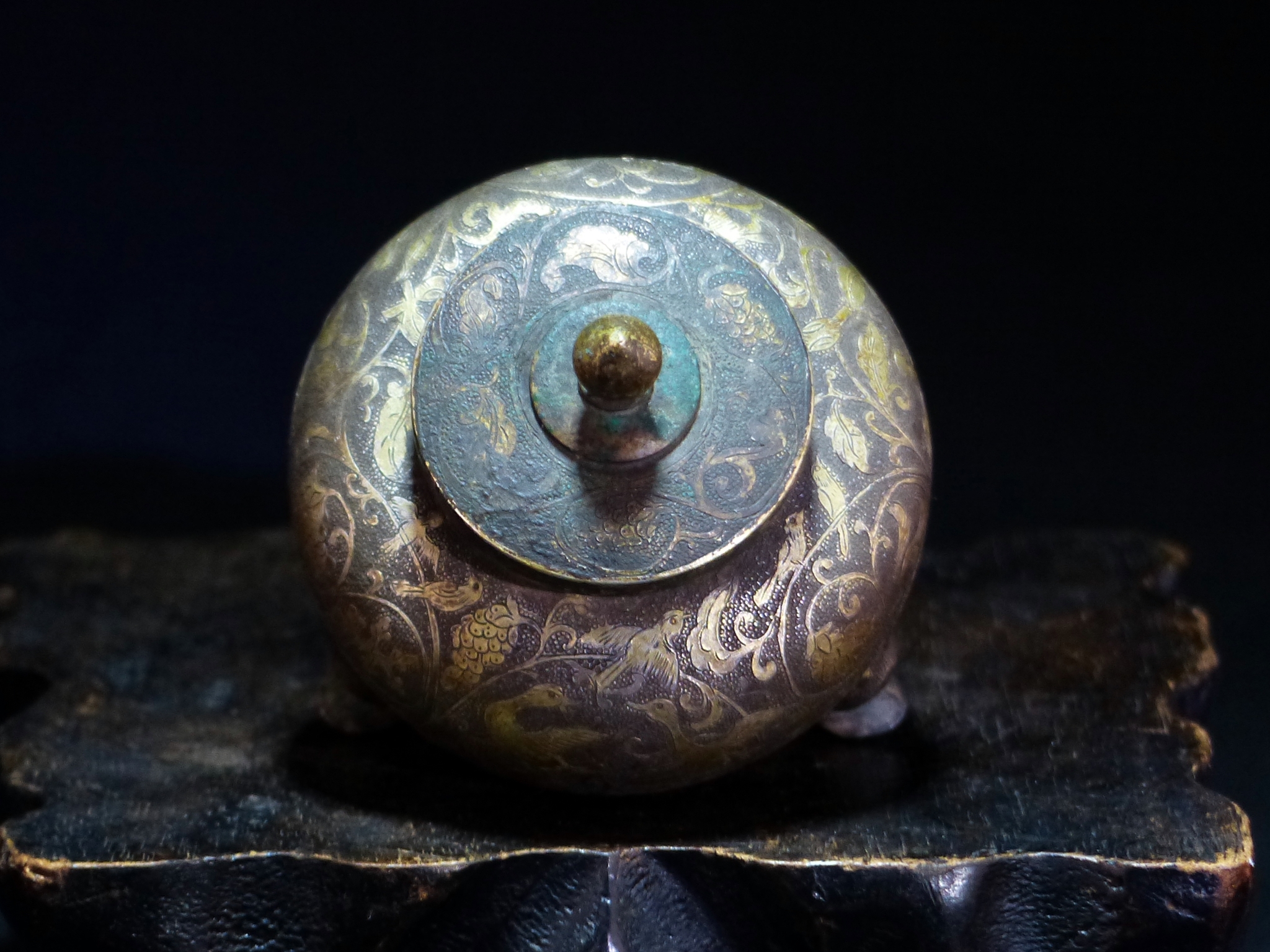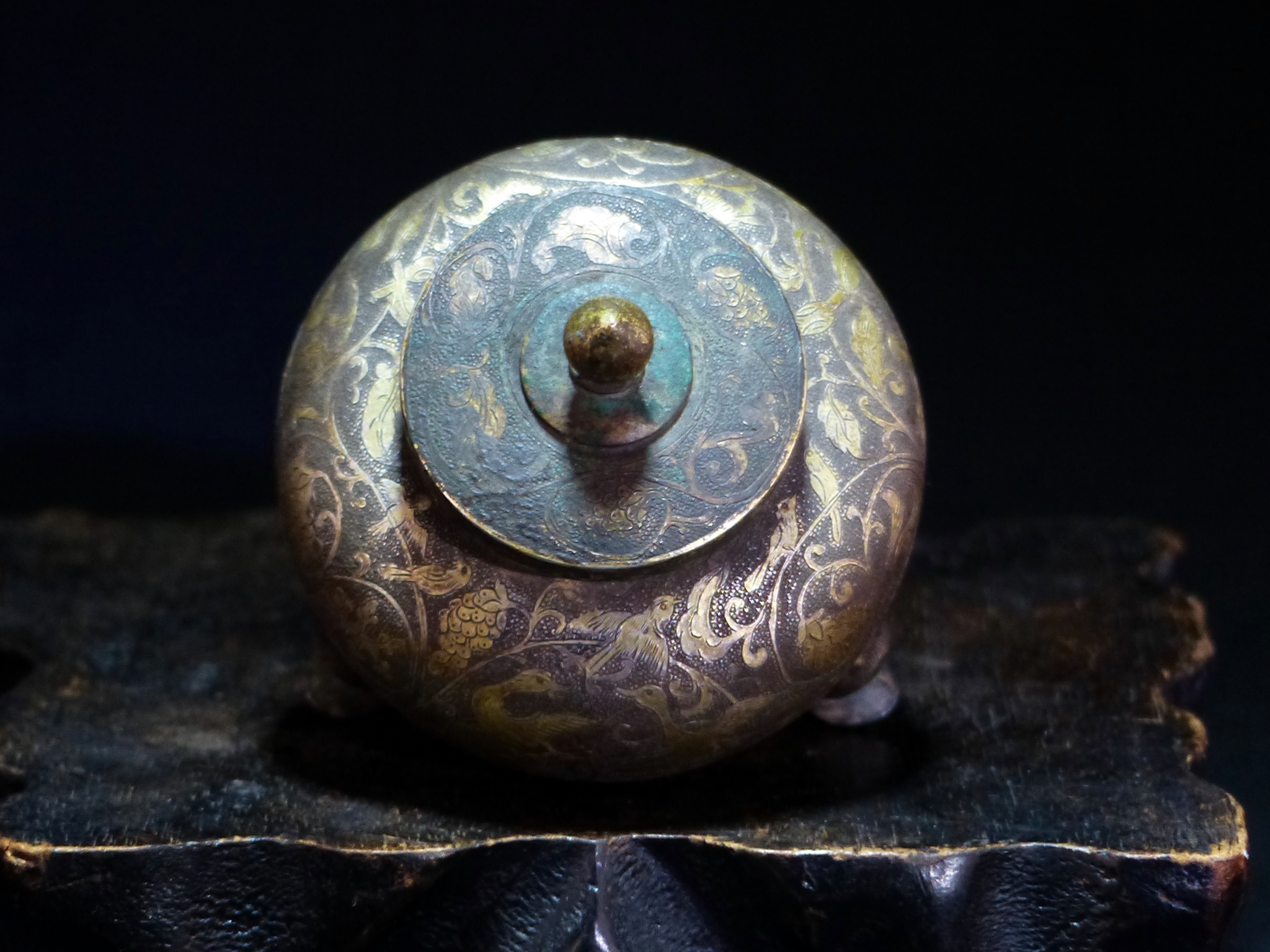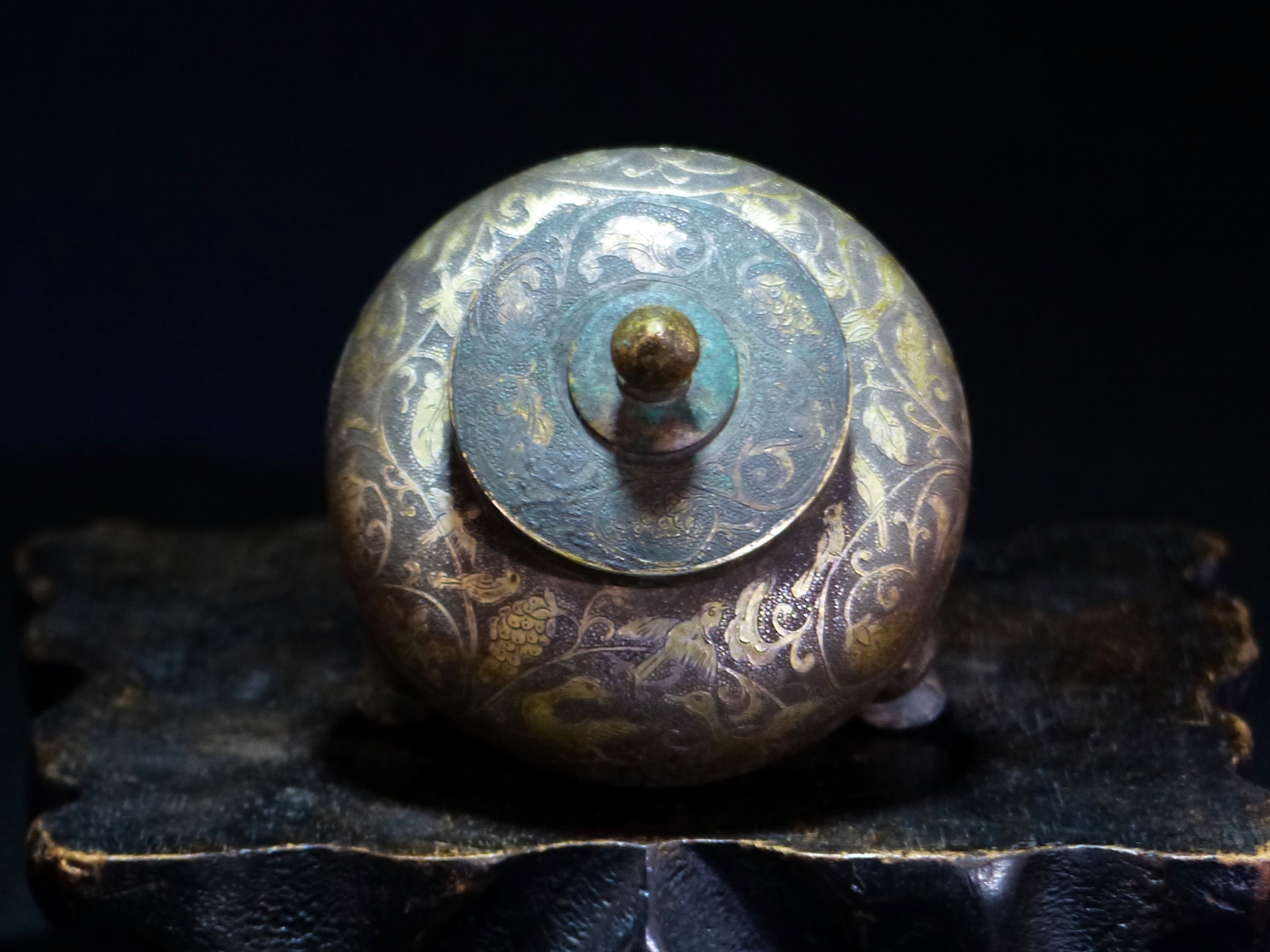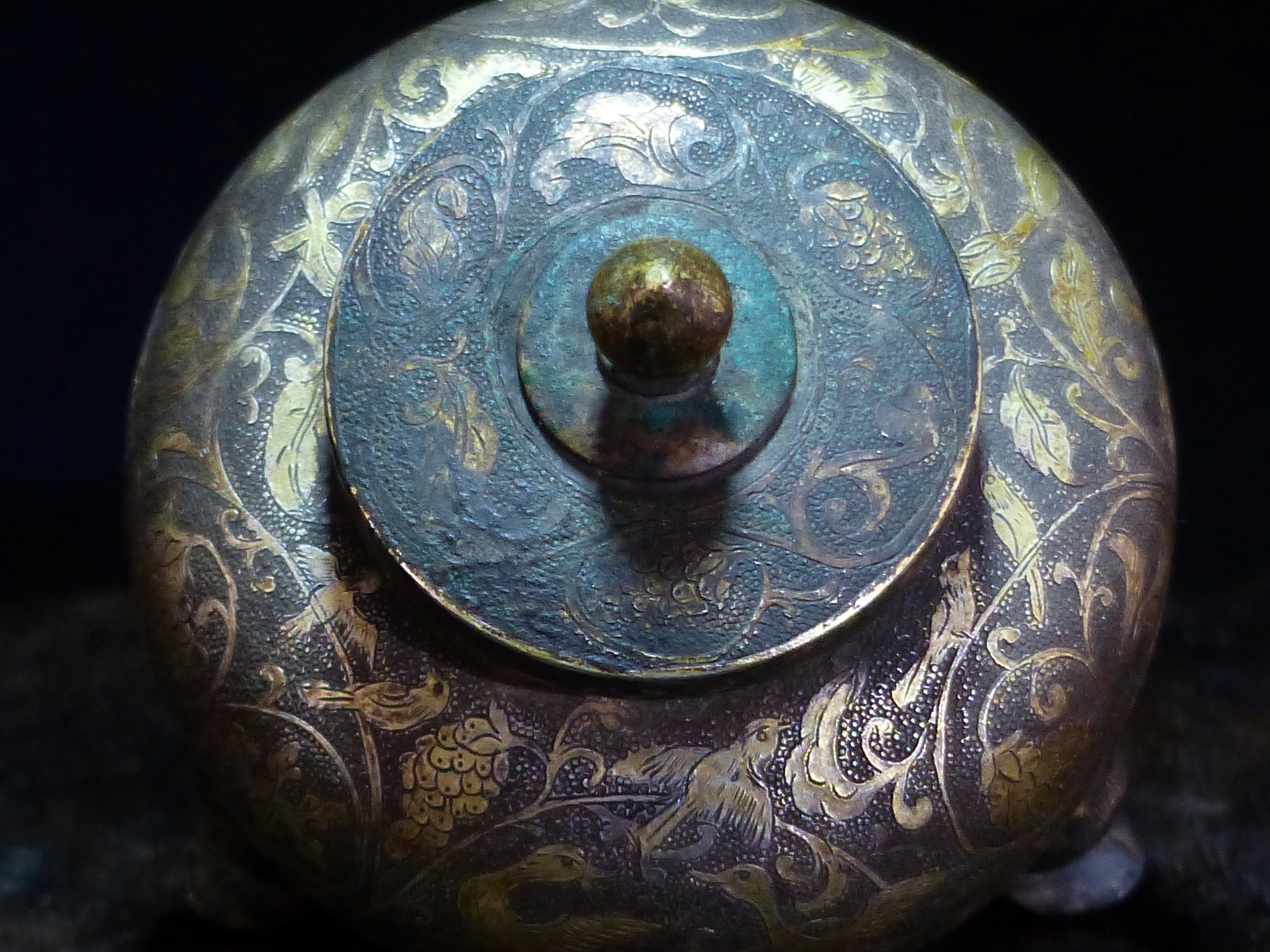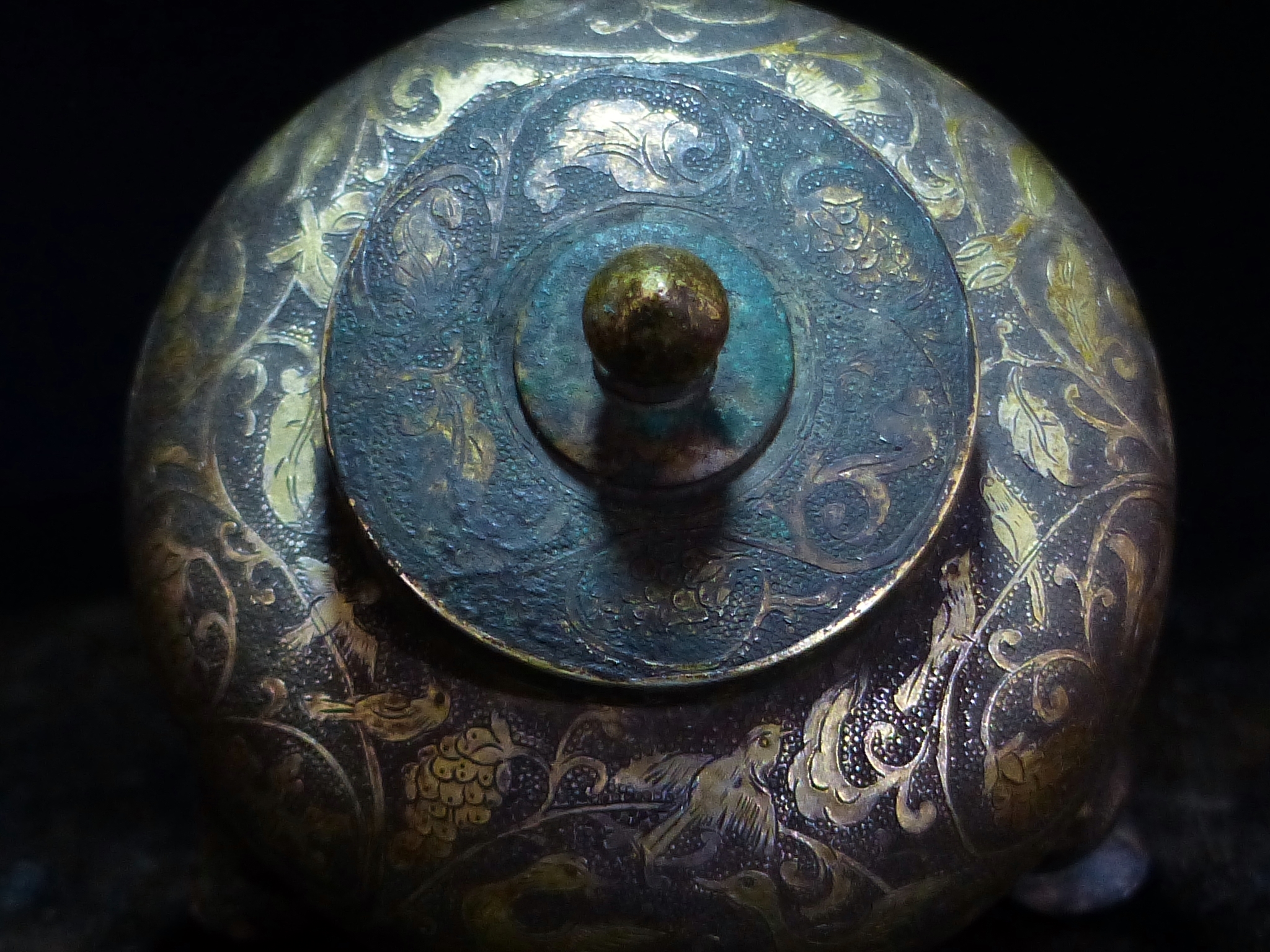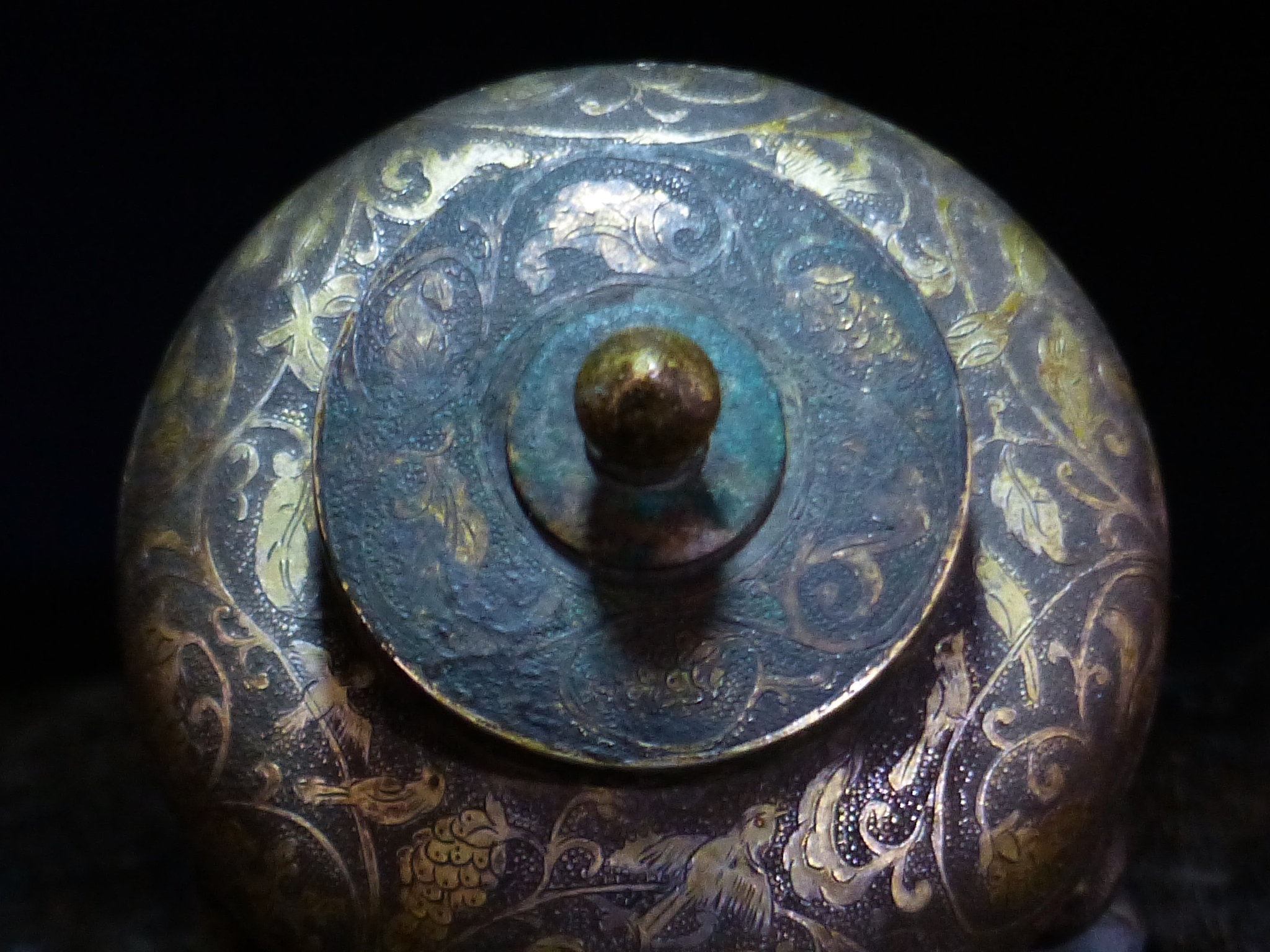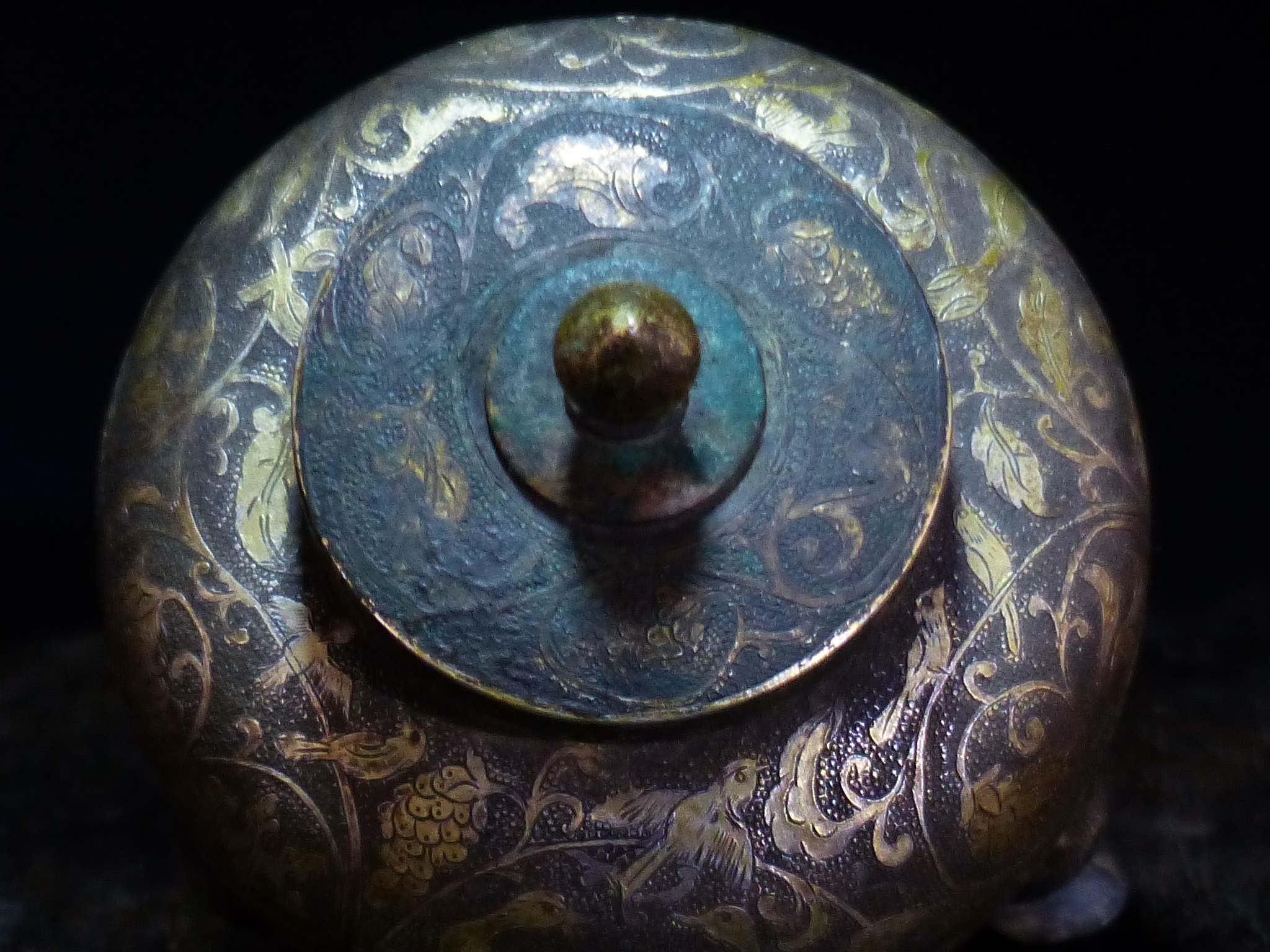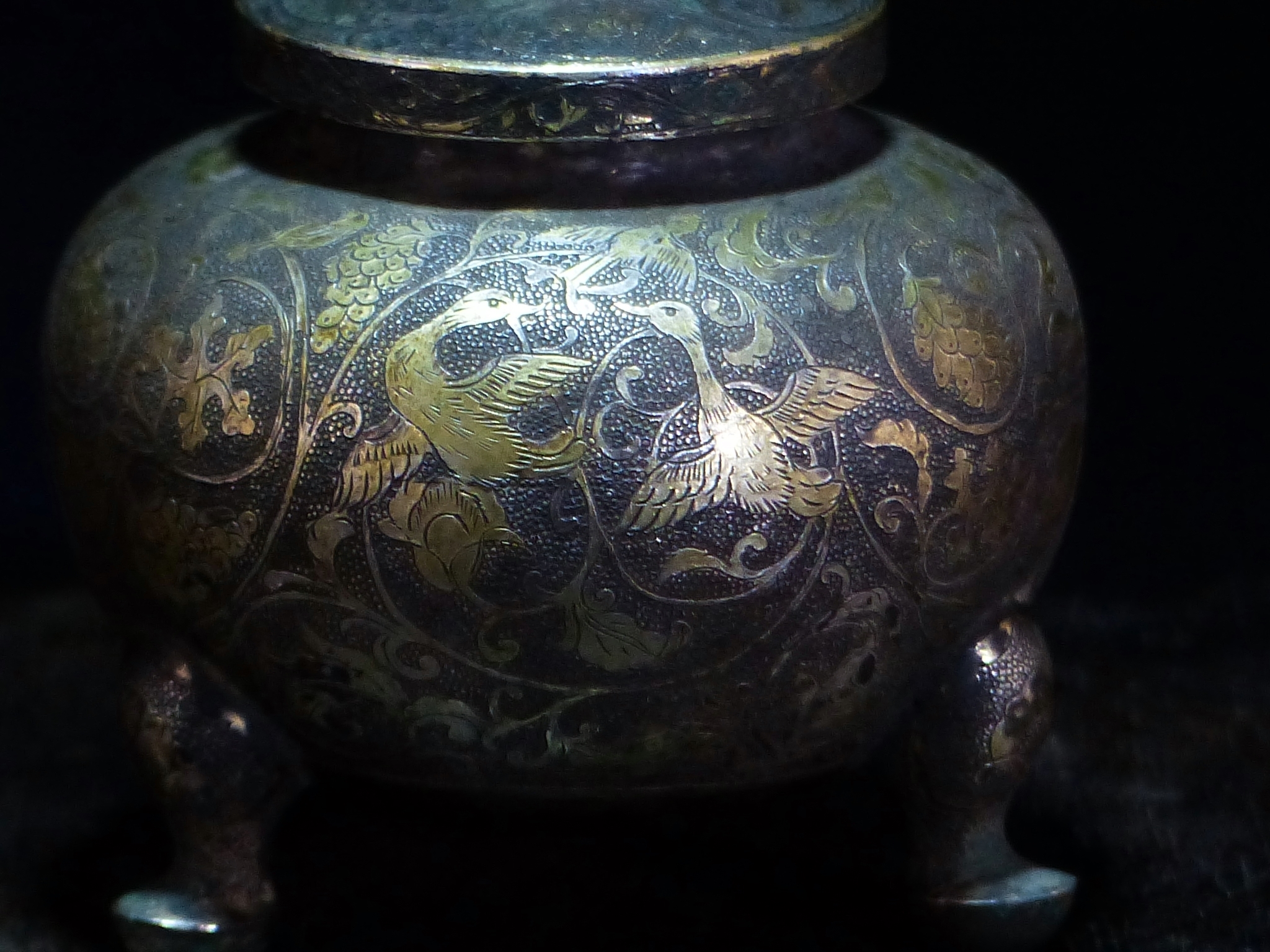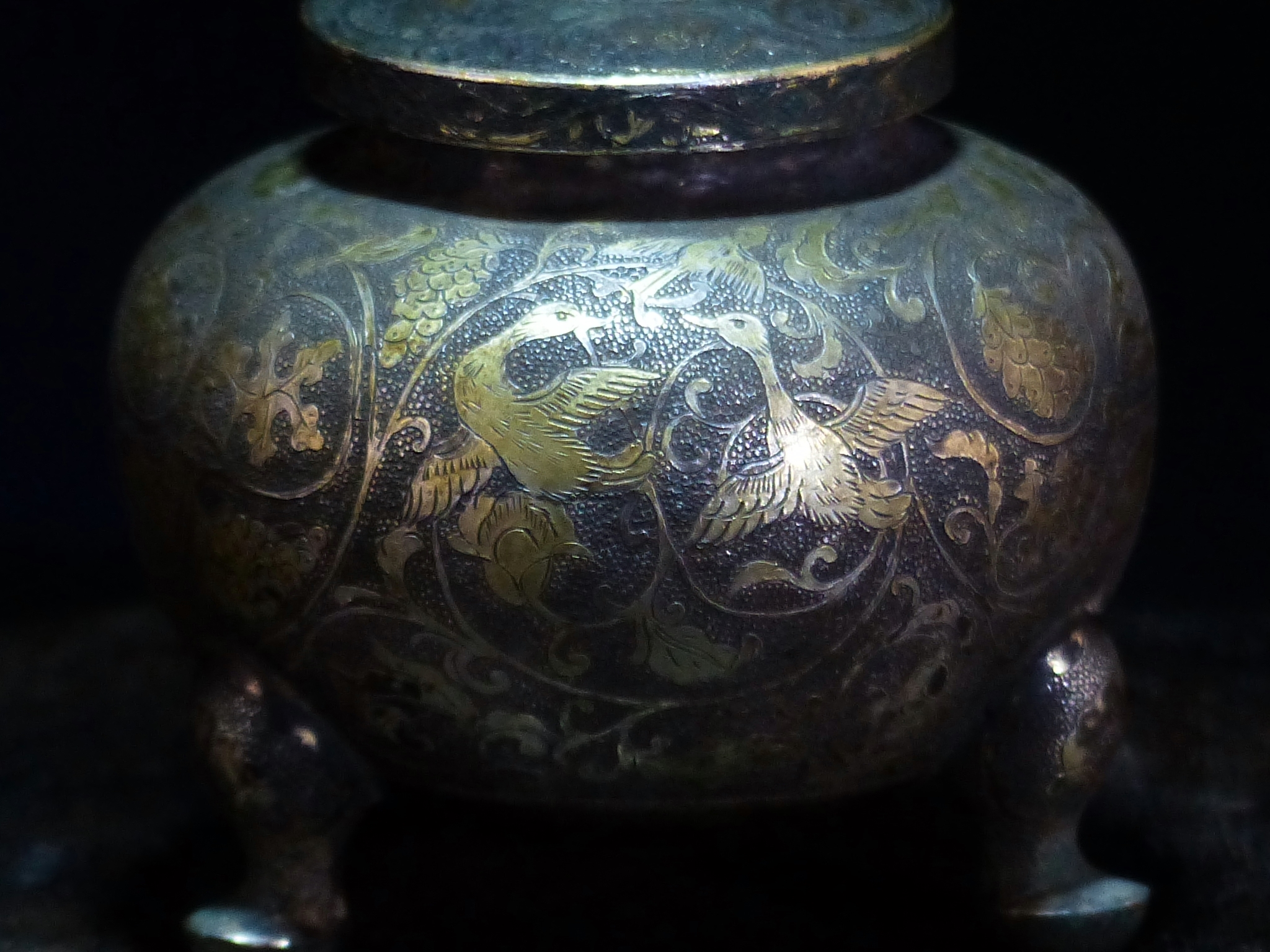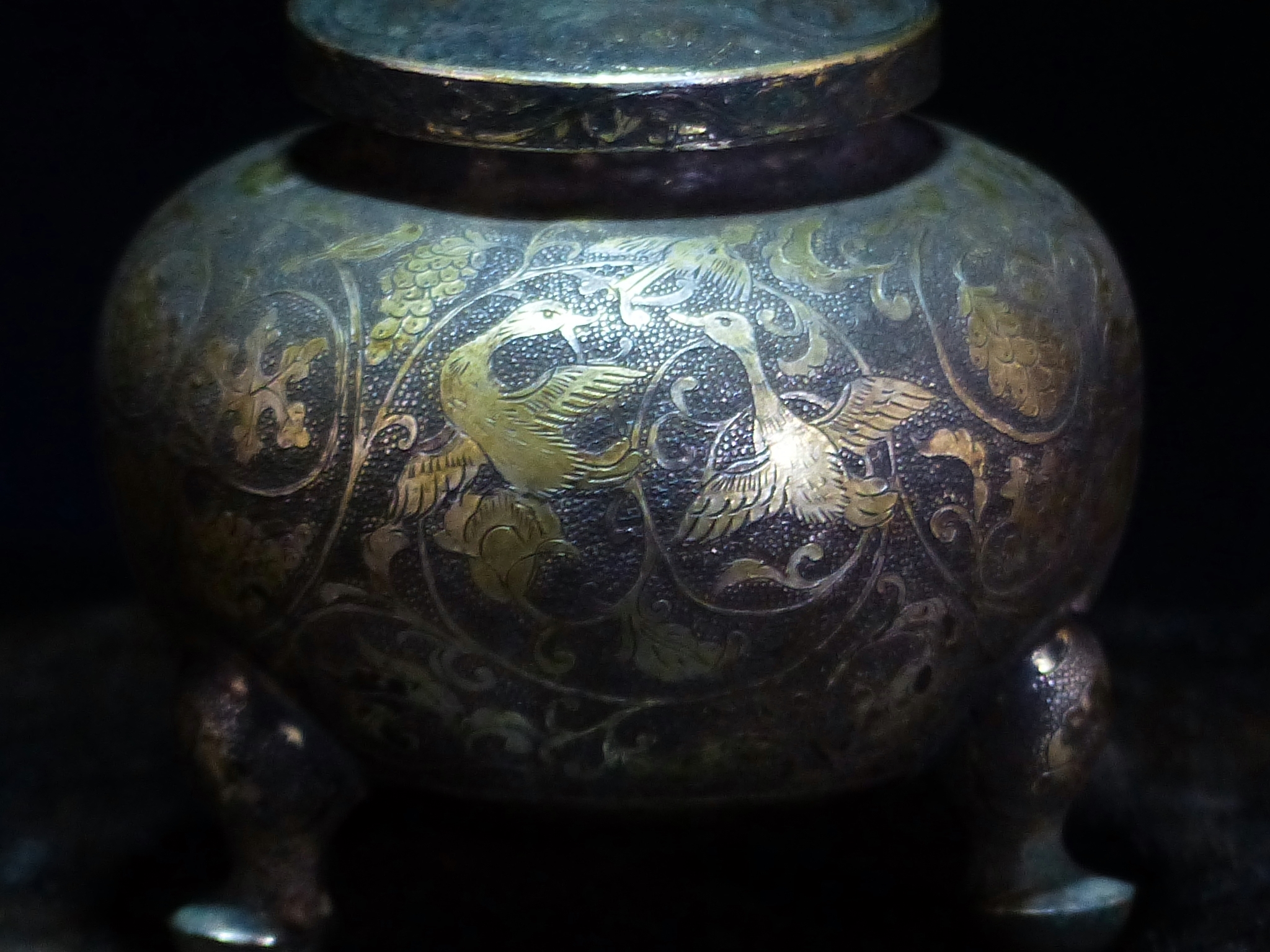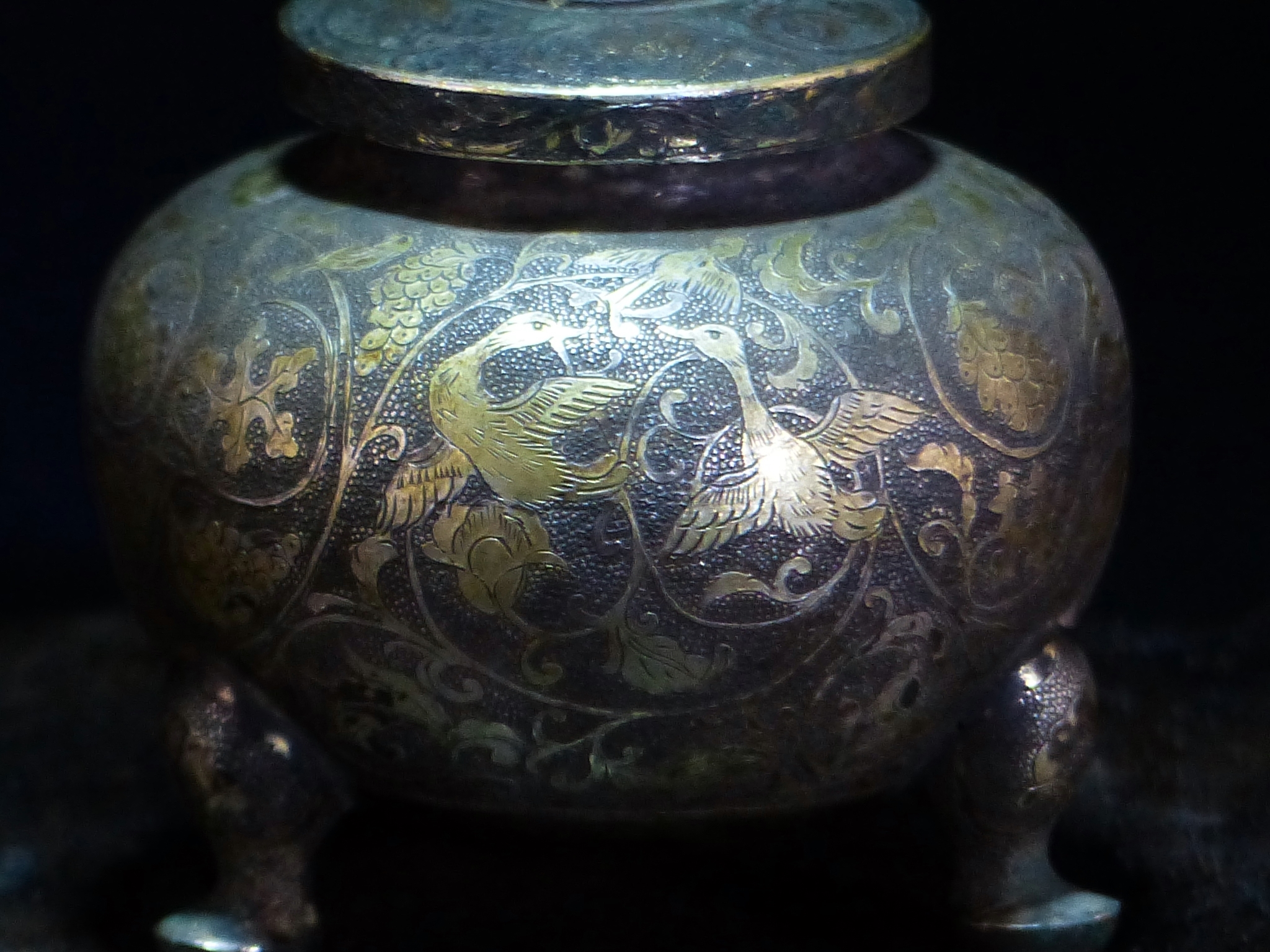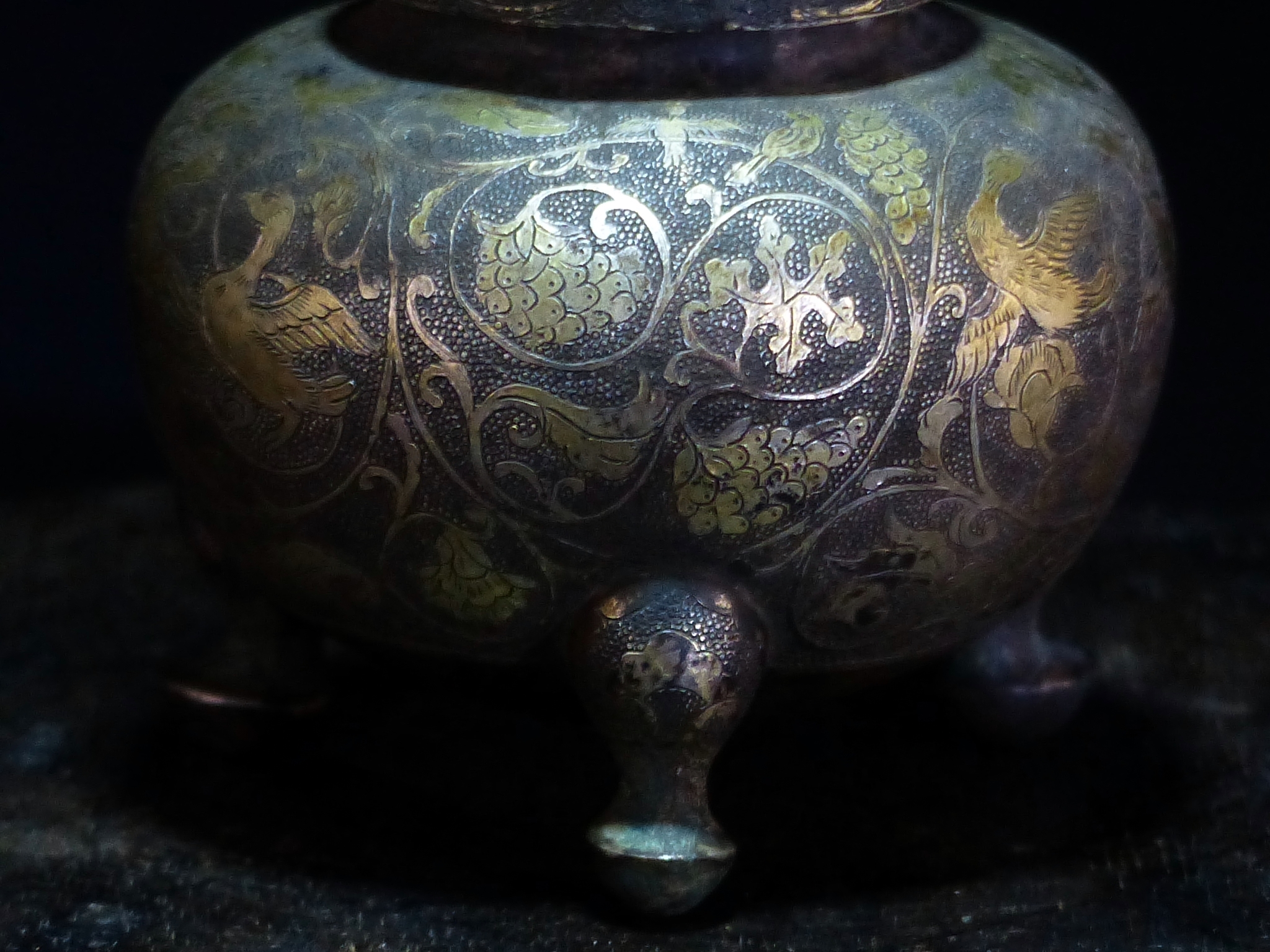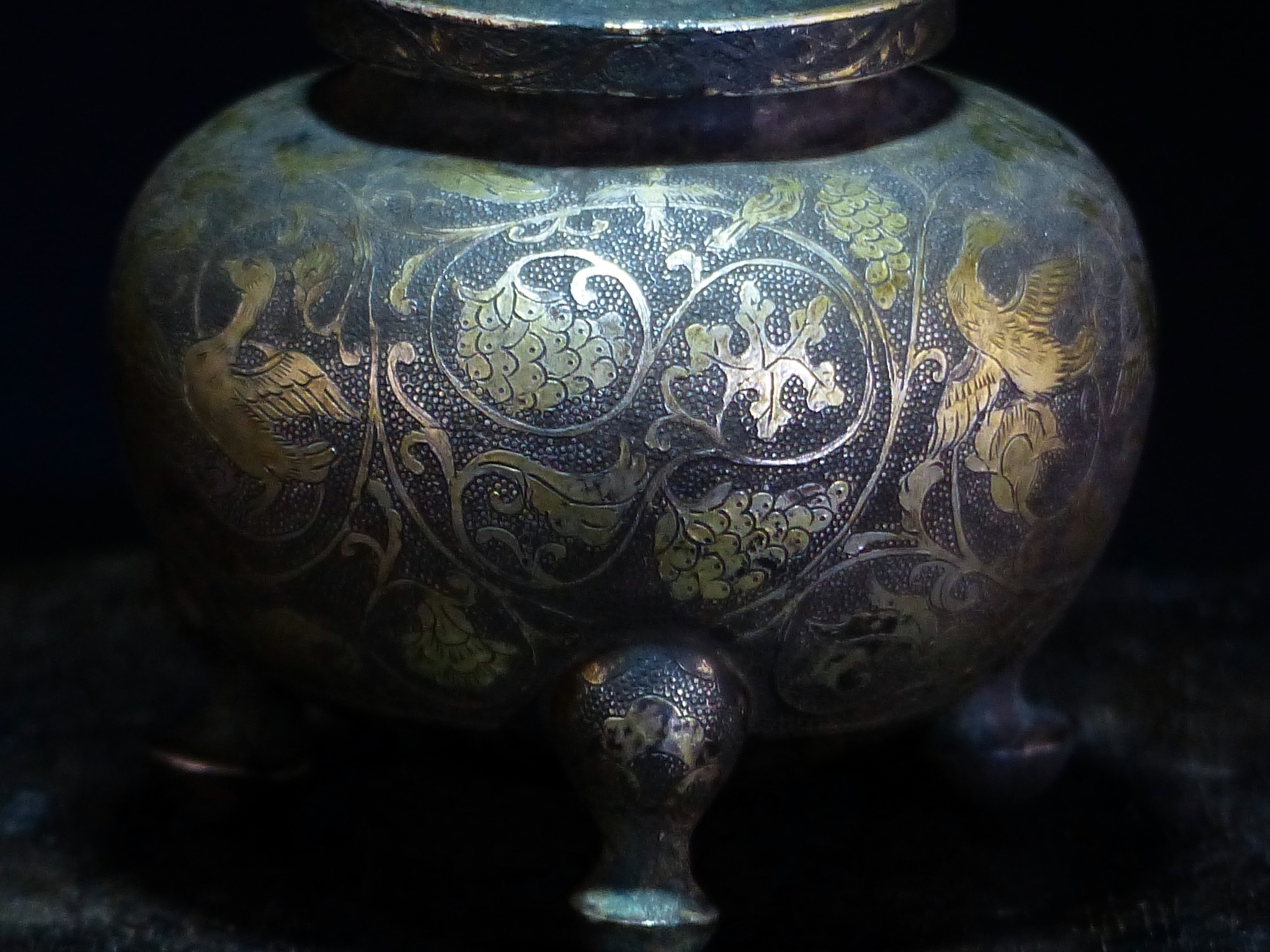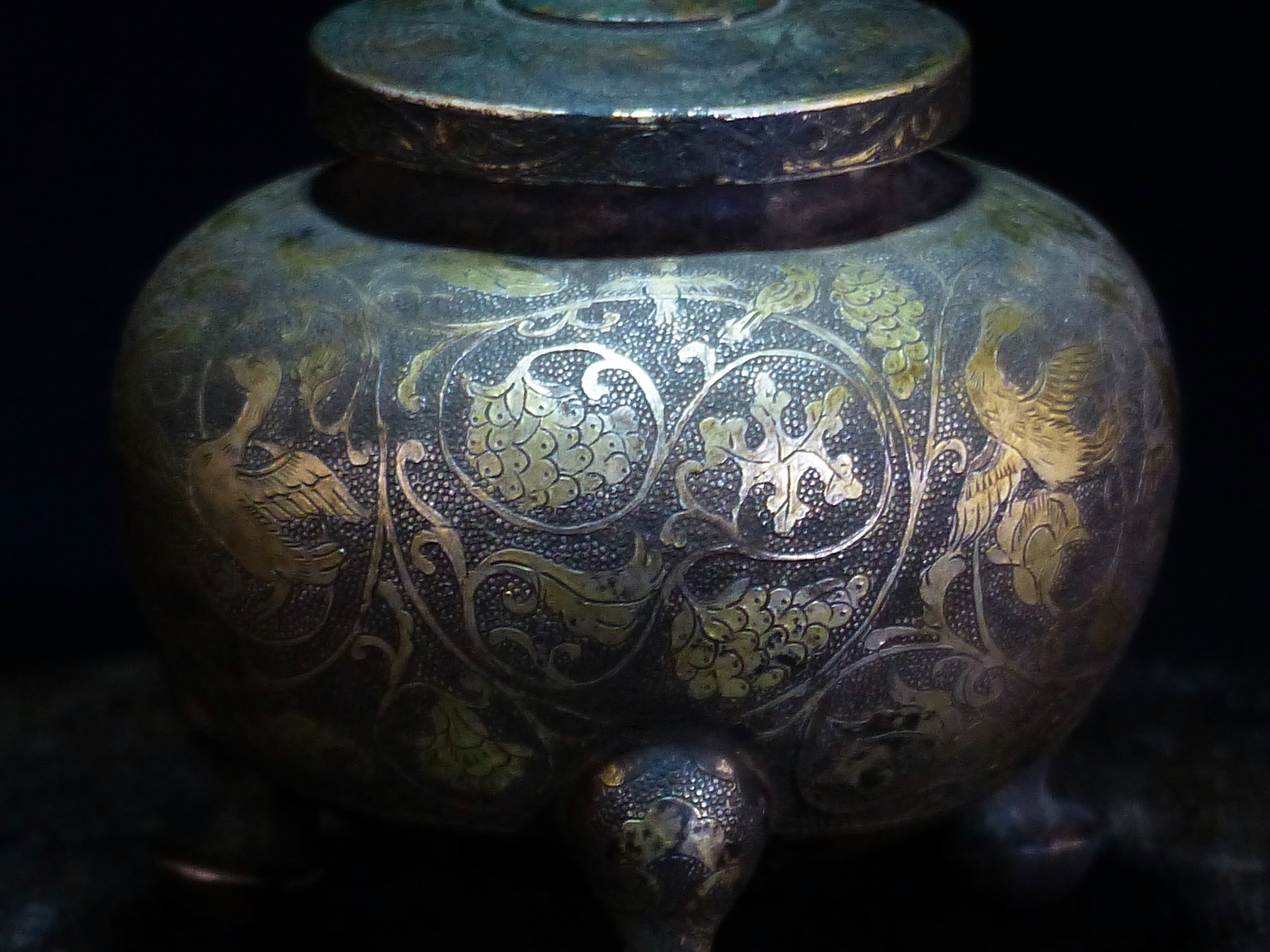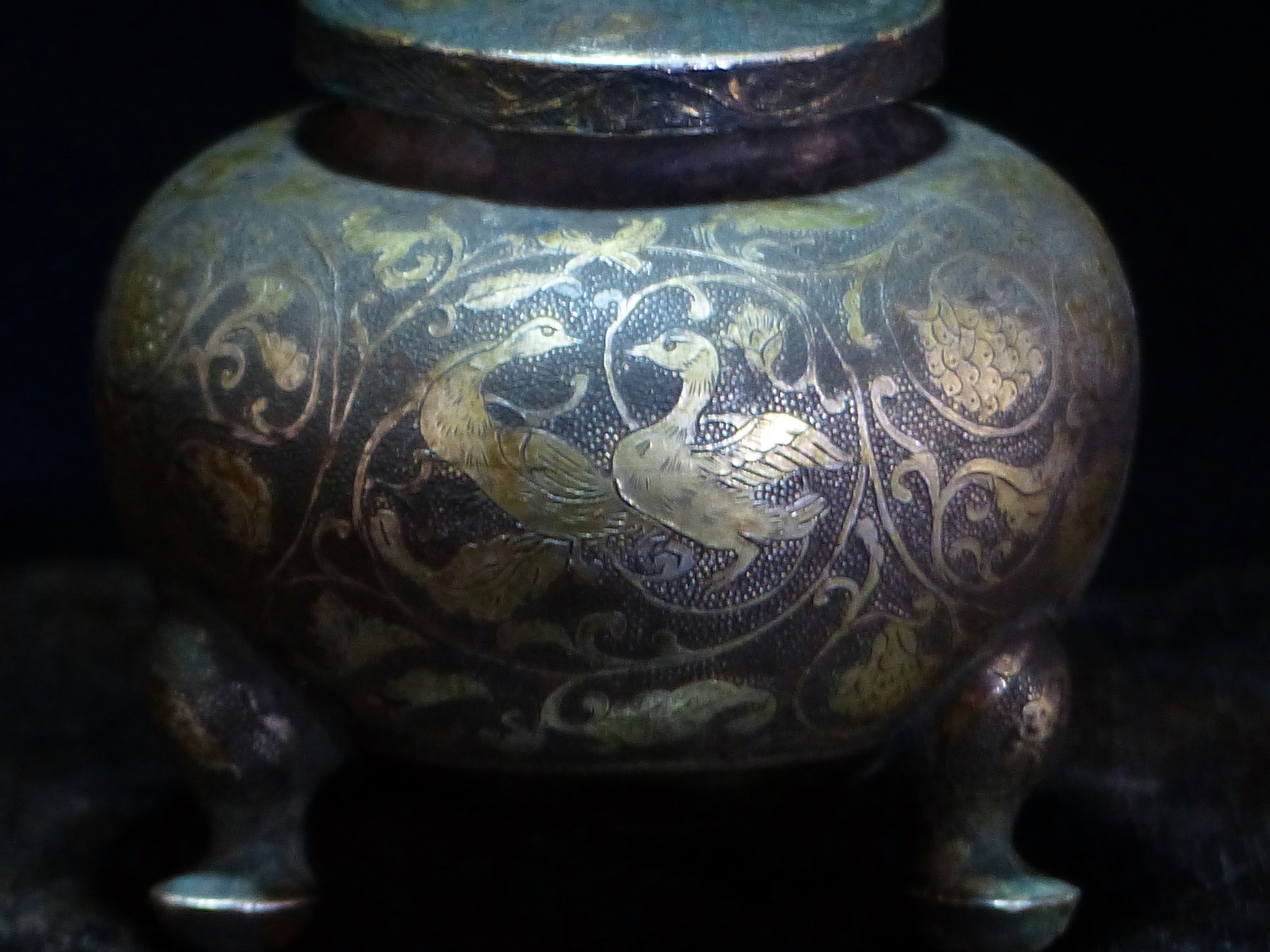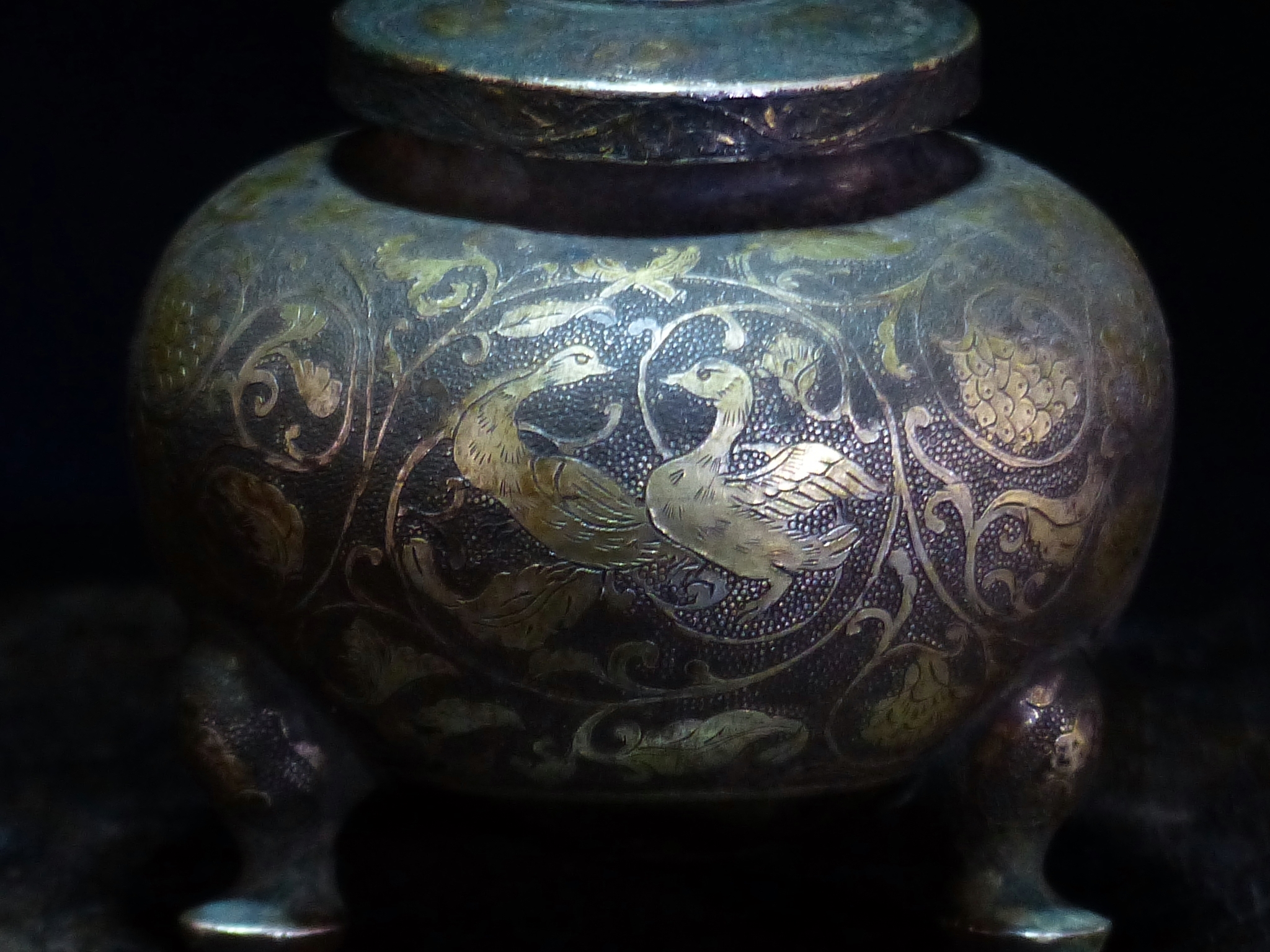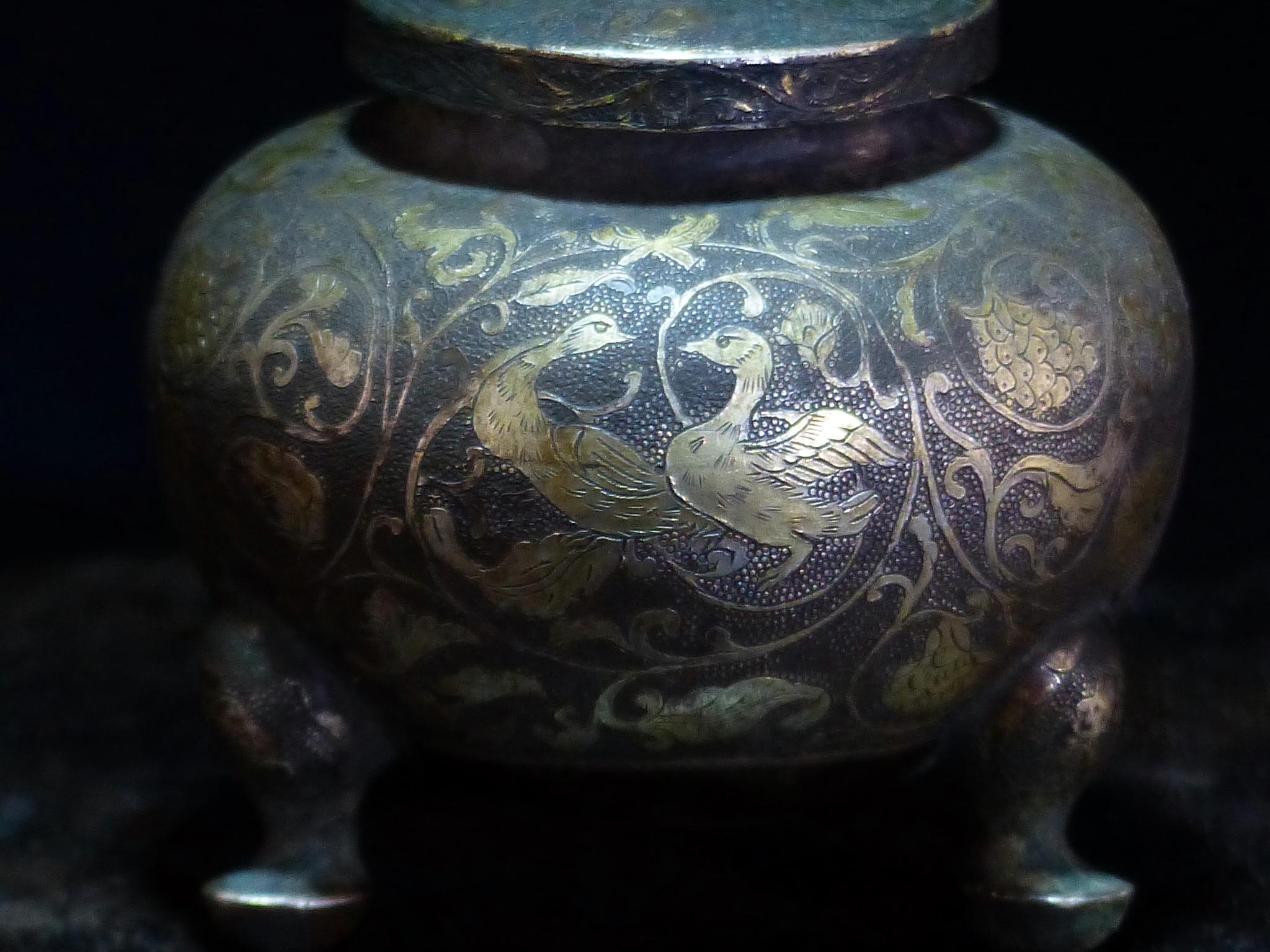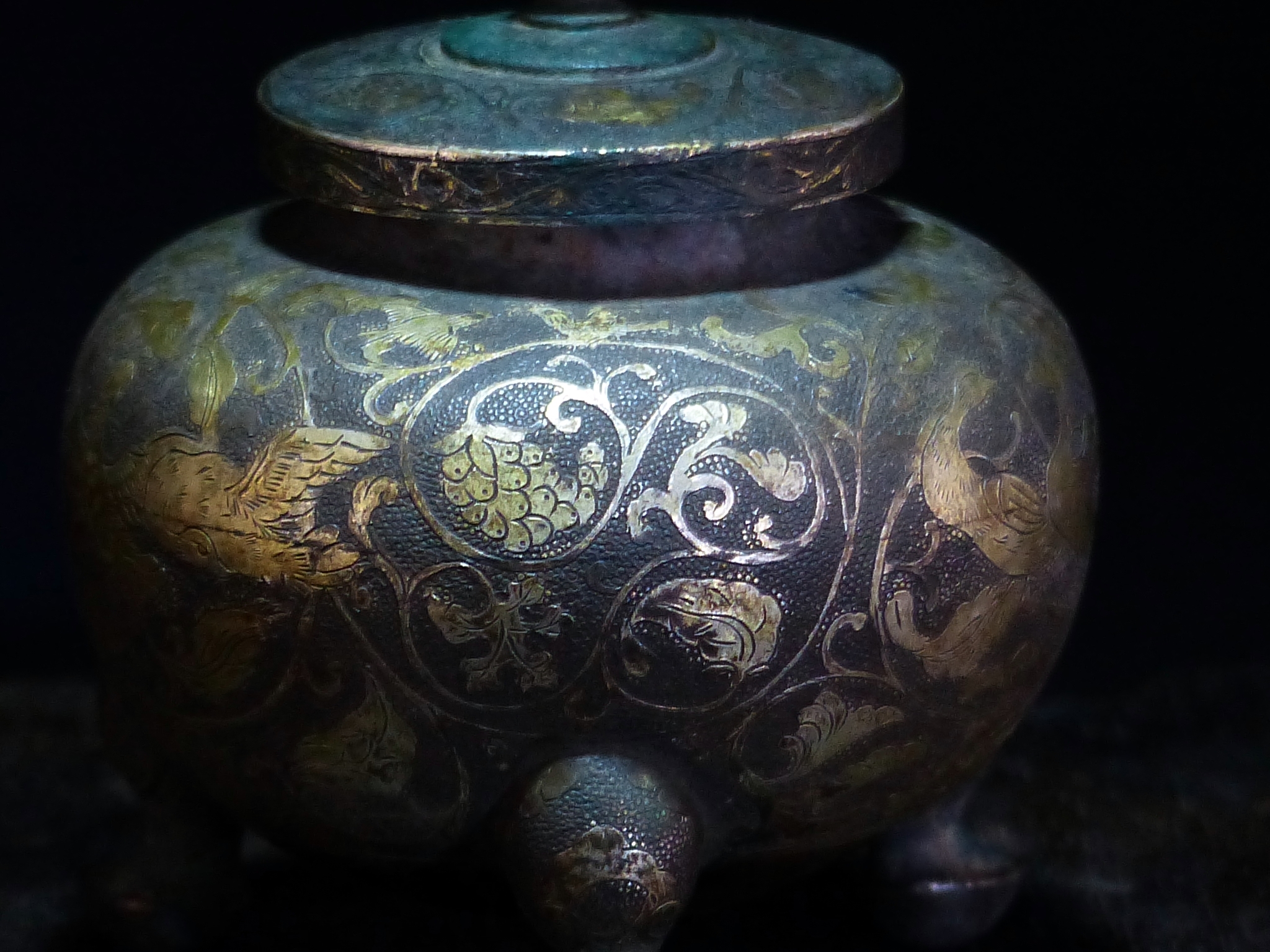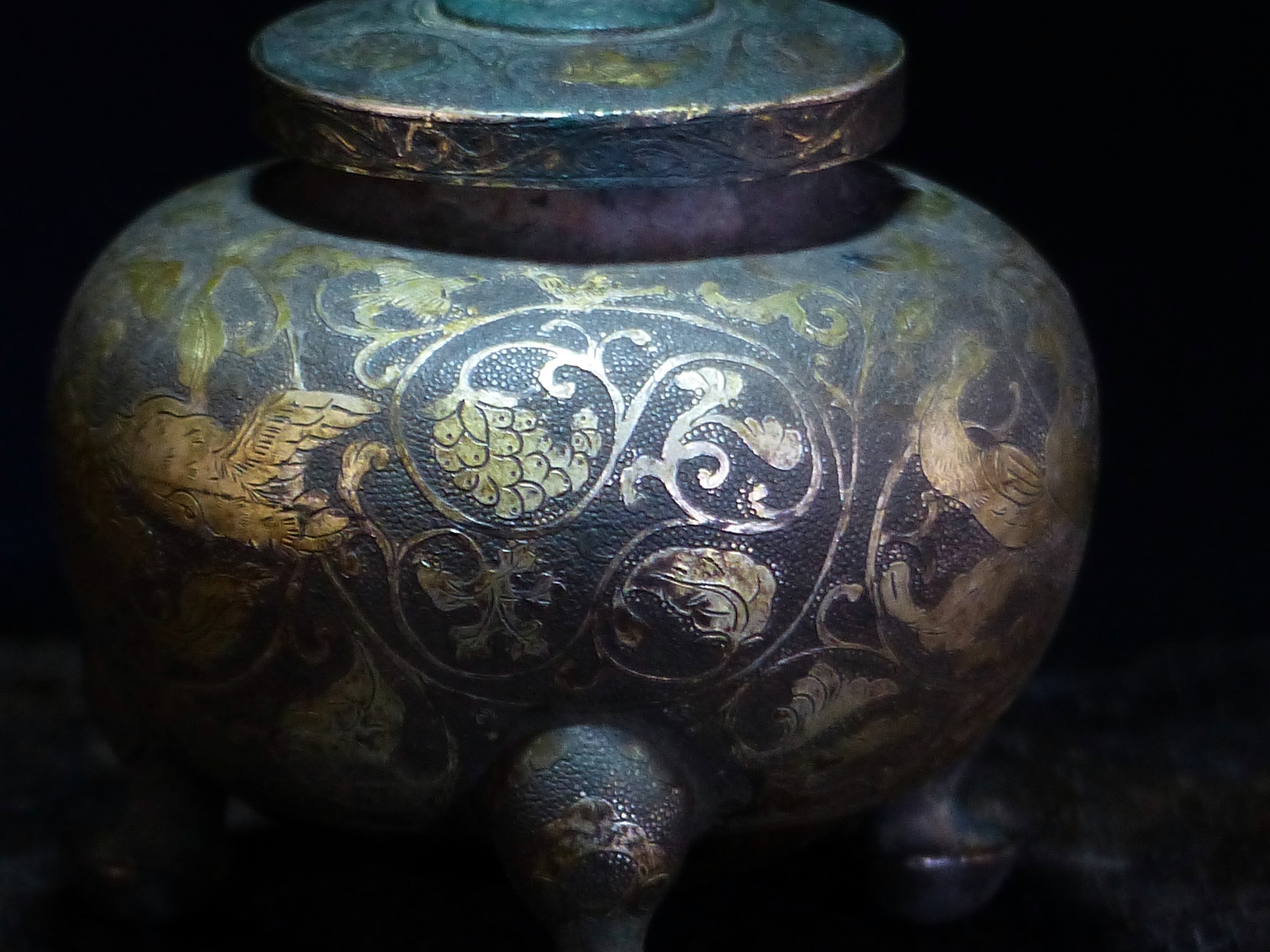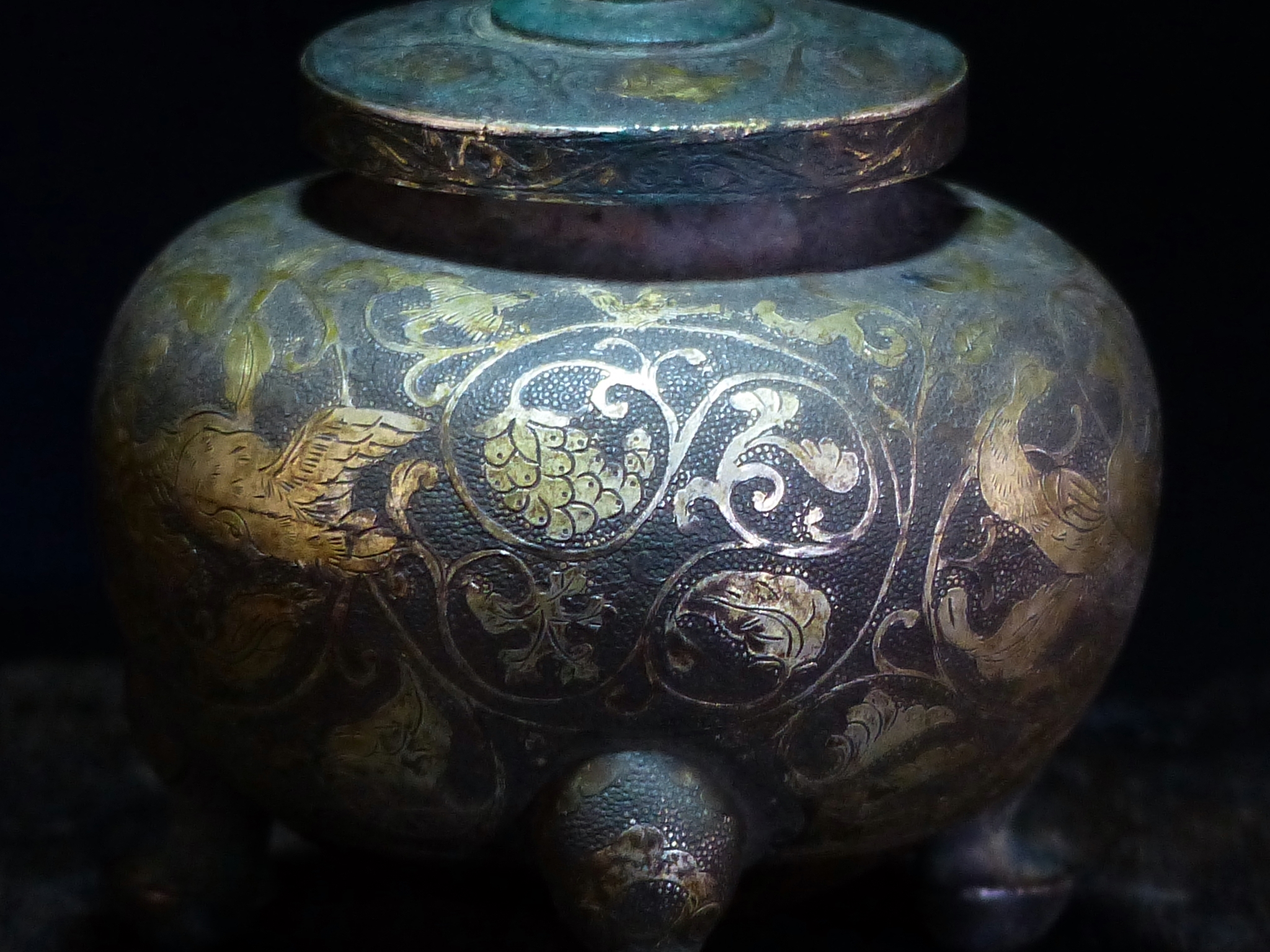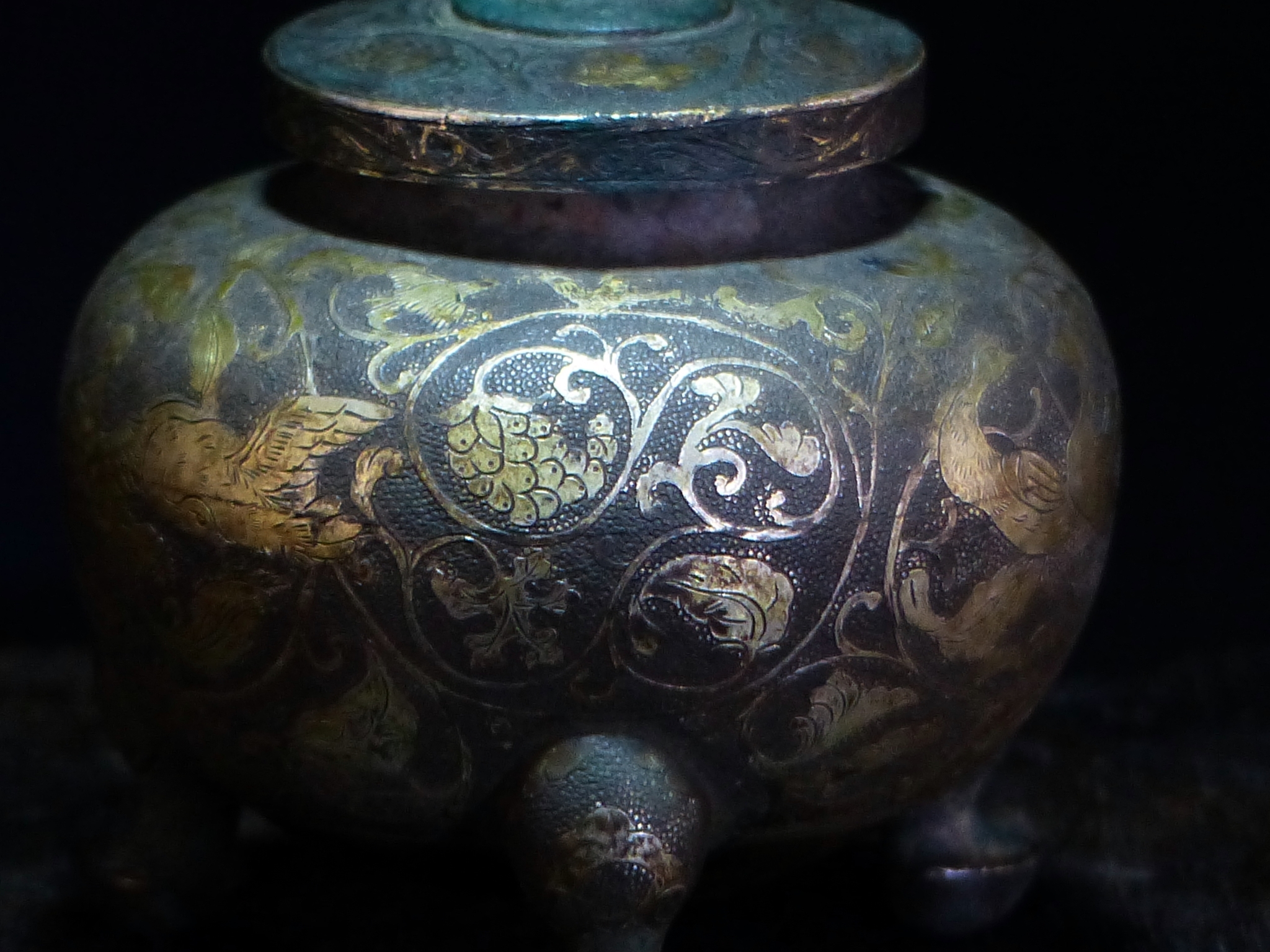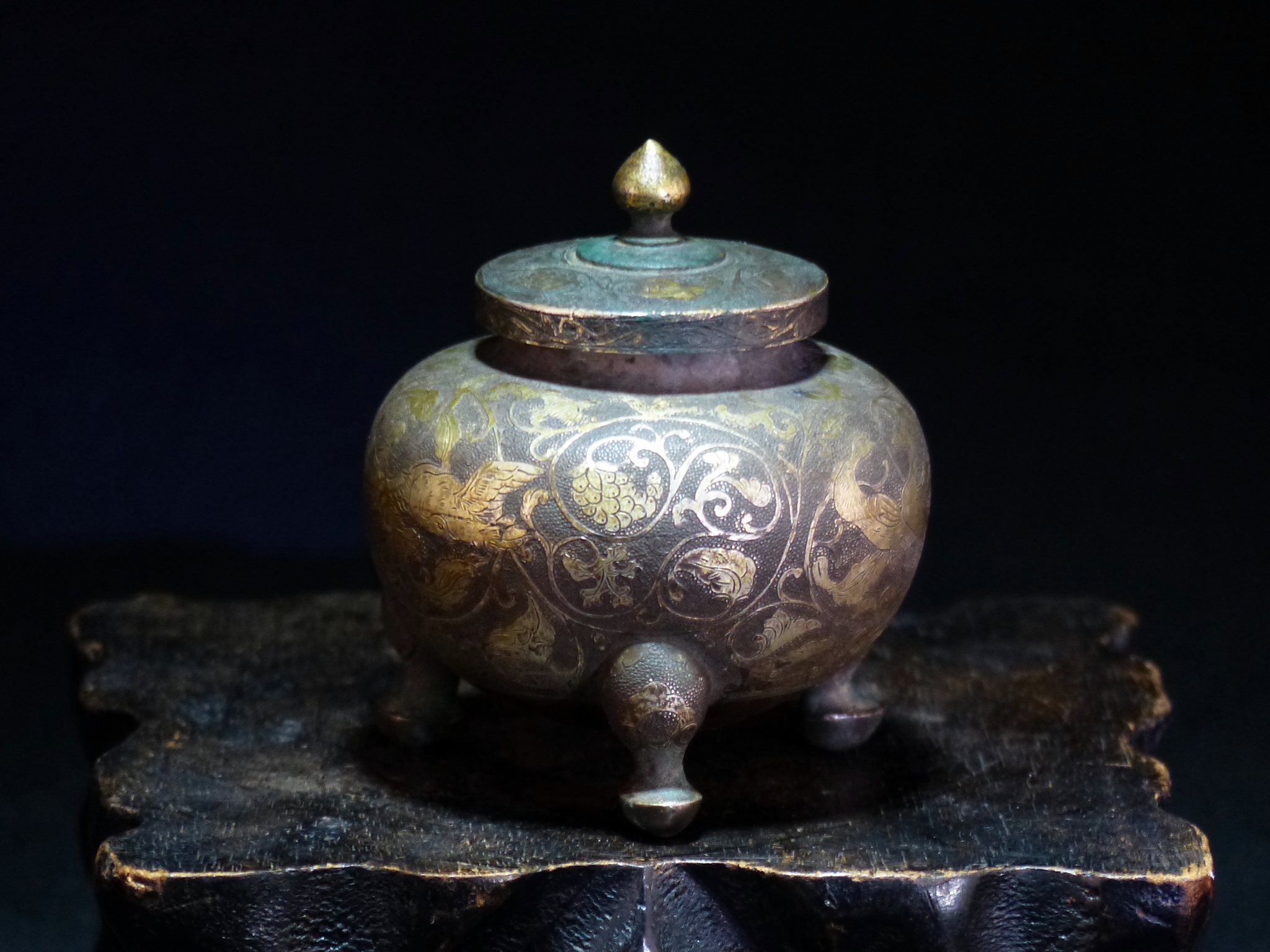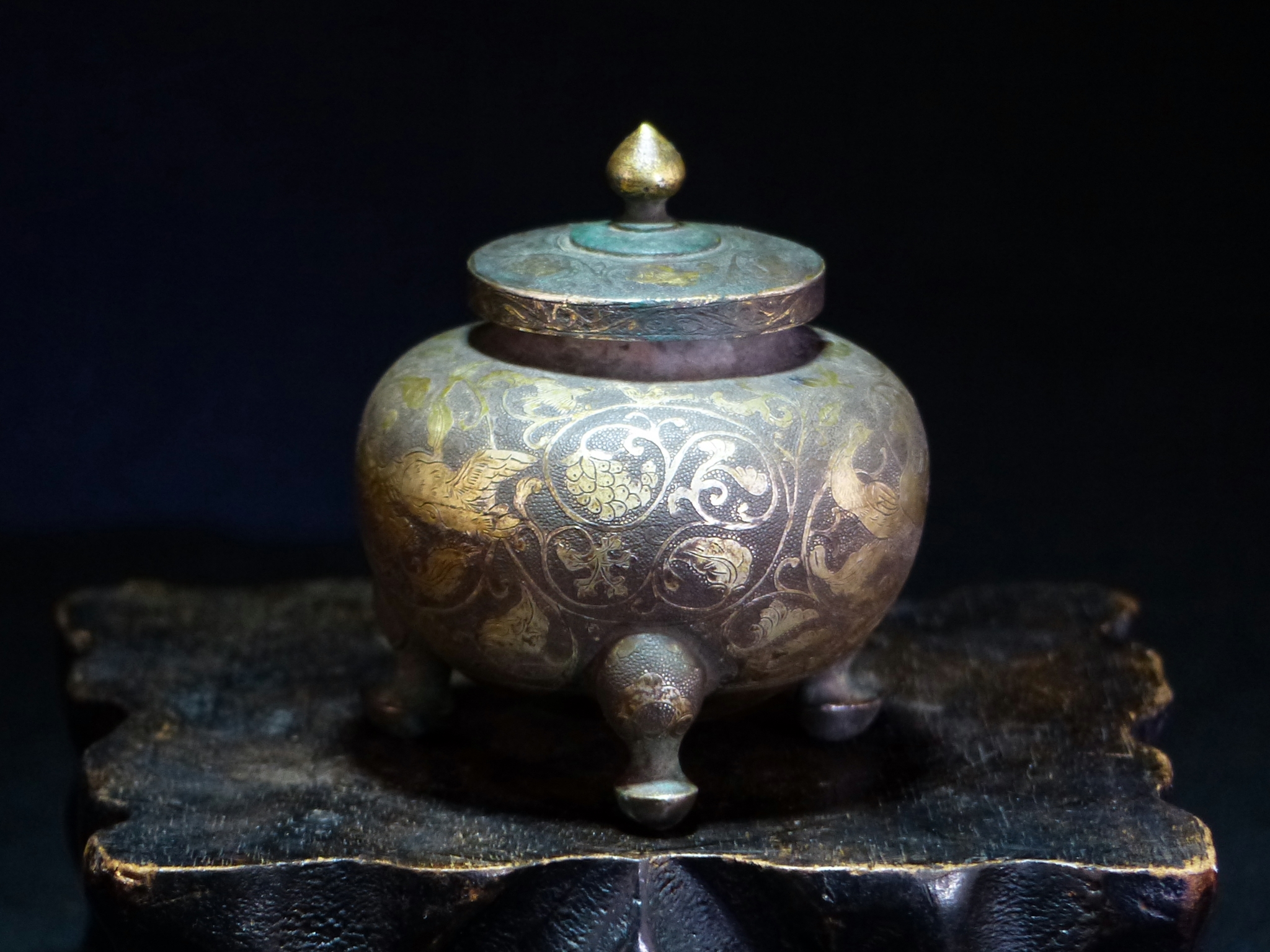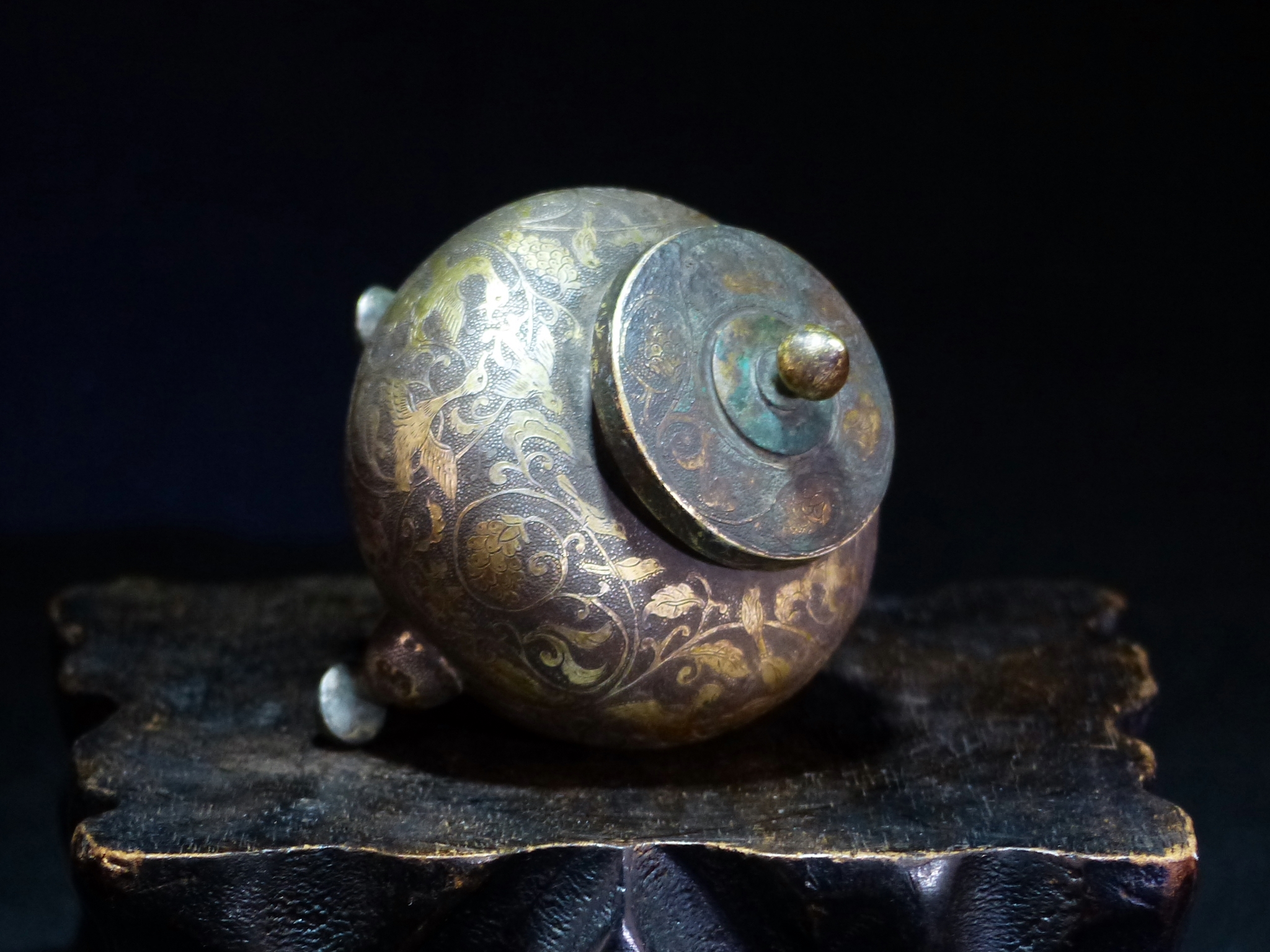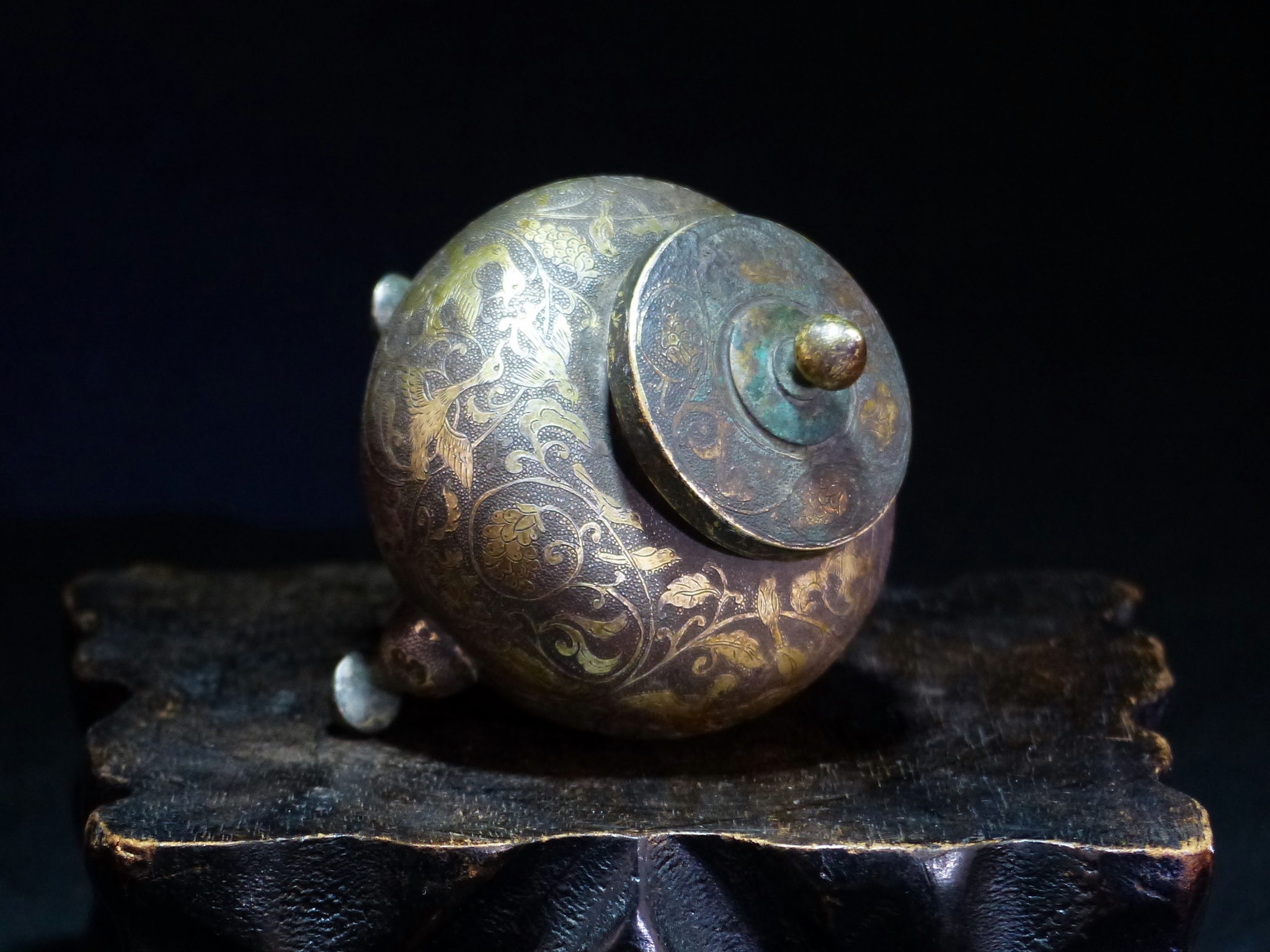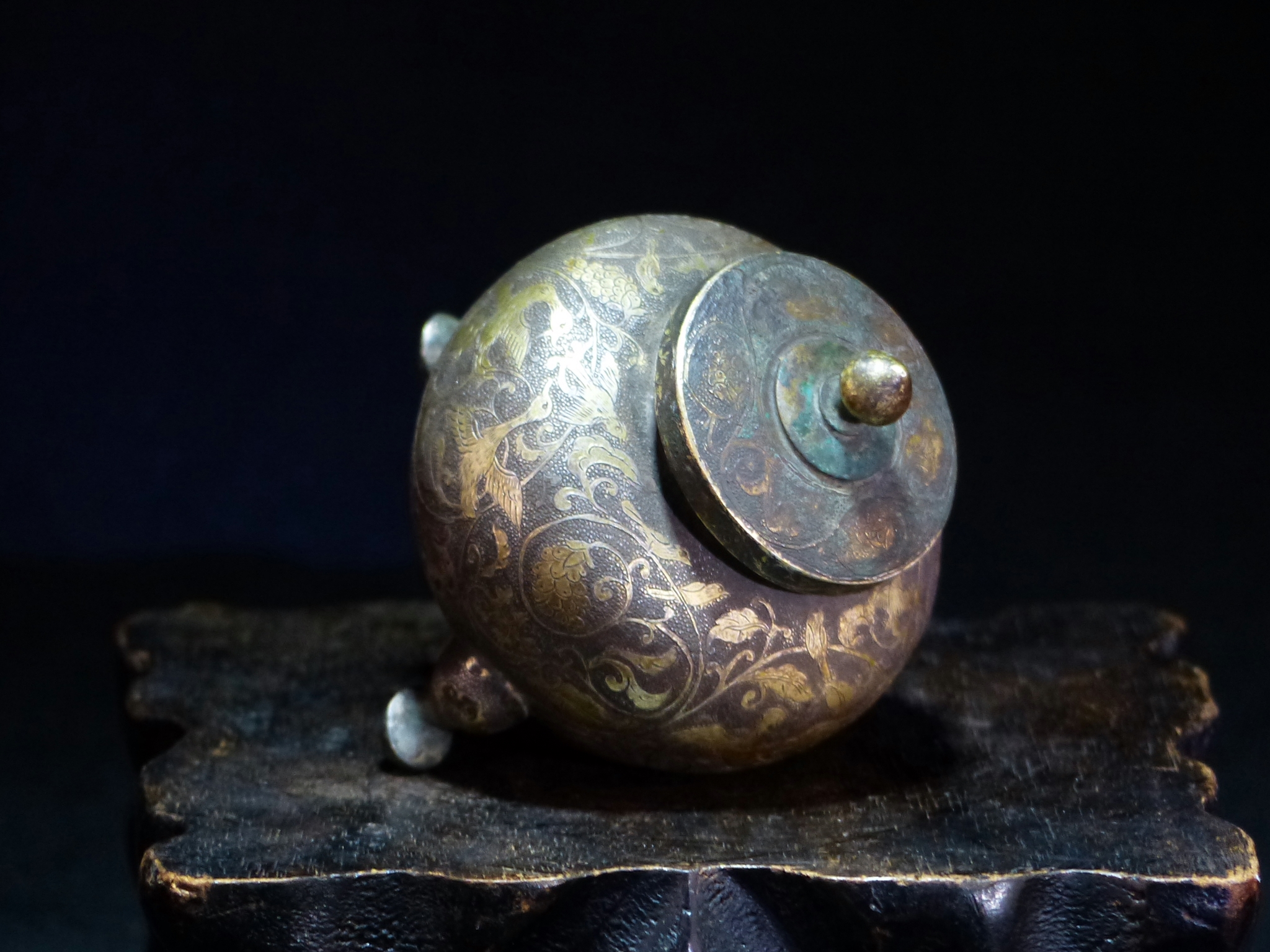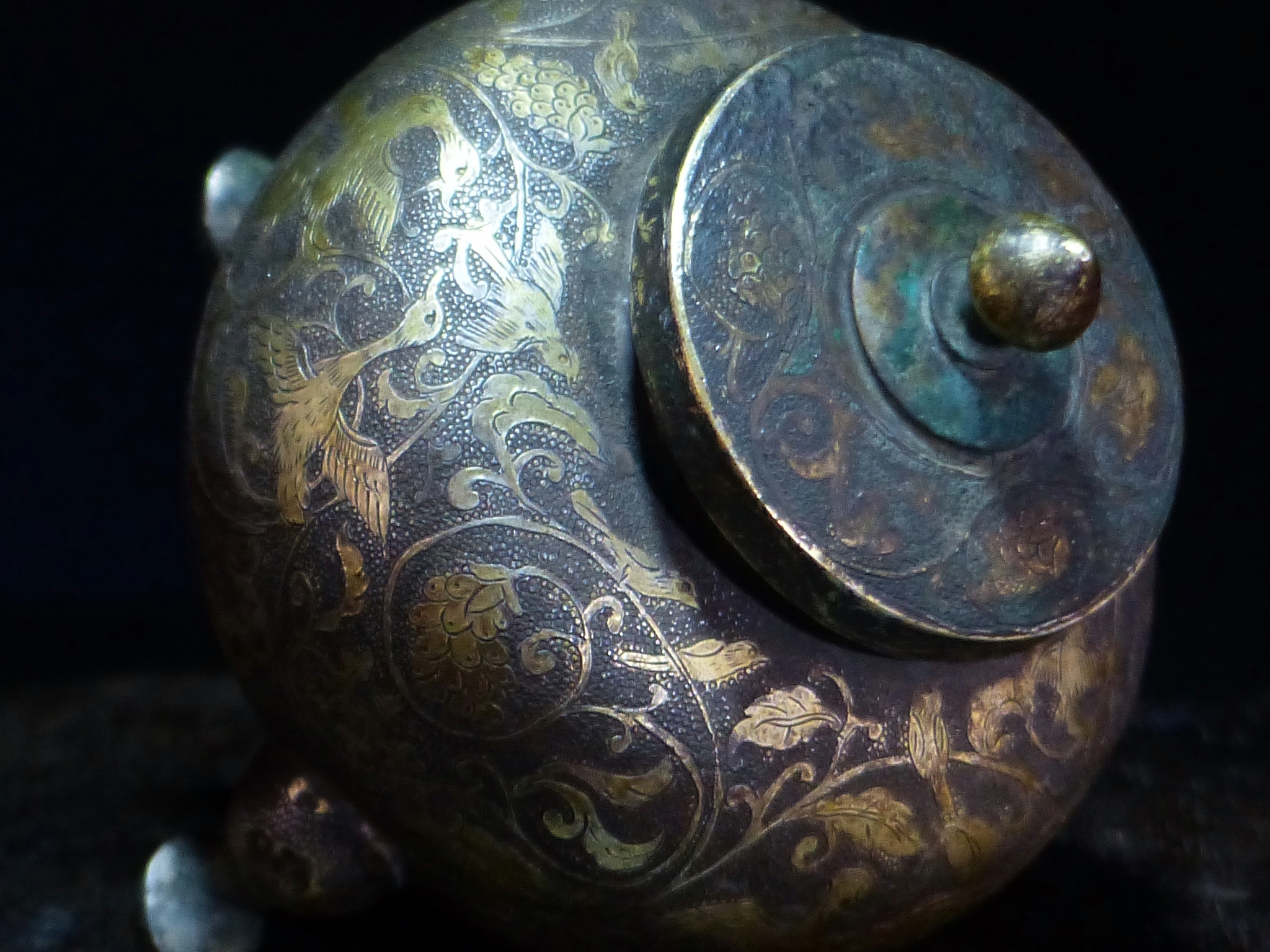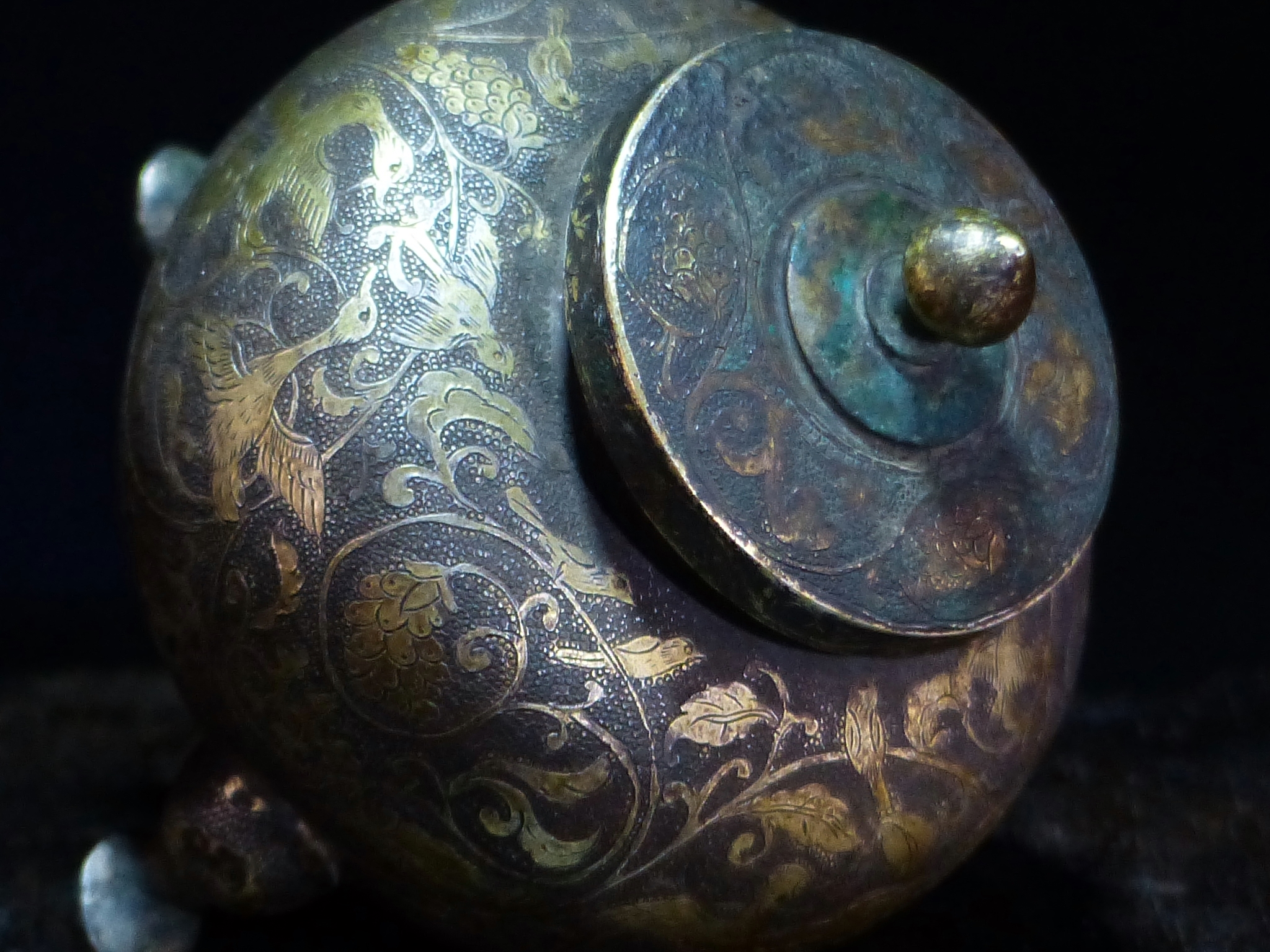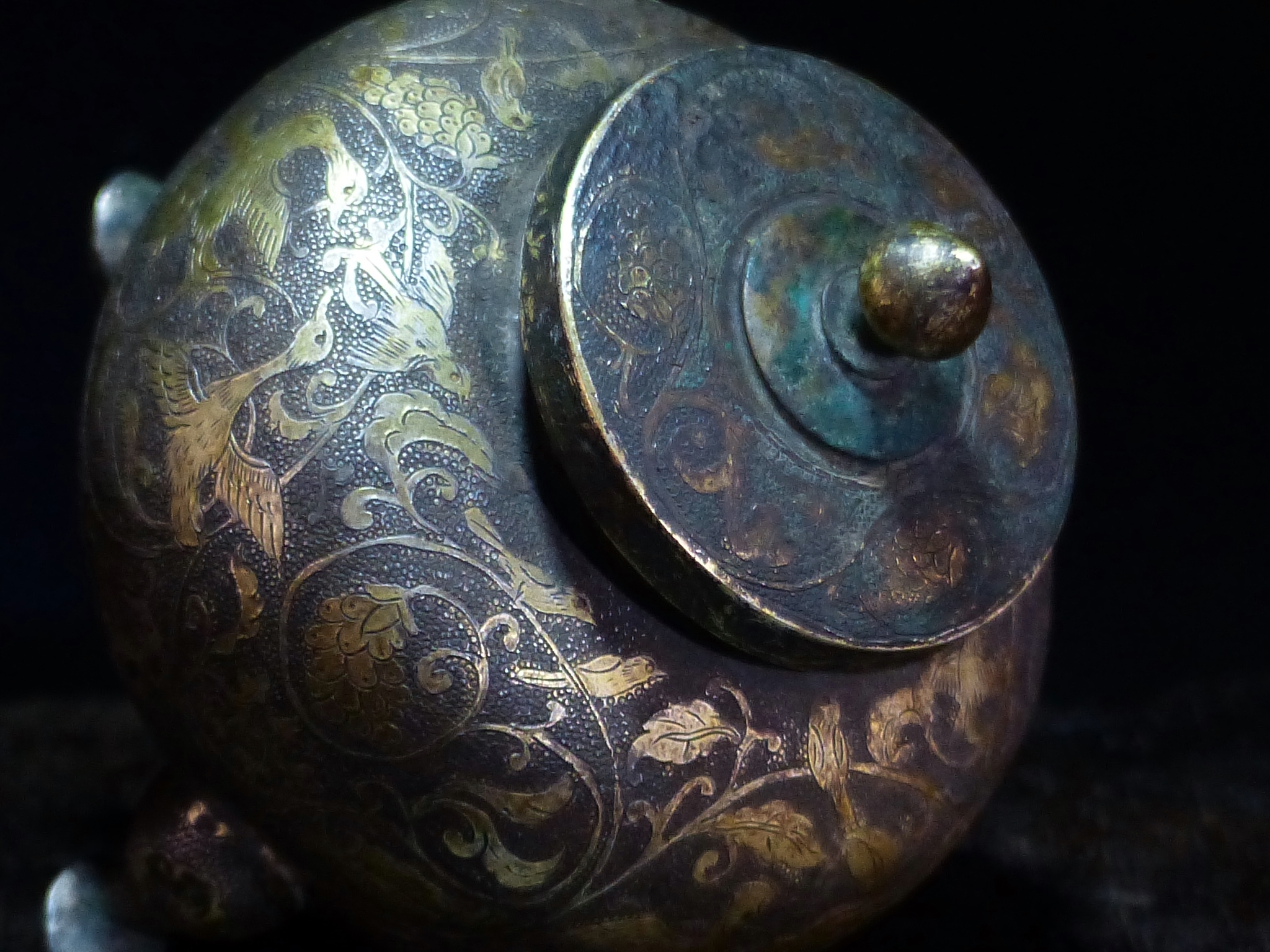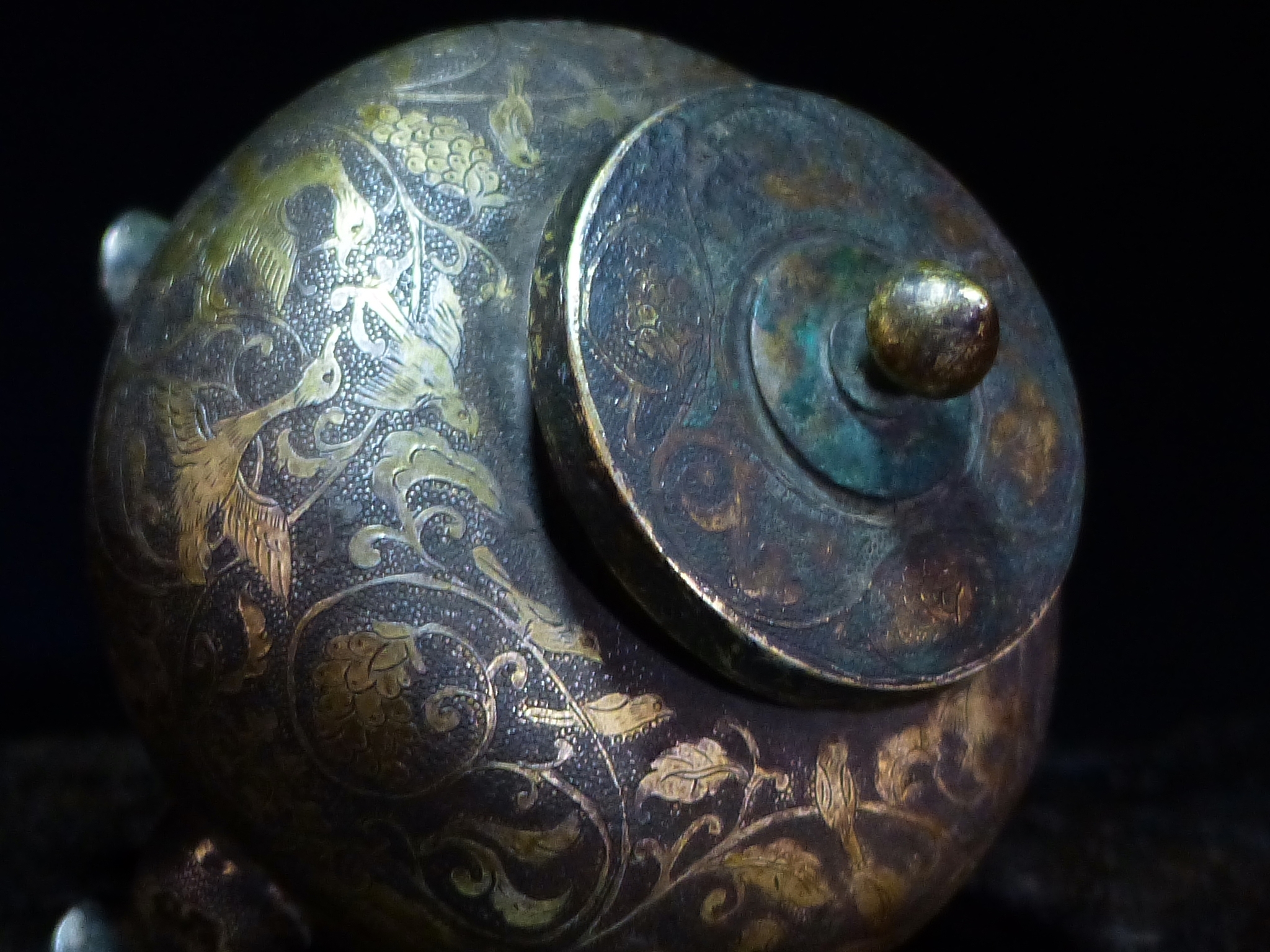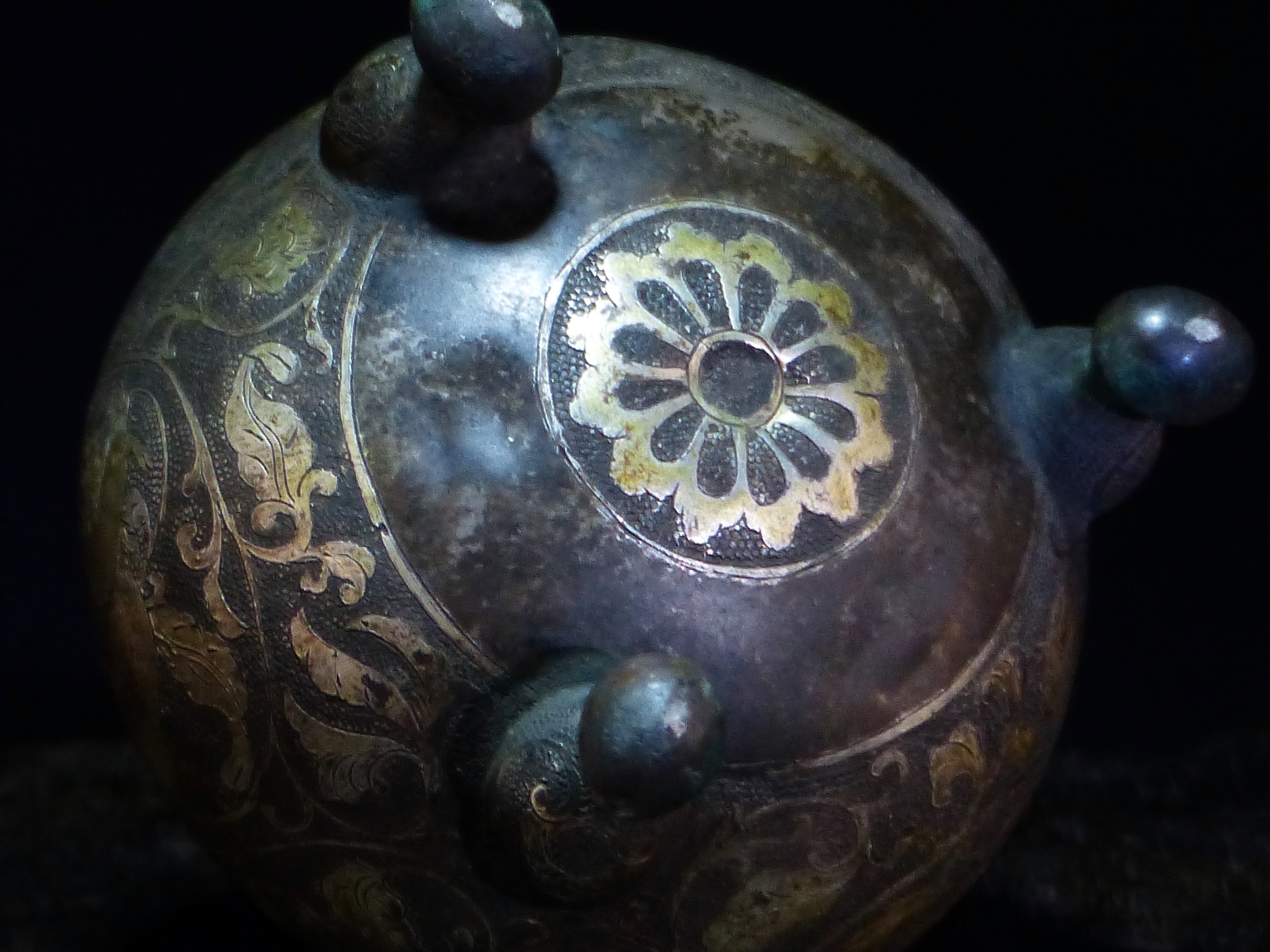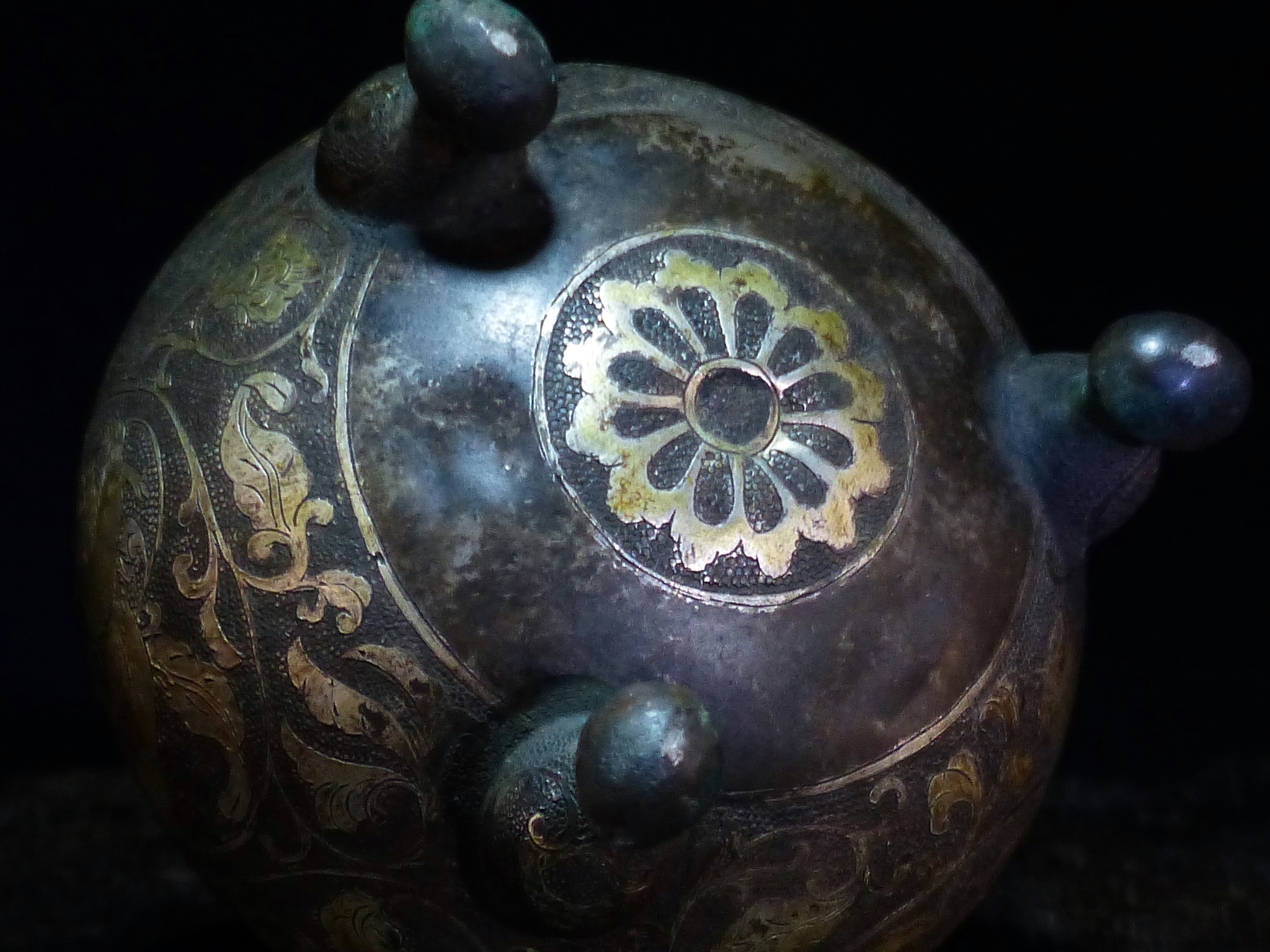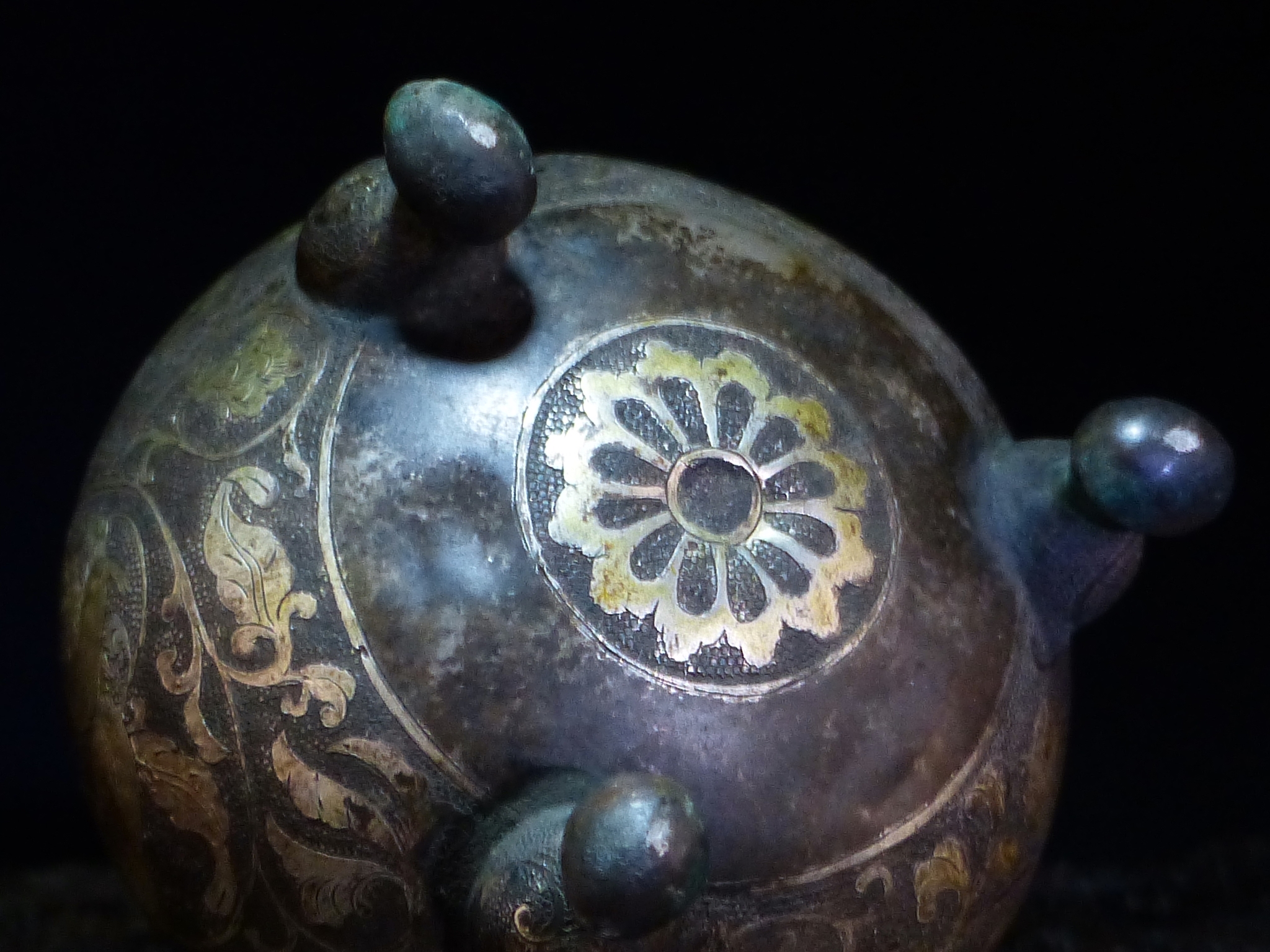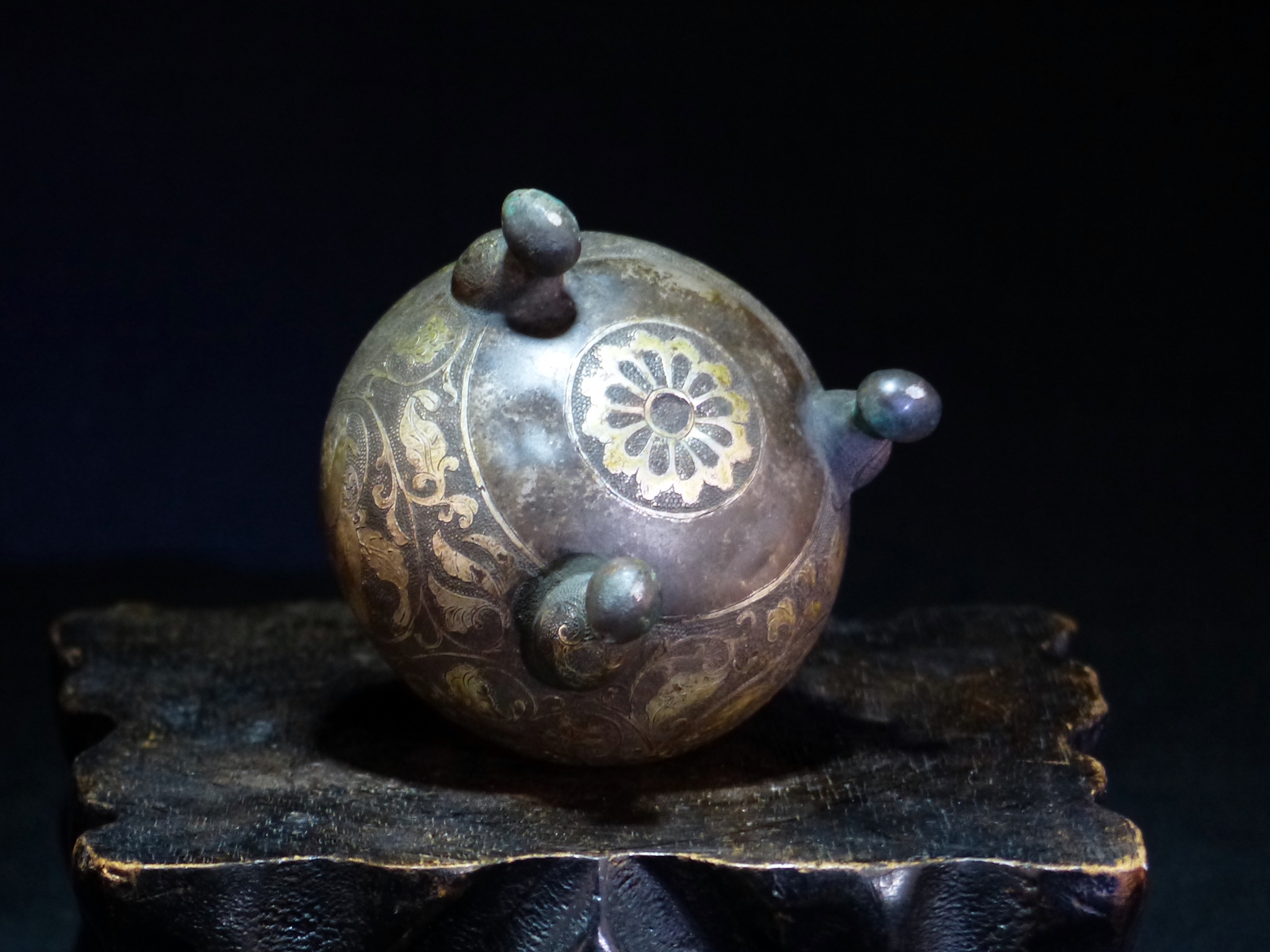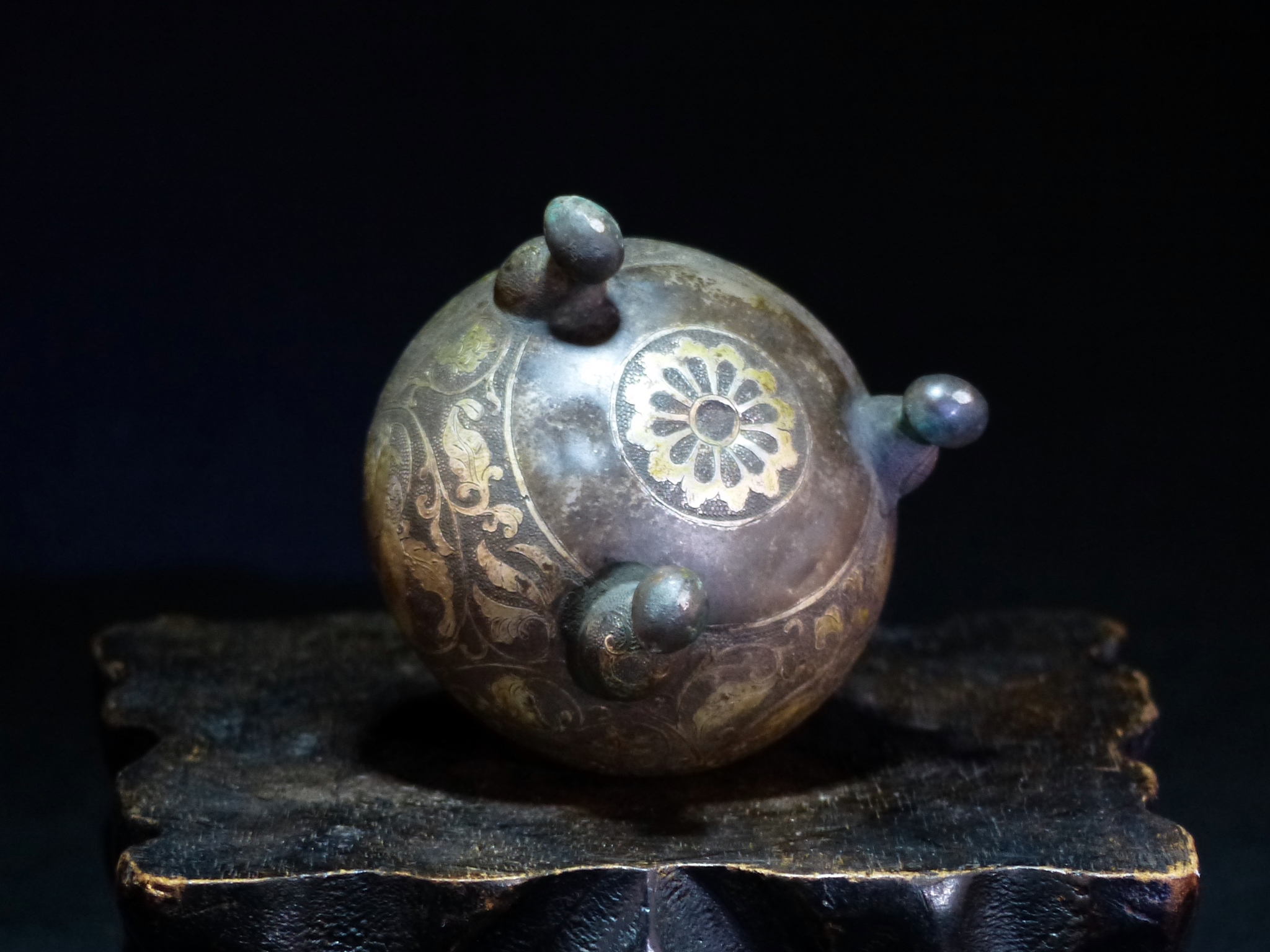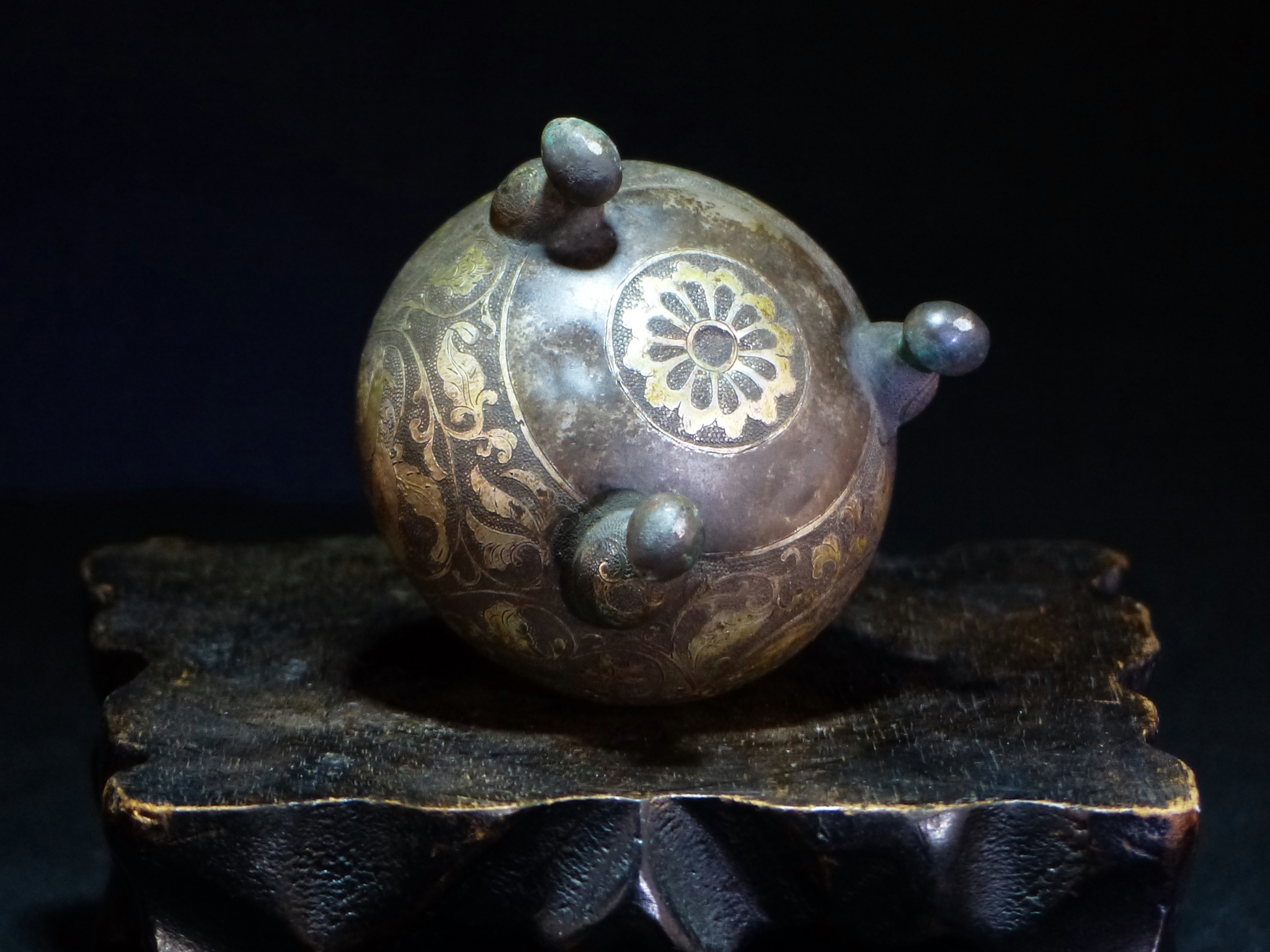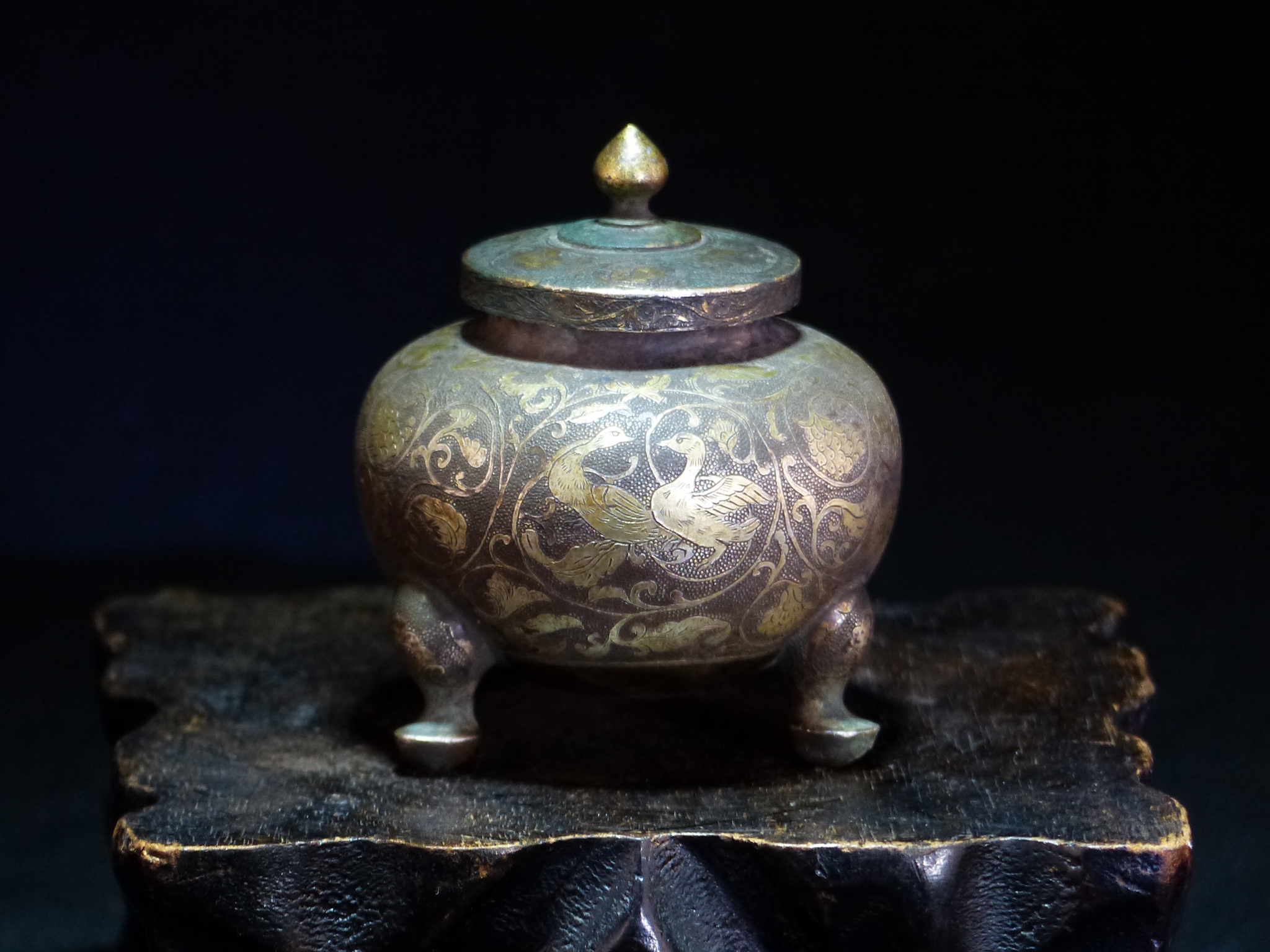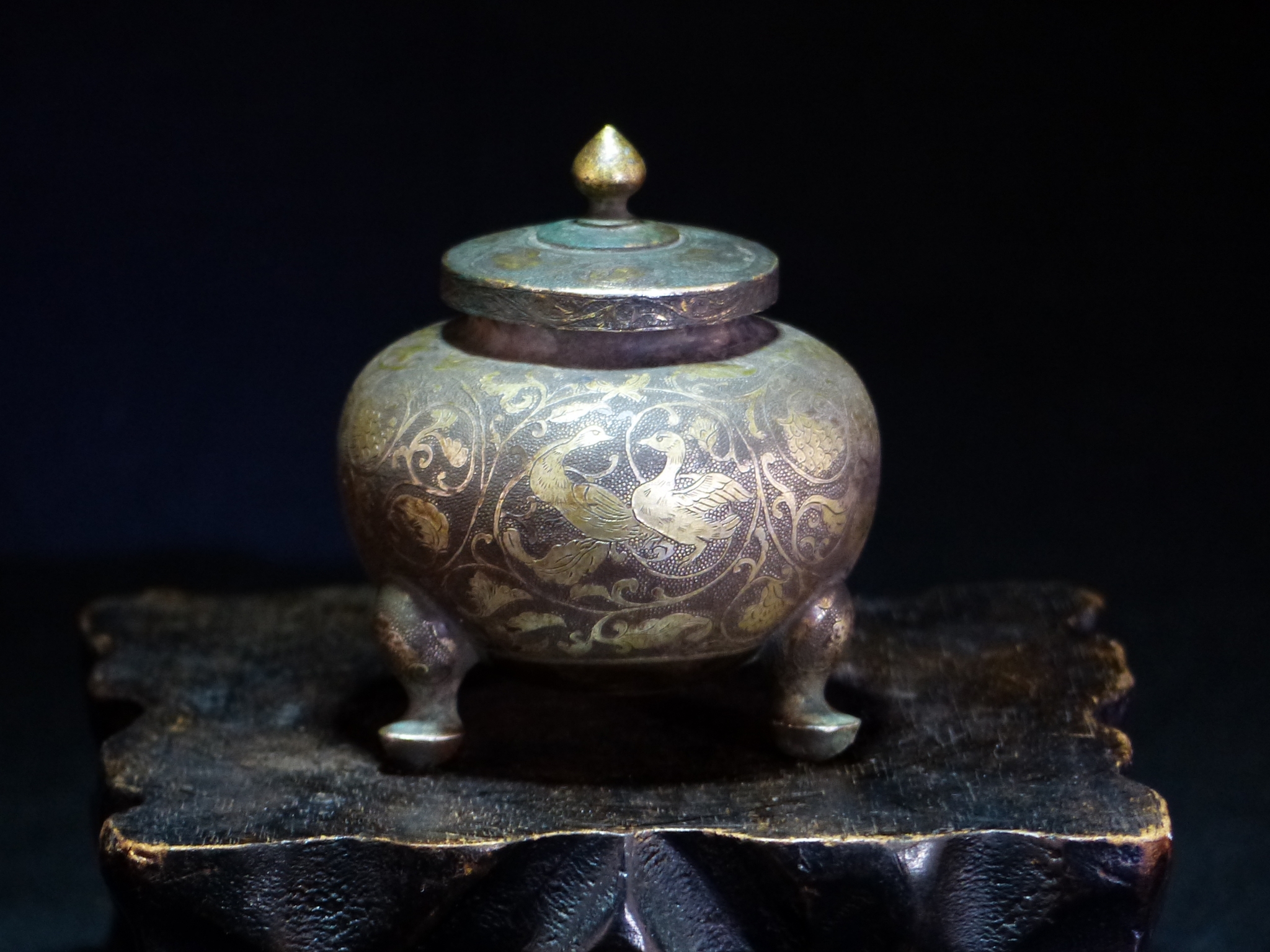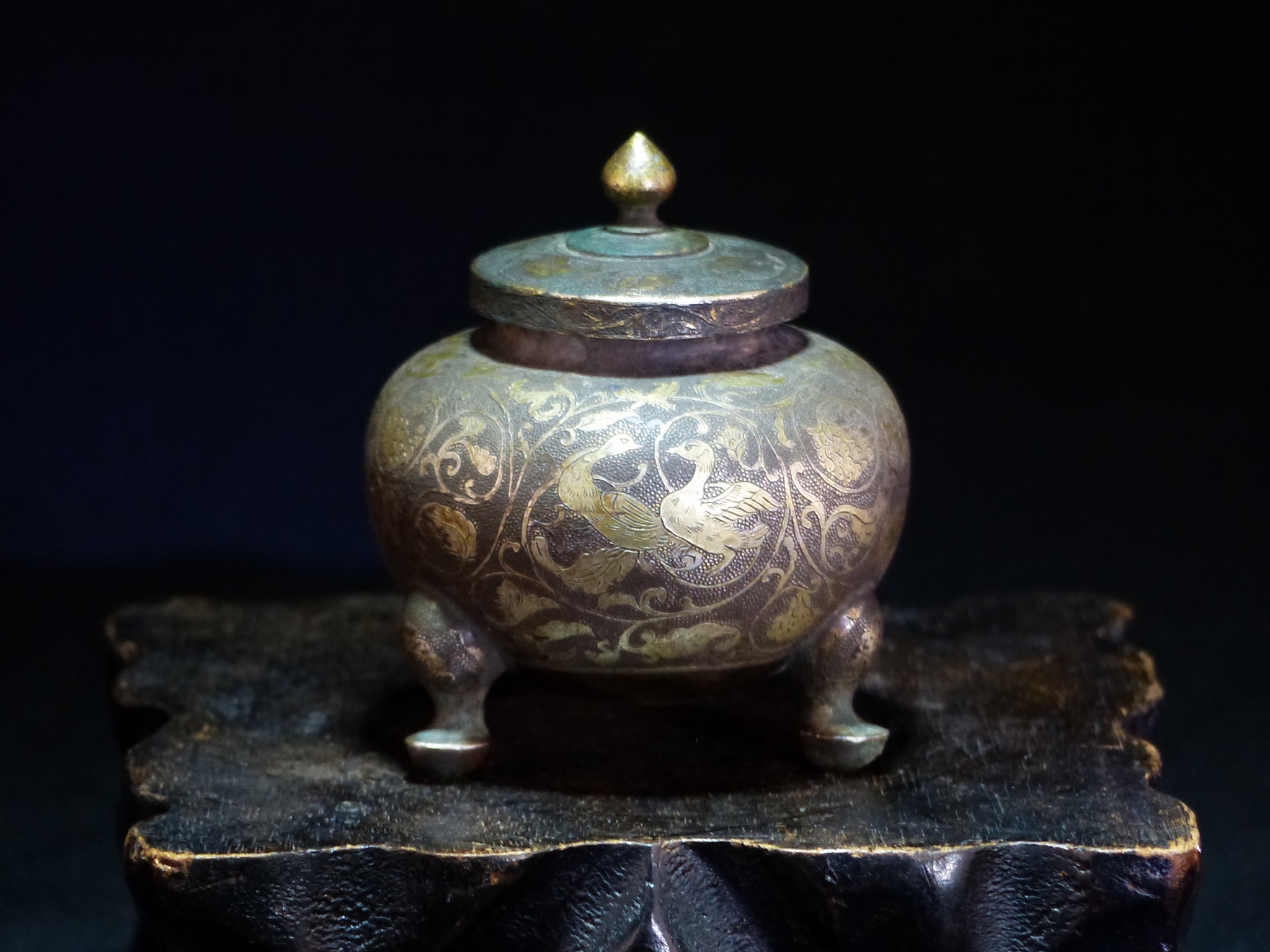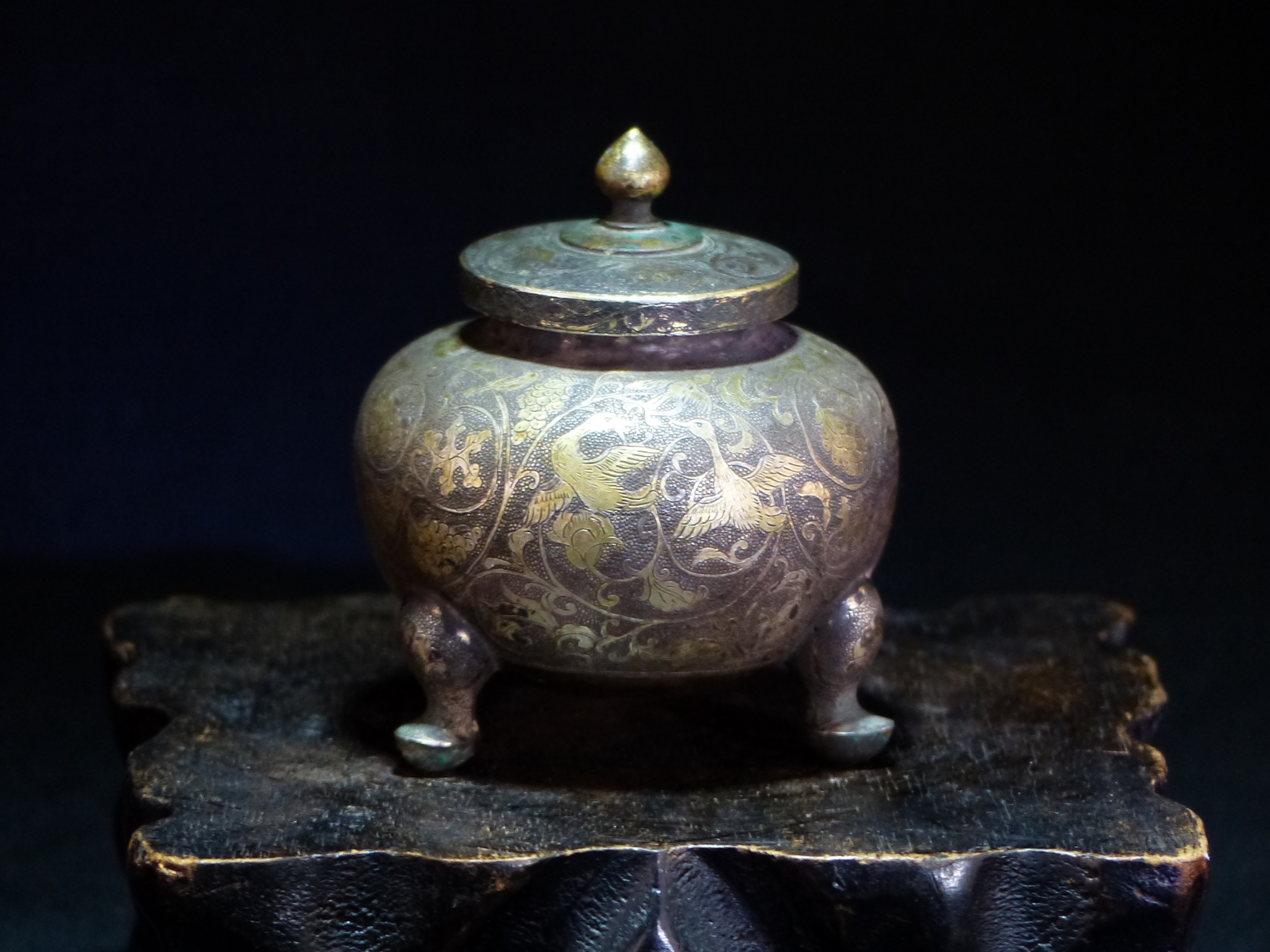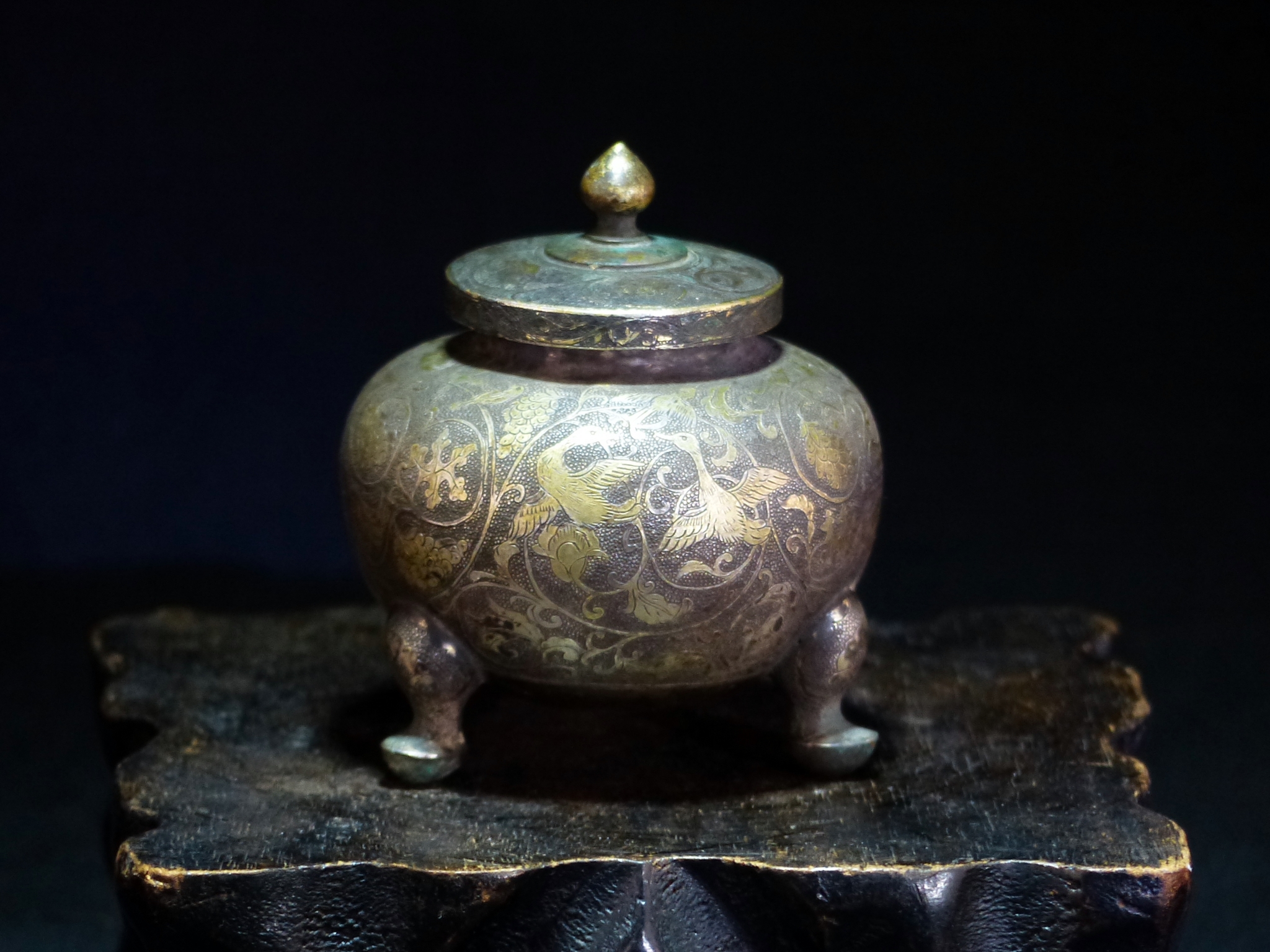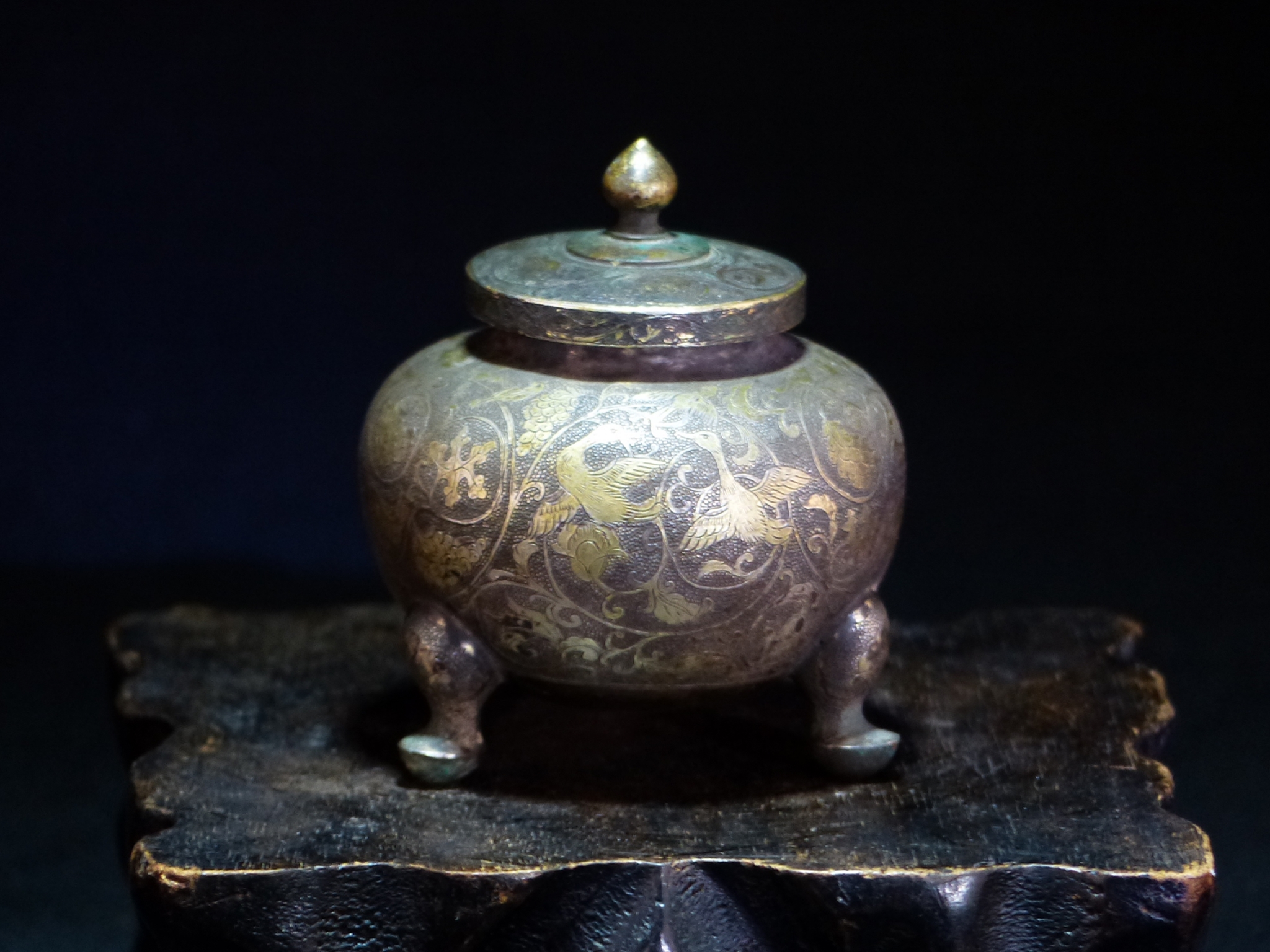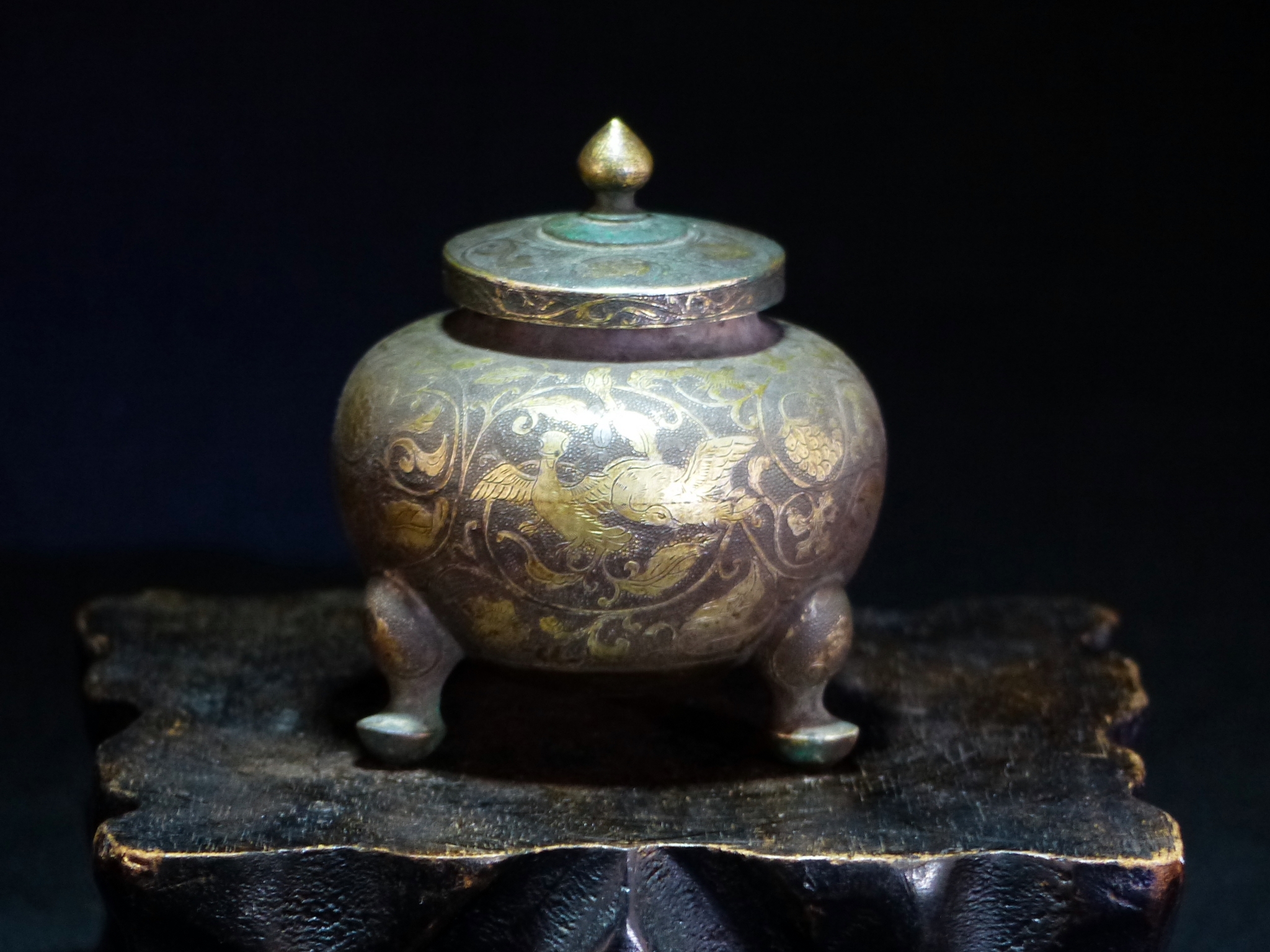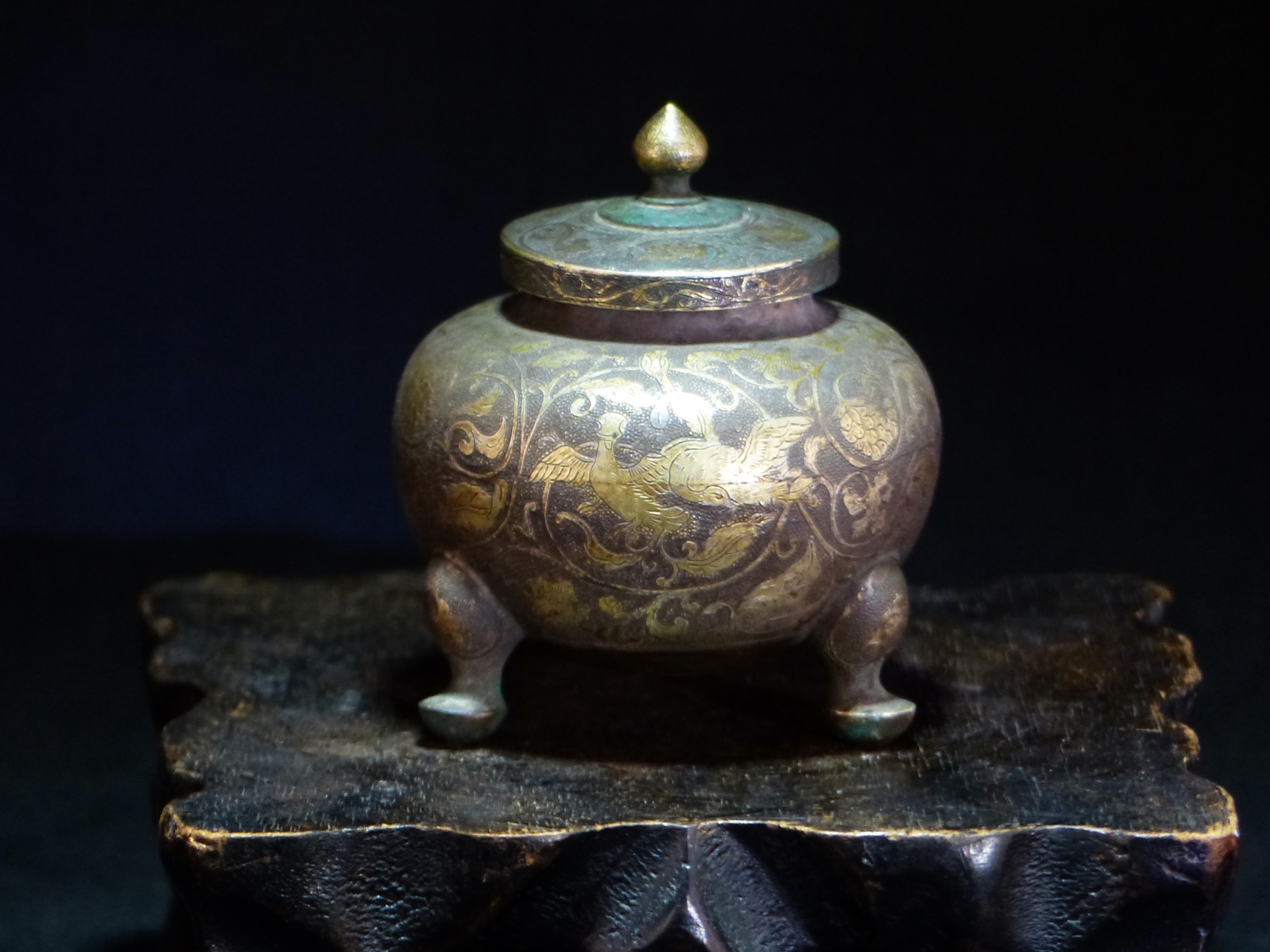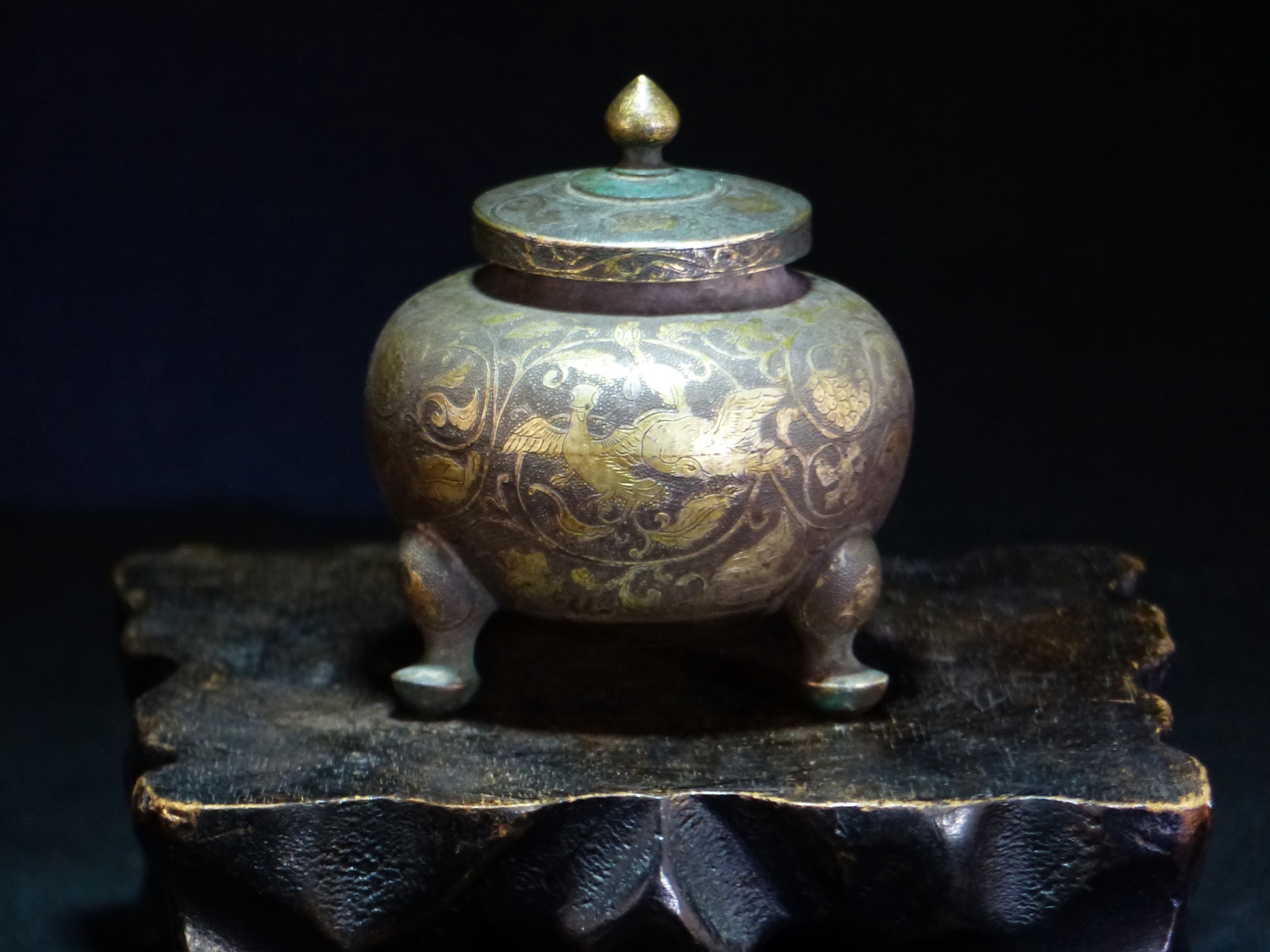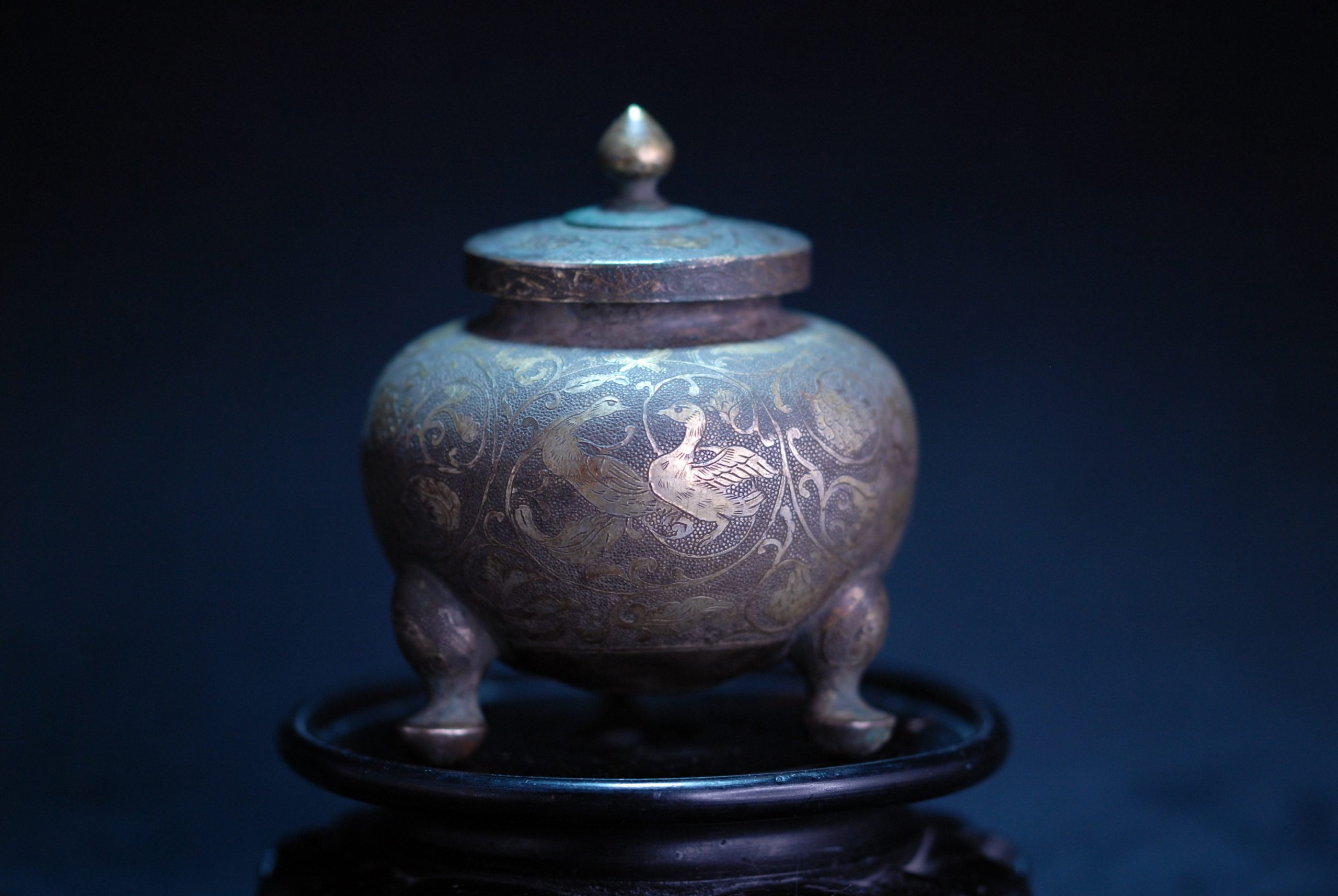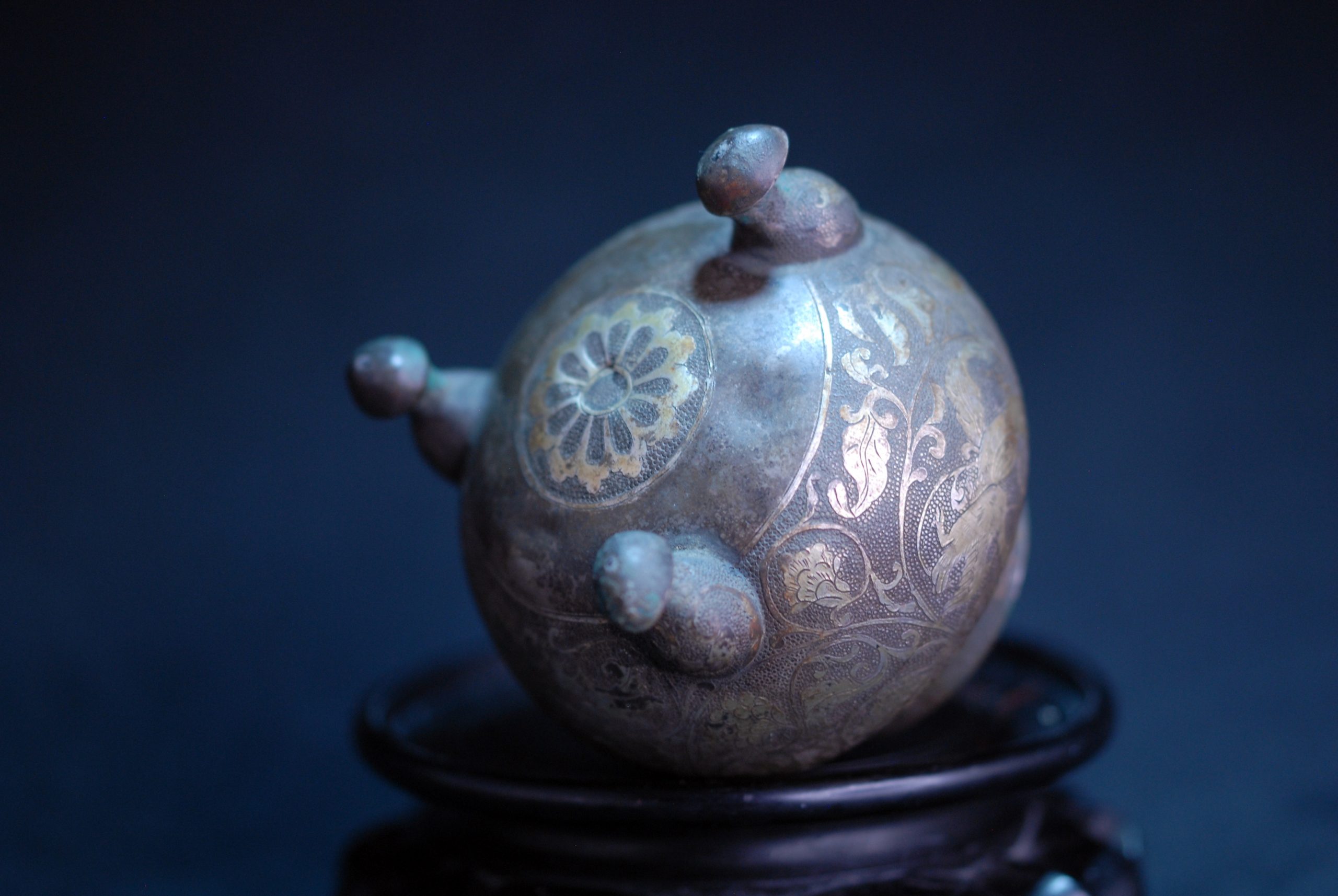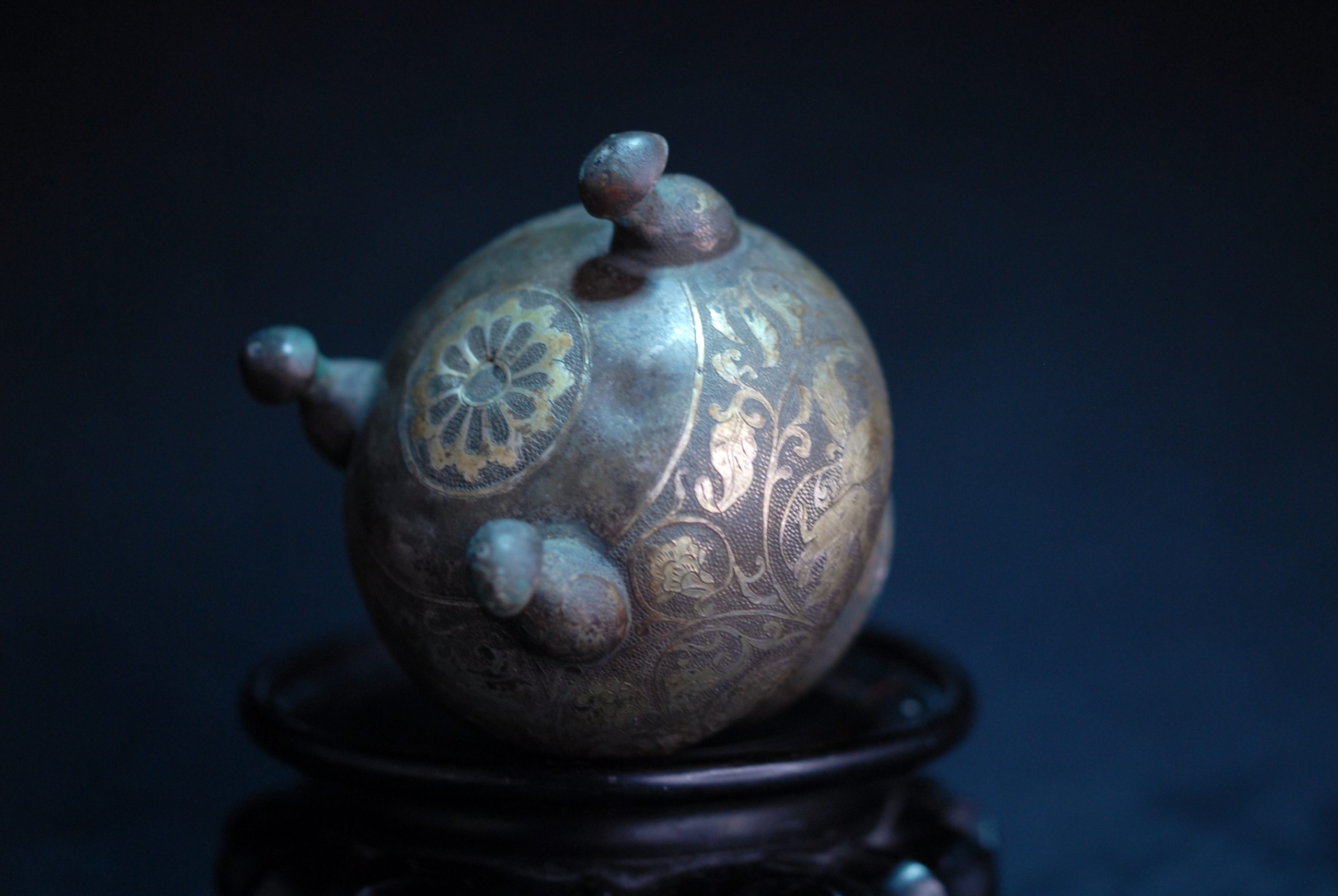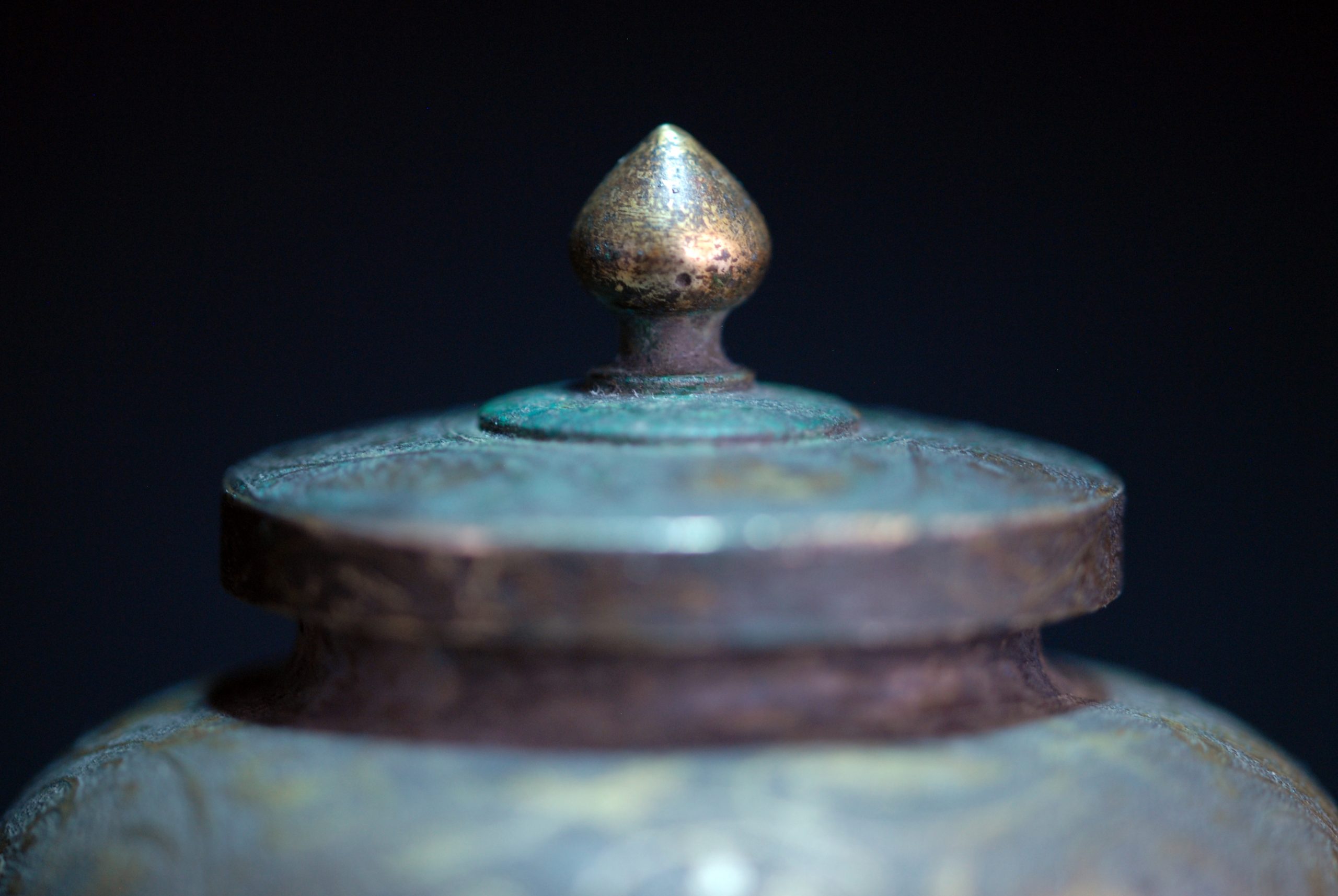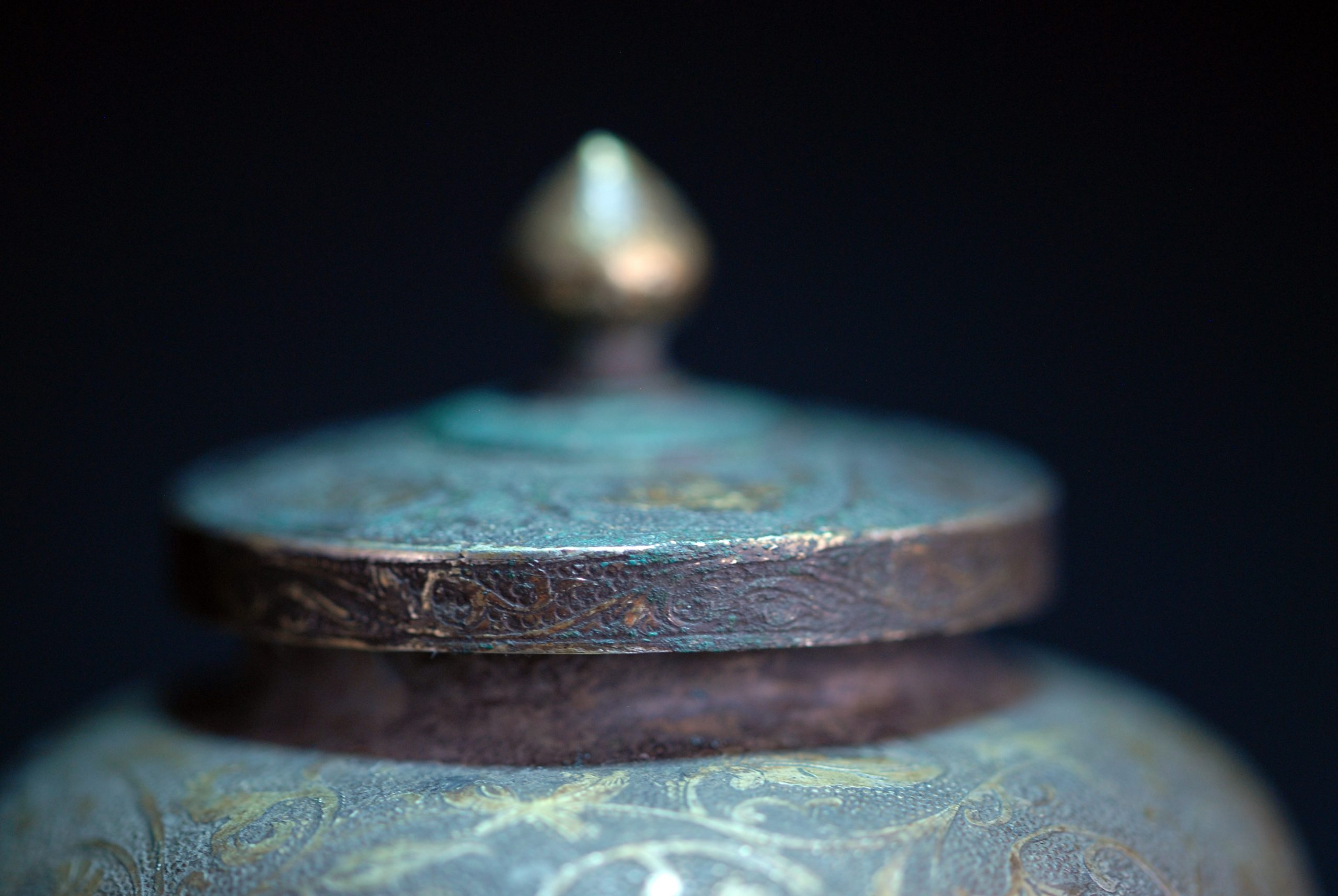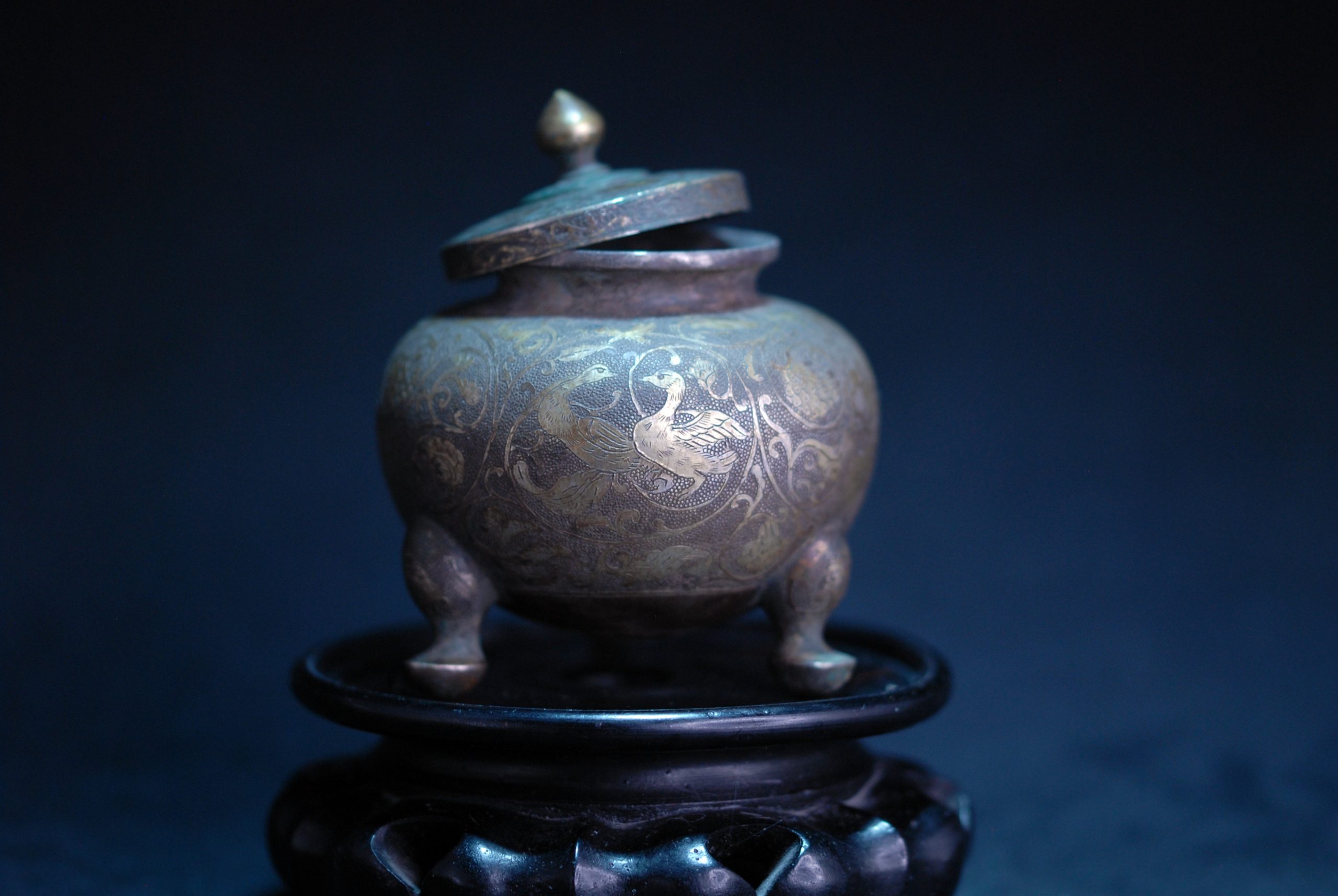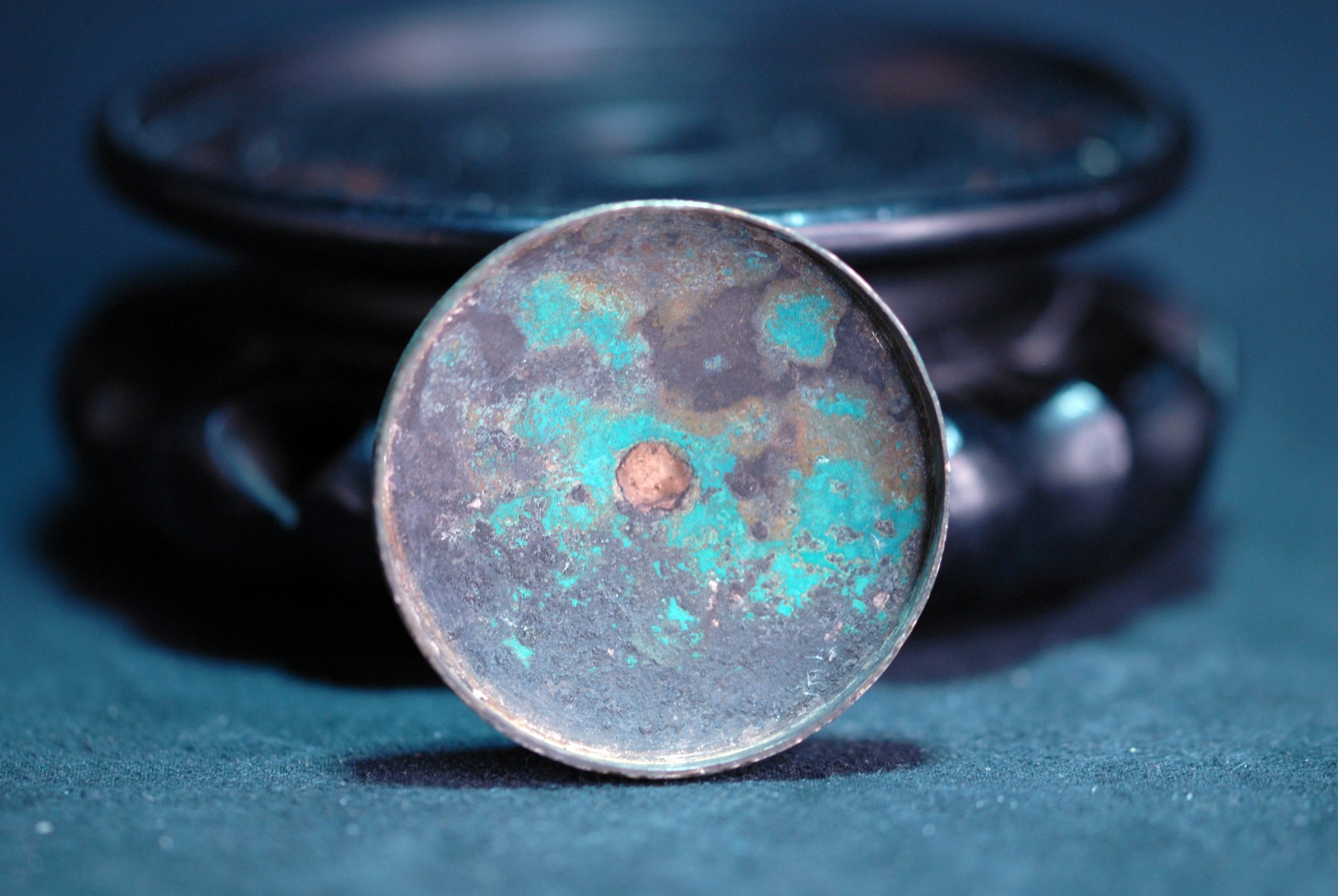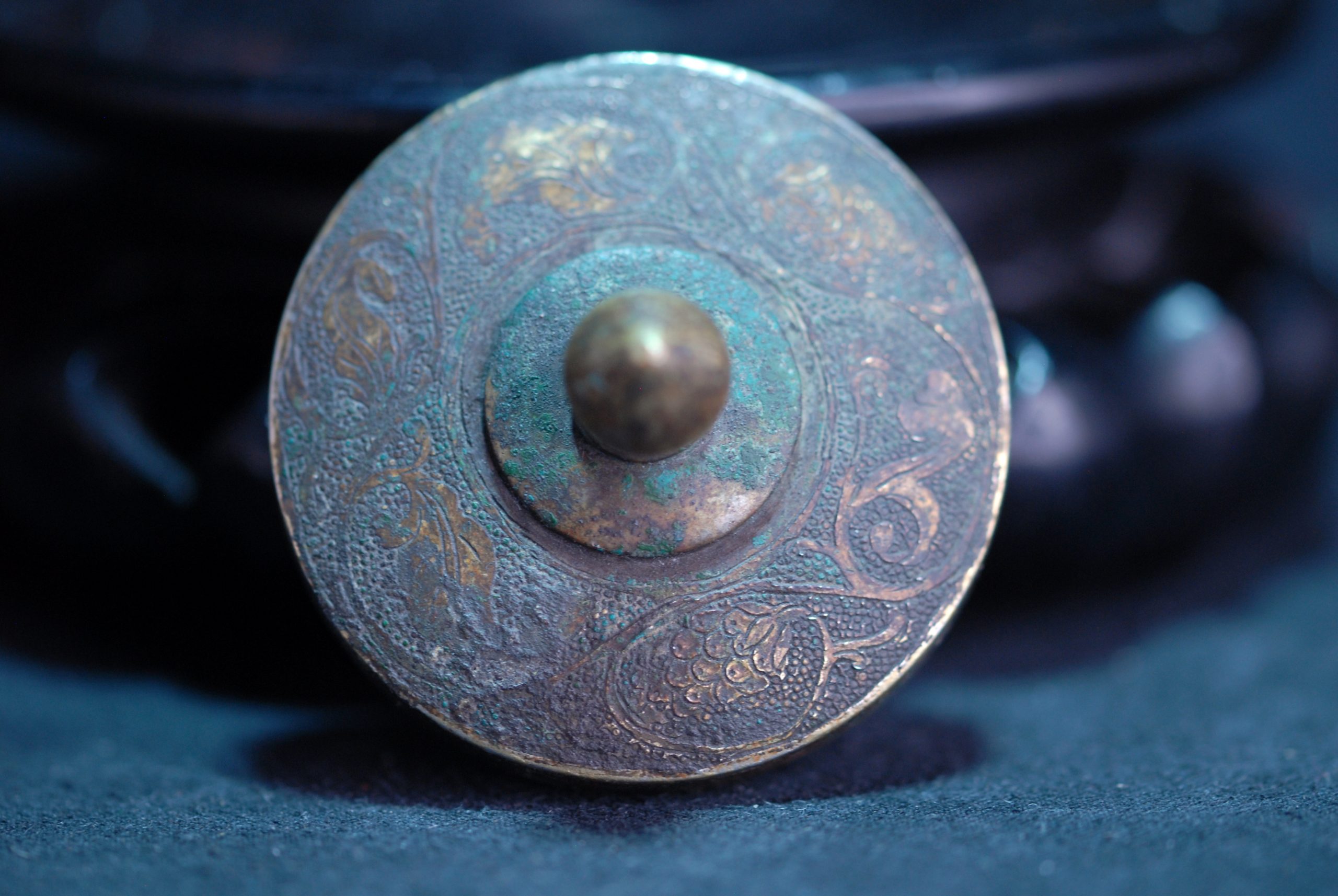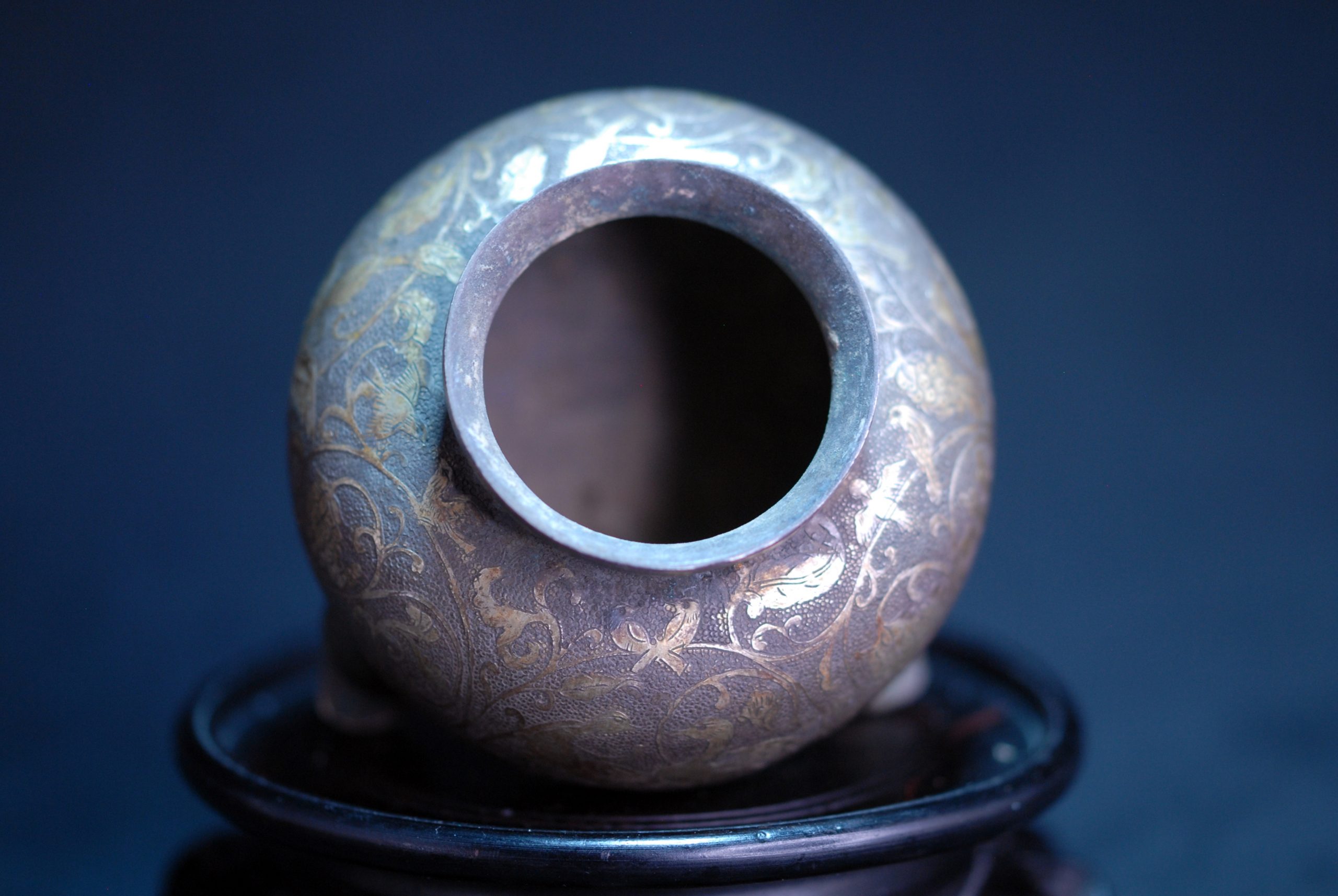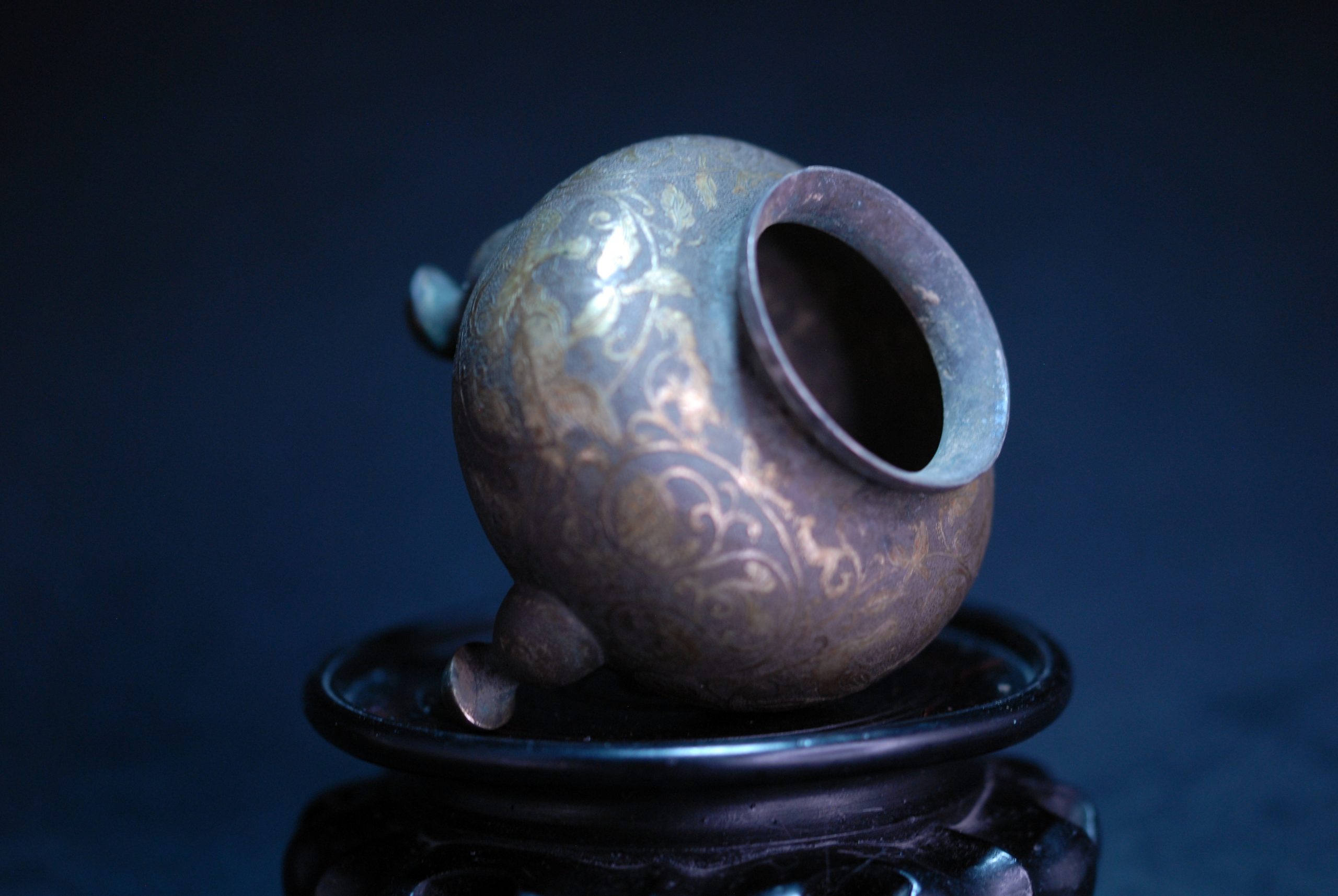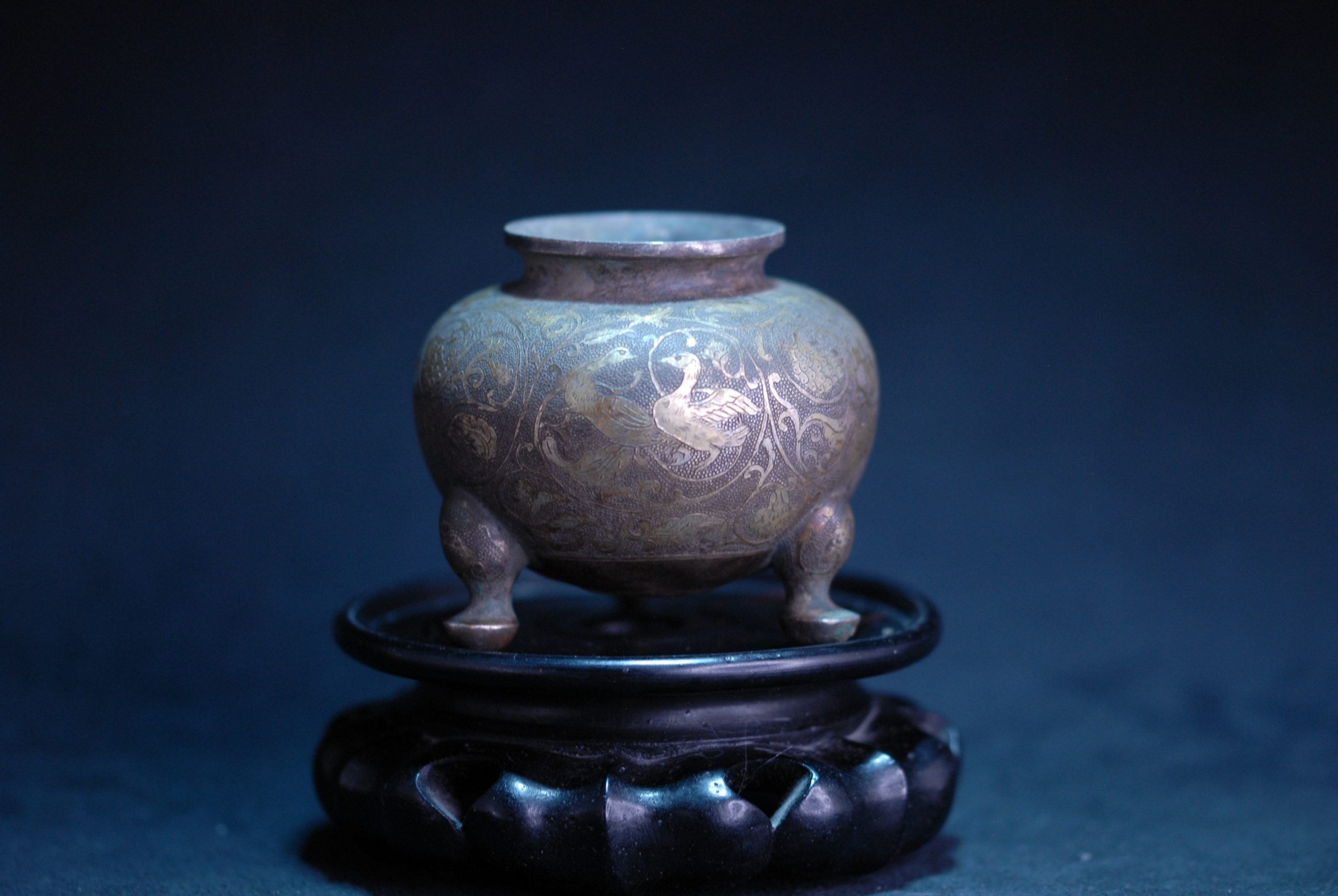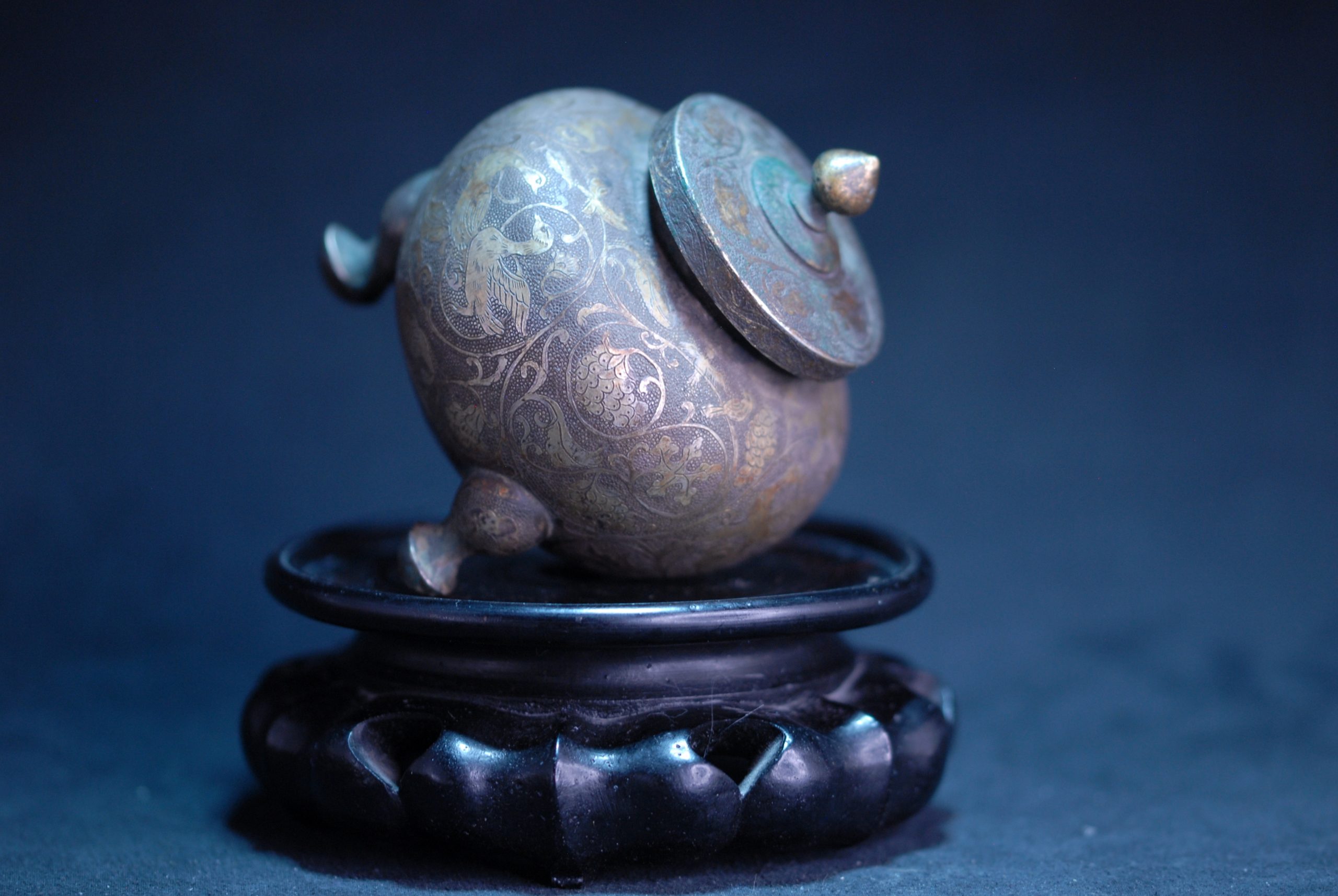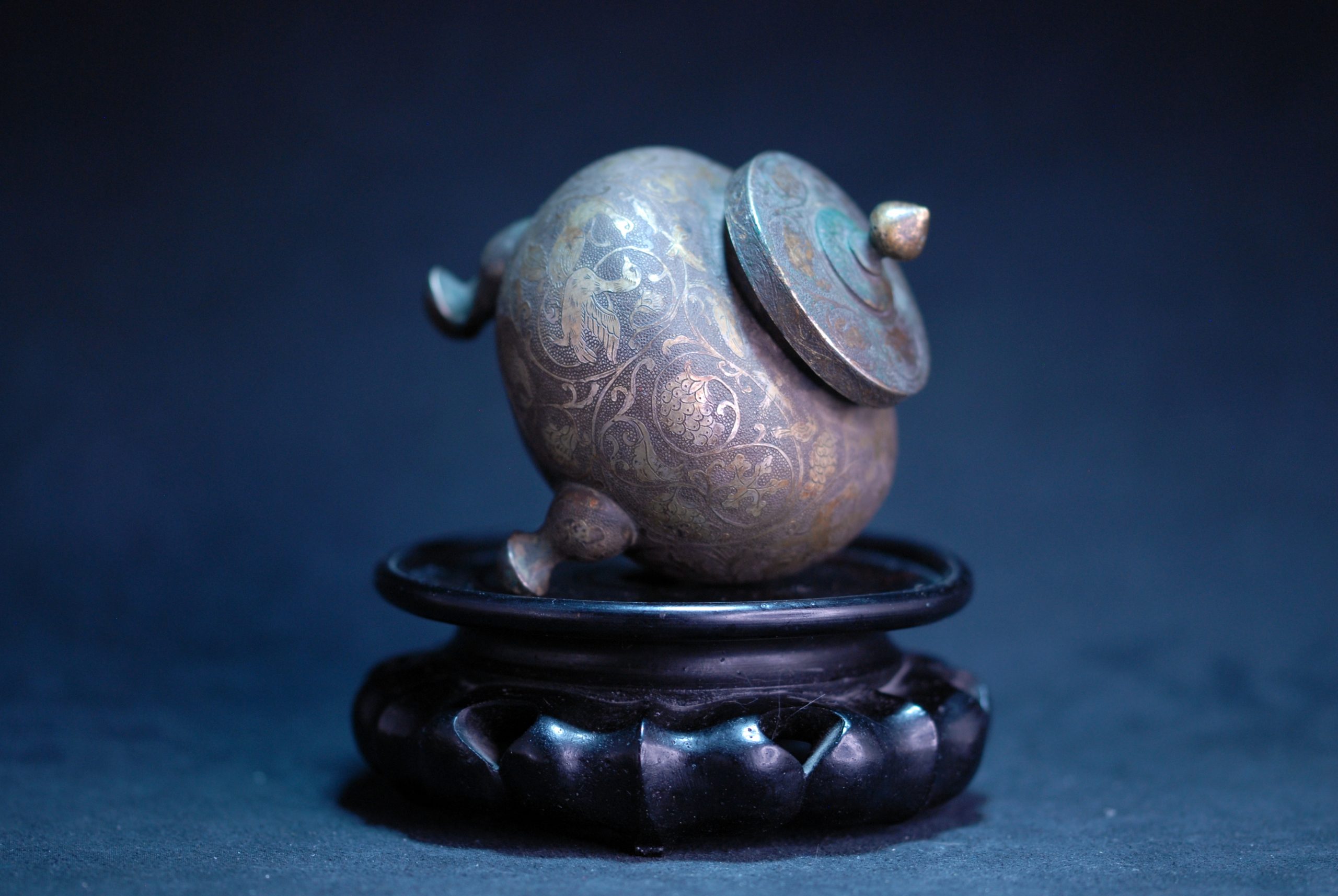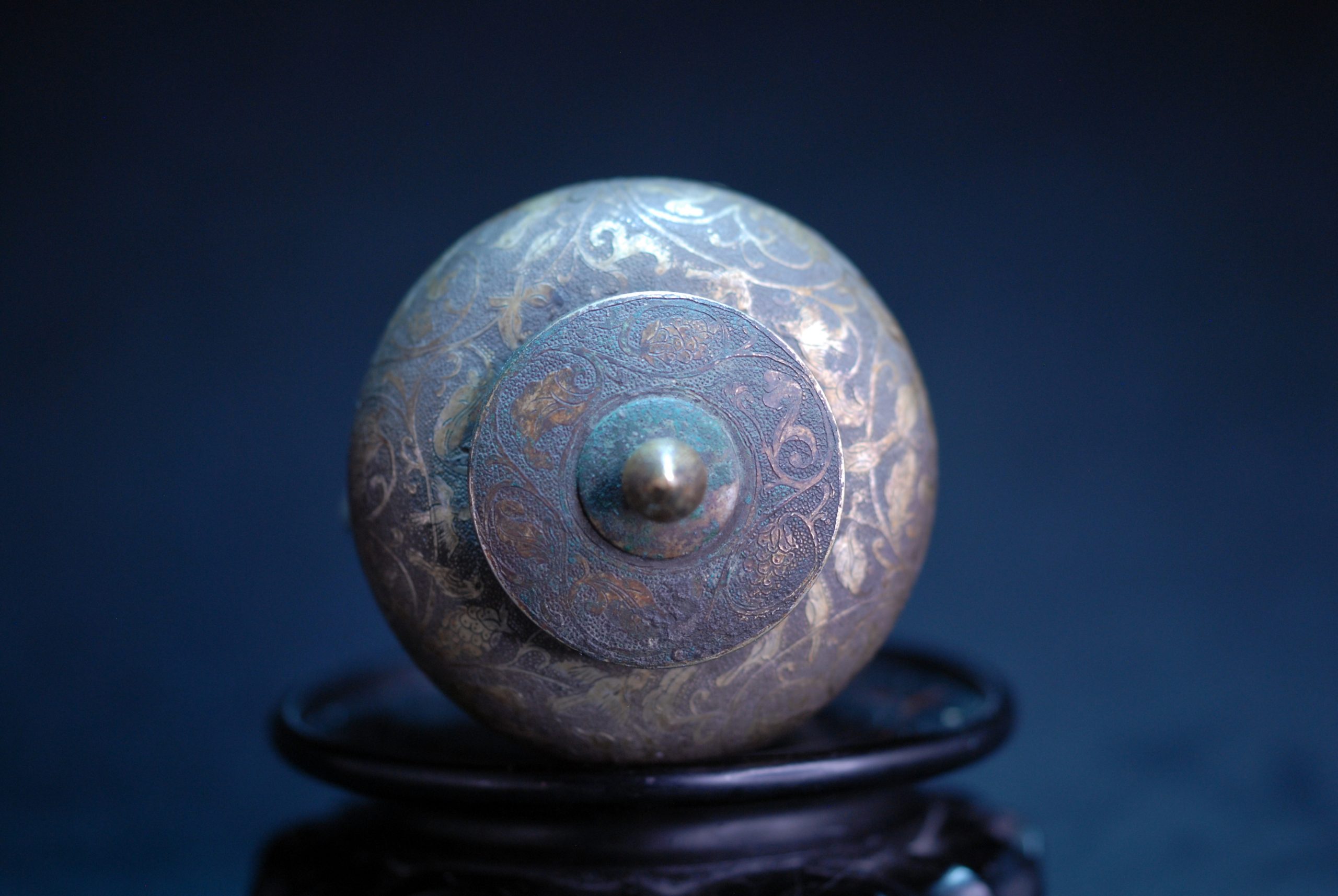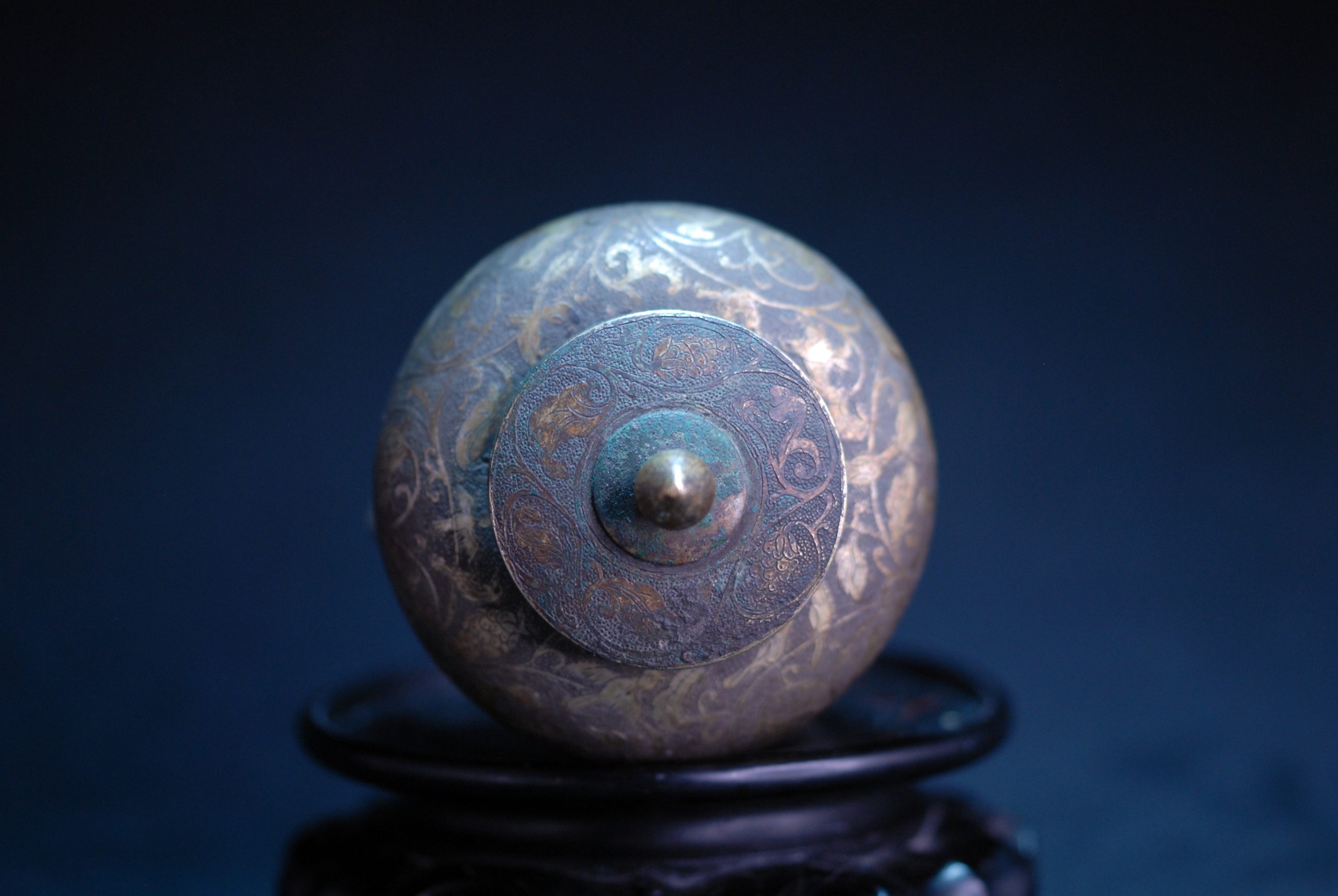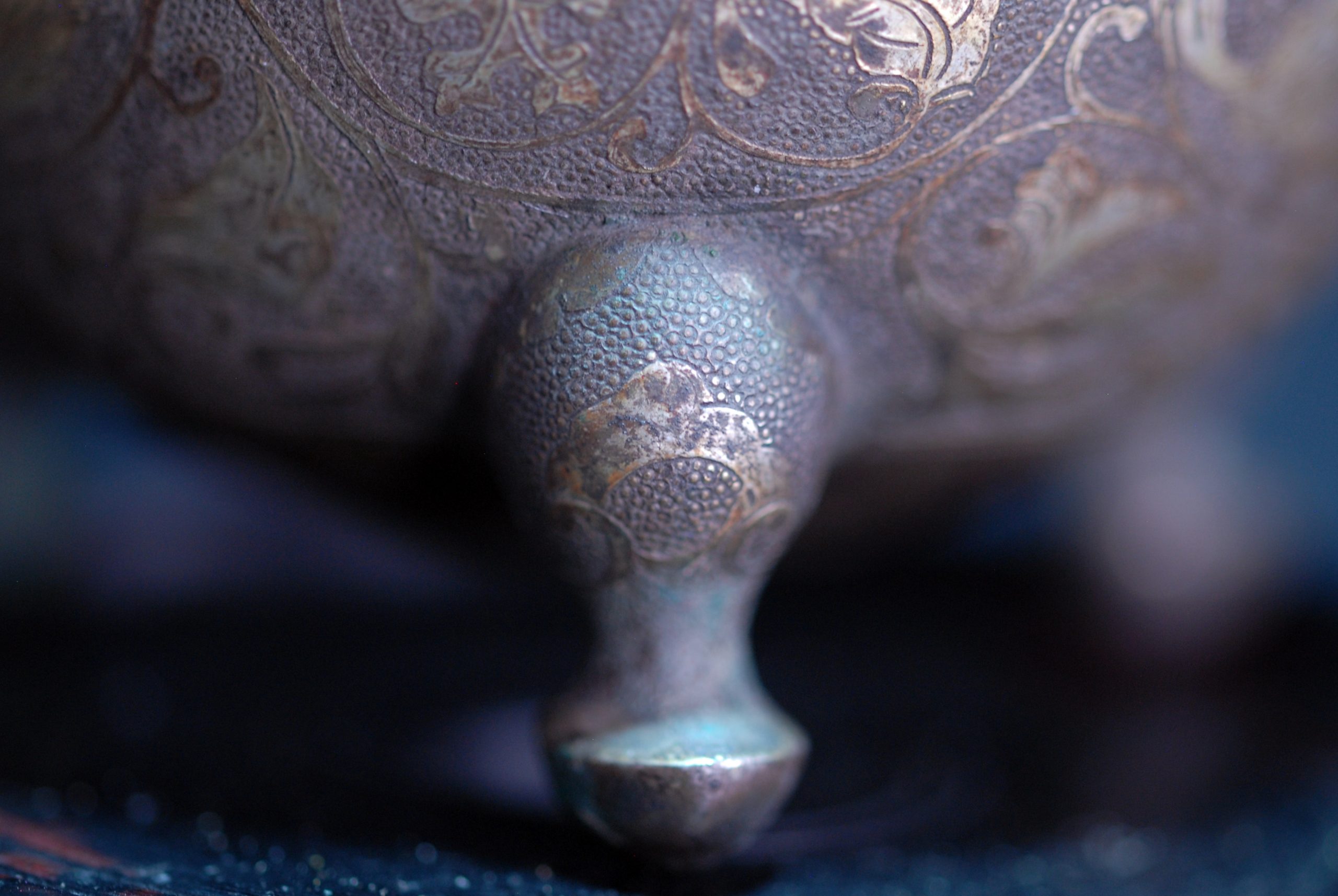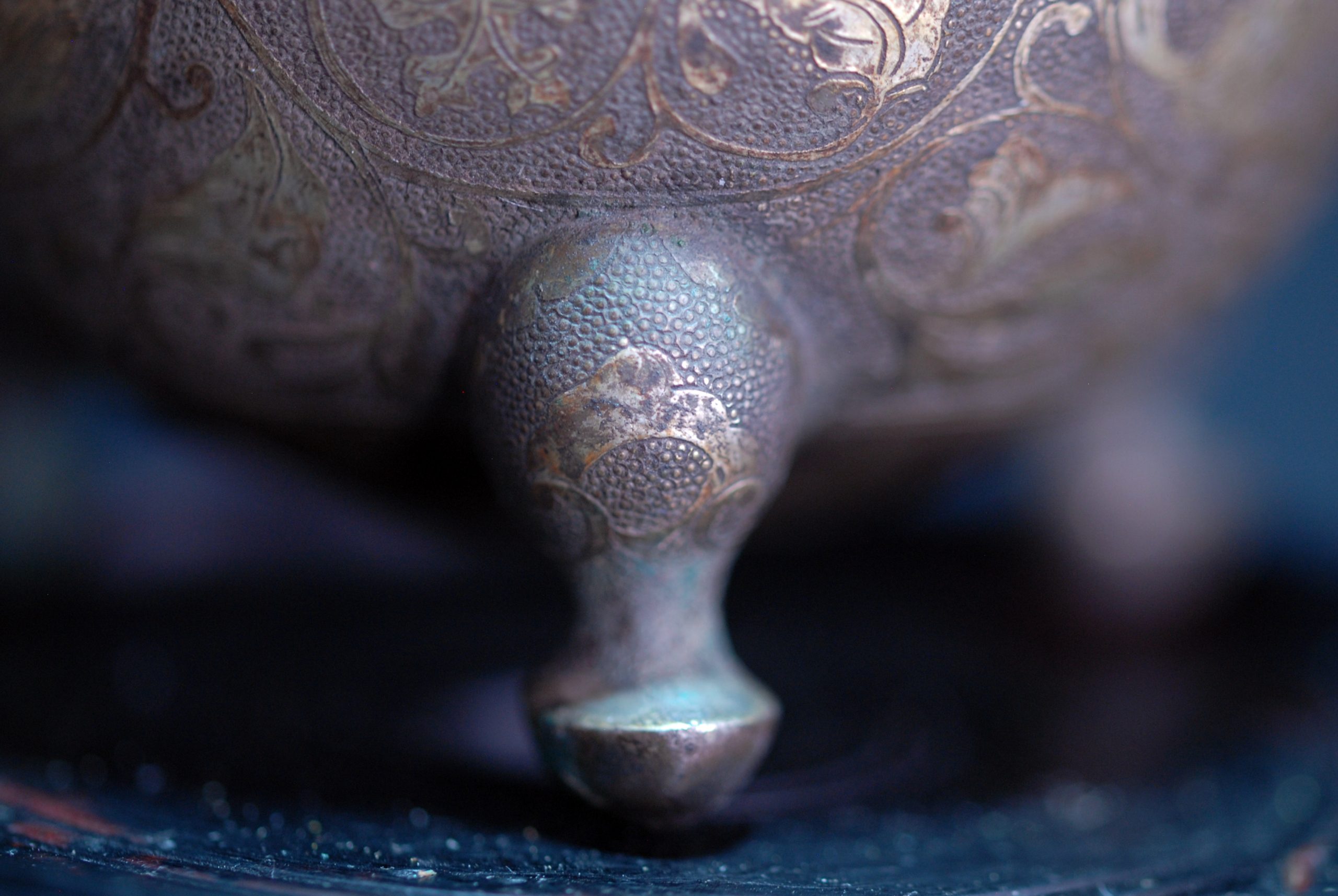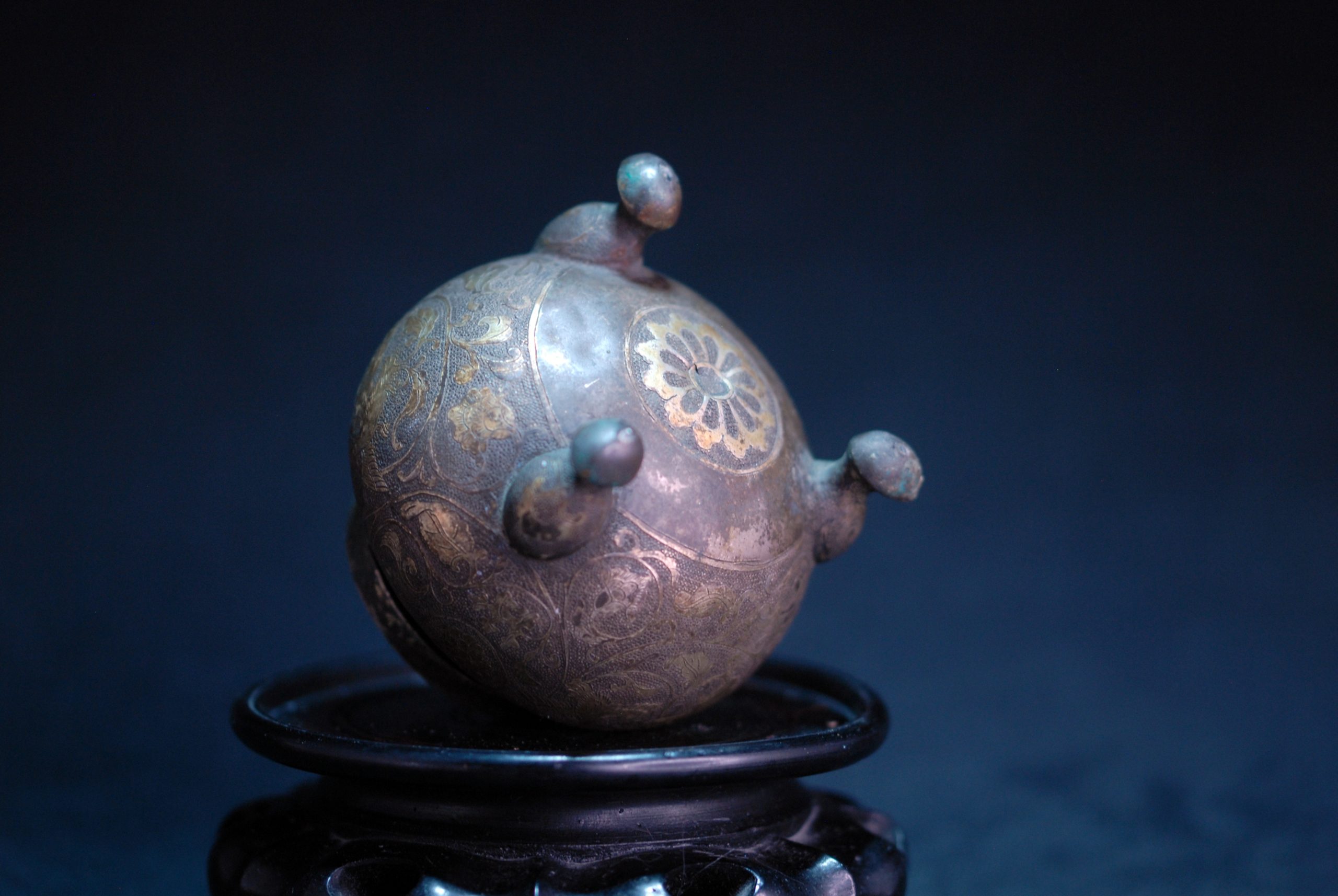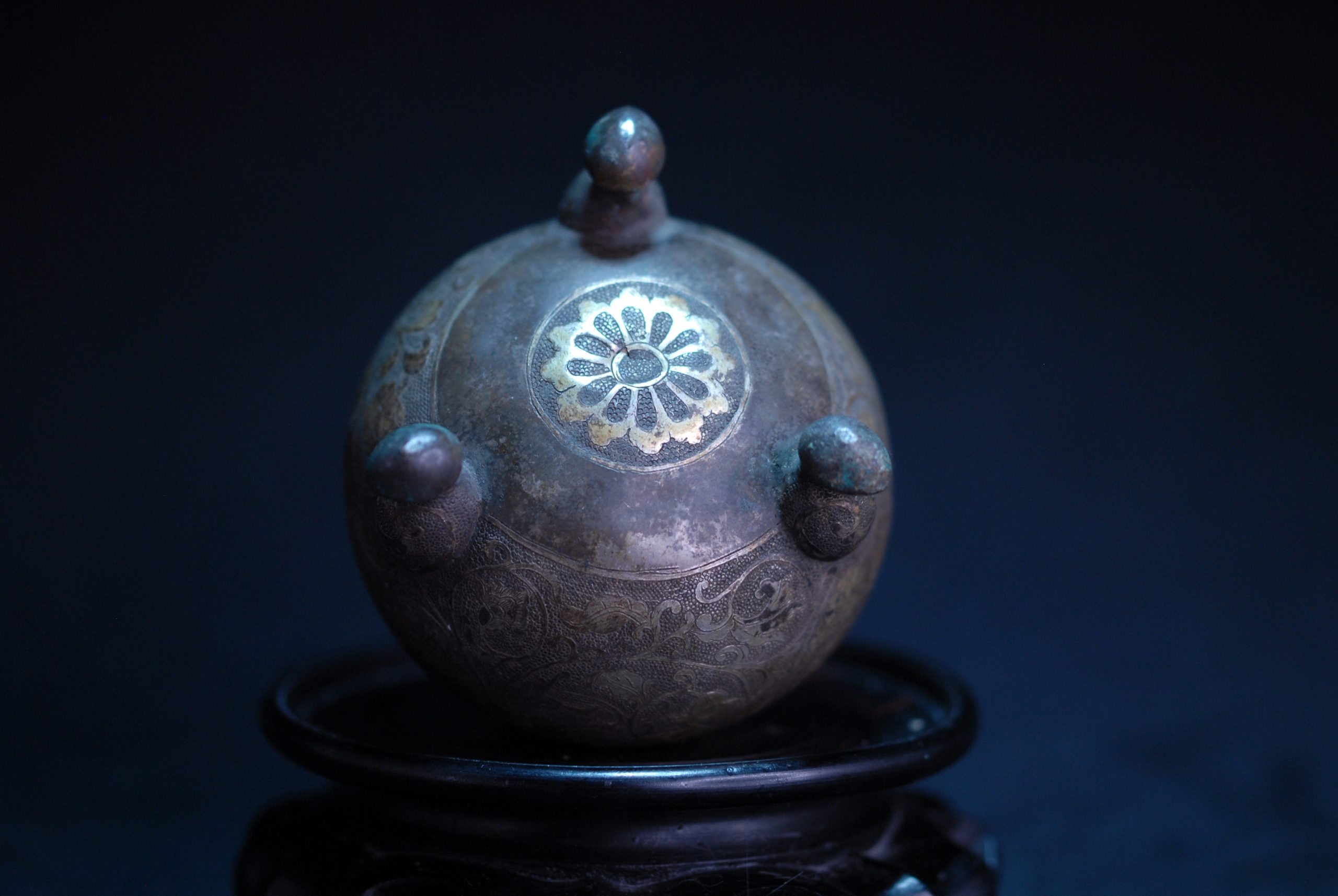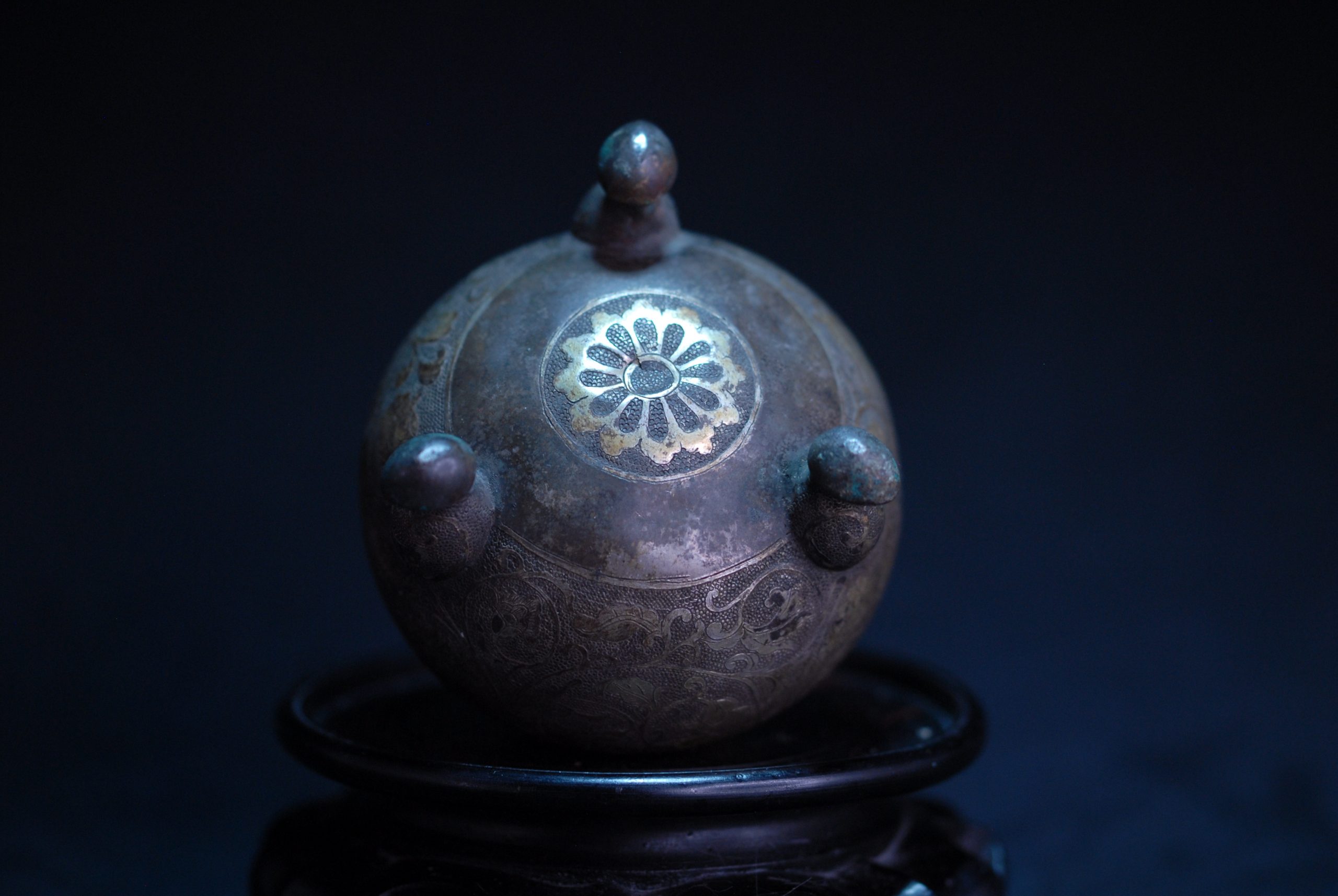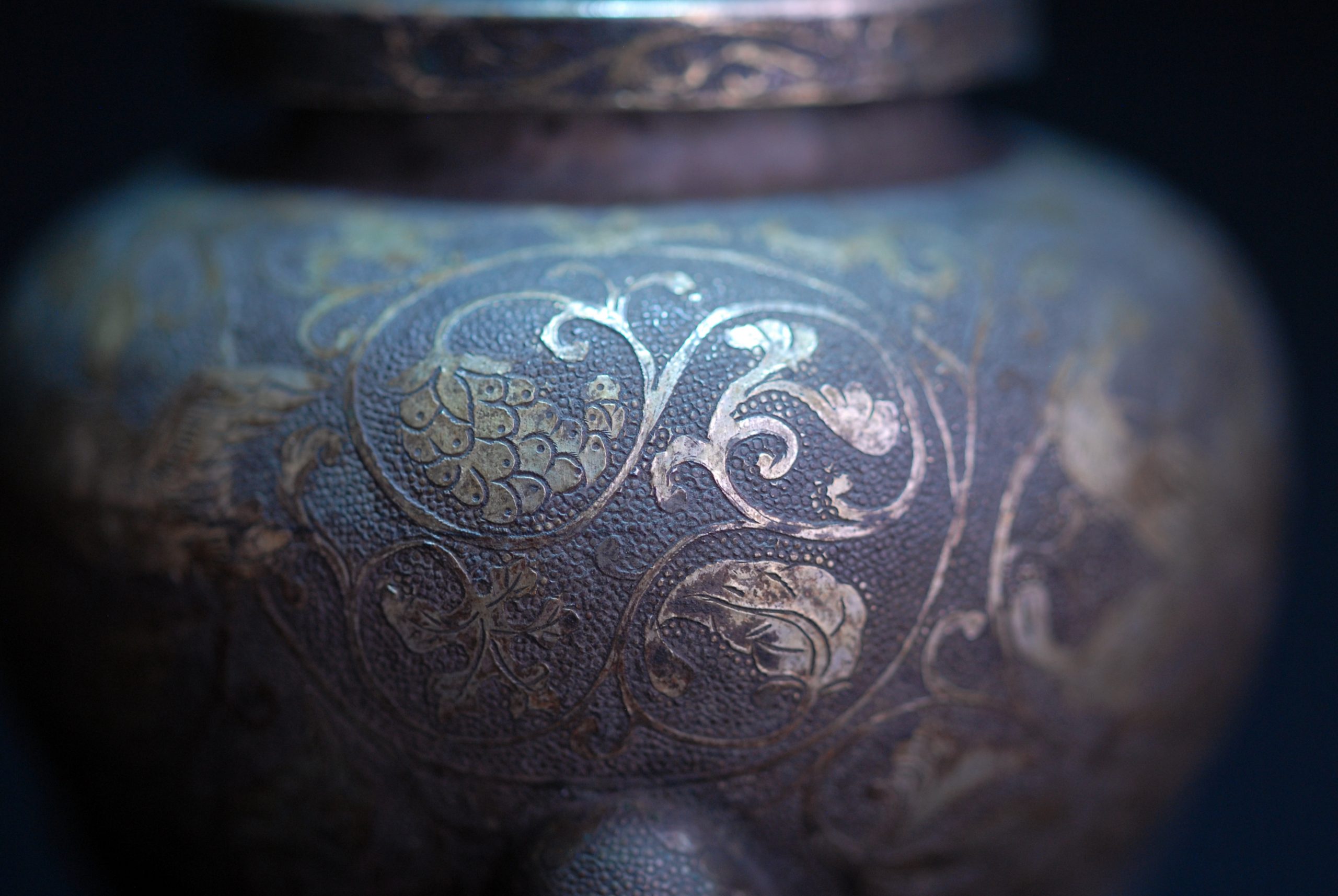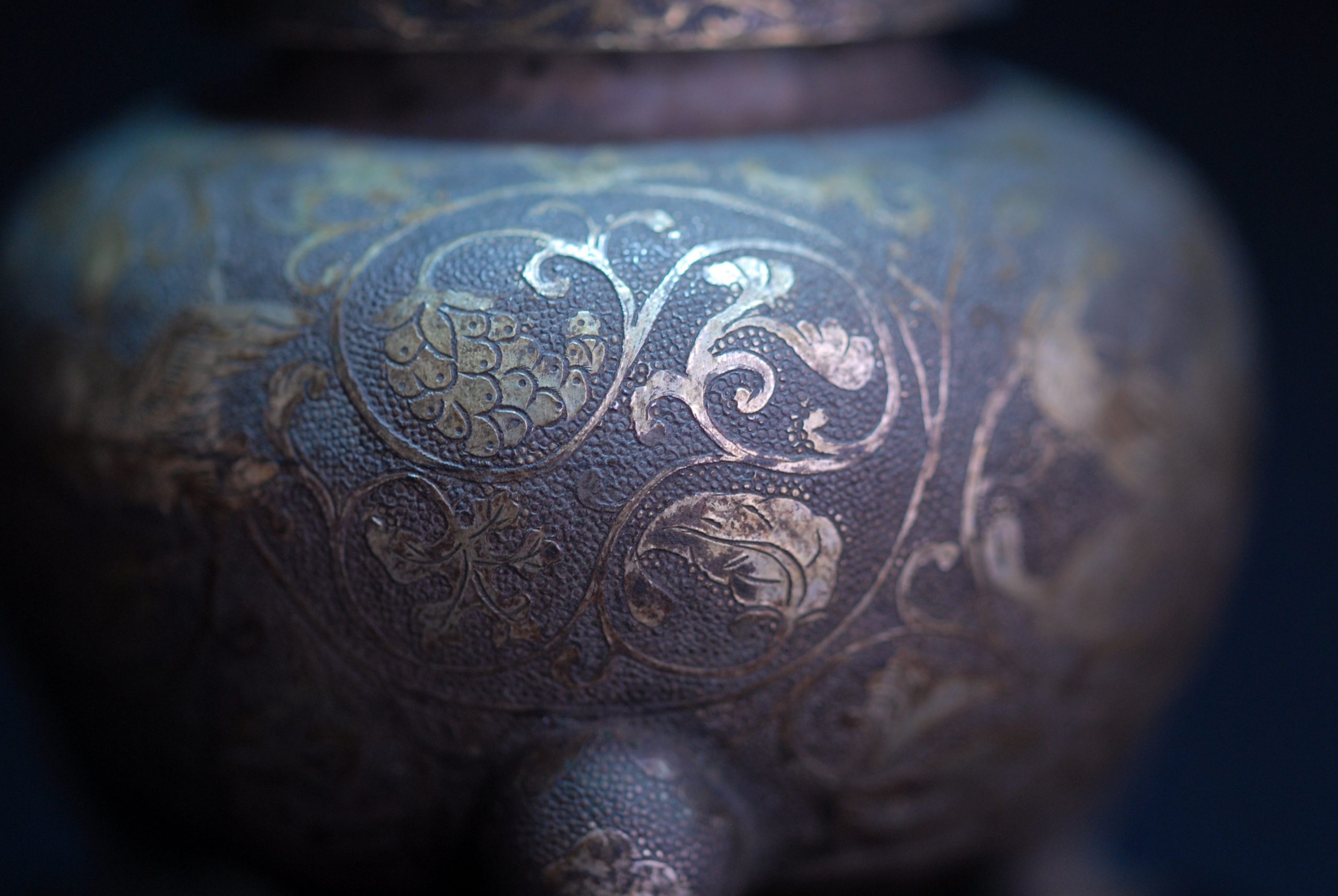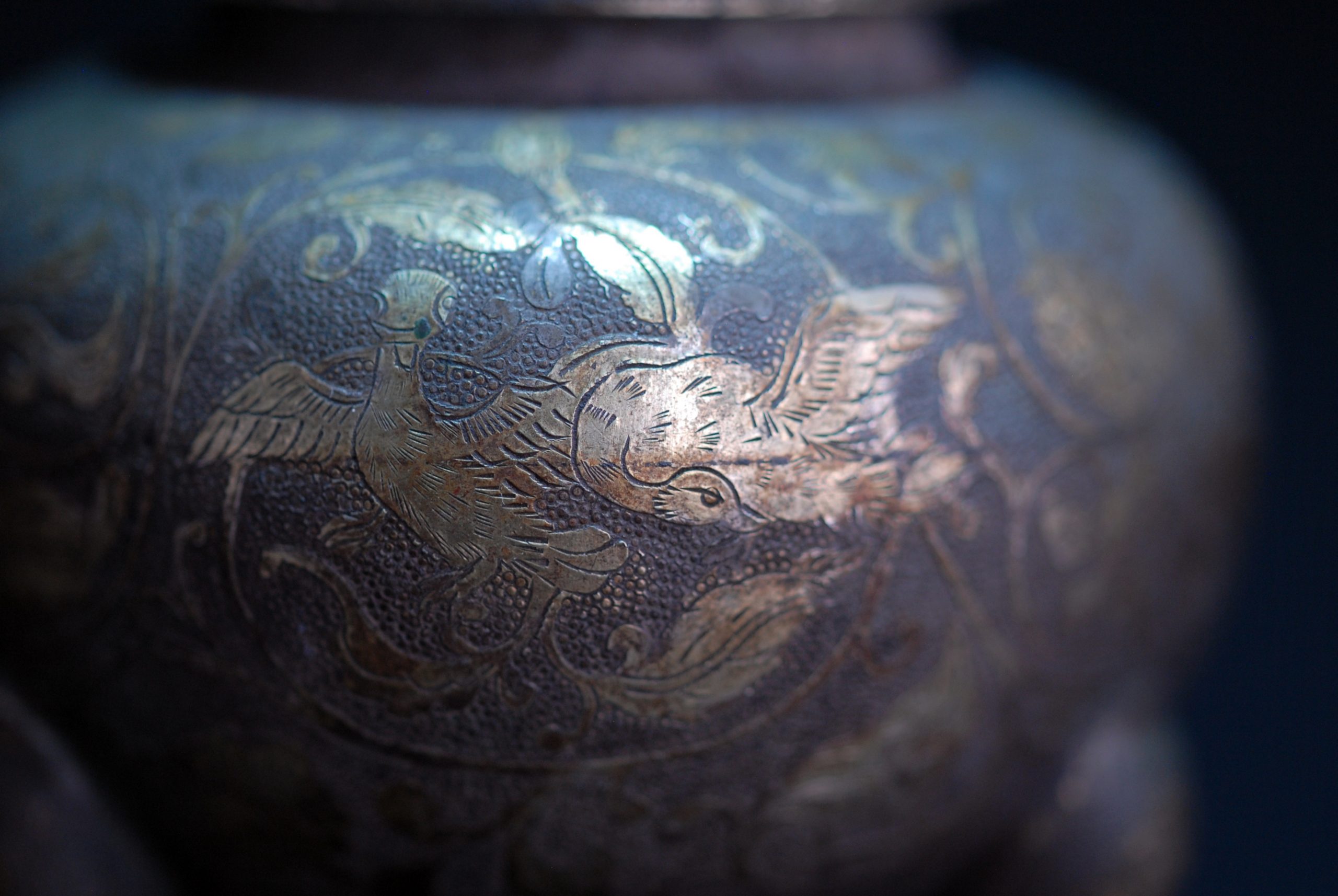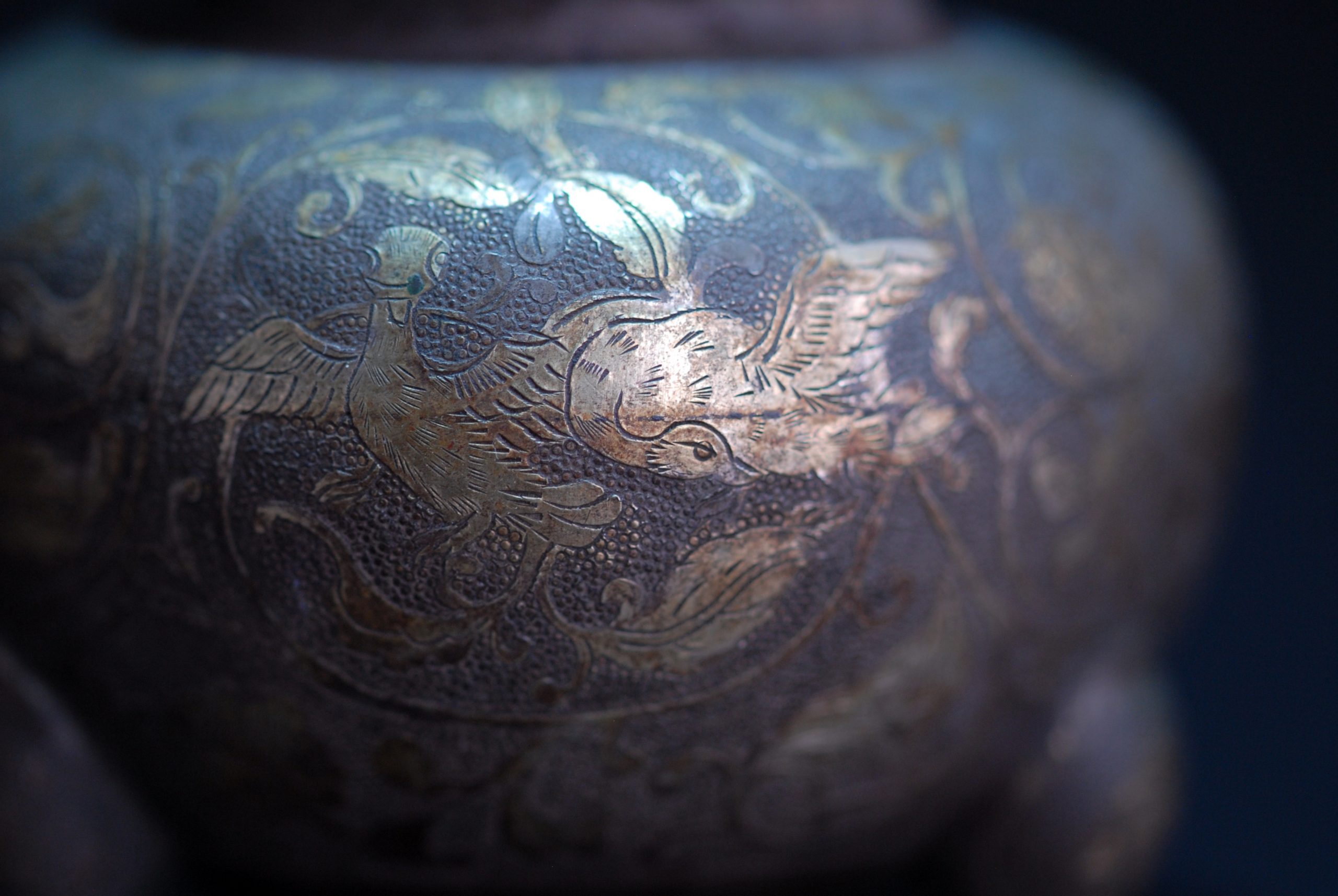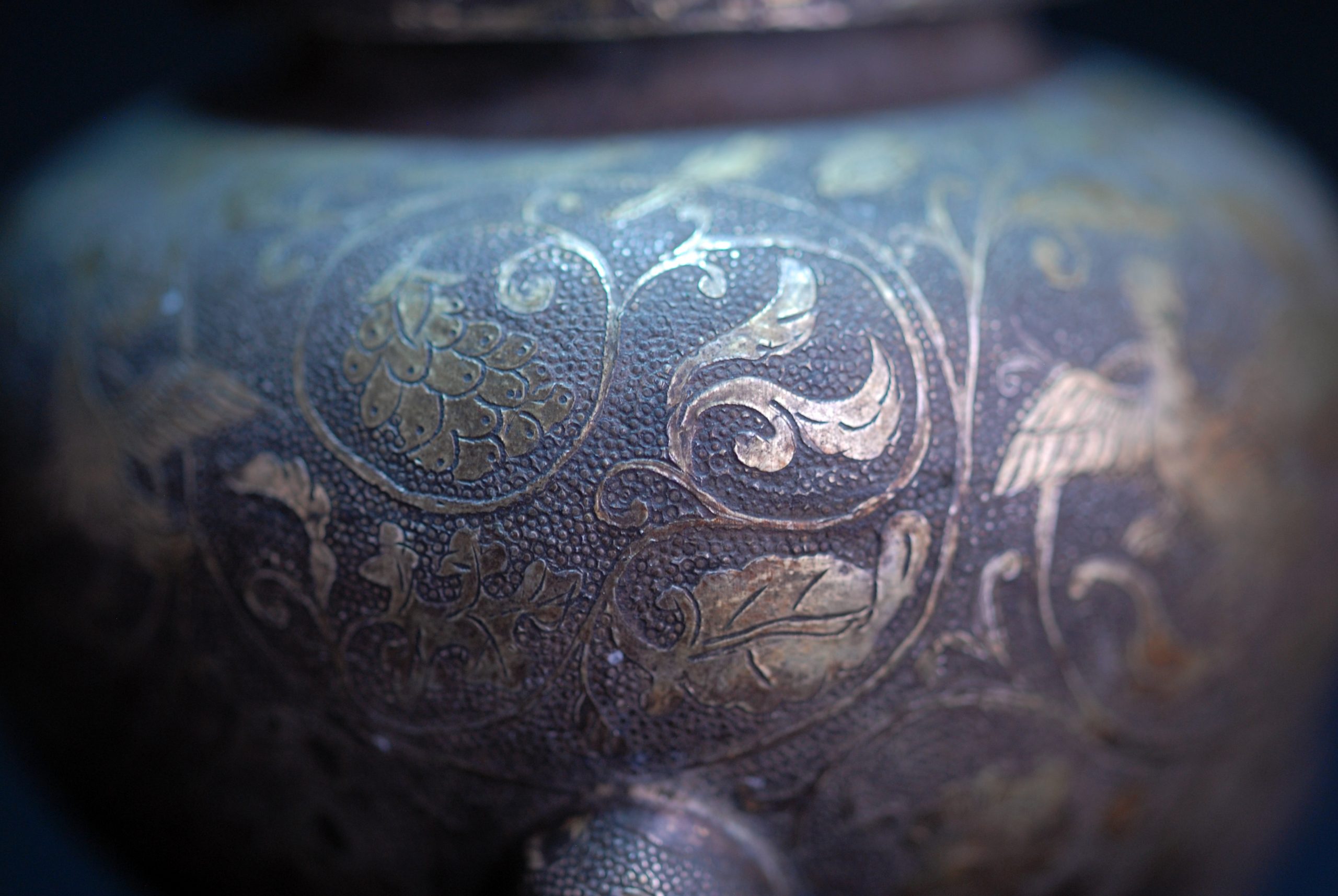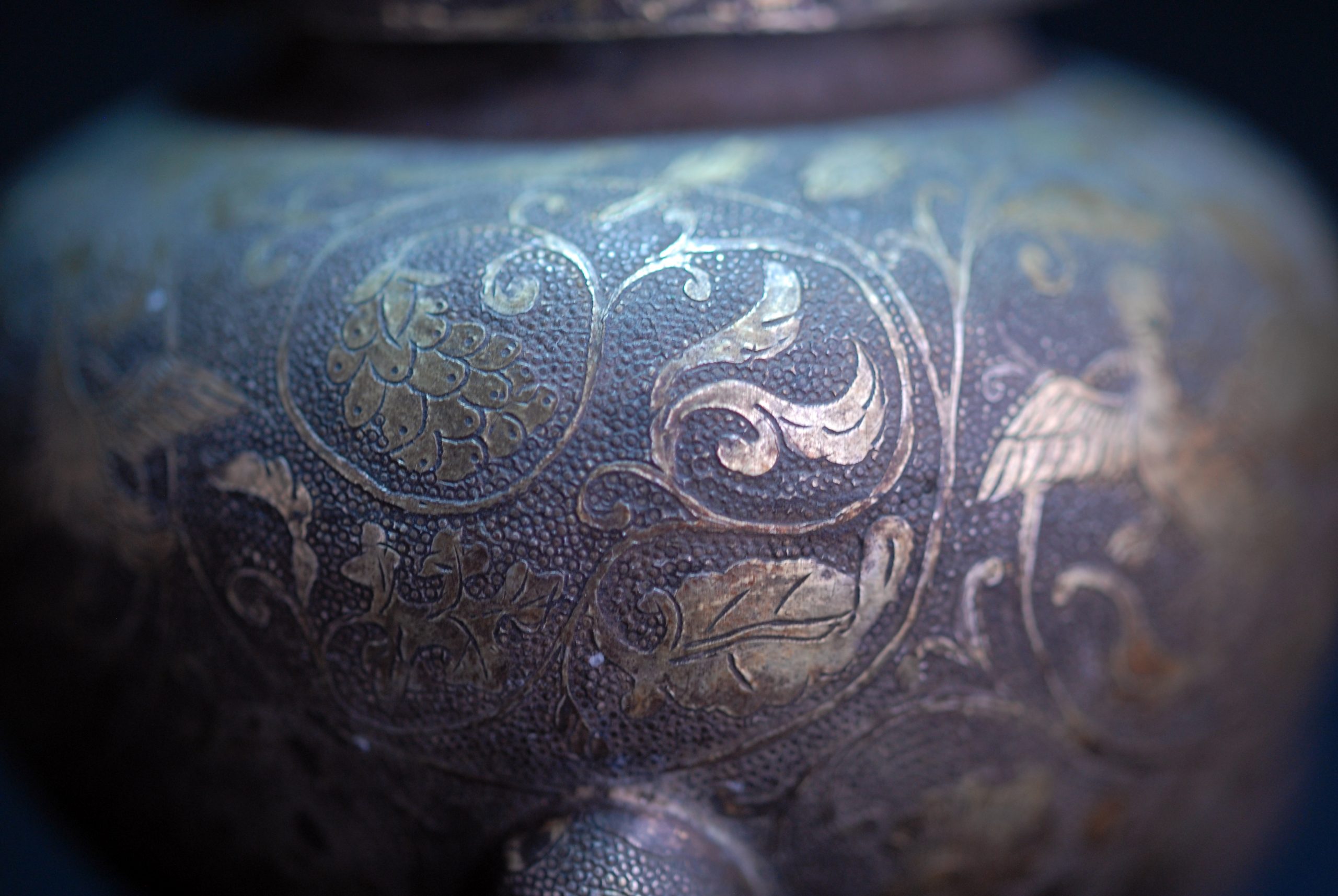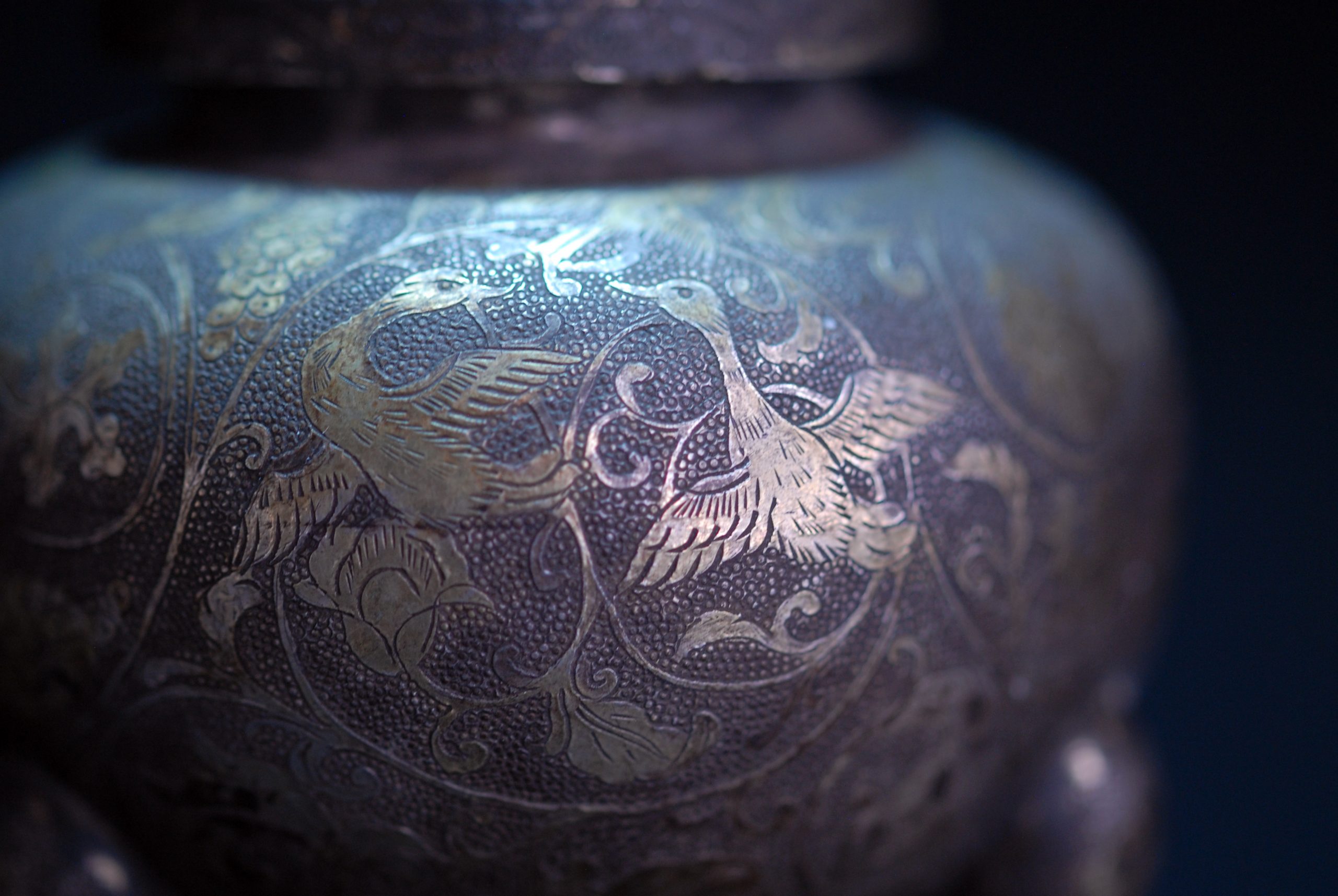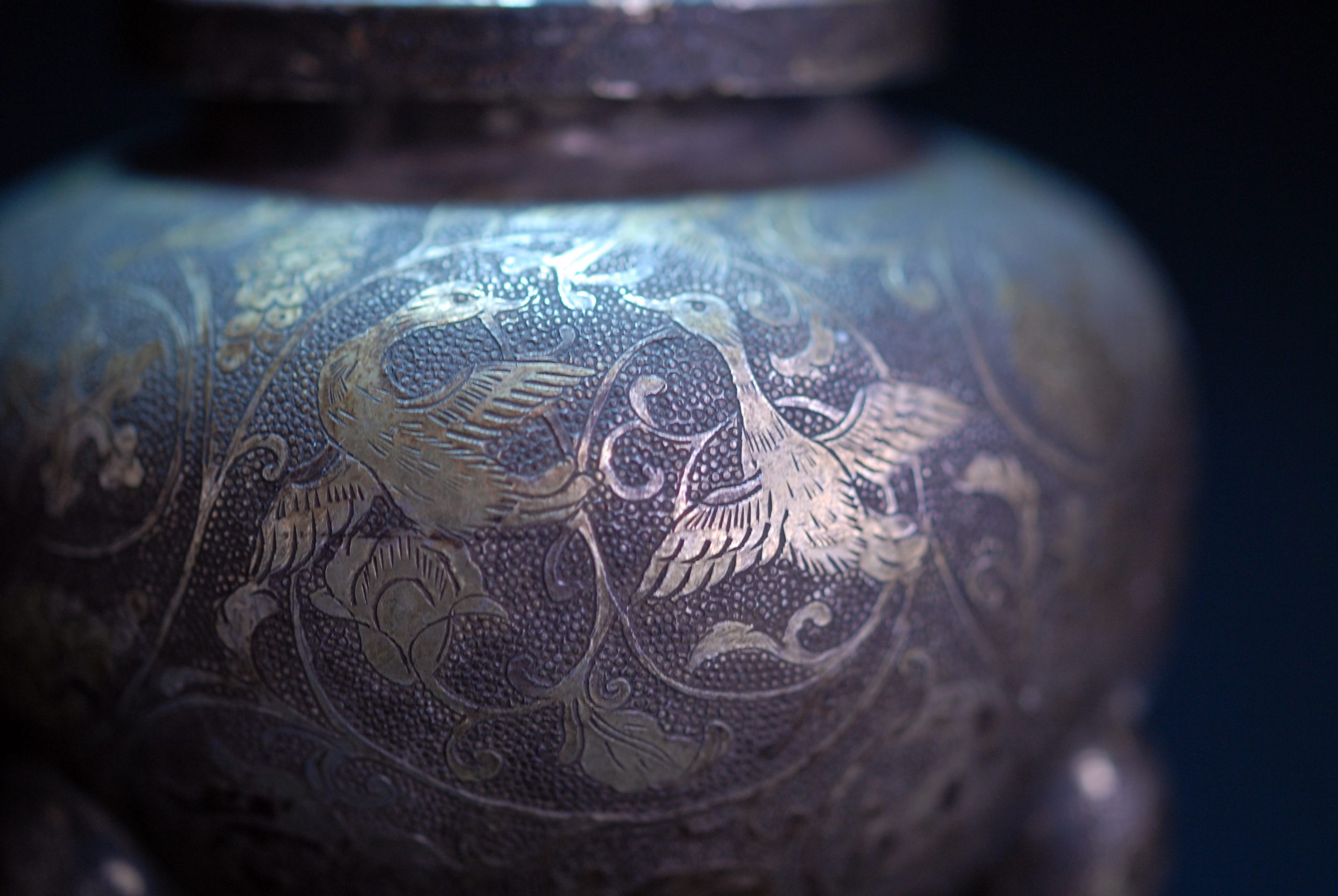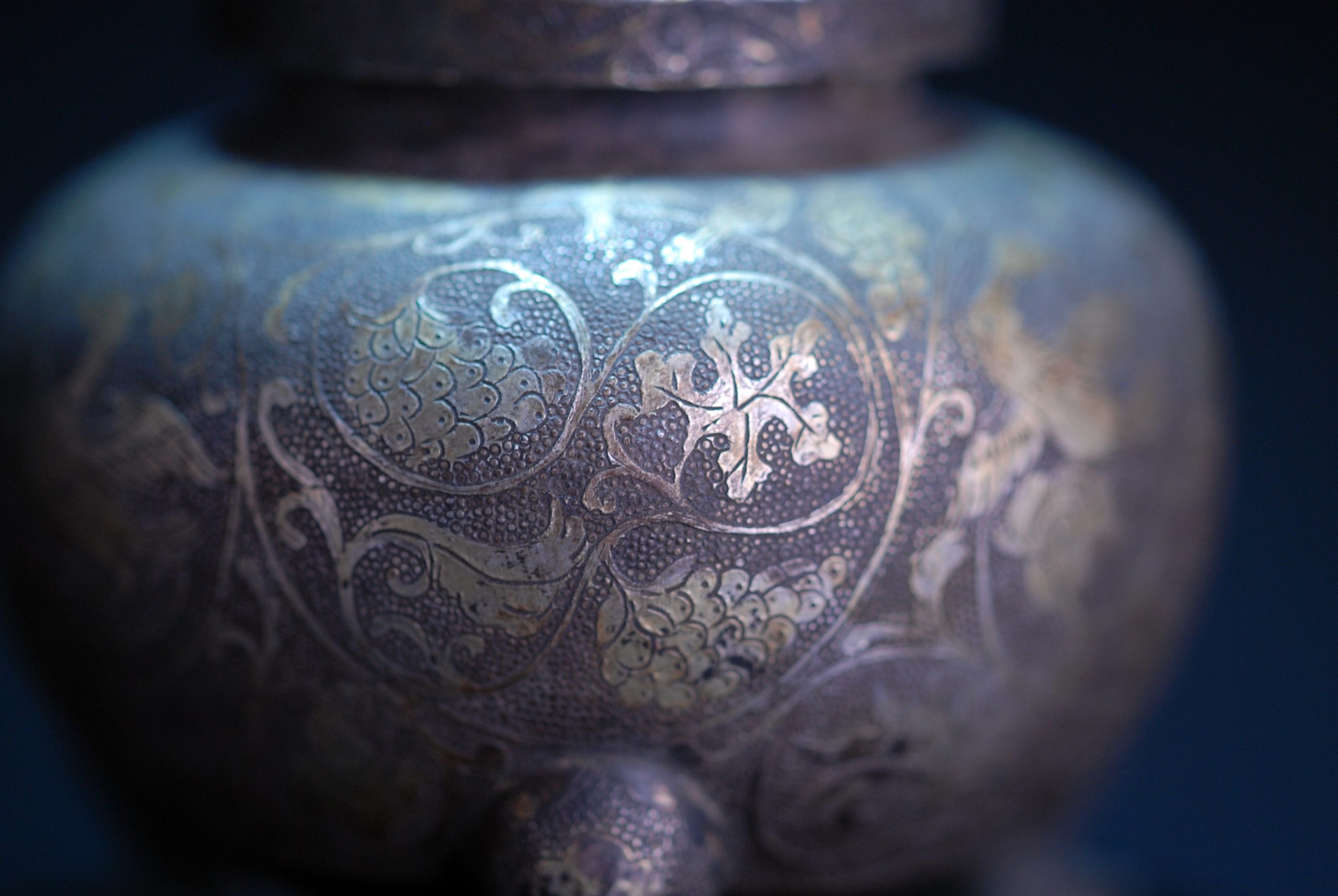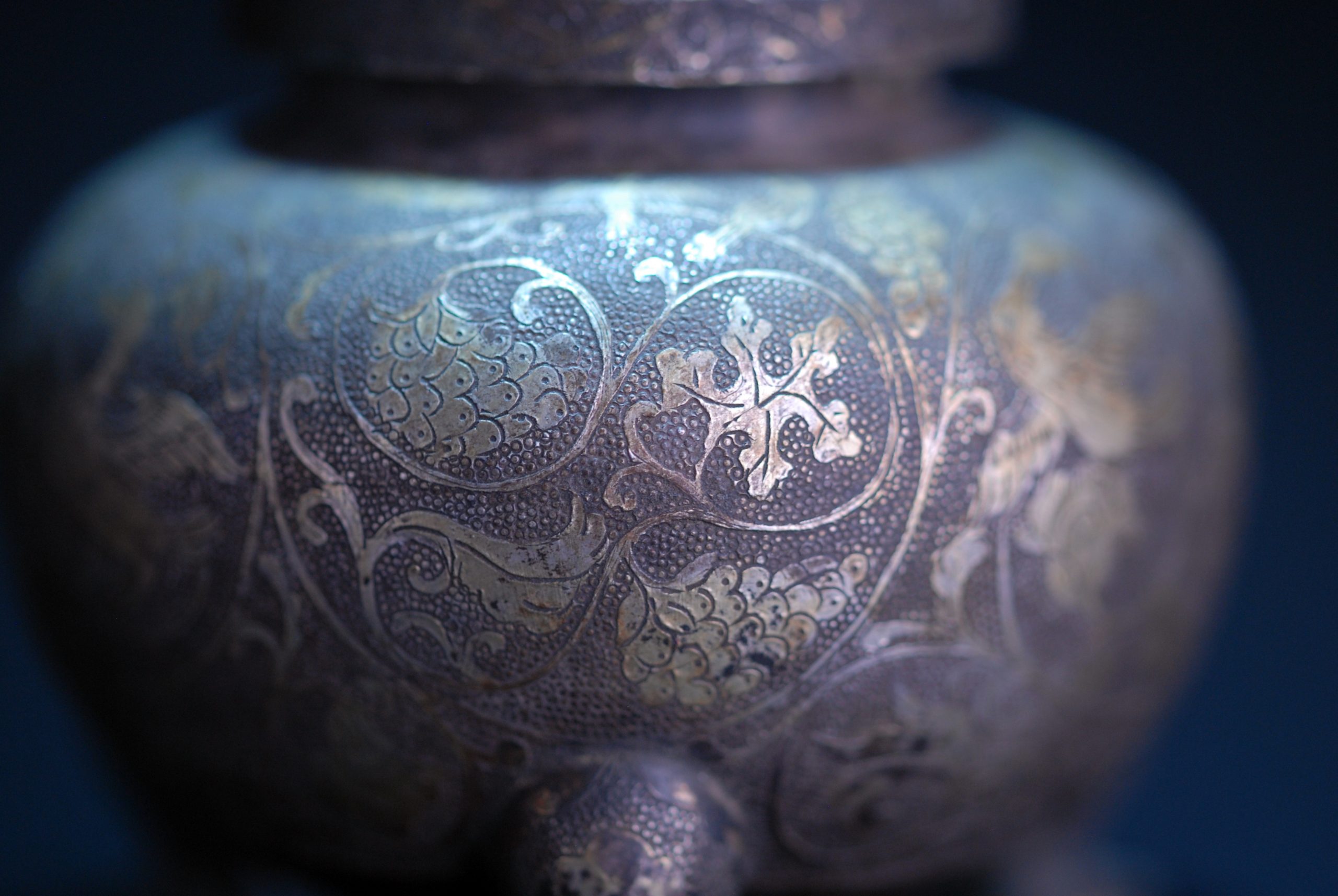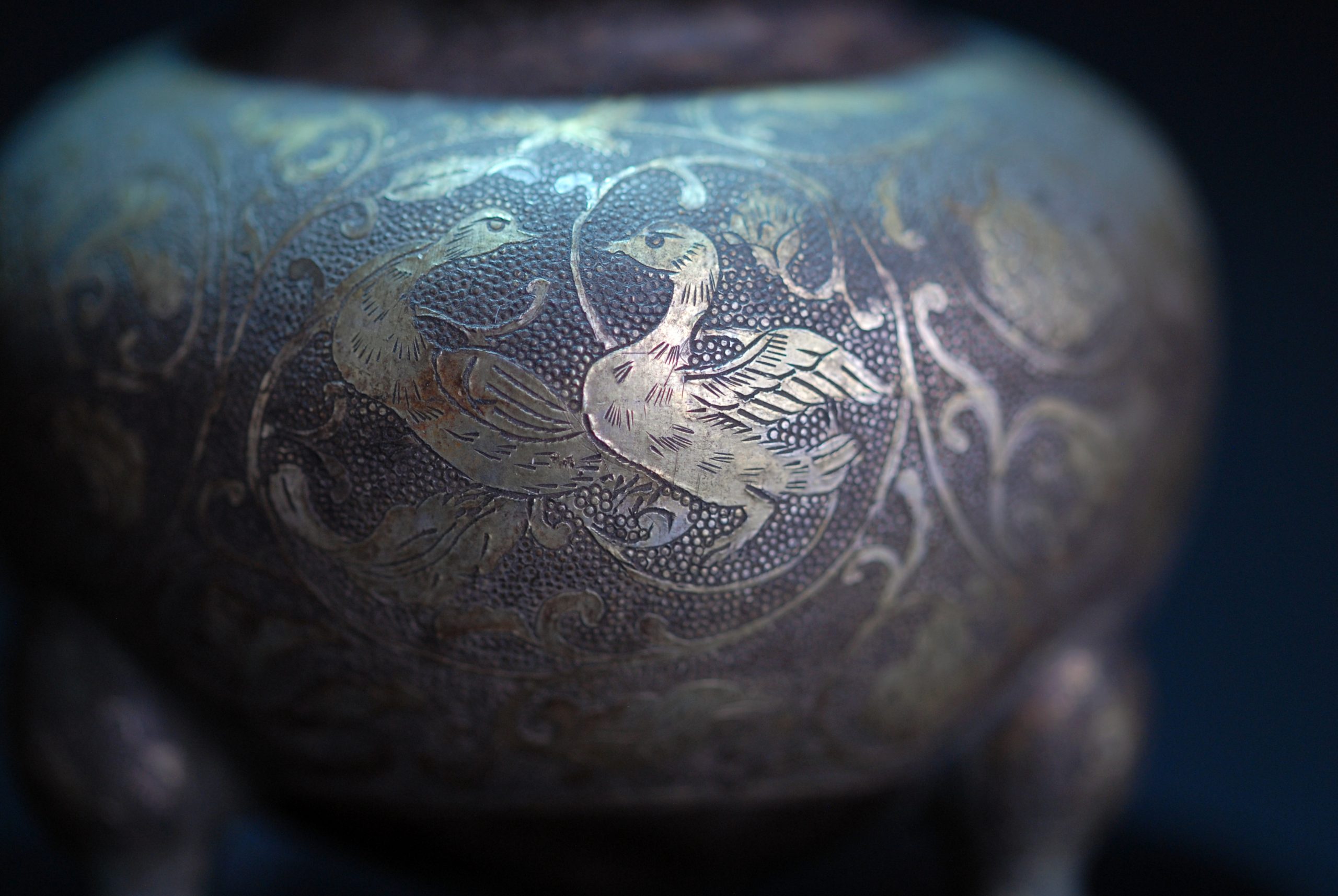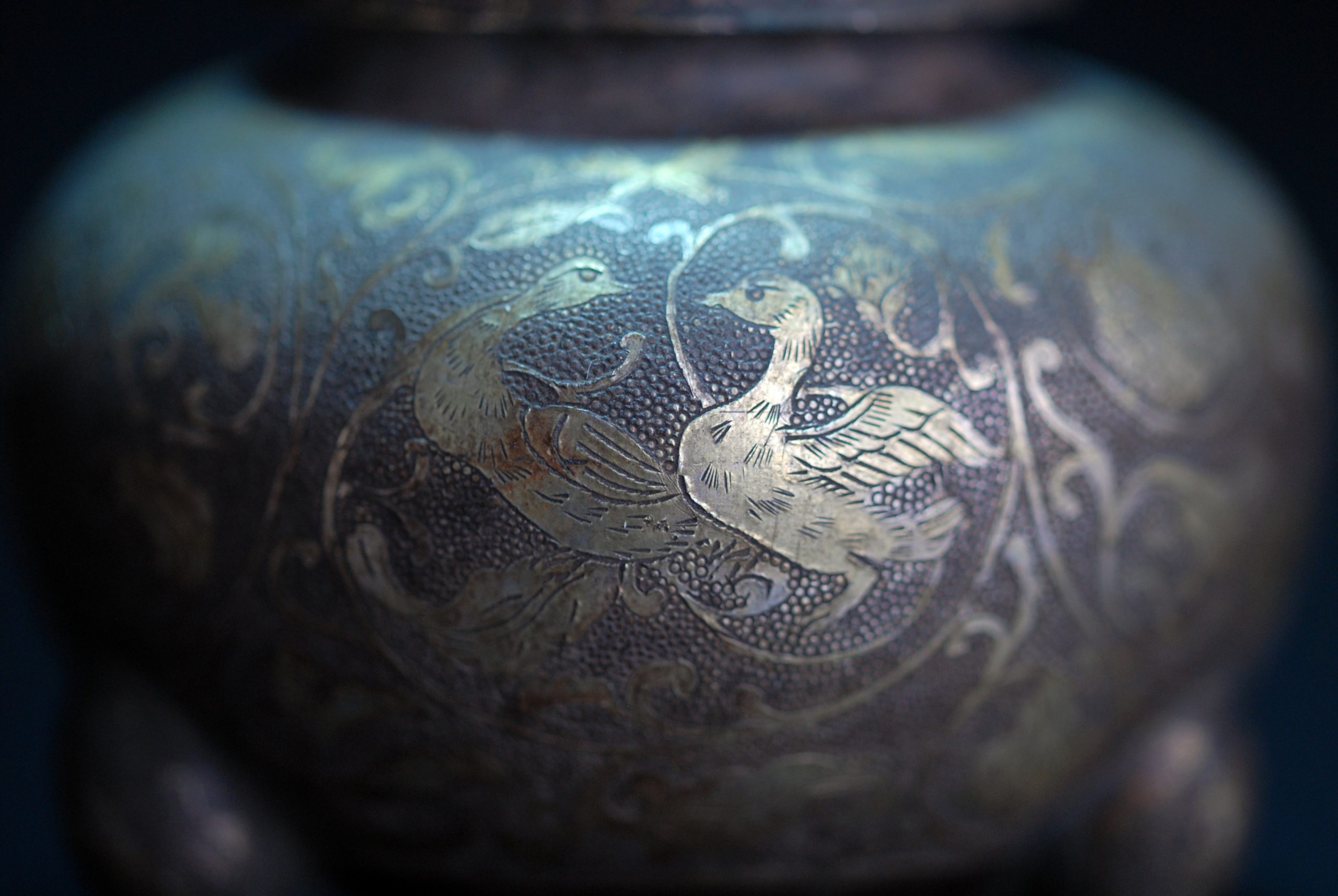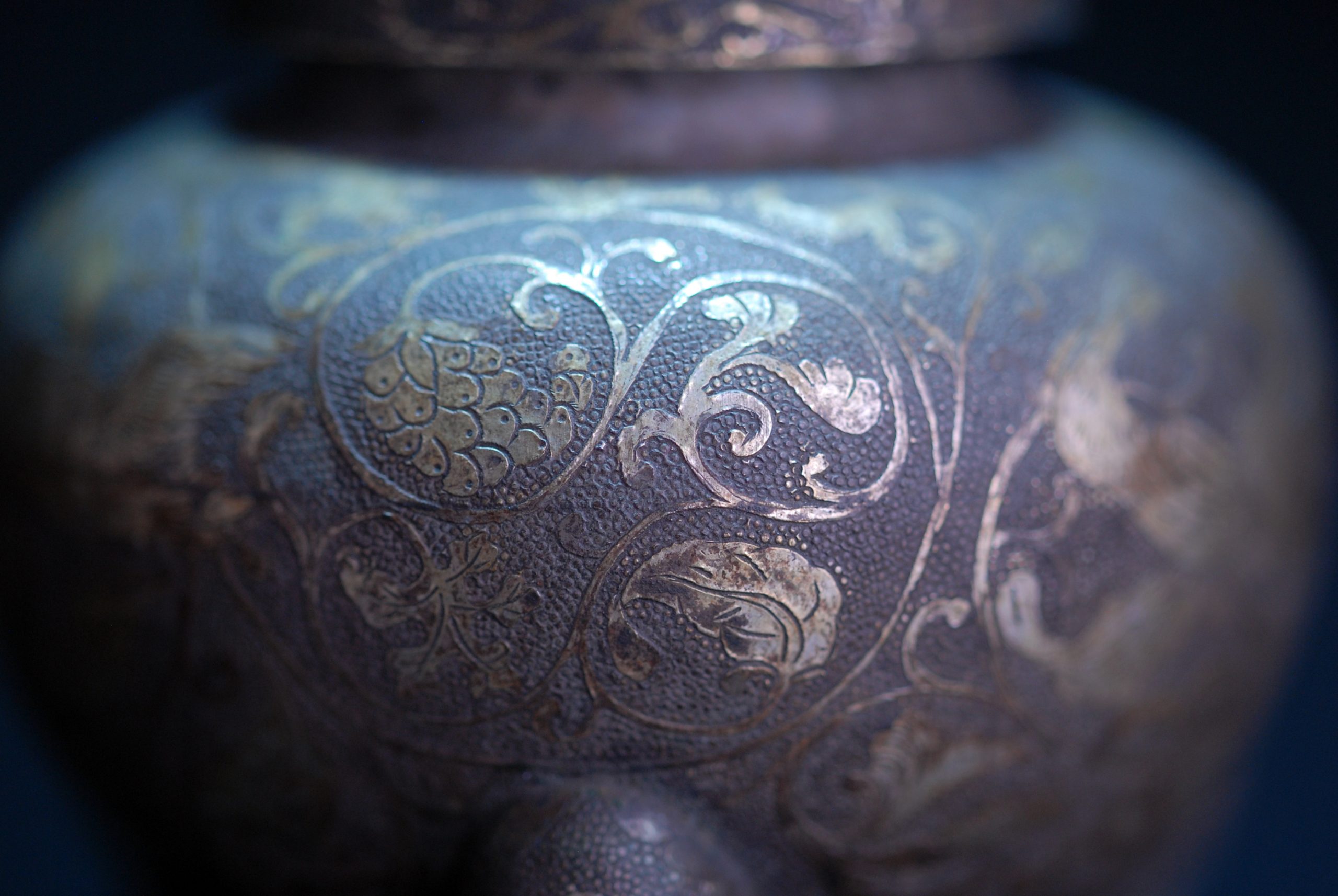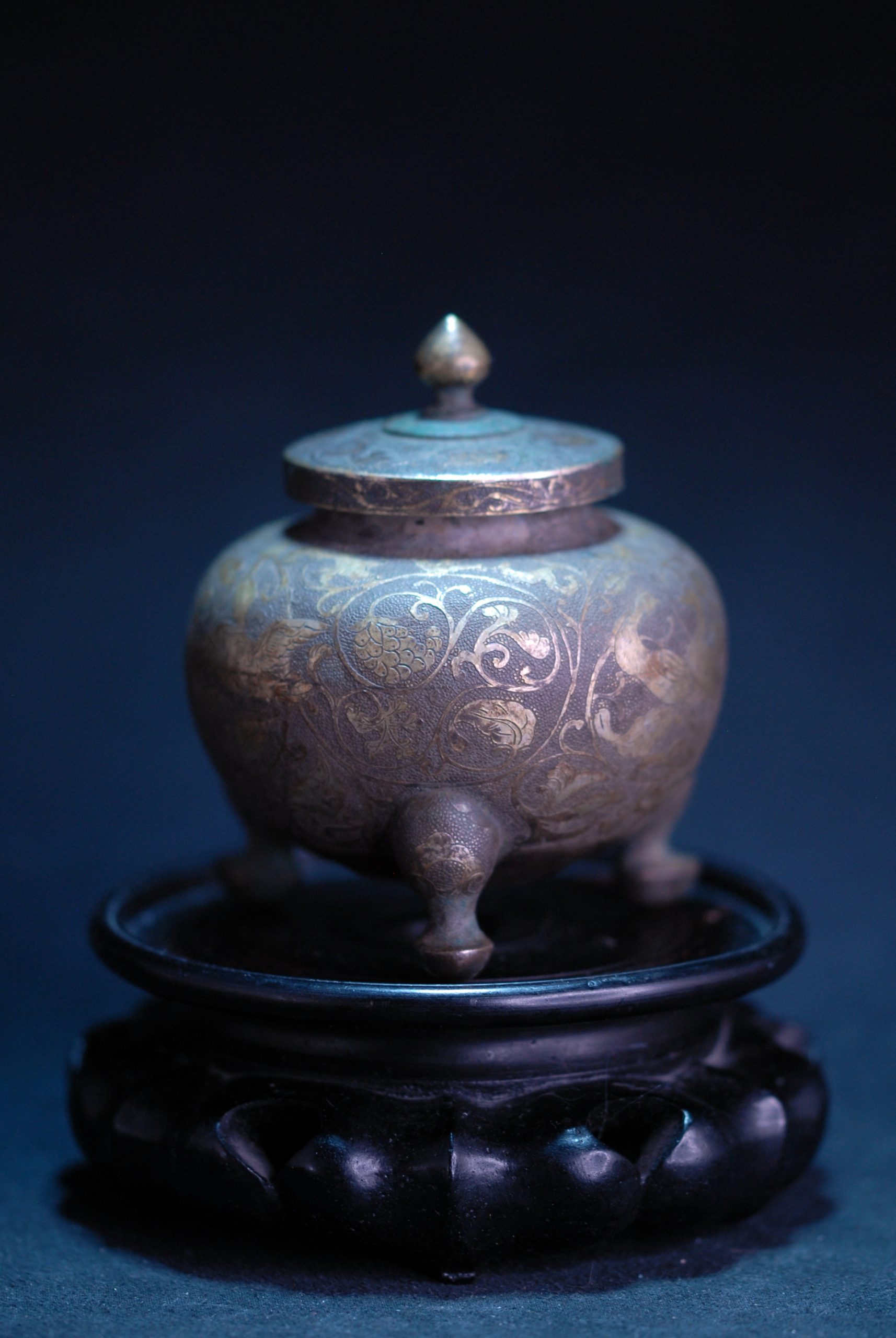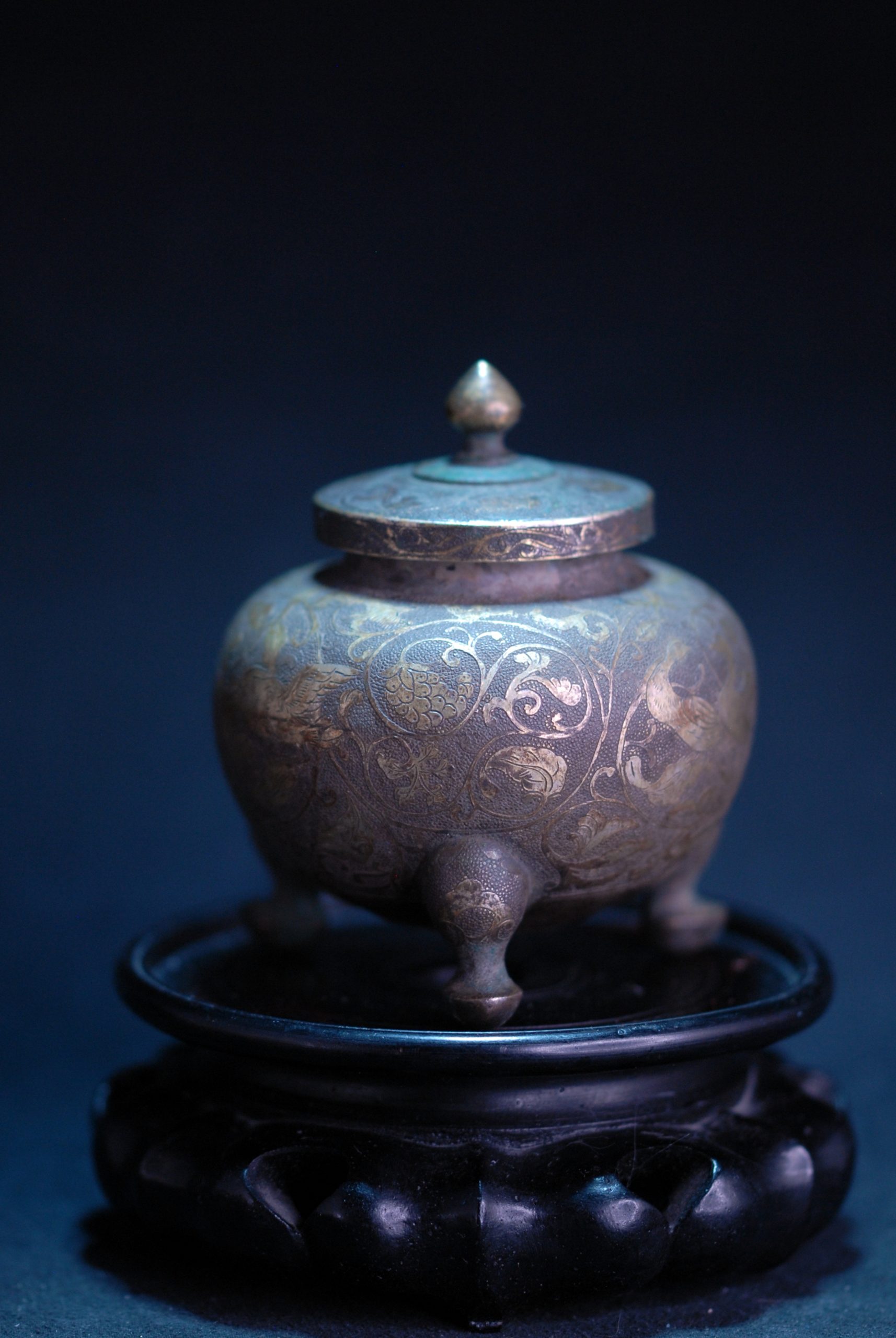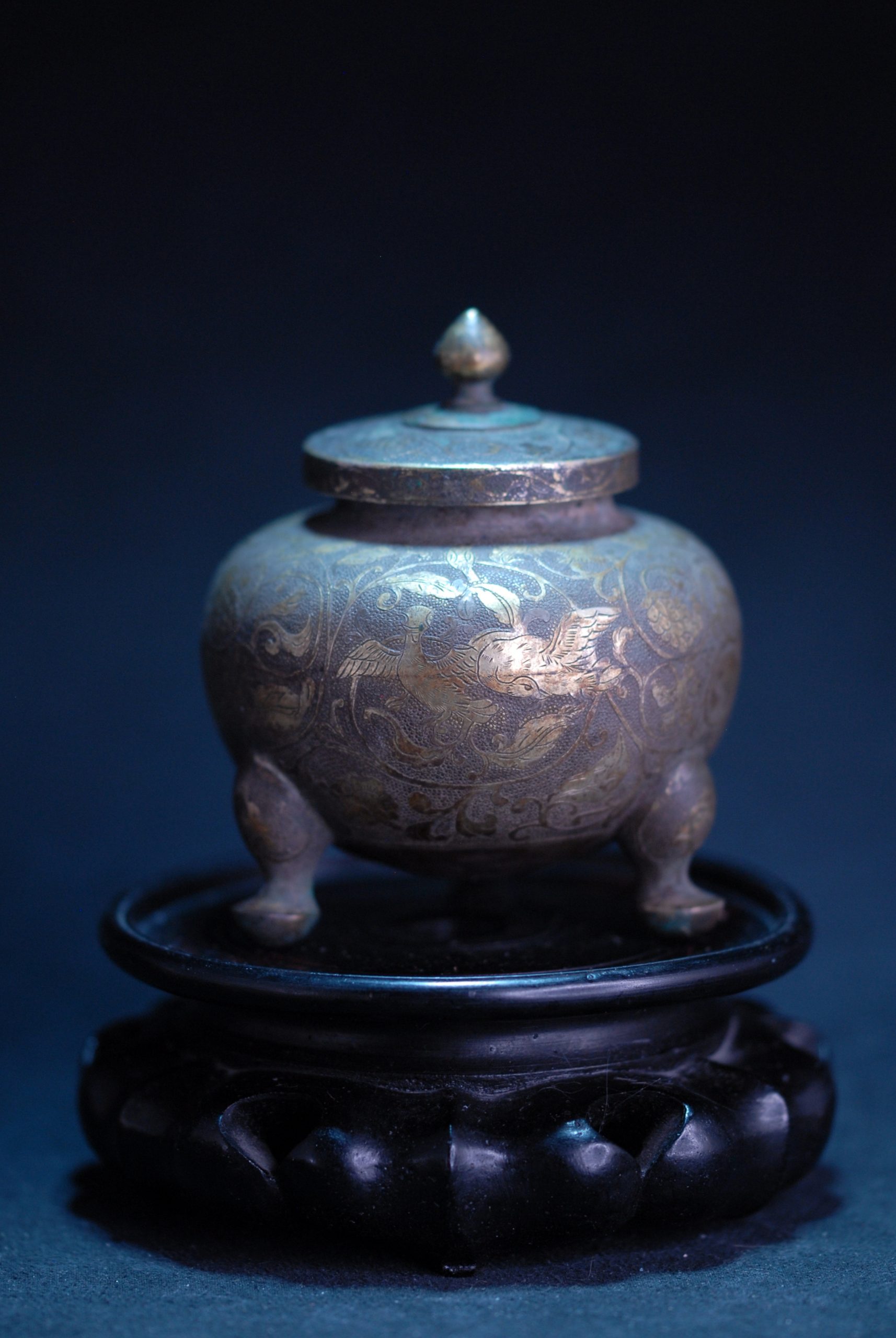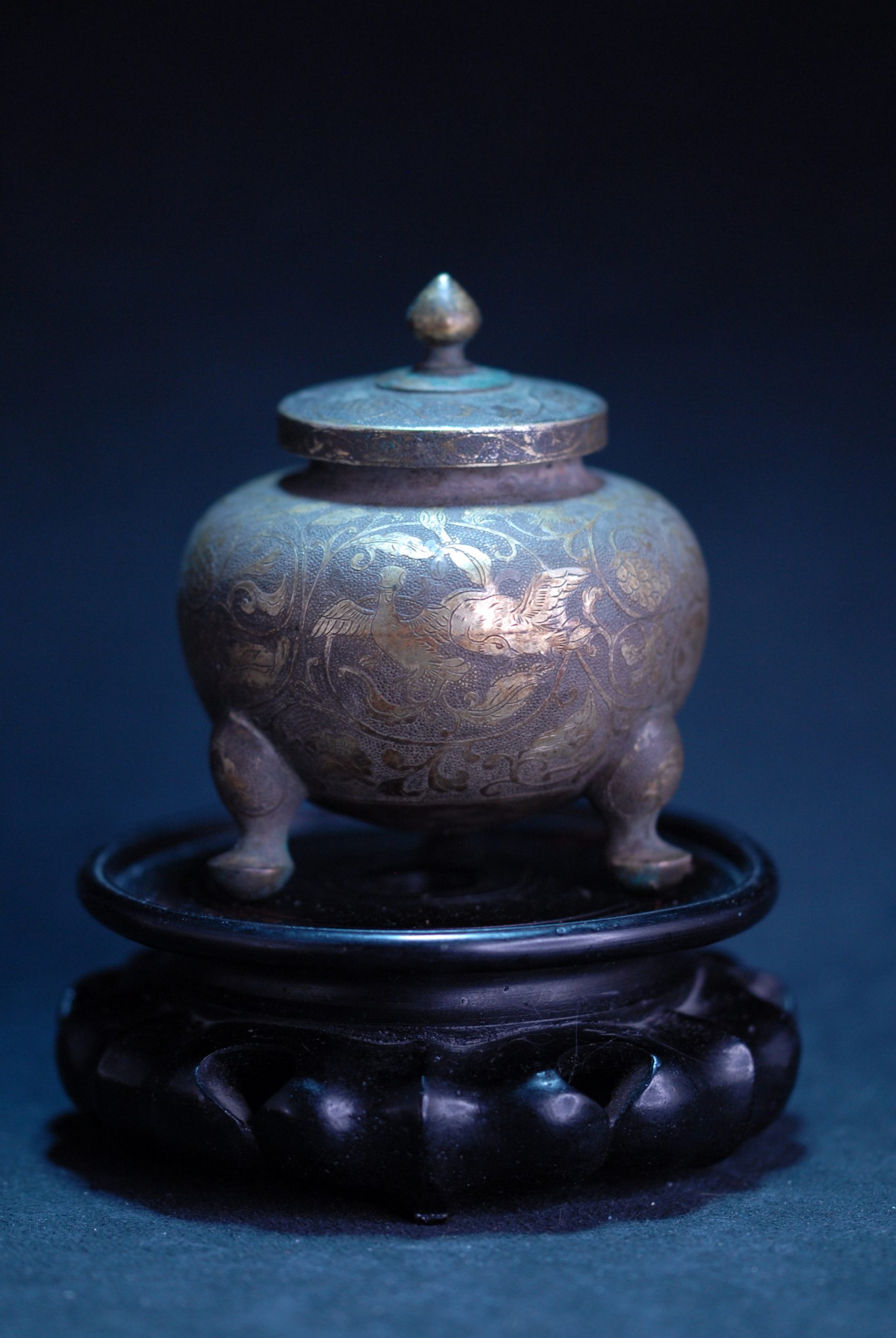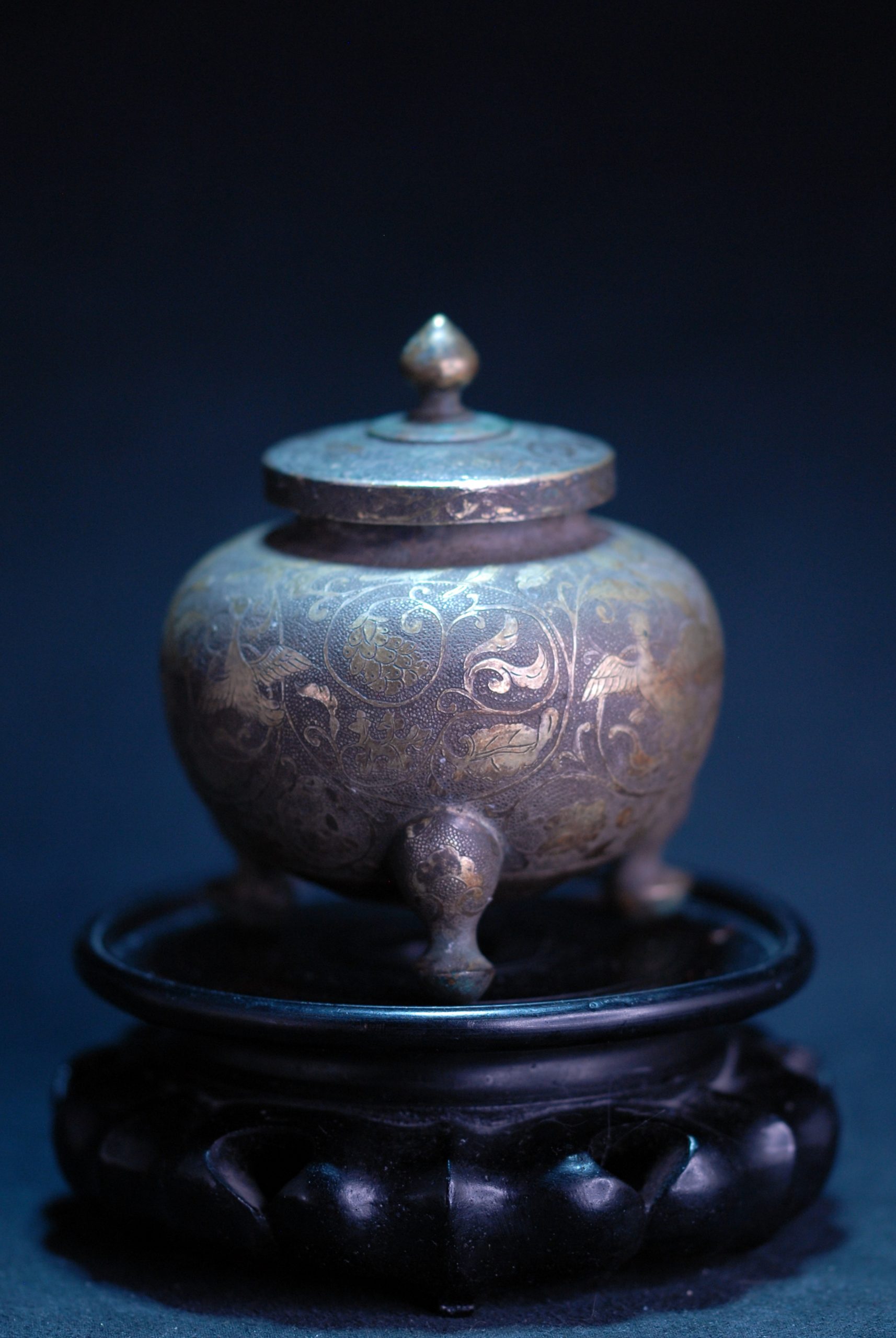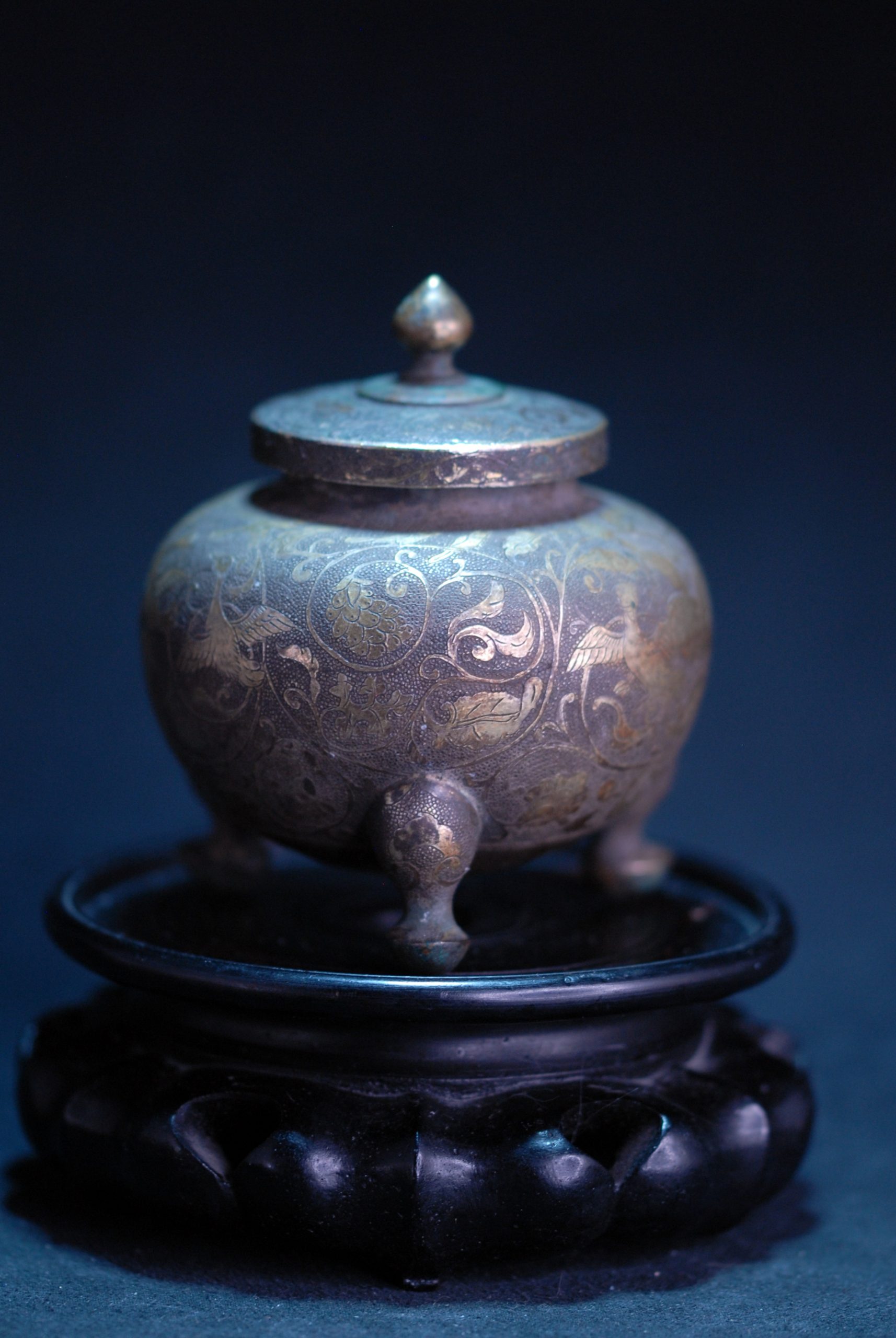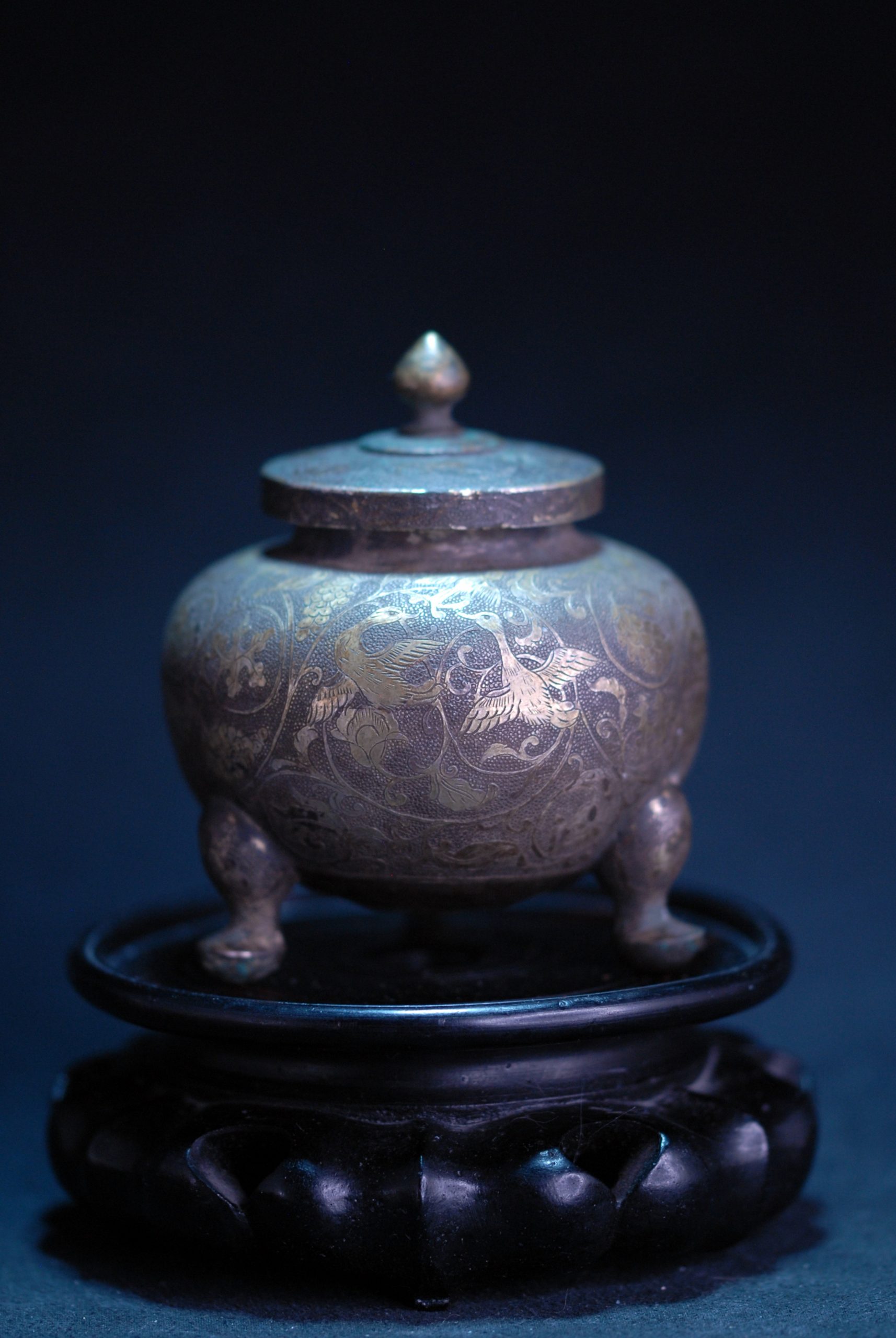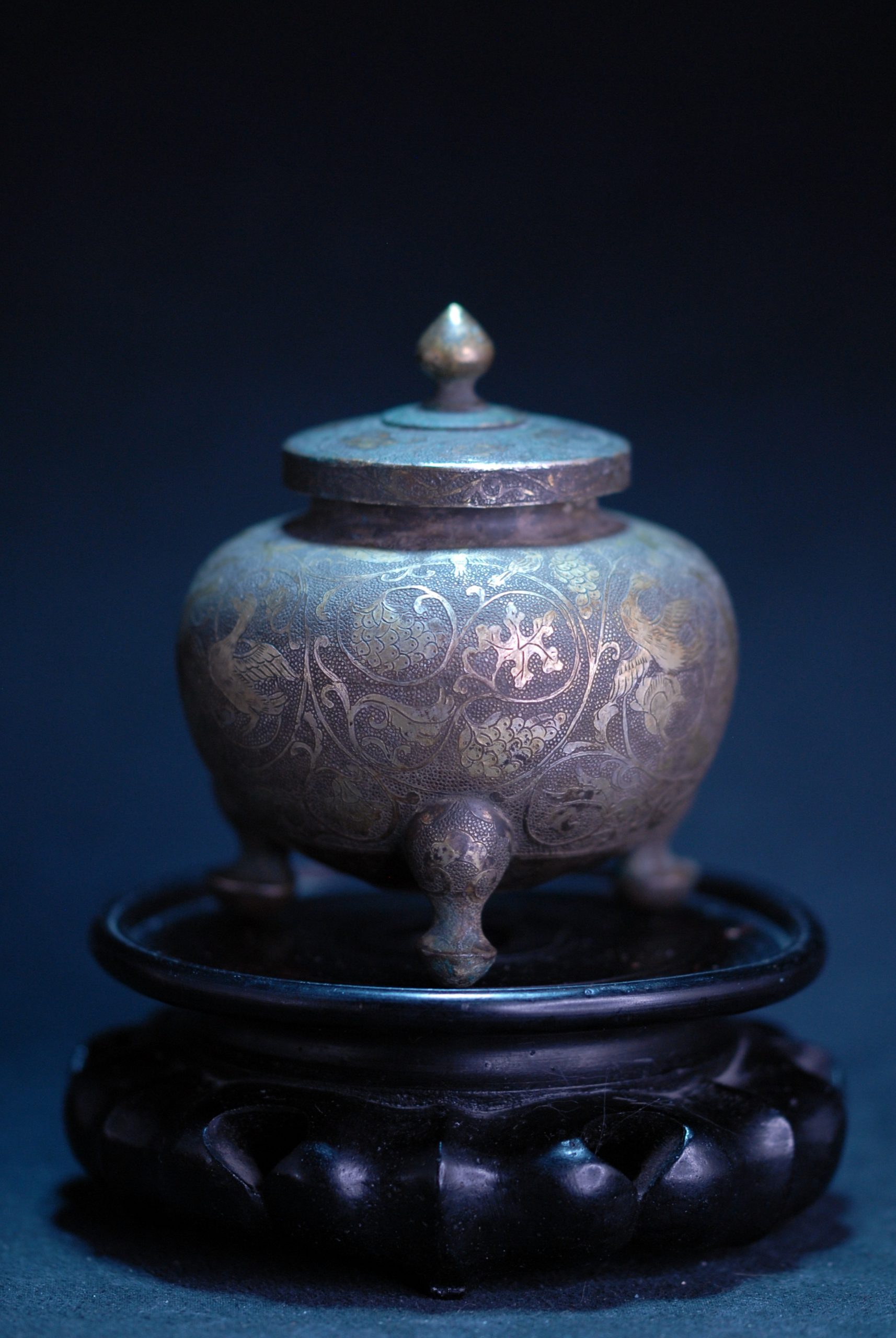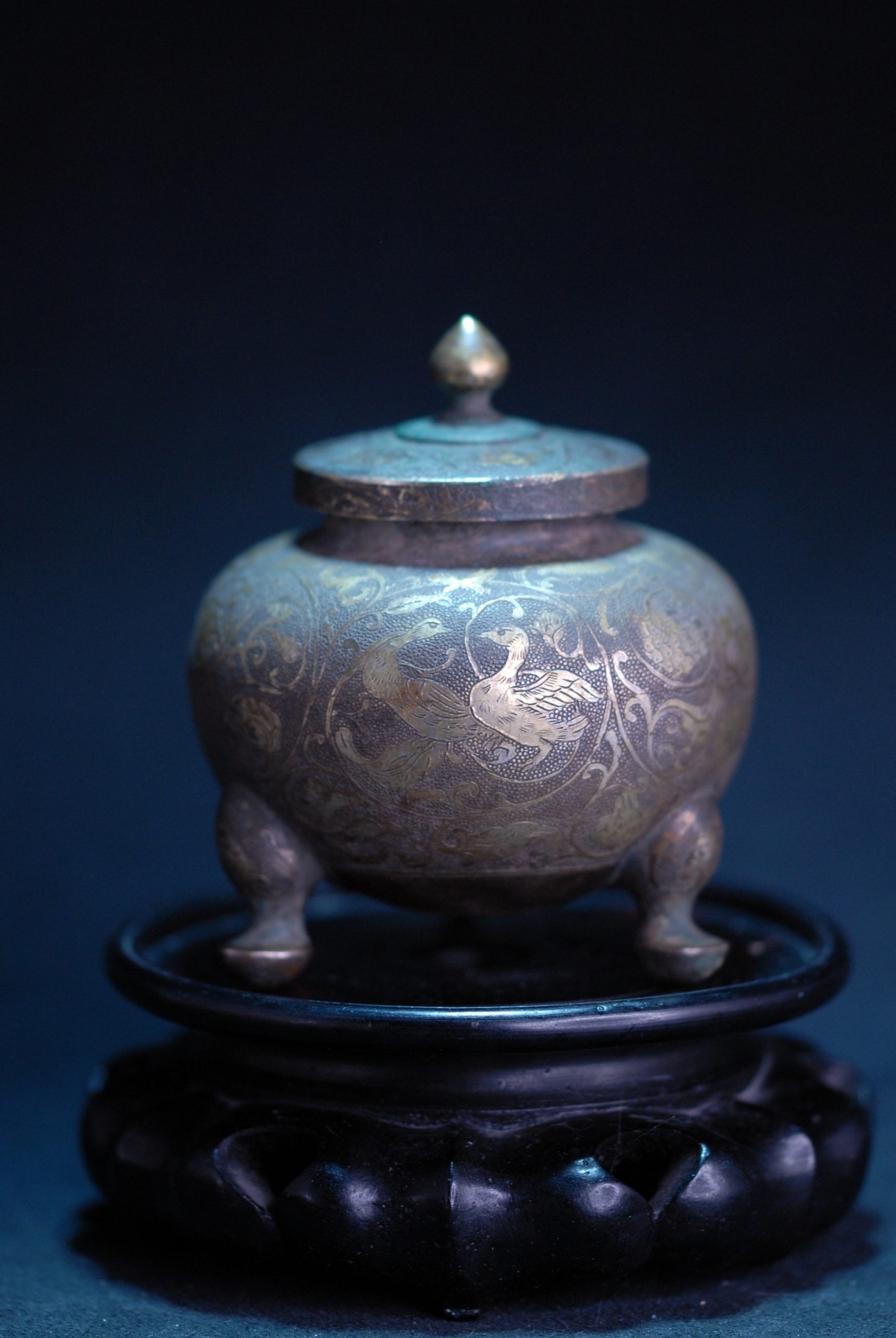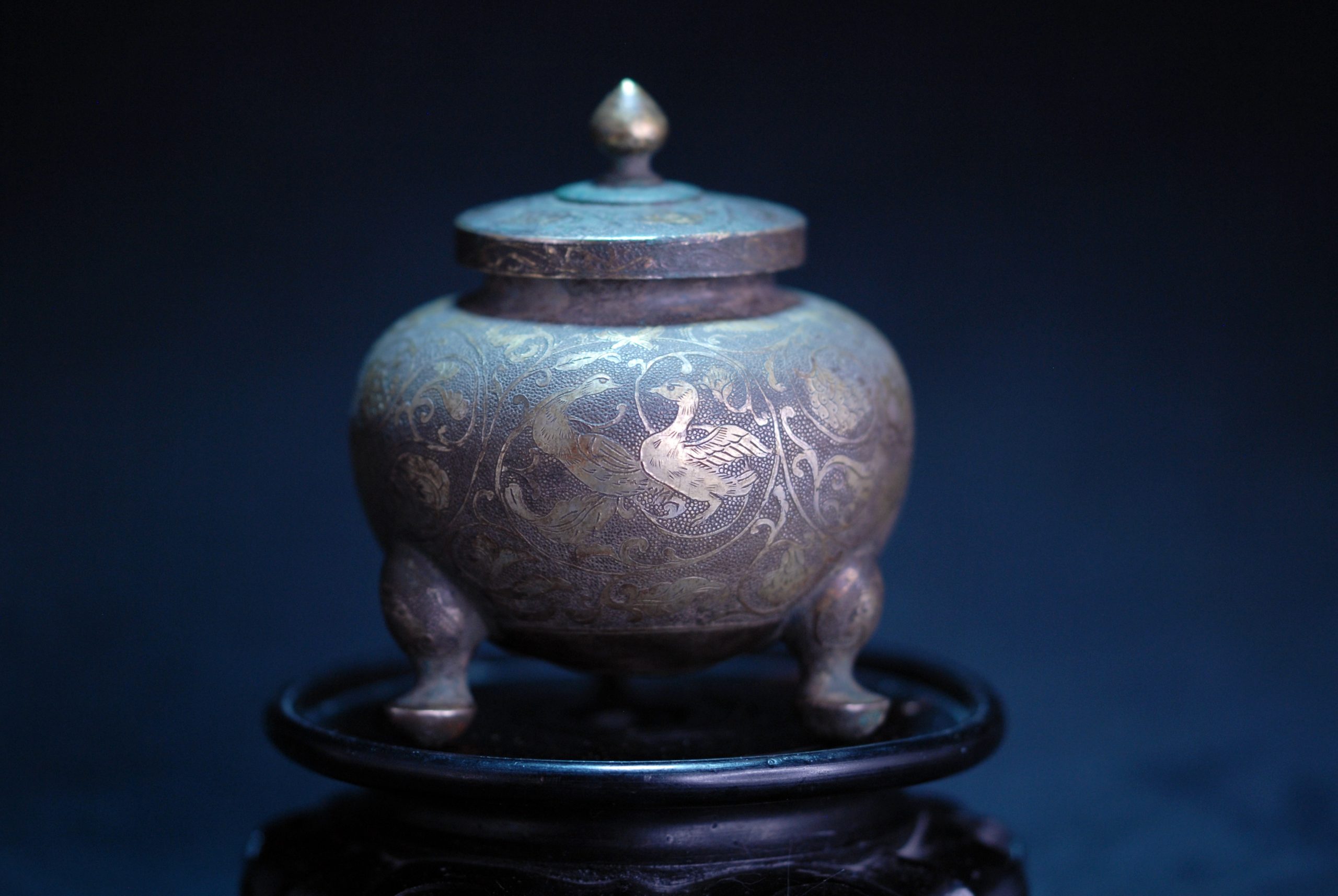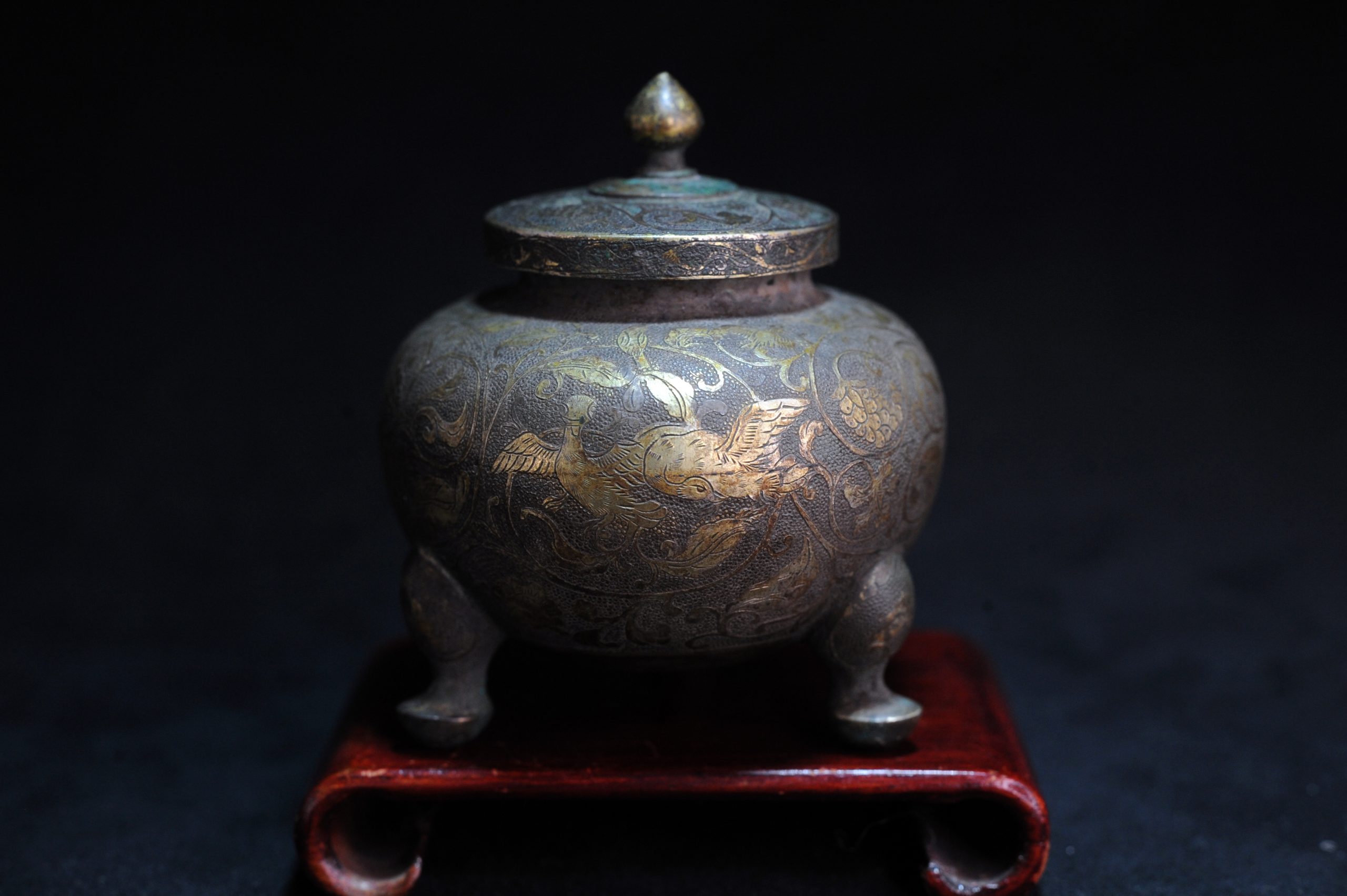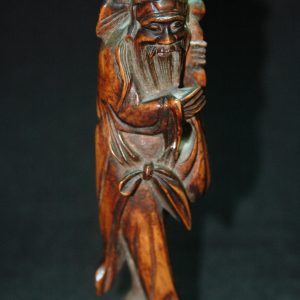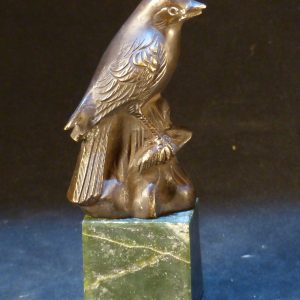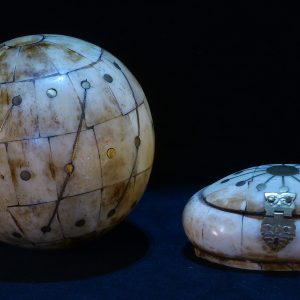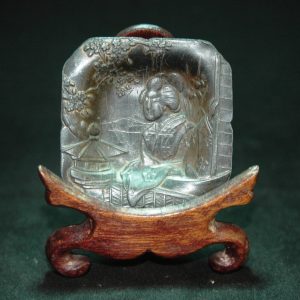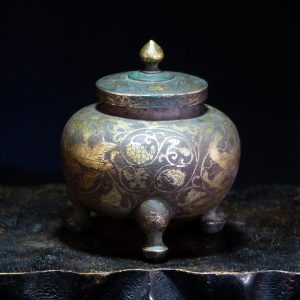Description
唐朝 錾花鸟纹鎏金三足圆银盖盒/银盖罐, 魚子紋,葡萄紋,大雁紋,鳥紋,忍冬紋,煉丹藥罐
唐朝 錾鸿雁葡萄纹鎏金养生丹药三足圆银盖盒/银盖罐
High: 3.5 in (8.8cm)
Width:3.5 in
盒是唐代器皿中数量最多、延用时间最长的器类之一。被泛称为盒的器物, 大小、形制差异很大, 形制之别是因在日常生活中的用途不同, 但一般都具有可以开启、分为上下两部分的共同特征。根据出土时的情况, 可知盒用于盛装食品、药材、化妆品或其他物品, 有的还兼作陈设之用。
参考:嘉德2016 春季拍賣
觀古 – 瓷器珍玩工藝品
1112 唐 銀製走獸紋蓋罐
Tang Dynasty (618-907)
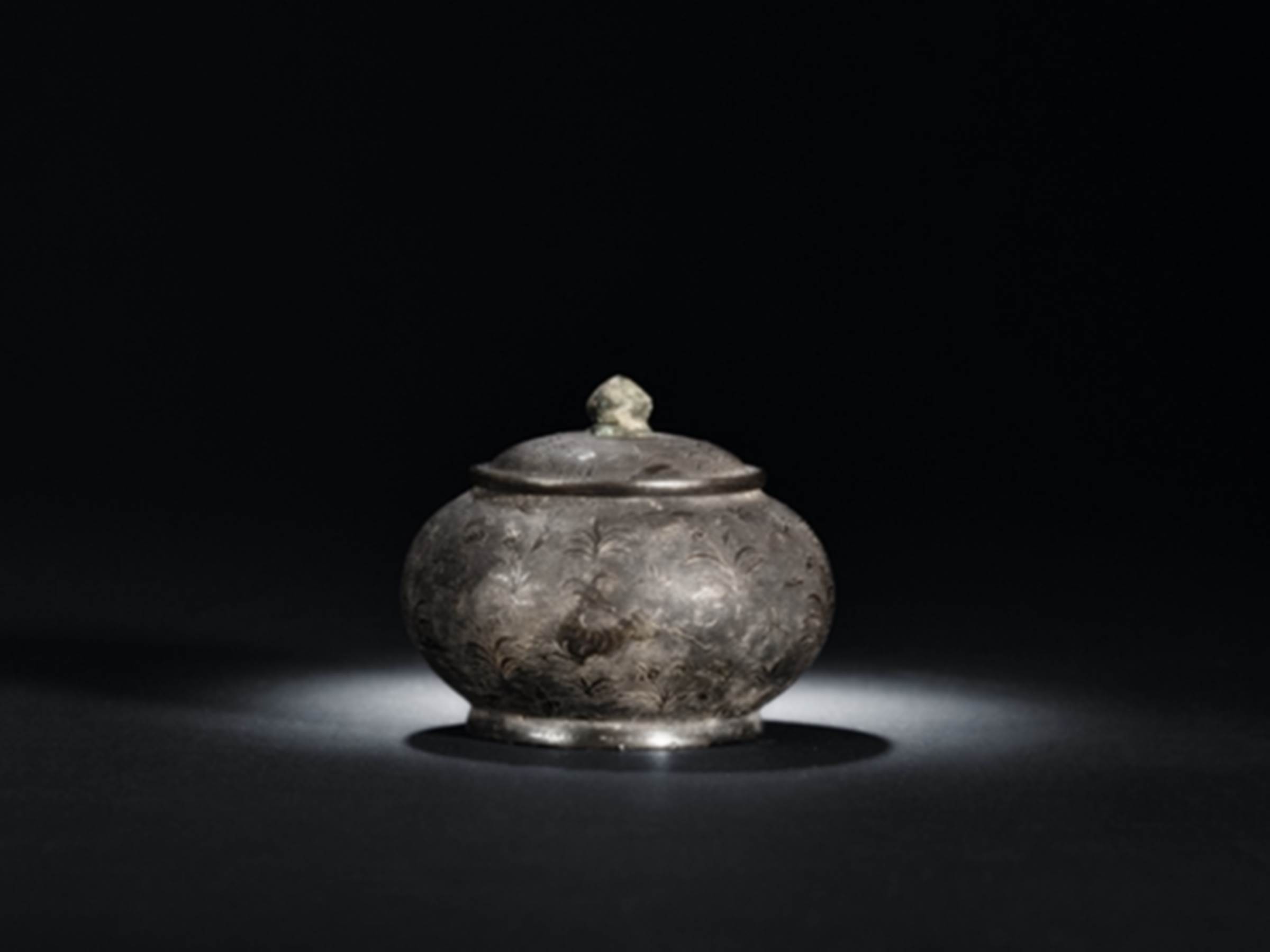
估價 : HKD: 80,000-120,000 USD: 10,300-15,500
成交價: Withdrawn
7 cm. diam (2 3/4 in.)
銀質,短頸,鼓腹,通體鏨珍珠紋為地,腹部以走獸為主飾,體態輕盈,活潑生動,配以花卉,草本,蝴蝶,飛鳥等紋飾相間, 疏密有致,相得益彰;蓋帶寶珠鈕,弧面,方唇,珍珠紋為地,亦鏨以花卉,草本,蝴蝶等紋飾,與罐身相呼應。
唐代金銀器是古代工藝美術中絢麗的瑰寶,其製作加工技術精細巧妙,廣泛使用了錘擊、澆鑄、焊接、切削、拋光、鉚、鍍、鏨刻、鏤空等工藝。鏨刻利用金、銀、銅等金屬材料的延展性,在金屬板上加工出千變萬化的浮雕狀圖案。
参考:苏富比
Important Chinese Art
March 22, 01:01 PM PDT
PROPERTY OF A HONG KONG PRIVATE COLLECTOR
Lot 676
A small parcel-gilt silver ‘mandarin ducks’ jar, Tang dynasty
唐 銅局部鎏金鏨荷塘鴛鴦圖小罐
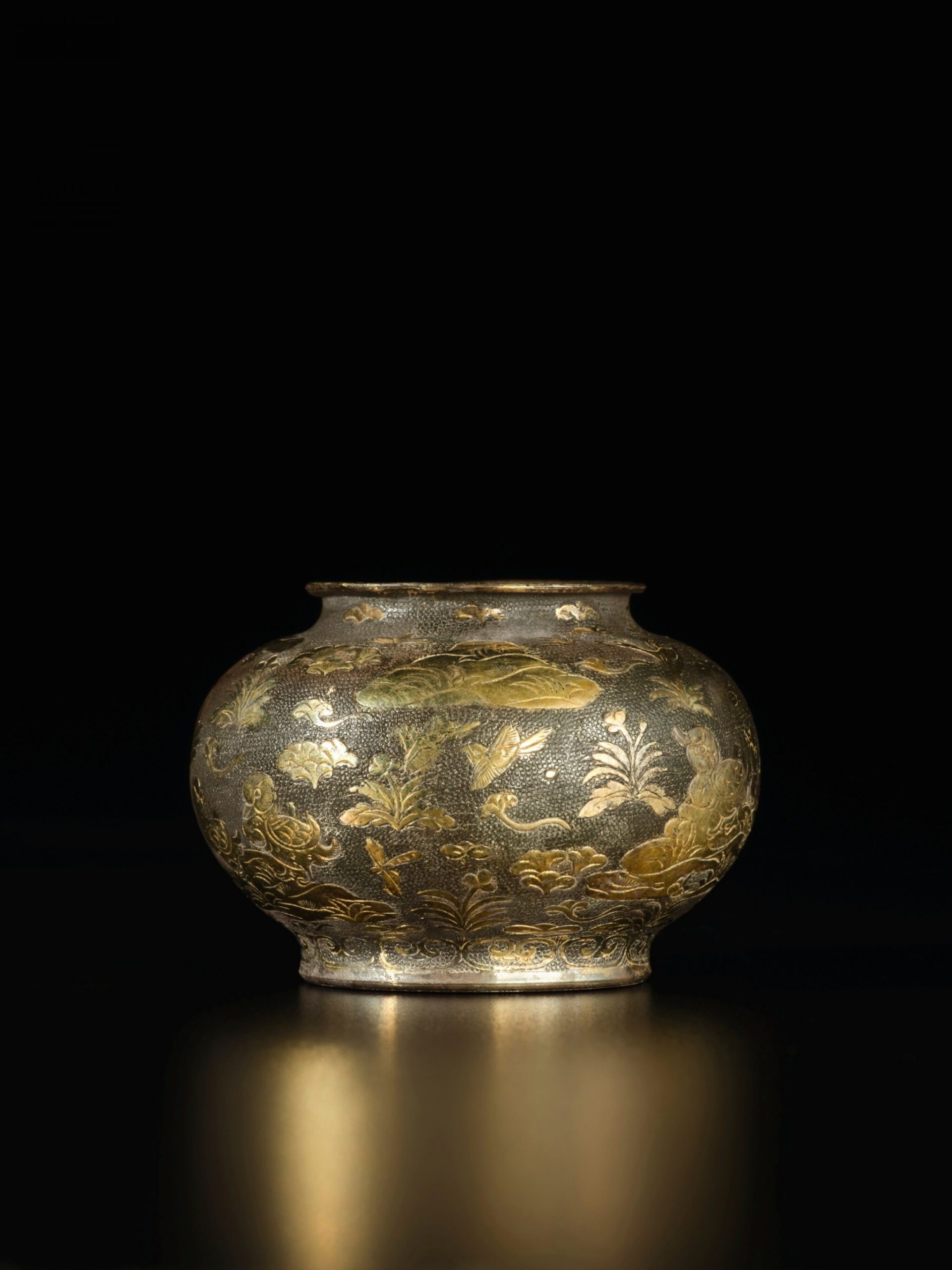
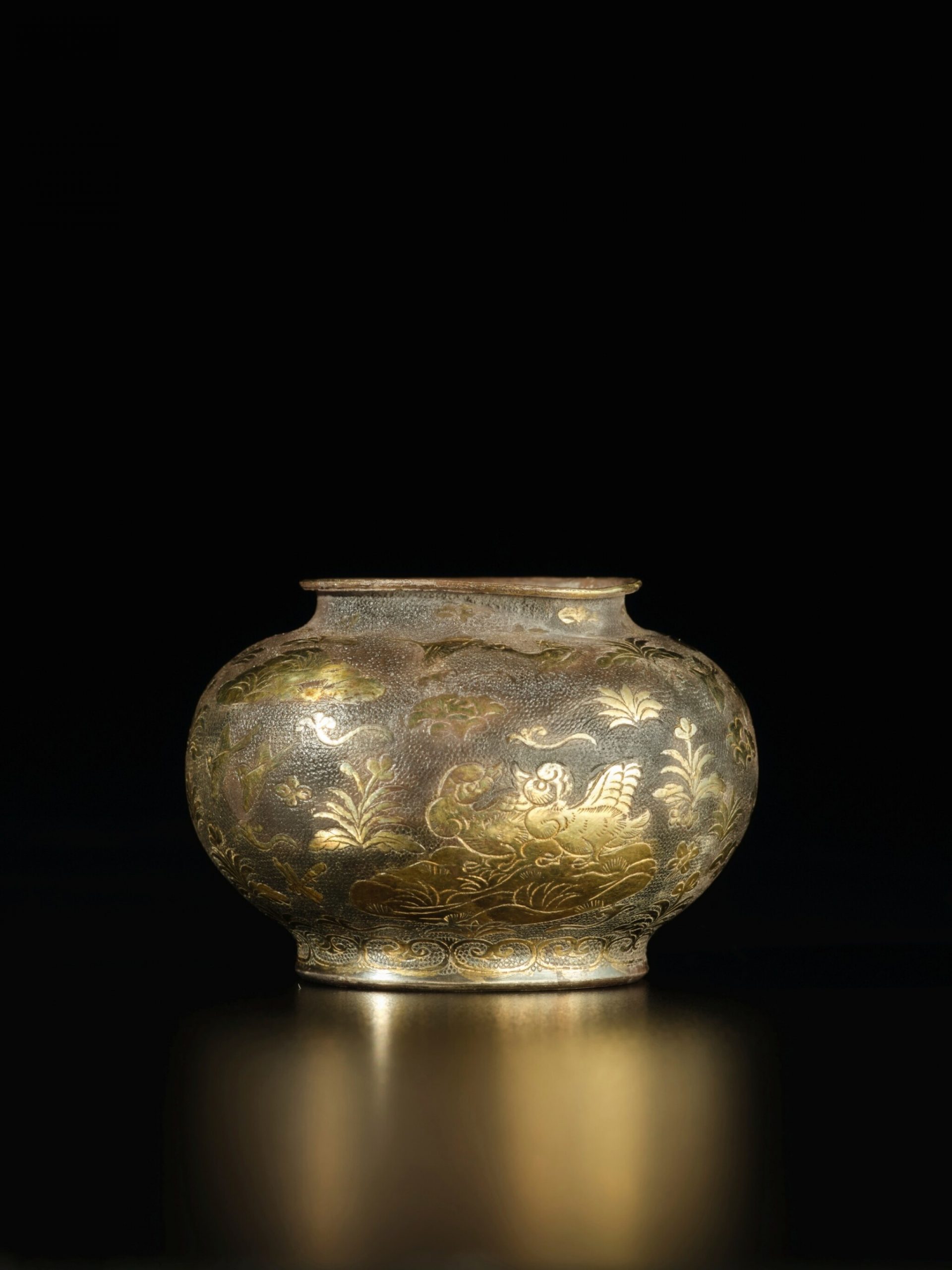
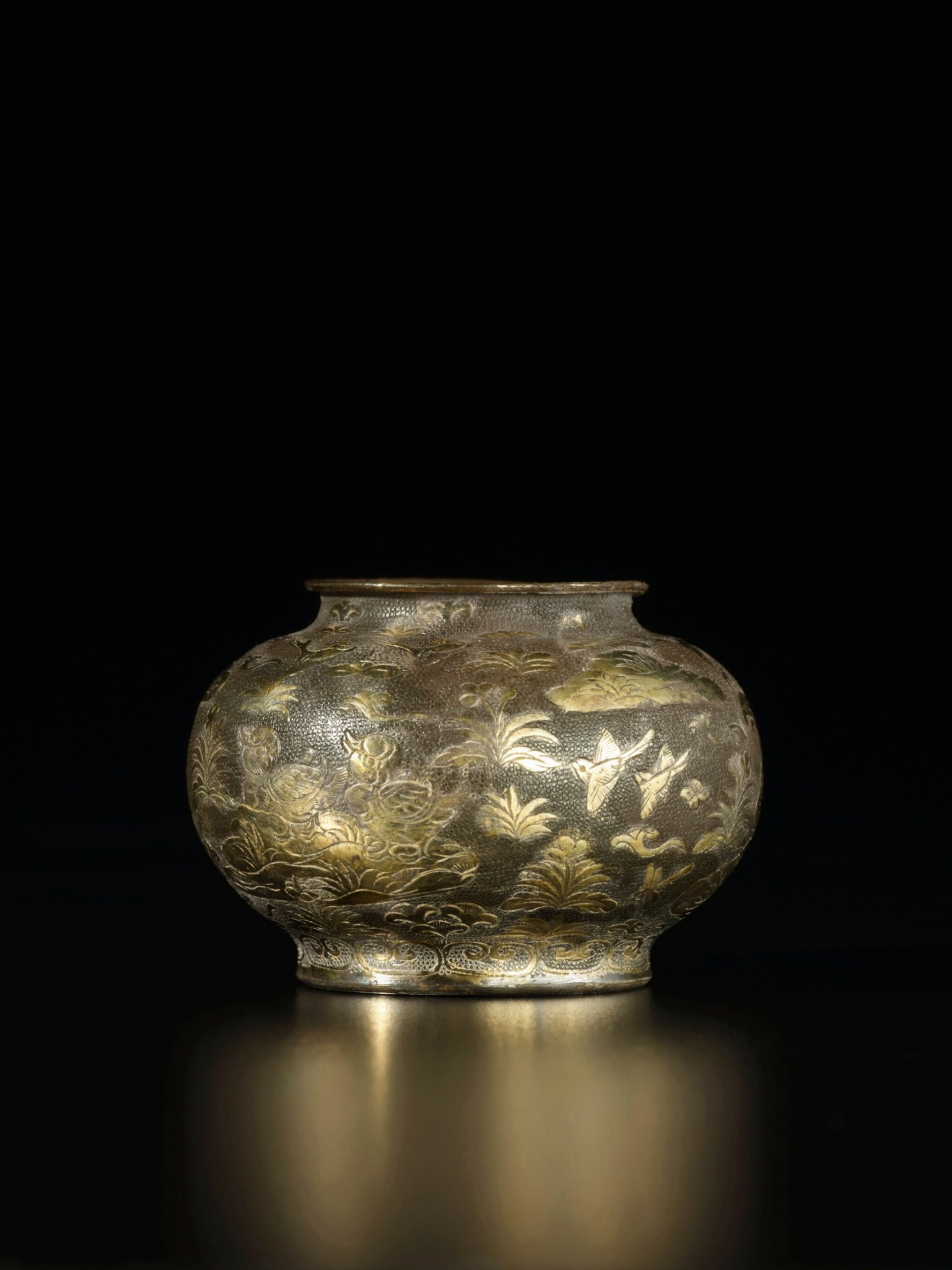
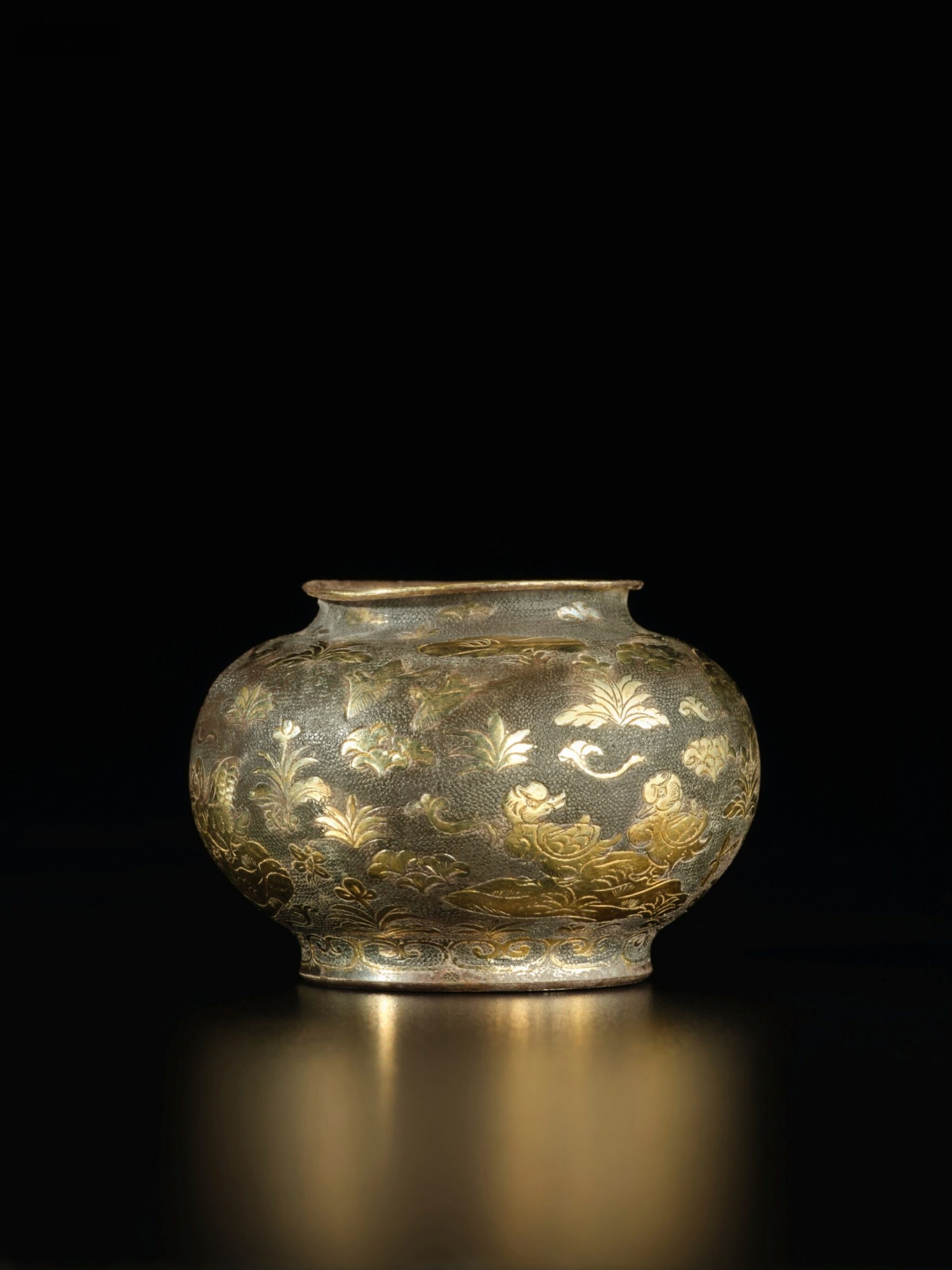
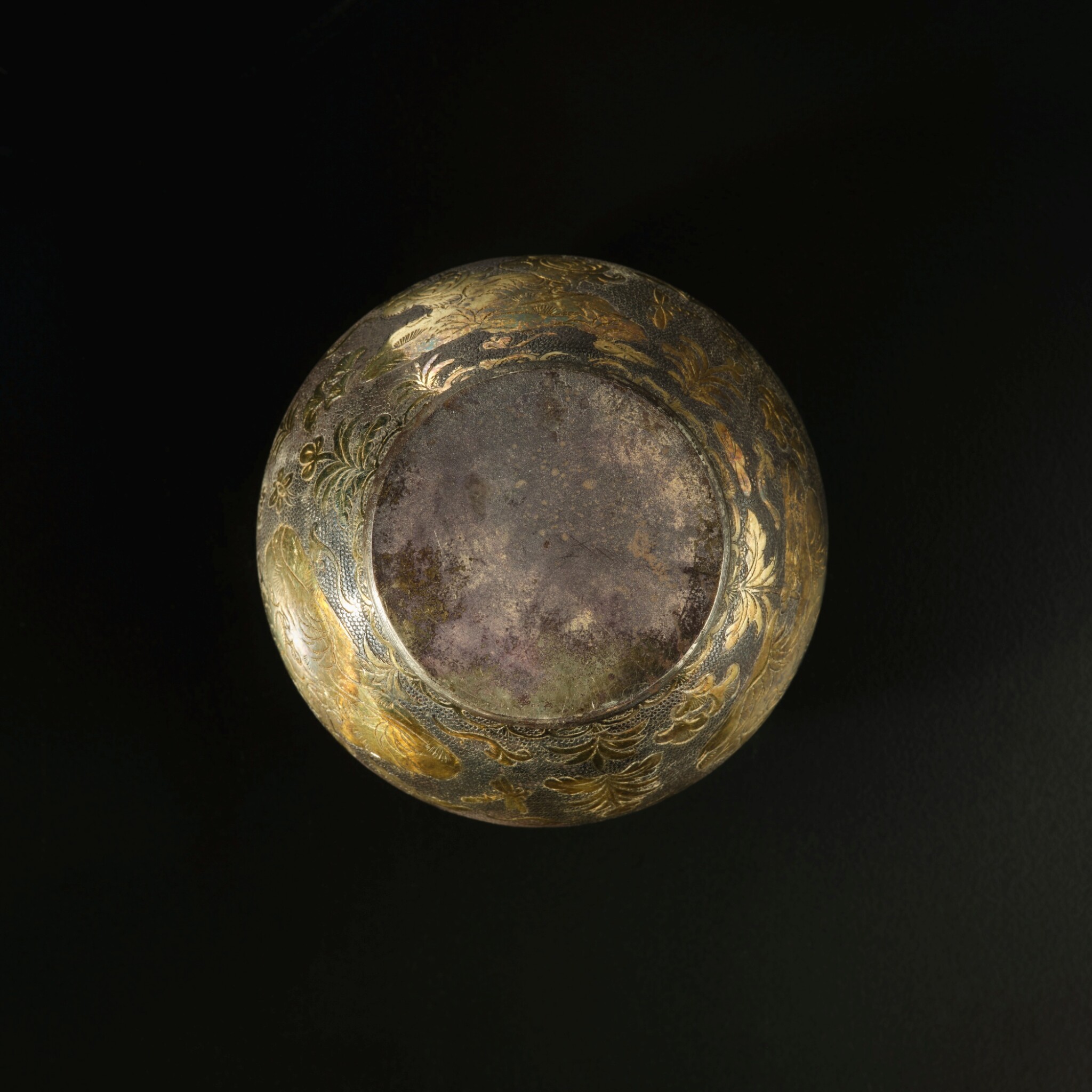
Estimate 8,000 – 10,000 USD
Lot Sold 10,160 USD
A small parcel-gilt silver ‘mandarin ducks’ jar
Tang dynasty
唐 銅局部鎏金鏨荷塘鴛鴦圖小罐
Diameter 2⅜ in., 6.3 cm.
Condition Report
In good condition with age-consistent surface wear and minor manufacturing imperfections.
品相良好,見正常表面磨損及少許微細原始瑕疵。
Provenance
Japanese Private Collection.
日本私人收藏
参考:嘉德
2017 秋季拍賣
觀古-瓷器珍玩工藝品
255 (Tang Dynasty(AD 618-907))
錯銀瑞獸花草紋水呈(唐)
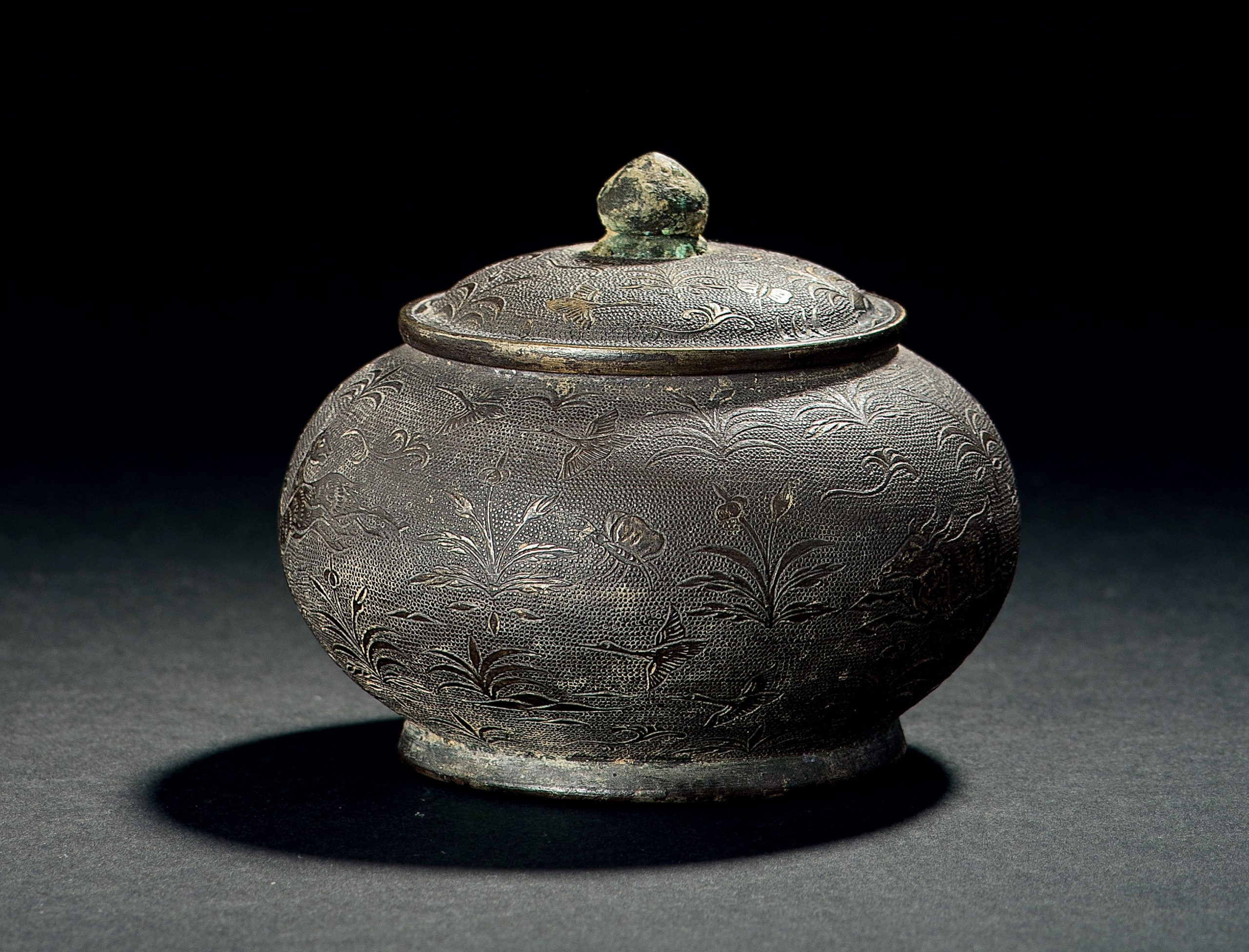
5.5 cm.(2 1/4 in.)high
鼓腹、圈足、配帶鈕圓蓋,水丞蓋、身均以錯銀法,飾瑞獸花草紋圖案,花草曲折勁挺,數片卷葉撑起花頭,穿插遮掩各具其妙,瑞獸奔于其間,富于動感。此水丞器物雖小雕刻却極到位,葉脉絲絲紋理、花瓣起伏曲折,瑞獸生動形象,品玩之趣倍生,頗具古意,讓人愛不釋手。
來源:20世紀90年代購于香港
估價 : HKD: 60,000 – 80,000 USD: 7,800 – 10,400
参考:唐遗宝 何家村 炼丹素面三足银罐
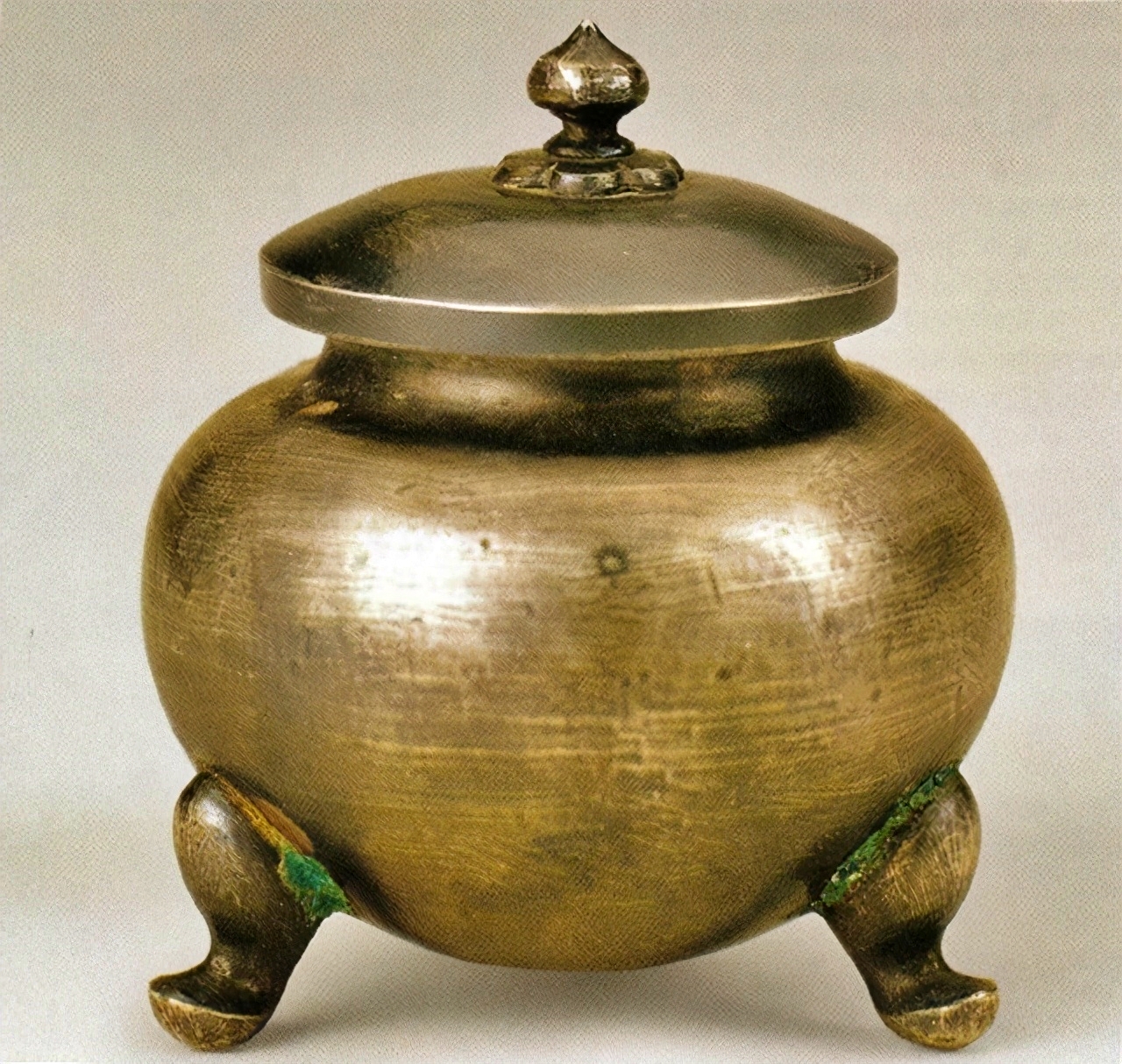
齐东方 北京大学考古文博学院教授、博士生导师。主要从事汉唐时期考古、历史、文物、美术教学与研究。
唐代不少皇帝和贵族热衷于服食丹药,也许能与一些器物联系起来。何家村遗宝中有素面平底银罐、素面圈足银罐、素面三足束腰形银罐、素面三足银罐。形态上是唐代常见的器型,在玉石、陶瓷以及壁画石刻中也能见到,但形体通常都很大。唐开元六年(718年)韦顼墓石椁线刻图中,有一侍女手捧三足罐,实物和从图像比例上看应该是一般生活用具,可何家村这几件银罐体态很小,器高分别是3.5~4.65厘米。共同特点是都有盖,扣合得非常紧密,子母口严丝合缝,似乎连空气都无法进入,以至于时隔一千余年后内壁的银白色仍然铮亮如新。毫无疑问,它们的用途特殊,也许就是盛装与炼丹有关的药物,因为方士们认为将炼丹原料盛放在金银器里面,会沾染上金银之气,能巩固和提高药效。
崇拜炼丹养生的观念增进了人们神秘的幻想,会以巨大的热情和精神动力制作如此精致器物。小罐的制作难度很大,带三足的小银罐,焊接的缝隙出现许多绿锈,应是用锡、铅和铜为主合成焊药焊接,日久腐蚀后就会出现绿锈痕迹。法门寺银盐台上錾刻“小药焊”三字,说明唐代的焊接技术,有大焊、小焊,区别是焊药不同。这几件小巧玲珑的器物本身似乎也增添了灵异的感觉。
参考:苏富比
14 五月 2008 • 倫敦
拍賣編號: L08211 中国古代金银器瓷器
Masterpieces of Chinese Precious Metalwork,
Early Gold and Silver;
Early Chinese White, Green and Black Wares
拍品 63 唐 鎏金银盖罐
A FINE PARCEL-GILT SILVER JAR AND COVER TANG DYNASTY
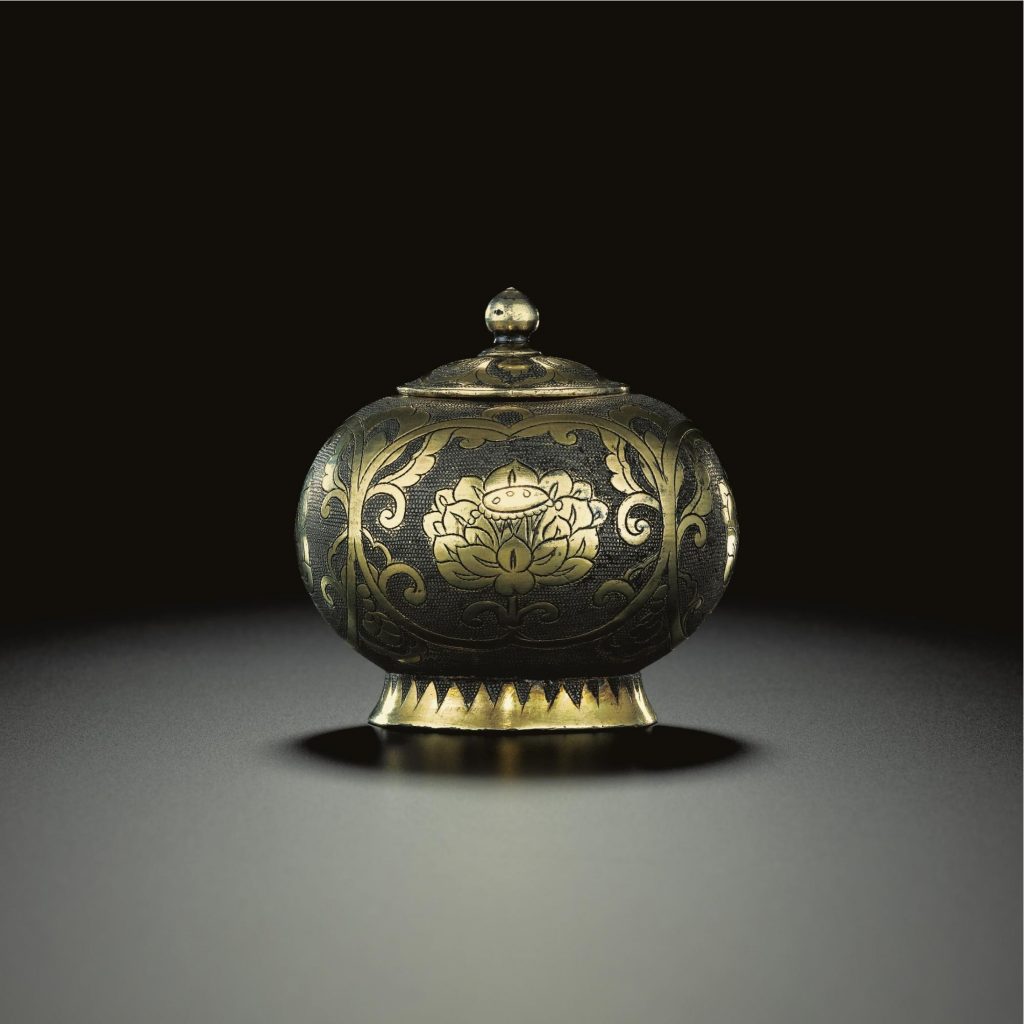
估價 10,000 – 15,000 GBP
已售出 50,900 GBP
描述
6.5cm., 2 1/2 in.
WEIGHT 136g.
the stout globular body supported on a short splayed footring and covered with a circular, slightly conical lid surmounted by a bud-shaped knop, the body decorated with a finely chased and parcel-gilt design of four medallions formed by interlinked scrolls, each enclosing a fully open lotus flower, all reserved against a finely ring-punched ground, the cover similarly decorated with a six-petaled flowerhead encircling the central knob, a band of chased and parcel-gilt chevrons adorning the footring
展覽
Chinese Gold and Silver in the Carl Kempe Collection, Smithsonian Institution, Washington, D.C., 1954-55, cat. no. 93.
Chinese Gold, Silver and Porcelain. The Kempe Collection, Asia House Gallery, New York, 1971, cat. no. 41, an exhibition touring the United States and shown also at nine other museums.
出版
Bo Gyllensvärd, Chinese Gold and Silver in the Carl Kempe Collection, Stockholm, 1953, pl. 93.
Bo Gyllensvärd, ‘T’ang Gold and Silver’, Bulletin of the Museum of Far Eastern Antiquities, no. 29, 1957, figs. 34a, 85b.
R. Soame Jenyns & William Watson, Chinese Art. The Minor Arts, London, 1963, pl. 21.
Chinese Gold and Silver in the Carl Kempe Collection, The Museum of Art and Far Eastern Antiquities in Ulricehamn, Ulricehamn, 1999, pl. 95.
參考: 蘇富比
Important Chinese Art including Imperial Jades from the De An Tang Collection
13 October 2021 HKT • Hong Kong
3678 唐 銀局部鎏金鏨花鳥紋三足蓋罐
A rare parcel-gilt silver tripod vessel and cover Tang dynasty
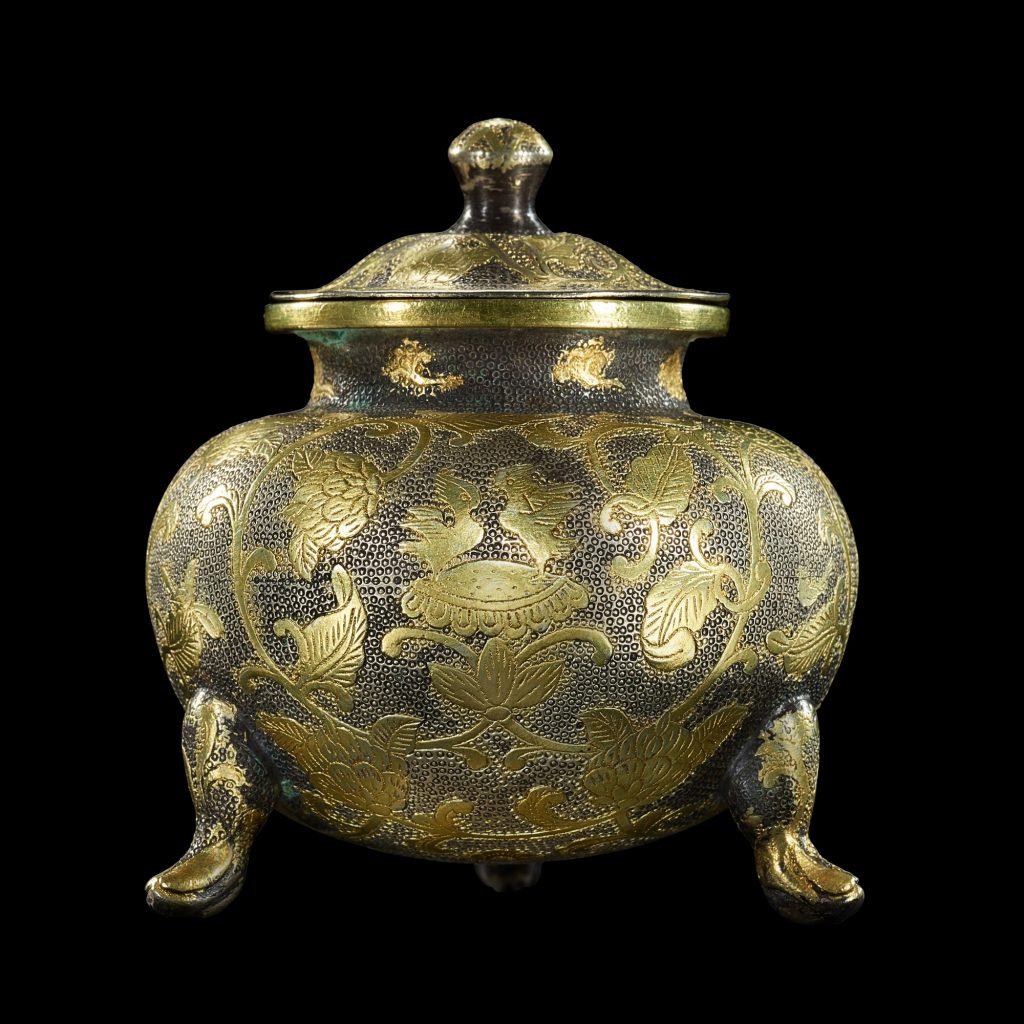
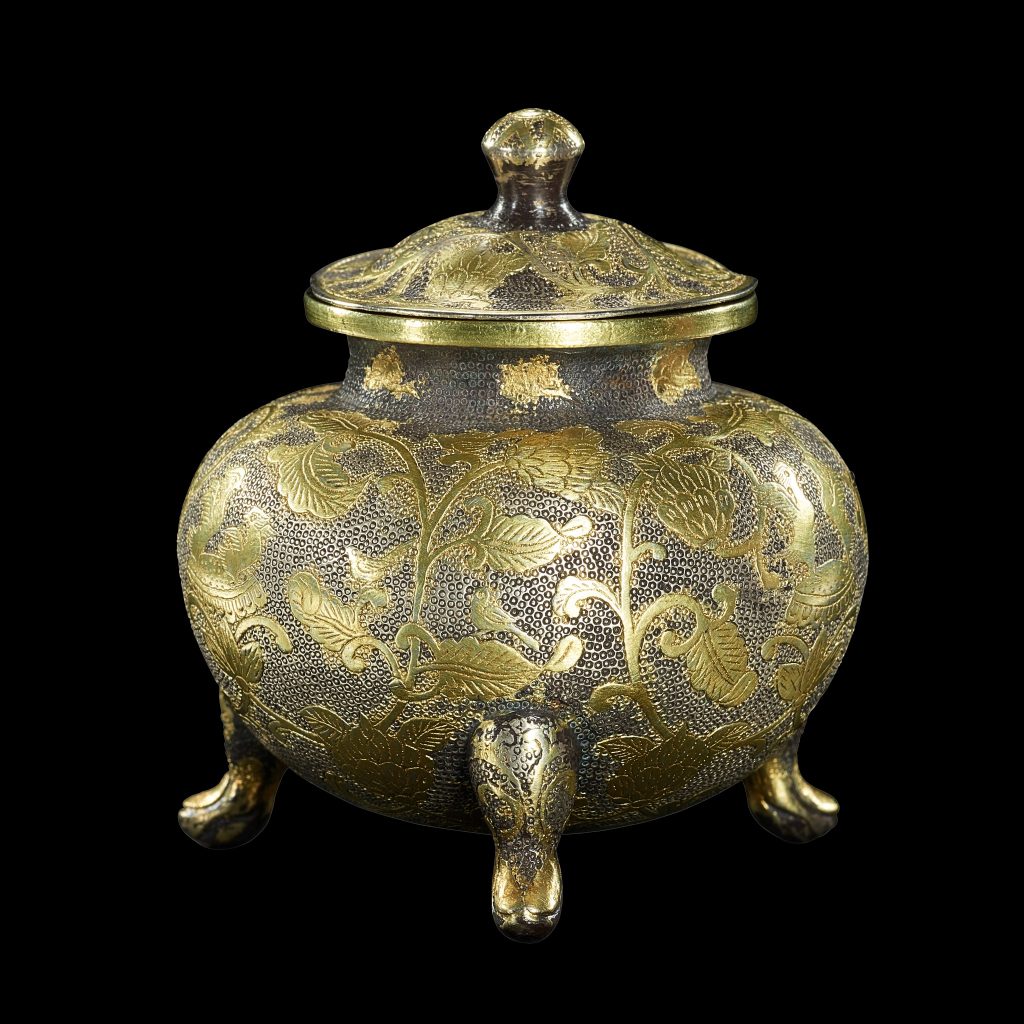
Estimate: 400,000 – 600,000 HKD
Description
A rare parcel-gilt silver tripod vessel and cover
Tang dynasty
唐 銀局部鎏金鏨花鳥紋三足蓋罐
cast with an almost spherical body resting on three cabriole legs, exquisitely gilt-decorated with birds and foliate scrolls against a ring-punched ground, the well-fitted cover similarly decorated and surmounted with a bud-shaped finial
h. 6.5 cm, w. 6 cm
Provenance
Susan Chen, Hong Kong, 23rd April 1993.
陳淑貞,香港,1993年4月23日
Catalogue note
It is rare to find a Tang parcel-gilt silver tripod vessel with such finely detailed decoration, preserved in good condition with original cover. It is closely related to another vessel complete with its cover in Xian, illustrated in Han Wei and Christian Deydier, Ancient Chinese Gold, Paris, 2001, p. 161, no. 390. A smaller Tang parcel-gilt tripod jar, but lacking its cover, was sold at Christie’s New York, 20th September 2013, lot 1466.
参考:
中國嘉德(香港)國際拍賣有限公司
2021 春季拍賣
觀古II — 金石文房藝術
1103 純銀錯金唐葷紋(寶相花)粉盒



4.8 cm. (1 7/8 in.) diam.
粉盒小巧可人,圓餅形,純銀所制,底蓋子母口扣合。上下雙面均鏨刻紋飾,內裡素面無紋。中心稍微隆起,蓋面以魚子紋為地,錯金飾寶相花紋,空間填蔓草,紋飾飄逸靈動。盒身側面魚子紋地上,刻飾纏枝紋,線條流暢。盒是目前唐代金銀器皿中數量最多、沿用時間最長的器類。折枝花草、寶相花、纏枝卷草等植物紋樣是唐代器物的主要紋樣。拍品刻花處均錯金,光彩奪目,工藝精湛,精巧玲瓏,華麗盡顯。
來源:香港私人收藏,2000年前購入,保存至今
估價 : HKD: 80,000 – 120,000 USD: 10,300 – 15,500
成交價: HKD: —
参考:日本 美穗美术馆 Miho Museum
Chinese Silver Gilt Lidded Tripod Vessel, Tang Dynasty, Late-7th-8th century C.E. Silver gilt, H. 5.2 cm.
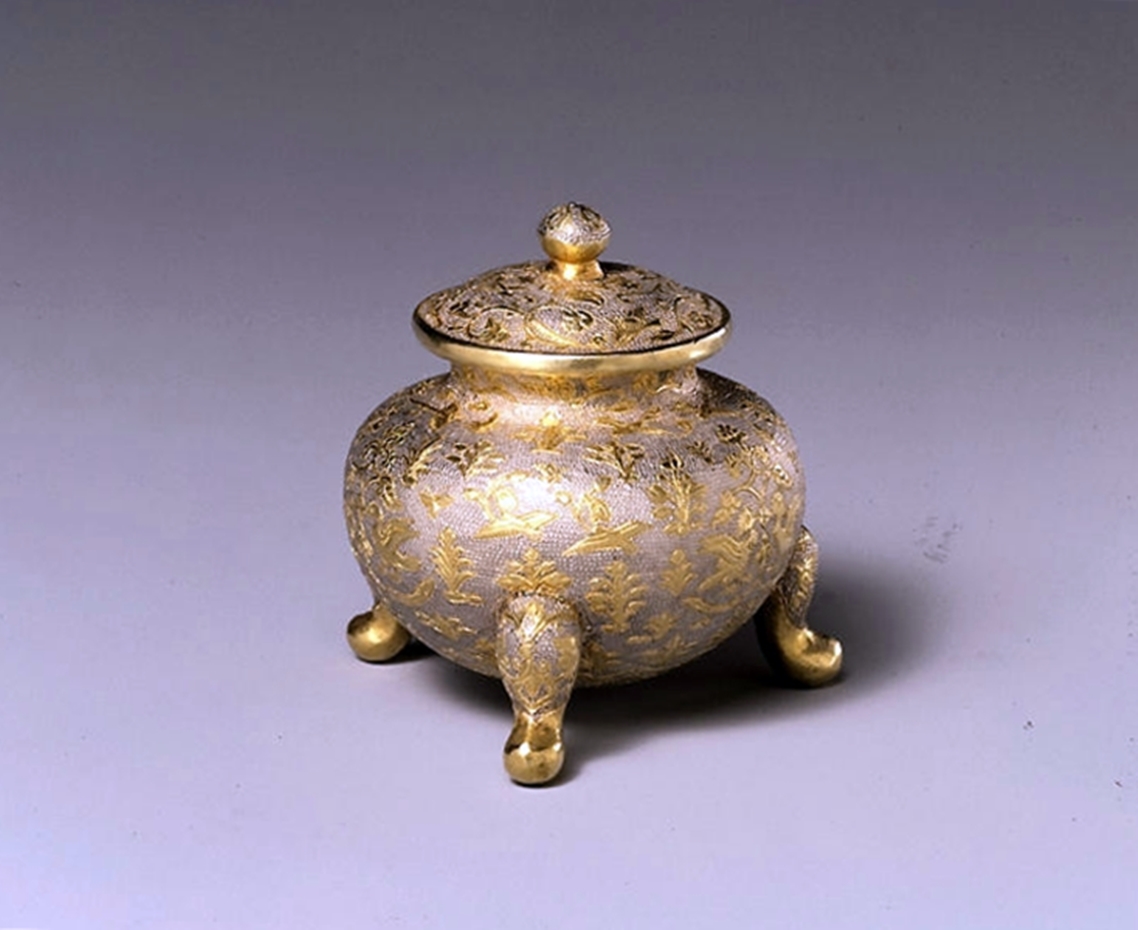
Bronze tripod vessels were originally used for rituals during the Shang ( 1500-1028 B.C.) and early Western Zhou (1027-771 B.C.) dynasties. By the Spring and Autumn period (771-476) such vessels, at times featuring lids, had become more utilitarian. During the Warring States period (475-221 B.C.), some tripods began to feature purely decorative patterns, and by the Han dynasty (206 B.C.-A.D. 220), tripod lacquerware was popular as well. However, it was not until the Tang dynasty (A.D. 618-907) that miniature tripods, fashioned out of precious gold and silver, were created solely as decorative objects of art.
The body of the small Shumei tripod was initially fashioned out of a disc of silver that was hammered into a globe form with a flared lip.1 A smaller circular silver disc was then hammered into a convex lid. The lid finial and the three tripod legs were cast in silver before being soldered on. The exterior surfaces of the vessel and lid were then hammered to a smooth finish to prepare them for decoration. The central section of the tripod body features a pair of swallows holding auspicious plants, as well as two mandarin ducks and twin parrots, among tree of life designs and scattered smaller floral motifs. The lid, too, has bird and floral designs, and the entire base of the tripod body is patterned with a central, curvilinear rosette motif.2 A metalsmith painstakingly traced all motifs onto the tripod and lid surface with a series of single chisel punches (as opposed to using a chasing technique which would have resulted in motifs with continuous fluid lines). The tripod’s pictorial composition is complemented by a low, ring-matted background. The bird, flower, and rosette motifs on the body are gilded, as are the lower portions of each leg, the rim of the lid, and the lower portion of the lid’s final.
The pair of swallows holding floral twigs in their beaks is a variation of a popular Persian and Sogdian motif. Symbolizing imperial power, success, and good fortune, this Near Eastern motif, often placed within a roundel with a pearl border, was commonly used to pattern polychrome silk collars and sleeve trim as well as the bodice sections of garments.3 Referred to in Tang-period texts as “swallow with ribbons in its bill” or “pheasant with auspicious plants in its bill,” this motif appears in China on textiles from the fifth to the eighth centuries and, by the Tang period, was being patterned onto silver as well.4
A tripod similar to the Shumei example was unearthed from a suburb of Xi’an; another tripod with Confucian scenes was excavated from Beiyin village.5
JMS
1. Technical information courtesy of Pieter Meyers and Richard H. Kimball
2. On the evolution of the rosette motif in Chinese textiles see Segraves 1996a, pp. 54-62. For about the tree of life motif see cat. no. 133, n.5.
3. Zhong guo Zangxui 1996.1, pp. 3-26; O’Neill 1982, p. 168, pl. 107.
4. The well-known archaeologist Xia Nai coined the expression “standing bird” or linao to describe this motif. In some Near Eastern versions the bird appears to be holding a necklace. Based on excavated textiles and wall paintings, this motif can be dated to the fifth-eighth centuries A.D. in Kucha and Baicheng in Xinjiang and Bamiyan in Afghanistan. Textiles with this motif that date from the seventh to the eighth centuries have also been found in Tibetan graves in Dulan Xian in Qinghai province. Initially, this bird motif symbolized royal power, but was later its incorporated into Buddhism and came to represent rebirth. See Zhong guo Zangxui 1996.1, pp. 3-26.
5. Gong and Han 1993, pl. 89; Wenwu 1996.1, pl. 4.
A tripod similar to the Shumei example was unearthed from a suburb of Xi’an; another tripod with Confucian scenes was excavated from Beiyin village.5
JMS
参考:中贸圣佳国际拍卖有限公司 SUNGARI
集萃—古董珍玩专场 June 7, 2019
明 款识: 閊云山作 错银三足水盂
Ming Dynasty
A SILVER INLAID TRIPOD COPPER WASH
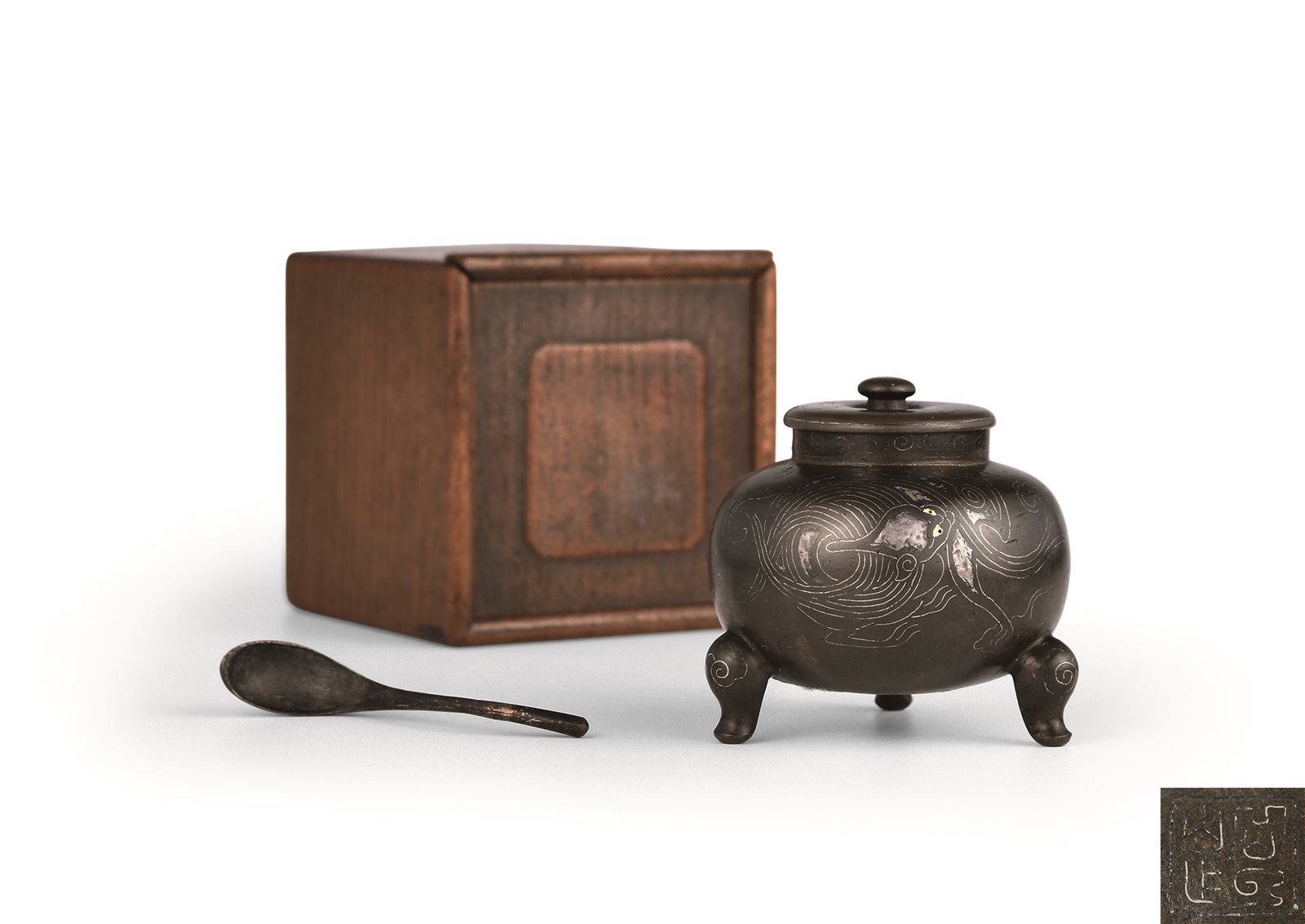
水盂是贮砚水的小盂,为文房用品。该水盂圆直口,丰肩,鼓腹,下承三足。带盖和勺。外壁用错金银工艺,整体纹饰由极细银丝镶嵌,简洁流畅,工整致密。外底有错银丝款。
H: 5.2cm
RMB: 70,000-80,000
参考:鎏金春秋人物三足银罐(陕西历史博物馆藏)
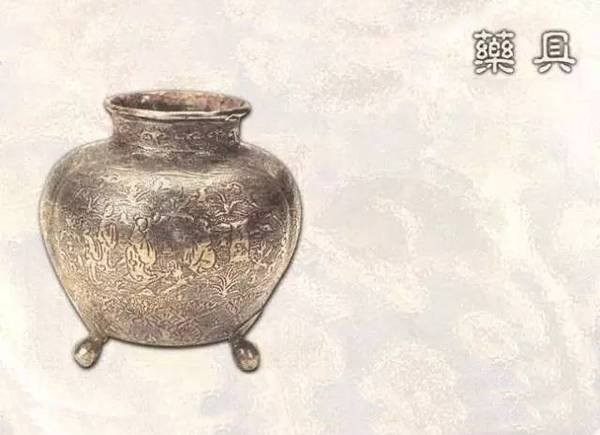
腹圆鼓,分三曲。腹部纹饰分为上下两层:下层排列忍冬花纹图案,上层錾刻春秋人物图画,衬以流云萱草,并有”子路”、”论语法·灵公问政”、”少正卯”等题榜。在所有唐代金银器中,此银罐可算是最具思想性的一件。这大概与唐文宗提倡儒教及武宗灭佛后人们对孔子和儒教的尊崇有关。
参考:西安唐代65號墓 折枝花草和飞鸟銀盒
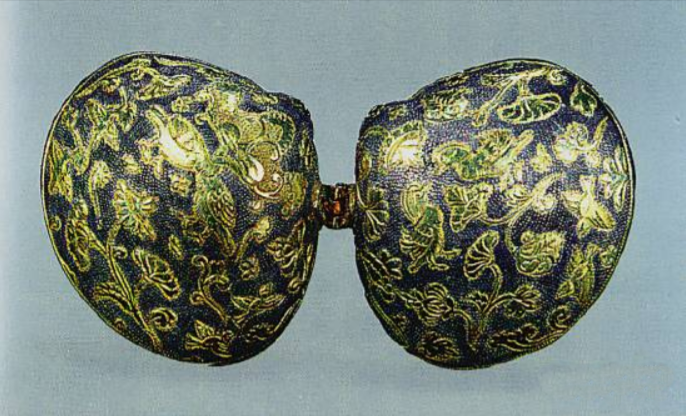
1989年陕西西安市东郊发掘的唐墓中,出开元六年(公元718年) 墓志的65号墓出土1件贝壳形银盒[ 4], 直径2.9 ~ 3.4厘米, 器表以珍珠地为衬, 一面主题为一对鸳鸯, 周饰折枝花草和飞鸟, 另一面为折枝花草和飞鸟, 器物外表通体鎏金
参考:西泠印社2013年春季拍卖会
萃古熙今·文房古玩专场(13春拍)
364明或更早·银鎏金珍珠地花鸟纹碗
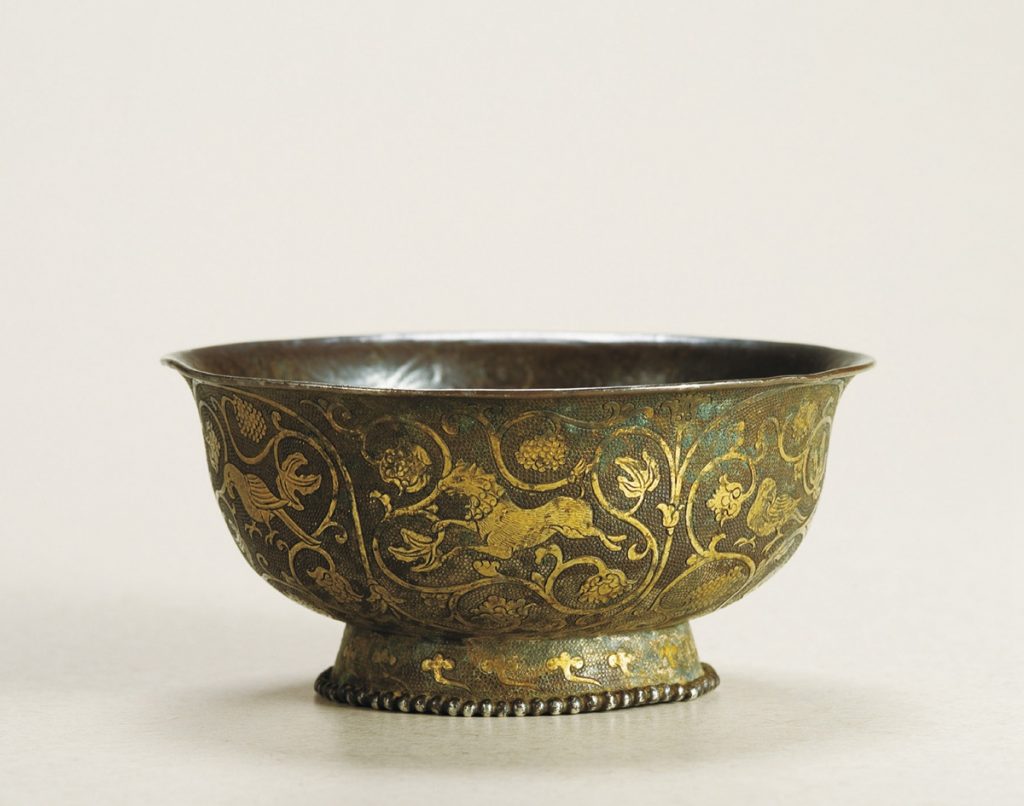
估价RMB: 20,000-40,000
成交价RMB: 40,250(含佣金)
说明:金银器在历史文物中占有重要位置,是中国传统文化艺术的重要载体。金银制品在商代即已出现,春秋战国时代已有金银镶嵌工艺。金银器皿出现较晚,汉以前少见,至唐代由于波斯的影响,有了极大发展。明清以来,金银器多以唐代为本制作。此件银碗口沿外侈,碗身饱满,圈足外撇,碗身以精细的线条錾刻出缠枝花卉,中间有麒麟、鸾凤、天马、锦鸡等祥瑞,足部为祥云纹带,底部亦满工刻花卉飞鸟,通体辅以珍珠纹为地。碗心繁花居中,足底一圈有联珠纹。所有花卉处皆鎏金装饰,形成黄白对比的效果,工艺繁复,精美绝伦。
MING DYNASTY OR EARLIER A GILT SILVER BOWL WITH FLOWER AND BIRD PATTERNS
高:4.7cm 口径:10.2cm
参考:鎏金飞鸿折枝花银蚌盒(陕西省考古研究所藏)
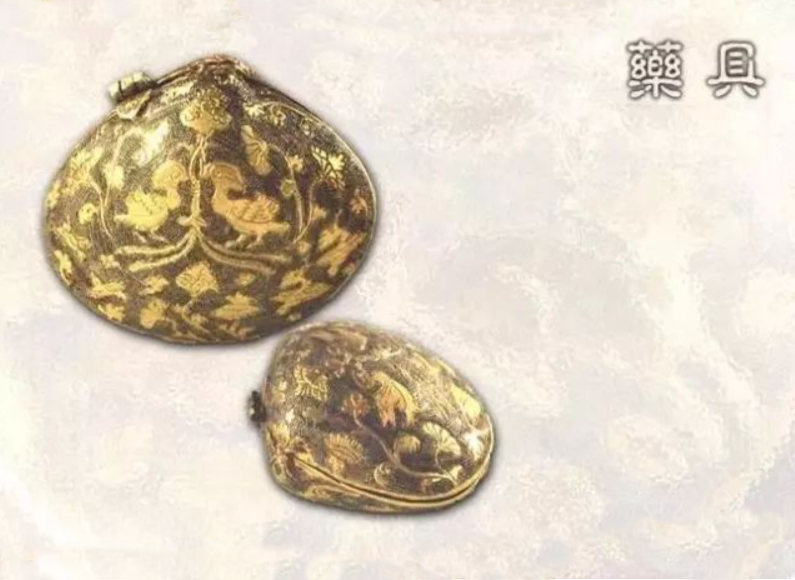
唐 韋美美墓鎏金飛鴻折枝花銀蚌盒
陝西省考古研究所藏
盒為鎏金銀質,形狀與天然蚌殼完全相同,兩面以合頁相連。正反兩面均鏨有圖案。一面為交頸飛鴻、鵲鳥,配以折枝花、石榴花結,一面為相對鴛鴦,配以折枝花、飛鴻等。
盒为鎏金银质,形状与天然蚌壳完全相同,两面以合页相连。正反两面均錾有图案。一面为交颈飞鸿、鹊鸟,配以折枝花、石榴花结,一面为相对鸳鸯,配以折枝花、飞鸿等。此盒的出土对于唐代金银器的断代研究和唐史的研究都具有一定的参考价值。
参考:苏富比 227
瓊肯:中國高古藝術 II
2019年9月10日 | 下午 2:00 EDT
紐約
唐 金屬鎏銀鏨荷蓮鴛鴦紋臥足盌

50,000 — 70,000美元
拍品已售 62,500 美元 成交價 (含買家佣金)
拍品詳情
唐 金屬鎏銀鏨荷蓮鴛鴦紋臥足盌
來源
史蒂芬•瓊肯三世(1978年逝)收藏
相關資料
本盌造工精緻,紋飾細膩,實乃唐代藝匠製作金屬器之臻例。器型及紋飾相近之例極為罕見,比較一銀鎏金盌,器型及尺寸相同,唯飾鸚鵡鴛鴦紋, 何家村出土,曾展於《花舞大唐春:何家村遺寶精粹》,陝西歷史博物館,陝西,2003年,編號69。
另比一例,尺寸稍大,飾各式動物紋飾,出自Carl Kempe收藏,曾展於《Chinese Gold, Silver and Porcelain. The Kempe Collection》,華美協進會,紐約,1971年,編號45,後售於倫敦蘇富比2008年5月14日,編號44。亦可比較一例,銀鎏金盌,平底,口沿外撇,側面飾蓮紋,盌心飾一對瑞獅,曾展於《文化大革命期間出土文物》,卷1,北京,1973年,頁55;再比一例,尺寸稍大,飾靈獸及鳥紋,售於紐約蘇富比1984年12月4日,編號69。
参考: 佳士得拍賣 12175
中國瓷器及工藝精品
紐約|2016年9月16日
拍品1223|PROPERTY FROM A PRIVATE AMERICAN COLLECTION
遼 銀鎏金龍鳳紋蓋盒
LIAO DYNASTY (AD 907-1125)
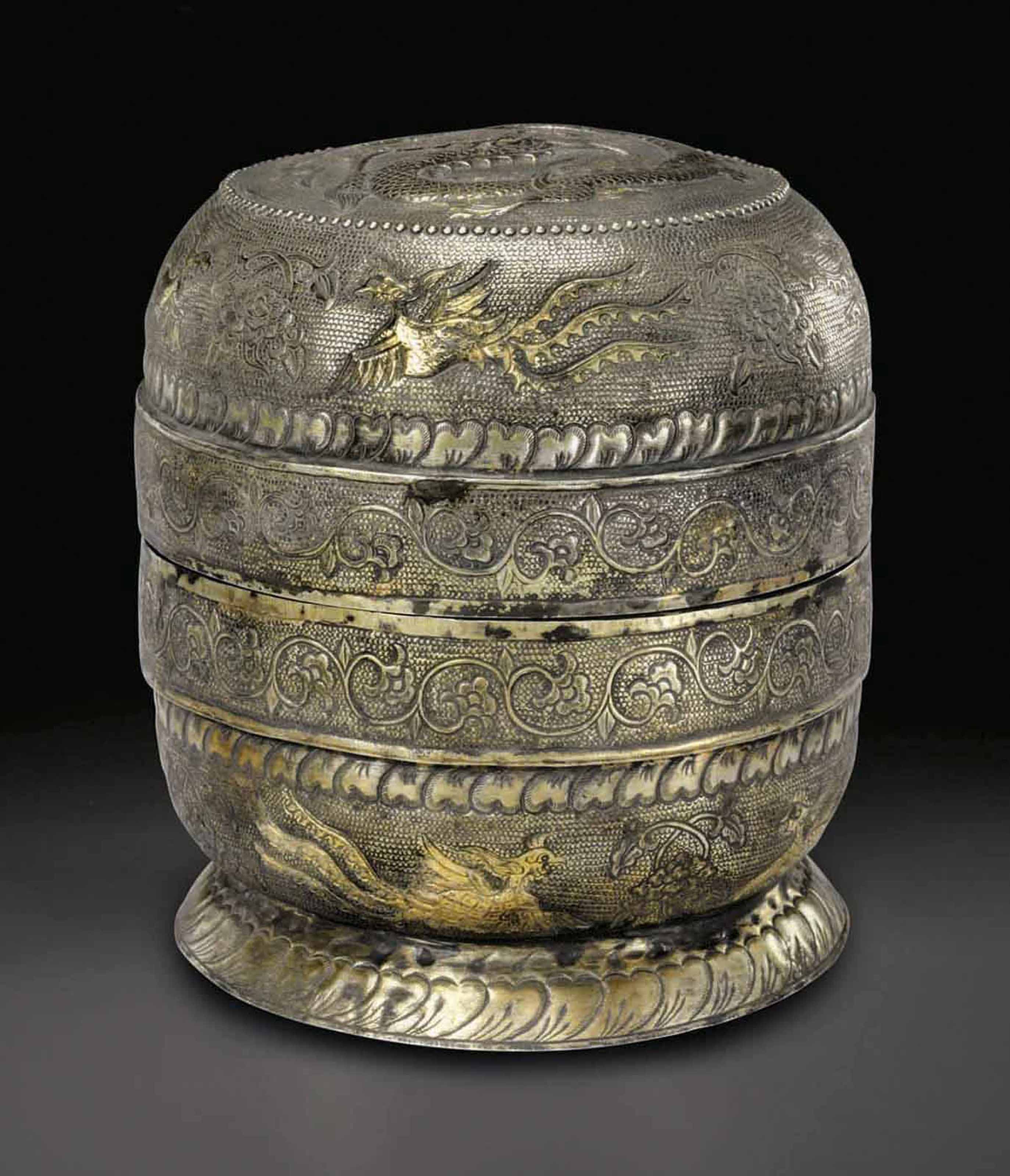
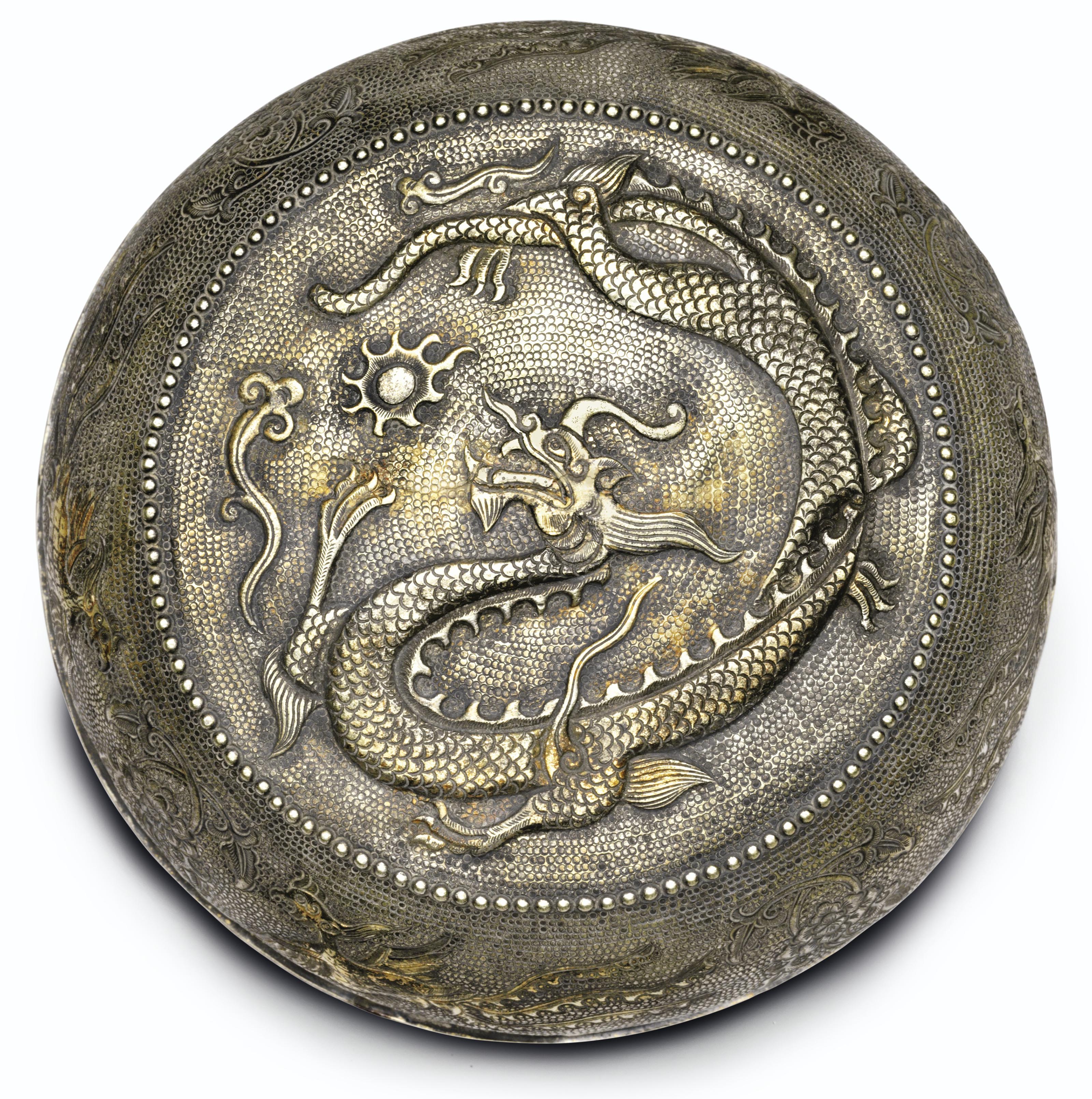
成交總額 USD 11,250
估價 USD 15,000 – USD 20,000
遼 銀鎏金龍鳳紋蓋盒
5 in. (12.7 cm.) diam.
來源
Acquired in Indiana in the mid-1950s and thence by descent within the family.
拍品專文
Silver boxes of the present form and decoration are extremely rare. Compare a parcel-gilt silver box and cover of smaller size and with ‘bird and flower’ decoration, illustrated in The Great Treasury of Chinese Fine Arts-Arts and Crafts, vol. 10: Gold, Silver, Glass and Enamelware, Beijing, 1987, p. 32, pls. 66 and 67. It is interesting to note that the form and design of Liao silver wares can also be found in Five Dynasties and early Northern Song ceramics. Compare a Yue box of similar form, but with lotus motif, sold at Christie’s New York, 15 September 2009, lot 321.
PROPERTY FROM A PRIVATE AMERICAN COLLECTION
参考:佳士得
拍賣 18338
金紫銀青 – 中國早期金銀器粹珍
紐約|2019年9月12日
拍品600 唐 銀刻卷草花果紋高足盃
TANG DYNASTY (AD 618-907)
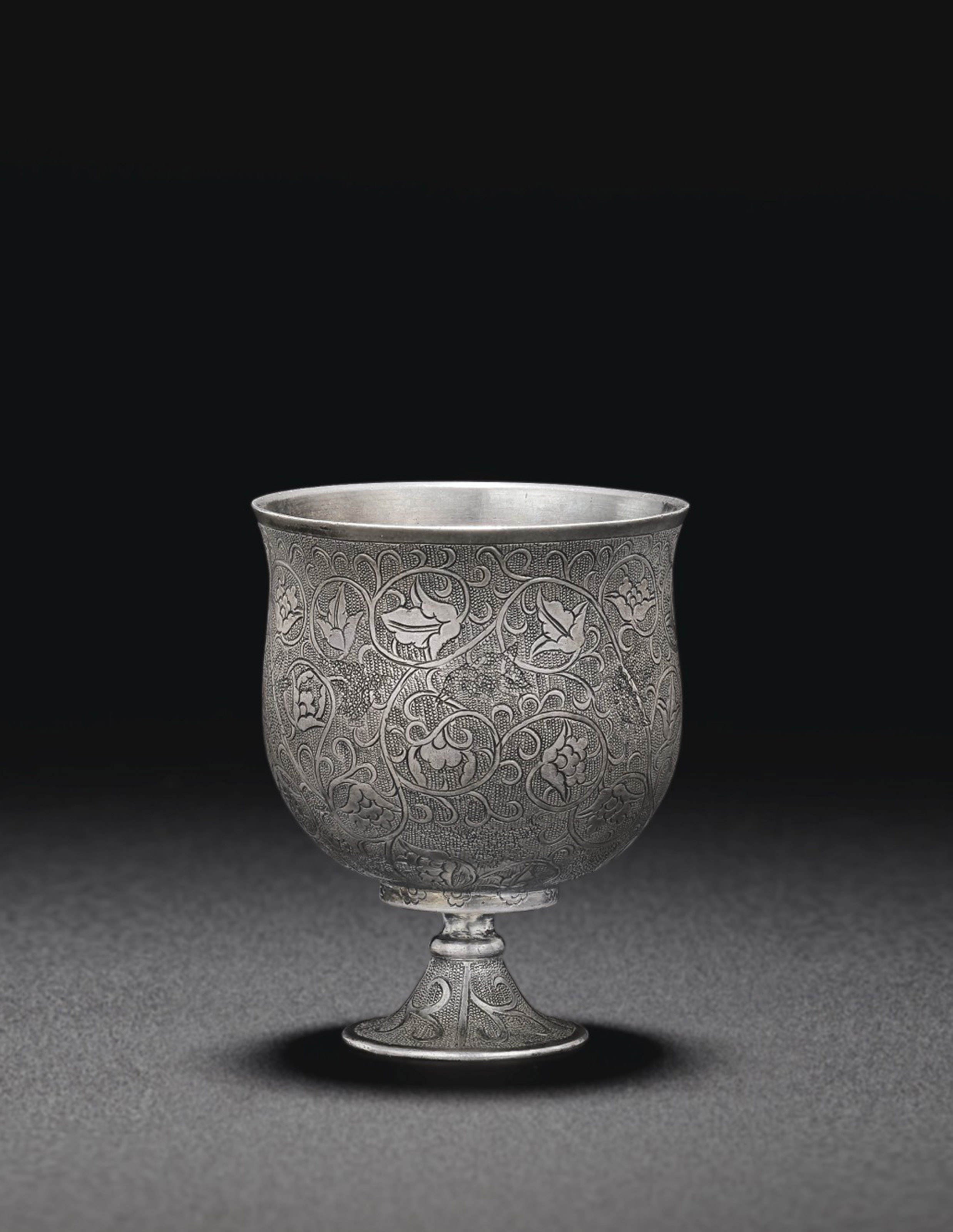
唐 銀刻卷草花果紋高足盃
成交總額 USD 52,500
估價 USD 10,000 – USD 15,000
唐 銀刻卷草花果紋高足盃
2 3/8 in. (6 cm.) high; weight 47.7 g
來源
Dr. Johan Carl Kempe (1884-1967) Collection, Sweden, before 1953, CK103.
Sotheby’s London, Masterpieces of Chinese Precious Metalwork. Early Gold and Silver, 14 May 2008, lot 66.
文獻及展覽
文獻
Bo Gyllensvärd, Chinese Gold and Silver in the Carl Kempe Collection, Stockholm, 1953, cat. no. 103.
Bo Gyllensvärd, ‘T’ang Gold and Silver’, Bulletin of the Museum of Far Eastern Antiquities, No. 29, Stockholm, 1957, fig. 25e.
Han Wei, Hai nei wai Tangdai jin yin qi cui bian, [Tang Gold and Silver in Chinese and overseas collections], Xi’an, 1989, pl. 44.
Chinese Gold and Silver in the Carl Kempe Collection, The Museum of Art and Far Eastern Antiquities in Ulricehamn, Ulricehamn, 1999, pl. 105.
展覽
Washington, D.C., Smithsonian Institution, Chinese Gold and Silver in the Carl Kempe Collection, 1954-55, cat no. 103.
拍品專文
The goblet shape of this stem cup appears to be very rare. Another cup of this shape with similar decoration in the Yamato Bunkakan, Nara, Japan, is illustrated by Qi Dongfang, Tangdai jin yin qi yan jiu (Research on Tang gold and silver), Beijing, 1999, pl. 2, and again in a line drawing, p. 41, fig. 1-54. The flowers and leaves appear similar to those on the present cup, and one can see in pl. 2 that there are birds in flight amidst the scrolling vine, however they are chased or engraved and not ring-punched as they are on the present cup.
参考:佳士得拍賣 18338
金紫銀青 – 中國早期金銀器粹珍
紐約|2019年9月12日
拍品550 唐 銀局部鎏金鏨刻蓮紋蓋罐
TANG DYNASTY (AD 618-907)
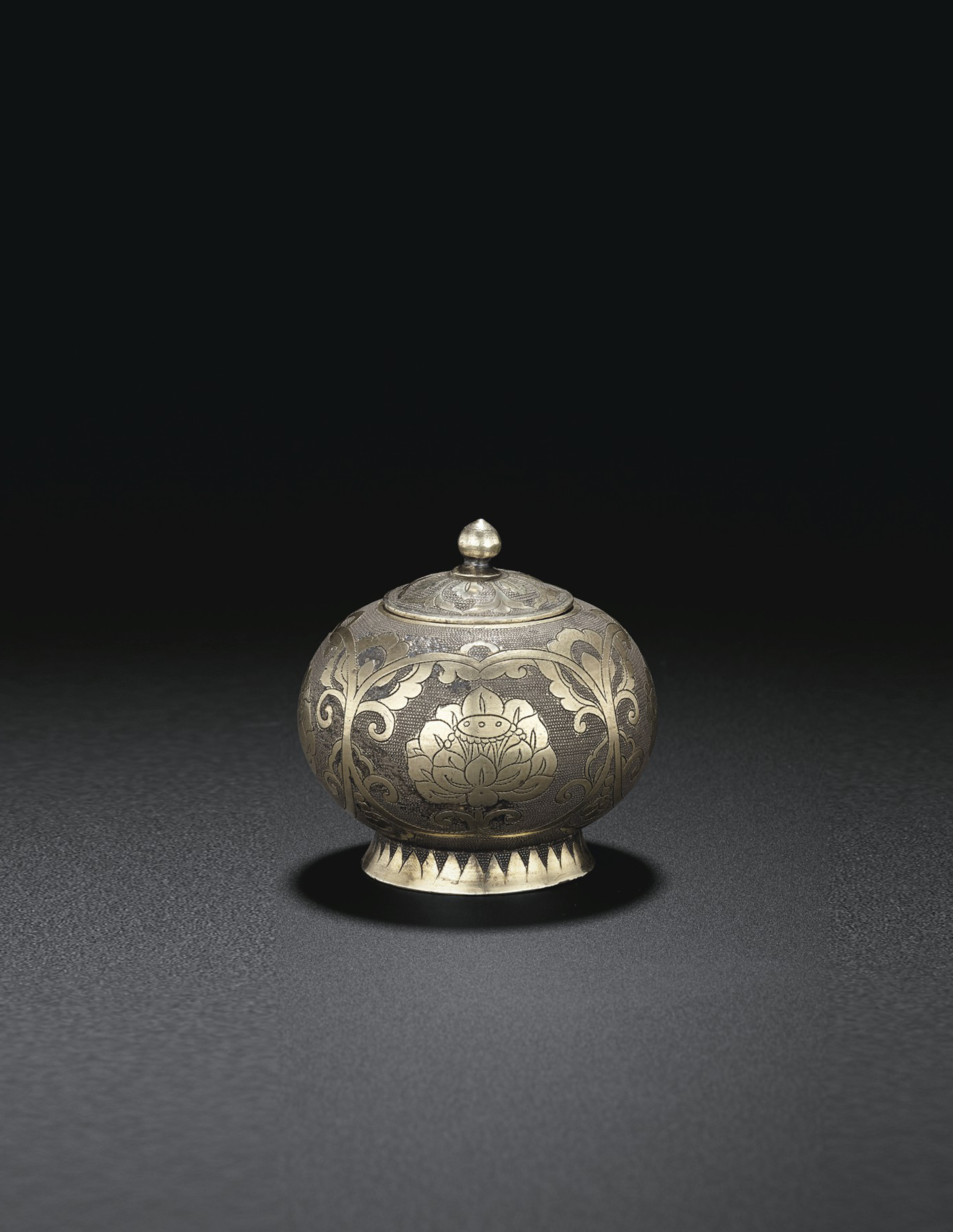
唐 銀局部鎏金鏨刻蓮紋蓋罐
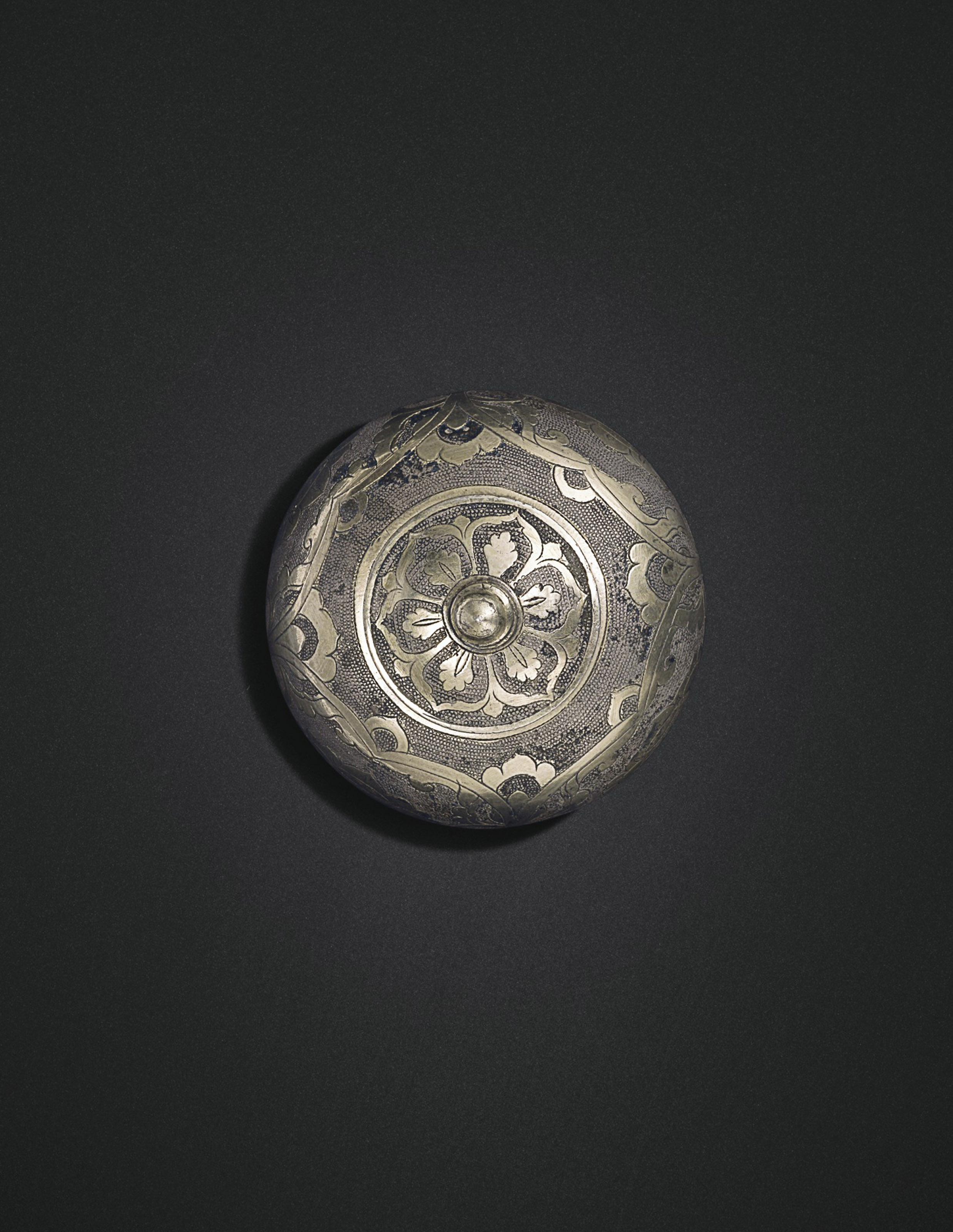
成交總額 USD 350,000
估價 USD 50,000 – USD 70,000
唐 銀局部鎏金鏨刻蓮紋蓋罐
2 ½ in. (6.5 cm.) high; weight 136 g
來源
C. T. Loo & Co., New York, before 1941.
Dr. Johan Carl Kempe (1884-1967) Collection, Sweden, before 1953, no. CK93.
Sotheby’s London, Masterpieces of Chinese Precious Metalwork. Early Gold and Silver, 14 May 2008, lot 63.
文獻及展覽
文獻
C. T. Loo & Co., Exhibition of Chinese Arts, New York, 1941, no. 182.
Bo Gyllensvärd, Chinese Gold and Silver in the Carl Kempe Collection, Stockholm, 1953, cat. no. 93.
Bo Gyllensvärd, ‘T’ang Gold and Silver’, Bulletin of the Museum of Far Eastern Antiquities, No. 29, Stockholm, 1957, figs. 34a, 85b.
R. Soame Jenyns and William Watson, Chinese Art. The Minor Arts, London, 1963, pl. 21.
Chinese Gold and Silver in the Carl Kempe Collection, The Museum of Art and Far Eastern Antiquities in Ulricehamn, Ulricehamn, 1999, pl. 95.
Qi Dongfang, Tangdai jin yin qi yan jiu [Research on Tang gold and silver], Beijing, 1999, pl. 87.
展覽
New York, C. T. Loo & Co. Exhibition of Chinese Arts, 1 November 1941-30 April 1942, no. 182.
Copenhagen, Dansk Kunstindustrimuseum, Kinas Kunst i Svensk og Dansk eje, 1950, cat. no. 192.
Washington, D.C., Smithsonian Institution, Chinese Gold and Silver in the Carl Kempe Collection, 1954-55, cat. no. 93.
New York, Asia House Gallery, Chinese Gold, Silver and Porcelain. The Kempe Collection, 1971, cat. no. 41, an exhibition touring the United States and shown also at nine other museums.
拍品專文
No other similar parcel-gilt jar appears to be published, but a plain silver jar and cover of this shape from the Hejiacun hoard is shown in a line drawing illustrated by Qi Dongfang, Tangdai jin yin qi yan jiu (Research on Tang gold and silver), Bejing, 1999, p. 100, fig. 1-280. The pleasing globular shape of these silver jars is more usually found in ceramic examples of Tang date, such as the sancai-glazed pottery jar and cover, the jar raised on a spreading foot, illustrated by Osvald Sirén, Kinas Konst under Tre Artusenden, Stockholm, 1942, p. 188, fig. 209; and another sancai-glazed pottery jar and cover illustrated in the catalogue for the exhibition, Zui to no bijutsu, Osaka Municipal Art Museum, 1976, p. 8, no. 1:25. Jars of this shape are often referred to as ‘apple’ jars. Another sancai-glazed pottery jar and cover of this shape, in the collection of Mr. and Mrs. Eugene Bernat, is illustrated in the exhibition catalogue, The Arts of the T’ang Dynasty, Oriental Ceramic Society, London, 1955, pl. 7b, no. 135. This jar is raised on an integral stand, but one can see that it has a circular foot. A Xingyao jar and cover, also in the Kempe Collection, illustrated by Bo Gyllensvärd in the exhibition catalogue, Chinese Gold and Silver and Porcelain, Asia House Gallery, New York, 1971, p. 92, no. 79, has the same shape, a low foot, and is incised on the sides with four large petals.
Please note that there is additional literature for this lot: D. Lion-Goldschmidt and J.-C. Moreau-Gobard, Chinese Art II: Gold, Silver, Later Bronzes, Cloisonné Cantonese Enamel, Lacquer, Furniture, Wood, Switzerland, 1966, p. 46, no. 21 (revised English edition 1980).
参考:佳士得
拍賣 2726 中國瓷器及工藝精品紐約
2013年9月19日 – 20日
拍品1466
PROPERTY FROM AN IMPORTANT JAPANESE PRIVATE COLLECTION
唐 鎏金花鳥紋三足小銀爐 TANG DYNASTY (AD 618-907)
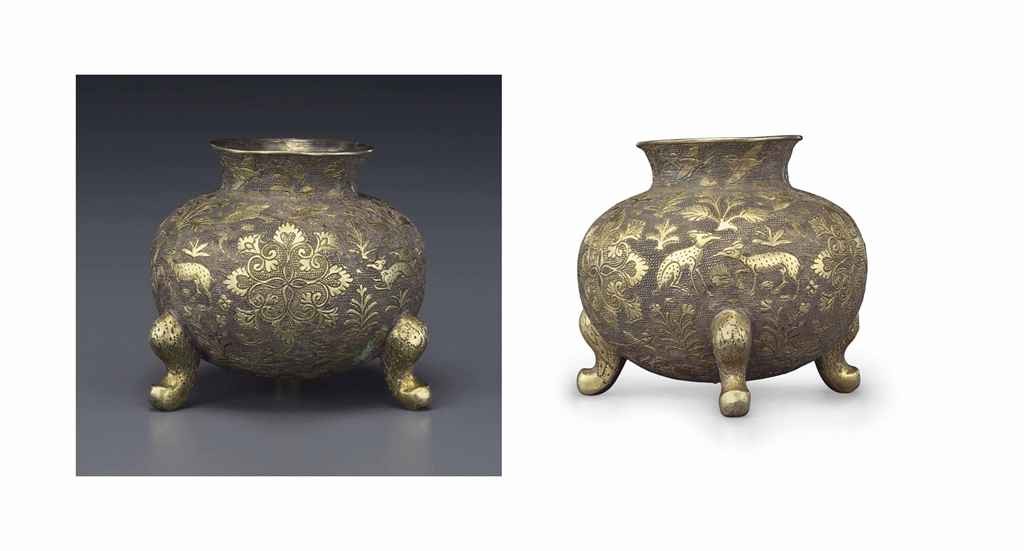
成交總額 USD 27,500
估價 USD 25,000 – USD 35,000
拍品專文
This rare miniature parcel-gilt silver tripod jar is similar to one with a cover, from Xi’an, illustrated by Han Wei and Christian Deydier, Ancient Chinese Gold, Paris, 2001, p. 161, no. 390, and again in Selected Treasures from Hejiacun Tang Hoard, Shaanxi History Museum, Beijing, 2003, p. 144 (bottom right), where it is shown as a comparison for no. 29, p. 145, a plain silver jar. The cabriole legs of the Xi’an jar are, like those of the present jar, decorated with feathers, and the sides appear to have similar stylized flower heads, but different animal and bird decoration. The decoration on this jar is as finely executed as that on the present jar.
PROPERTY FROM AN IMPORTANT JAPANESE PRIVATE COLLECTION
参考: 日本美协五周年庆拍卖会
中国古董·文房·铜器·茶香道具专场
日本美协拍卖 2016年4月19号 10:00-17:00
清 鎏金錾花卷草瑞兽盖罐
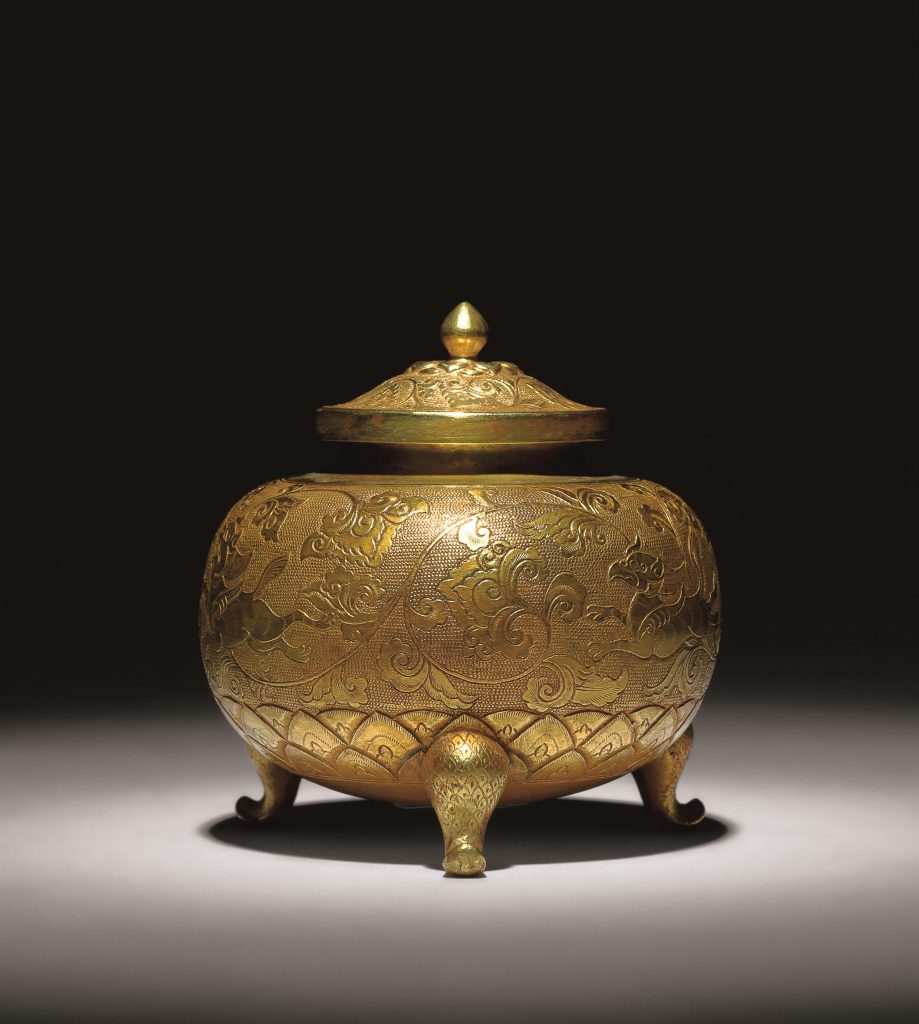
拍卖信息
Lot 1095 清 鎏金錾花卷草瑞兽盖罐
起拍价:44,000 RMB
尺寸:直径8.5cm;高9cm
参考: 唐 三足银盂
2002年陕西省西安理工大学新校区唐李倕墓出土
唐,高5.8厘米,腹径5.5厘米
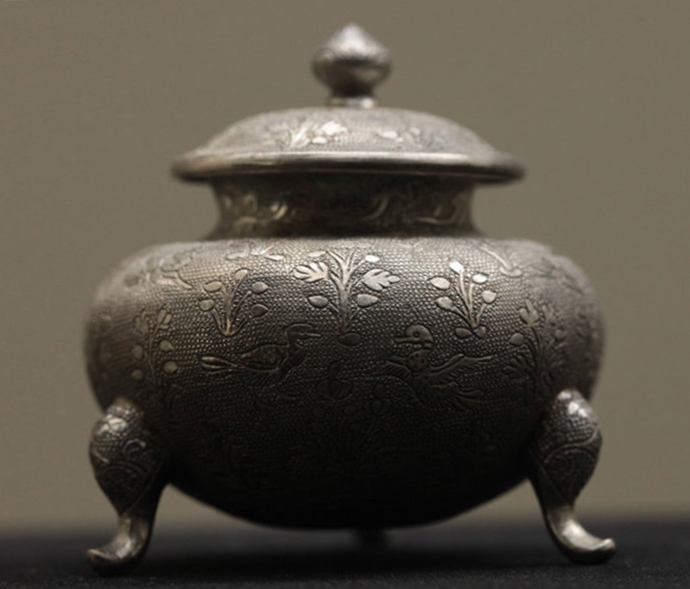
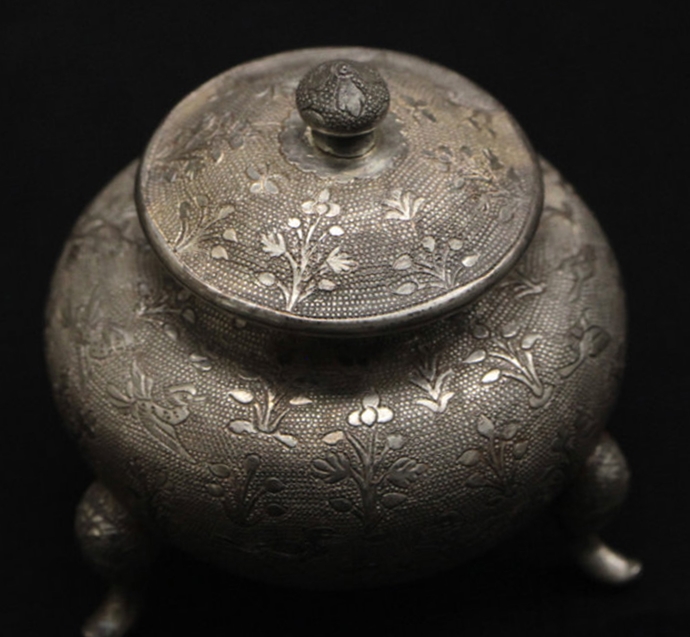
盖为伞盖形,盖钮呈宝珠式,盂为圆唇直口,圆肩鼓腹,圜底,下设兽形三足。通体饰“鱼子”底纹,其上錾刻鸳鸯,鸿雁,小簇花纹,分布均匀,做工细致。墓主人李倕,字淑娴,唐代公主,是唐高祖李渊第五代后人,病卒于唐玄宗开元二十四年(公元736年),时年25岁。
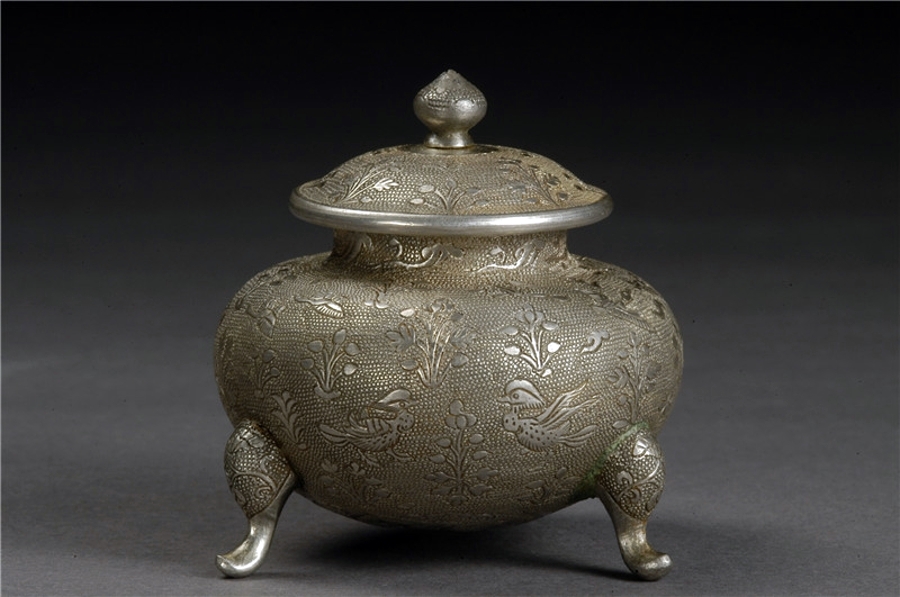
高5.6厘米,直径5.5厘米
说明:2002年陕西省西安理工大学新校区唐李倕墓出土
盖为伞盖形,盖钮呈宝珠式,盂为圆唇直口,圆肩鼓腹,圜底,下设兽形三足。通体饰鱼子底纹,其上錾刻鸳鸯、鸿雁、折枝花,纹饰分布均匀,做工精致。
参考:西安陕西博物馆 鎏金双雁纹银盒
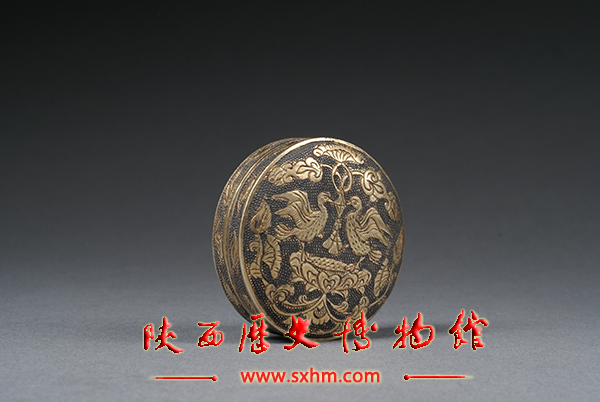
银盒高1.8厘米,重39.5克。盒面中央有相向站立的双雁,脚踏一只莲蓬,盒底装饰有忍冬、折枝花草等图案。
在古代,婚礼从议婚到完婚有六道程序,成为六礼,虽然各时期六礼有所不同,但雁始终是六礼中不可缺失的重要角色。雁作为男女婚嫁的见面礼,象征着婚配双方像雁一样夫唱妇随,不离不弃、和睦相处。这件银盒上除了双雁,还有莲叶、莲蓬等图案,它们也继承了前者的含义,将婚礼与家庭生活联系在一起,祈愿婚姻的百年好合,多子多福。
唐.鎏金鹦鹉纹提梁银罐
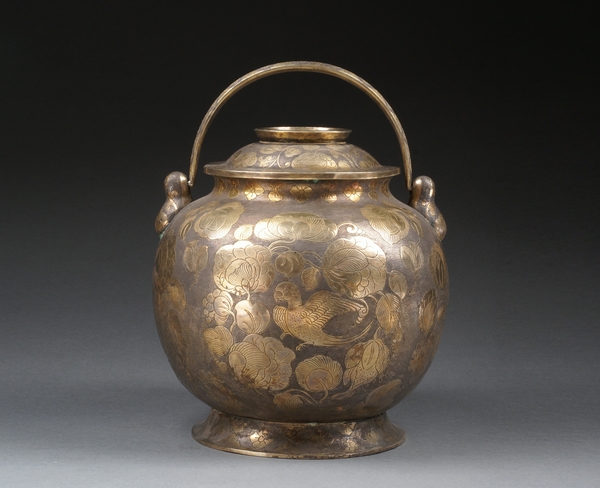
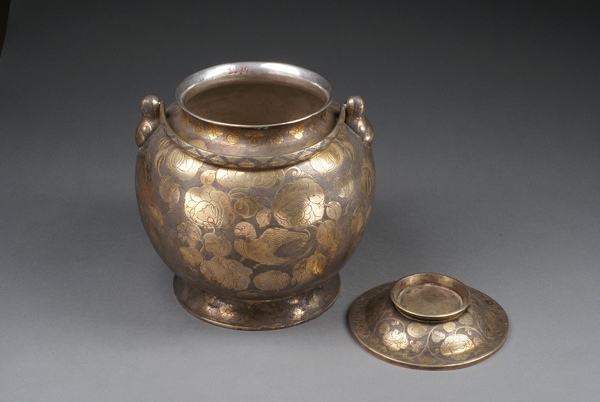
这件器物是是何家村窖藏文物中最华丽的提梁银罐,同时也是馆藏18件组国宝级文物之一。
罐体中心以鹦鹉纹作为主体纹饰,鹦鹉抬首,展翅,翘尾,栩栩如生。折枝花团围绕着鹦鹉,将器物簇拥而绕,形成一种生机盎然的景象。鹦鹉在唐代被称为“神鸟”,其毛色多彩而艳丽,能学人言,因而刺激了唐人的好奇心和想象力,受到了唐人的格外喜爱。受此影响,鹦鹉成为地方和邻国向大唐王朝所敬贡品之一。器身其余空白处用鱼子纹填满象征着多子多福。花纹平錾,纹饰鎏金。银罐的肩部有一提梁,提梁能自由活动。研究人员打开罐盖,惊奇的发现在银罐盖子内有墨书“紫英五十两,白英十二两”。紫石英、白石英均为矿石类药物,是炼丹的重要原料。由此可判断,此罐应为何家村储存药物而用,盖子经过转动盖合非常严密。古人认为用金银器盛放炼丹要物可以提高其药效,因此在何家村发现的药材均盛放在金银器中。这件银罐体现出唐代工匠丰富的艺术想象力。
唐.鎏金鹦鹉纹提梁银罐

名称 唐.鎏金鹦鹉纹提梁银罐
著作权人 佚名
原出地 1970年陕西西安南郊何家村窖藏出土
保管处 陕西历史博物馆
原物附文 无
尺寸·CM 通高24.2口径12.4底径14.4.5 重量·克
备注
一般展出位置:第三展厅隋唐展室
高24.2厘米,口径12.4厘米,足径14.3厘米,重1789克。
大口,短颈,腹圆鼓,喇叭形圆足盖,锤击成型,花纹平錾,纹饰涂金,鱼子纹地。腹两侧均以鹦鹉纹为中心,四周绕以折枝花,形成圆形图案。盖顶中心为宝相团花,周围饰葡萄、石榴和忍冬卷草纹。盖内有墨书两行:“紫英五十两”、 “白英十二两”。
该罐为纯银所制,纹饰鎏金。大口、短颈、腹鼓而圆,喇叭形圈足,罐的肩部有两个葫芦型附耳,提梁插入并焊接在附耳之内。银罐的装饰题材以鹦鹉为主体,四周以折技花环绕,形成两组圆形图案,装饰在提梁罐两面,其余空白处以单株折枝点缀。盖心为宝相团花一朵,盖面周围装饰葡萄、石榴、忍冬、卷草等纹饰,提梁上饰有菱形图案,这件富丽堂皇、圆浑饱满的银罐是迄今已知唐代银罐中最大气、最精美的一件。
鹦鹉因美丽能言,成为唐代王公贵族喜爱的宠物。《明皇杂录》中记载;“开元中,岭南献白鹦鹉,养之宫中,岁久驯服,聪慧而洞晓言词,上及贵妃皆呼‘雪衣娘’”。可见当时人们对鹦鹉喜爱的原因与程度。因此,鹦鹉成为唐代工匠们乐于表现的题材。这件提梁银罐上刻画的鹦鹉振翅欲飞,鲜活而丰满,恰好与圆浑的外型,饱满的团花相谐调,给人以富贵喜庆的感觉。加之银罐的纹饰全部鎏金,与罐体色泽形成反差,产生了一种立体效果,更增加了艺术的美感。值得一提的是罐盖内有一行墨书写着:“紫英五十两”,“石英十二两”。表明这件银罐是收藏中药的器具。
參考:鎏金翼鹿凤鸟纹银盒
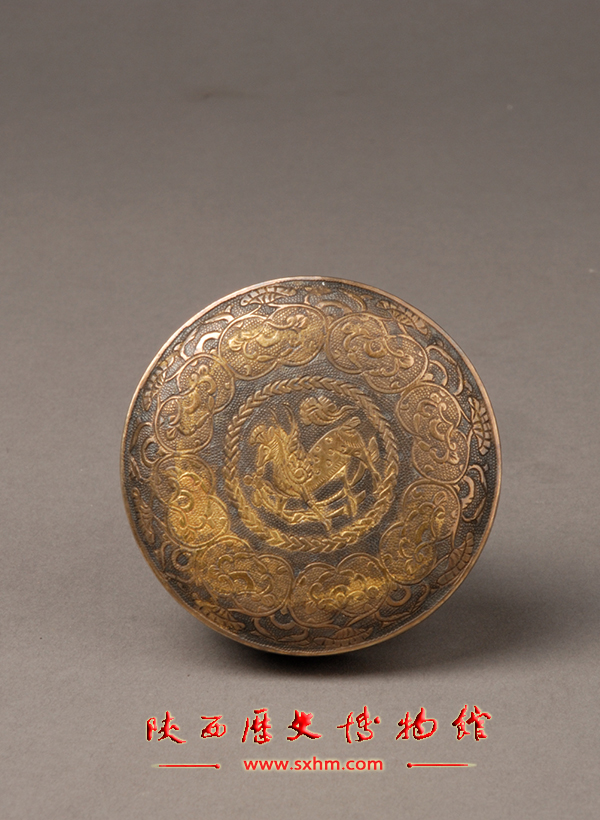
银盒高2.4厘米,重62克。
盒盖面中心錾刻了一只口衔绶带长有双翼的鹿,盒底中心是一只衔绶的凤鸟,忍冬花草及流云飞鸟等图案装饰在周围。唐代鎏金有多种方式,这件银盒的特点是,在纹饰鎏金全部完成之后在盖面上又加鎏了一层,所以盒盖相对盒底更厚一些。
参考:A very rare miniature silver and gilt-bronze tripod vessel (hu), Han dynasty
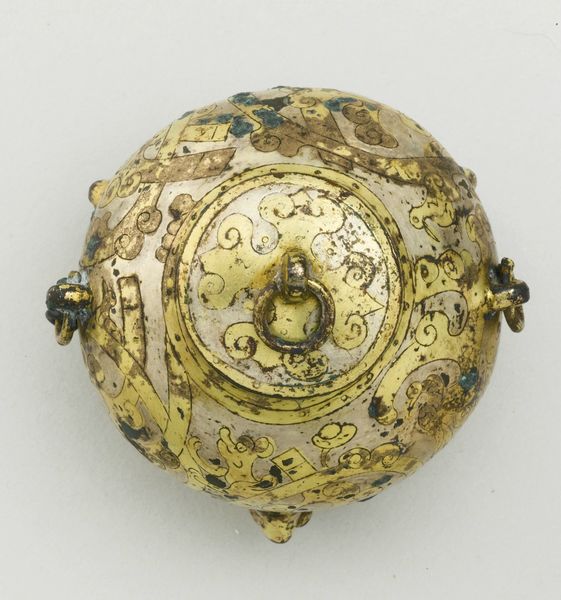
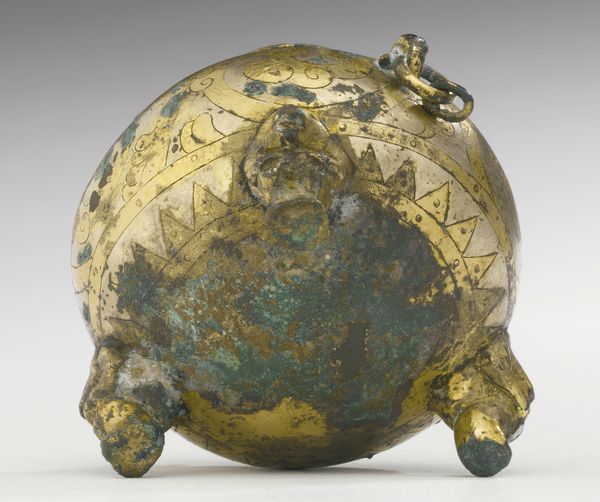
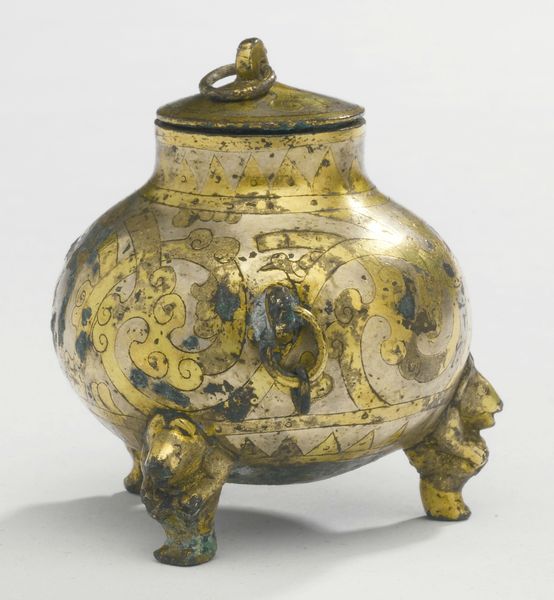
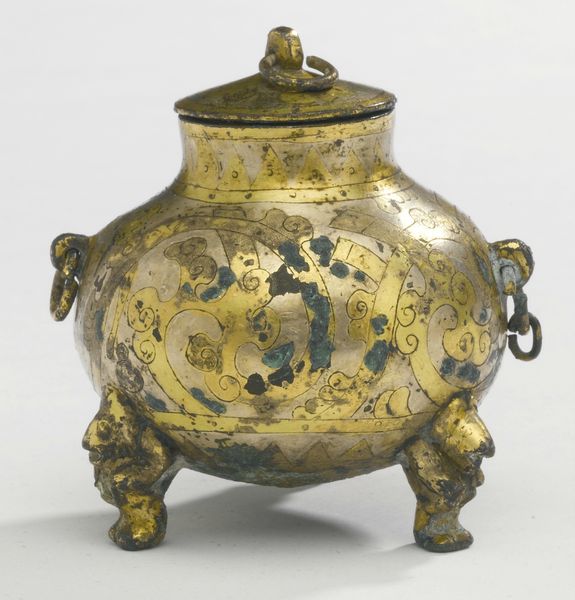
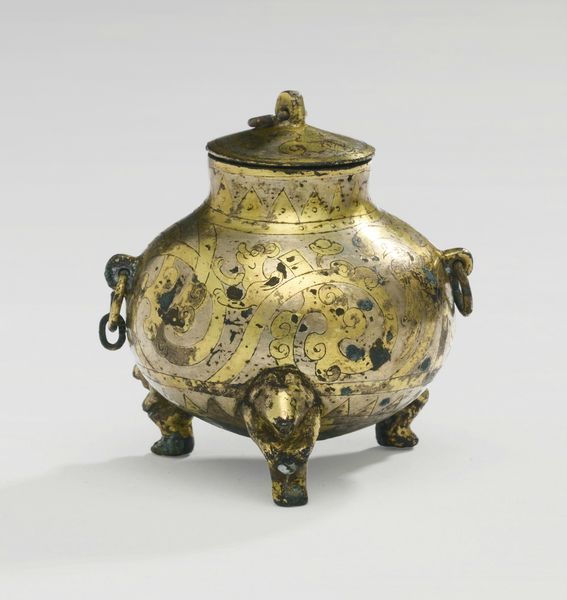
of compressed spherical form supported on three bear-form feet, the sides set with opposing loop handles suspending rings, finely gilt with a turtledove and beast amidst cloud scrolls forming the main register around the steeply rounded sides below a narrow gilt band, the neck decorated with a frieze of triangular motifs underneath another narrow gilt band, the cover surmounted with a ringed loop finial, decorated with gilt floral patterns, all outlined by engravings and reserved on a silver-gilt ground. Height 2 1/4 in., 5.6 cm. Estimation 120,000 — 150,000
PROVENANCE: A Japanese collection prior to 1980.
NOTE: This rare miniature hu vessel exemplifies the highly skilled gilding and incising techniques developed in the Han dynasty. The rich ornamentation expresses a scene of the Daoist mystic realm populated with turtledoves and animals amidst cloud scrolls. The cloud scroll was an often used background pattern in the Han dynasty, which created the atmosphere of the Daoist land of immortality. In the Han dynasty, according to Fan Ye’s History of the Later Han Dynasty (Hou Han shu li yiji), published in China in the fifth century, the turtledove was a symbol of longevity as it was known that the bird that would not choke. There are many surviving examples of Han bronze turtledove finials which were originally attached to the wangzhang, a rod given by the Emperor to people who were older than 70. The Daoist theme on this present vessel is further emphasized by its bear-form legs. The bear was another popular motif in Han iconography and often related to stories found in the Shanhaijing. A small Han bronze tripod vessel with incised decoration of slightly different form is illustrated in Ancient Chinese Bronzes, J.J. Lally & Co., 2011, no.10; compare also a gilt and incised incense burner in the Nanjing Museum illustrated in Zhongguo wenwu jinghua dacidian: qing tong juan (Grand Dictionary of Gems of Chinese Cultural Relics: Bronzes), Shanghai, 1995, p. 322, no. 1155.
Sotheby’s. Fine Chinese Ceramics & Works of Art. New York | 17 sept. 2013
参考:日本美协2018春季拍卖会
中国古董珍玩日场
清 银鎏金錾花三足炉
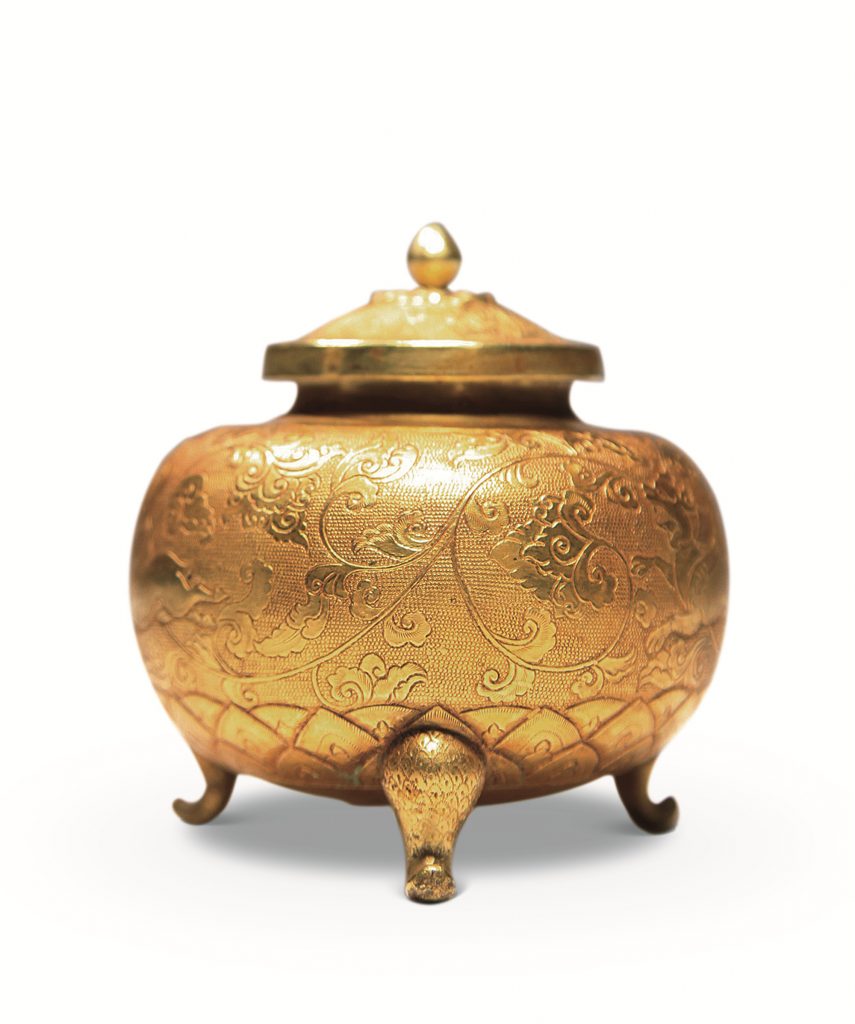
估价:300,000-300,000 JPY
尺寸:高8cm

![[临渊阁]天地一家春](https://www.antiquekeeper.ca/wp-content/uploads/2023/03/cropped-Asian-Art-Wallpaper-Painting3-6-2.jpg)
